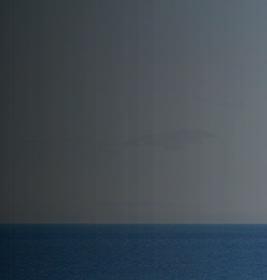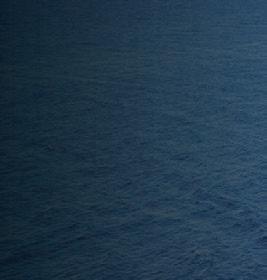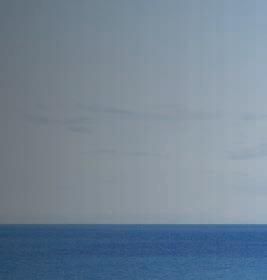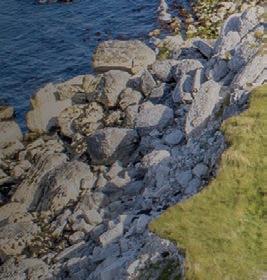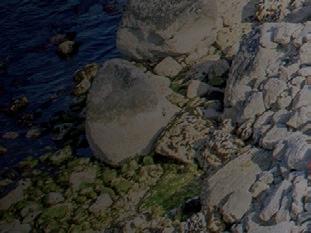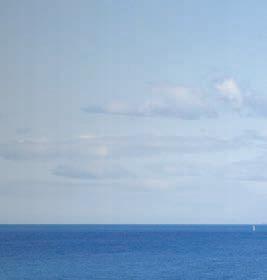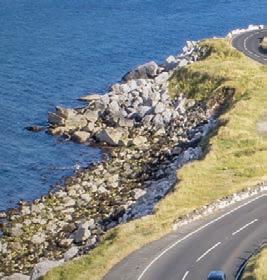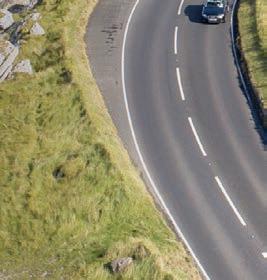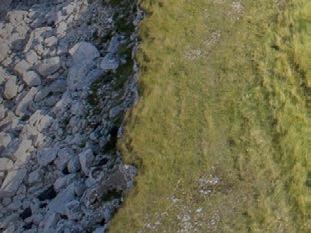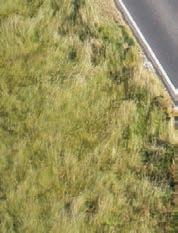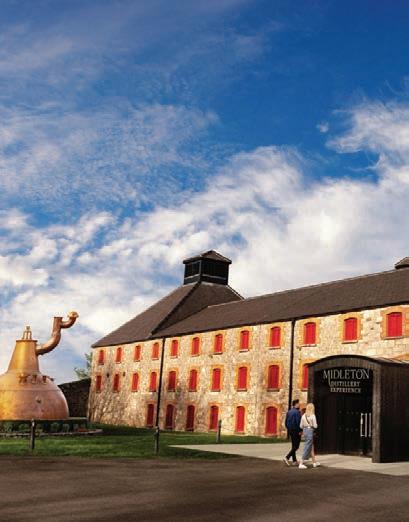







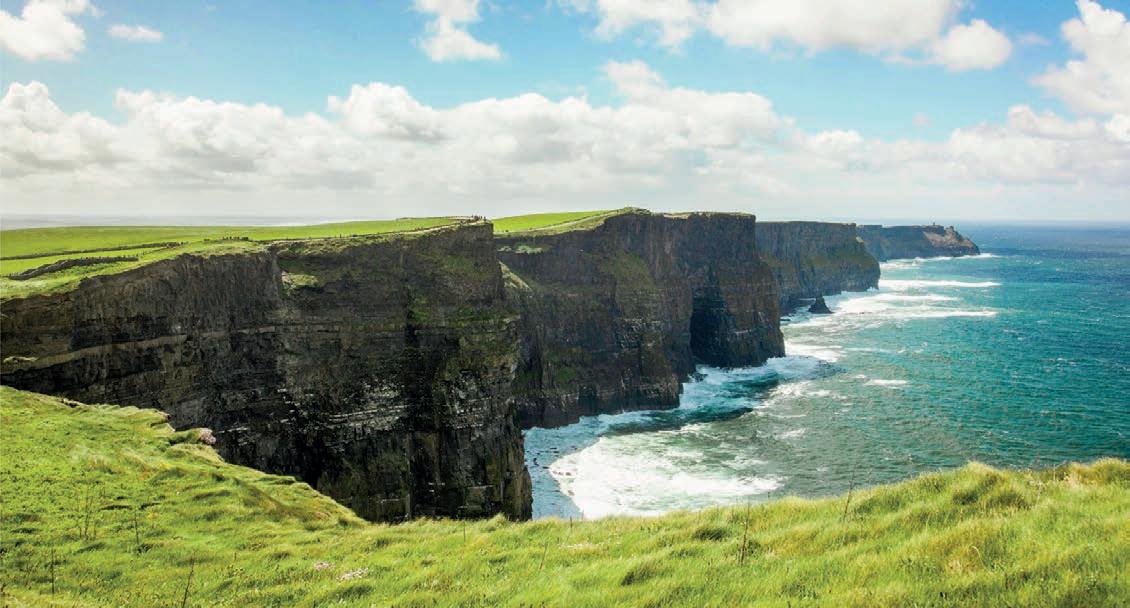



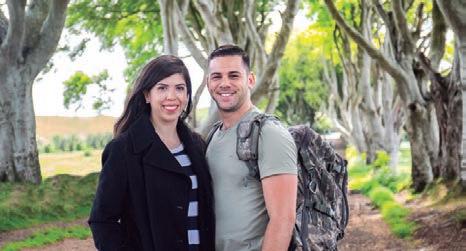






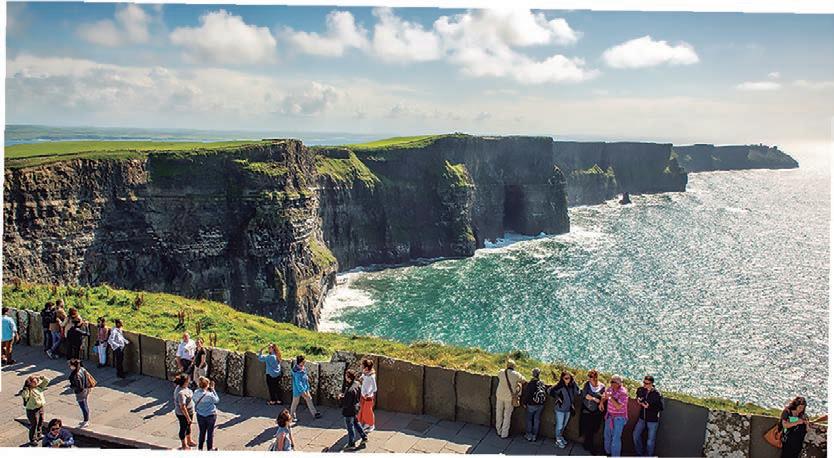



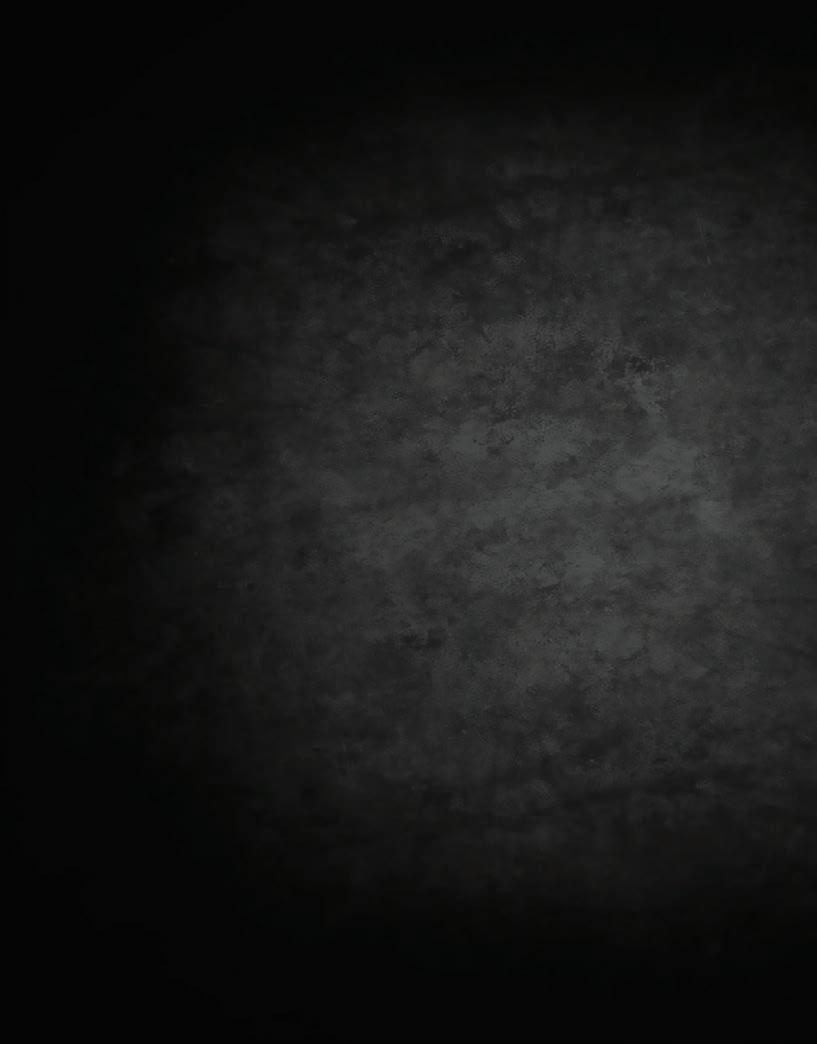
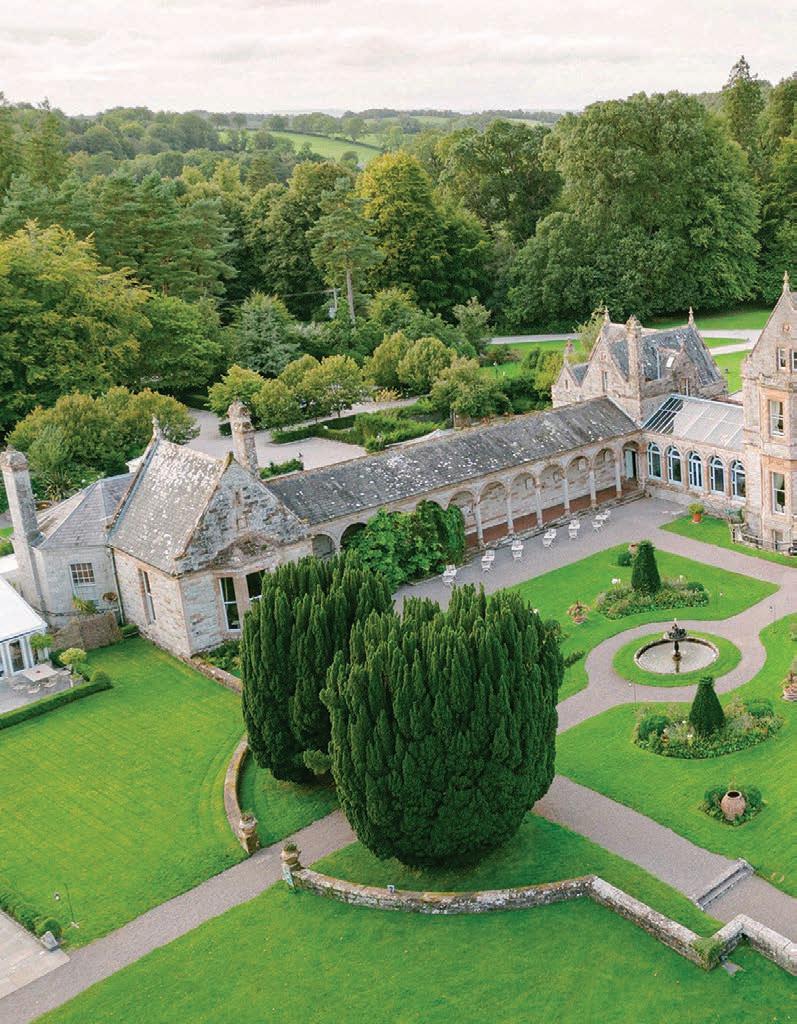
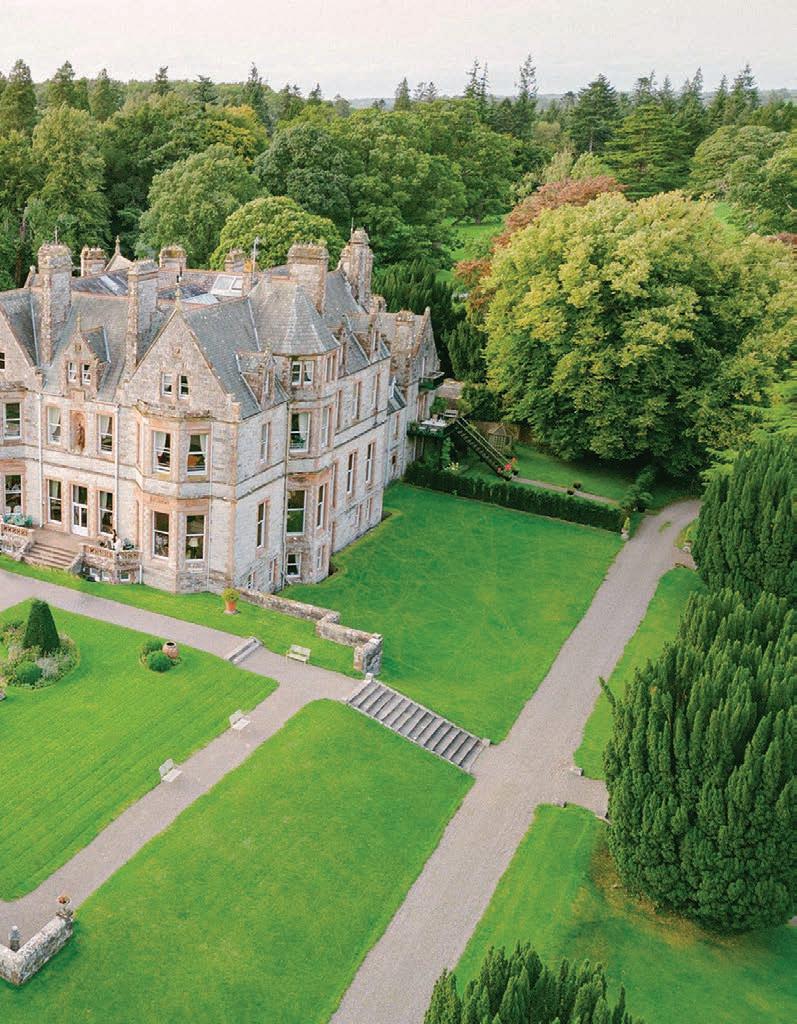










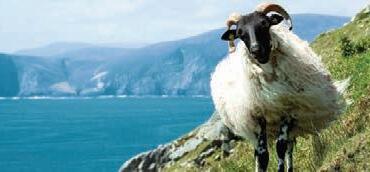
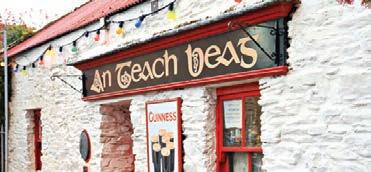

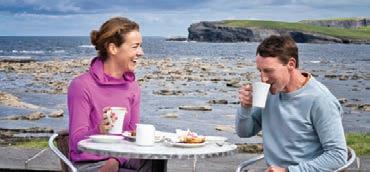

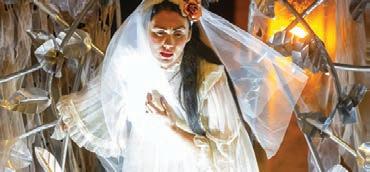











































08. WITH LOVE FROM IRELAND
From the buzz of Dublin to the rhythm of Galway and the breathtaking beauty of Kerry and its islands, a U.S. couple set out to celebrate their anniversary on an unforgettable journey.
21. WALK ON THE WILD SIDE
Just off the Dingle Peninsula, the Blasket Islands offer windswept walks, rich wildlife, and a glimpse into a way of life long past.
26. LIVING LANGUAGE
Spoken in Gaeltacht communities and heard in classrooms and daily life, the Irish language remains a living part of Ireland’s to this day.
31. A SOUTHERN STAR
From the lively streets of Killarney to the stunning Iveragh, Beara, and Dingle peninsulas, County Kerry is pure postcard perfection.
40. LOVE AND LAUGHTER IN COUNTY CLARE
A place of striking beauty and lively charm, Clare has much to offer, including the oldest and largest matchmaking festival in the world.
46. WESTWARD BOUND
A playground for the senses, Connemara has vast expanses of bogs, heaths, and woodland that perfectly captures the beauty of Ireland’s west.
53. MAGIC OF MAYO
Where generations once departed in hardship, travelers now arrive in droves drawn by Mayo’s breathtaking scenery and infectious energy.
78. MYTHICAL SIGHTS
From ancient tombs to legendary sites, Ireland’s Royal Trail winds through mythical lands where history and legend intertwine.
84. EERIE ERIN
From haunted castles to fairy forts, Eerie Erin explores Ireland’s enduring belief in the otherworld, where folklore still shapes everyday life.
91. ANCIENT EAST
With 5,000 years of history packed into one region, Ireland’s Ancient East brings the past to life through ancient tombs, medieval towns, and landmarks that reveal the island’s rich past.



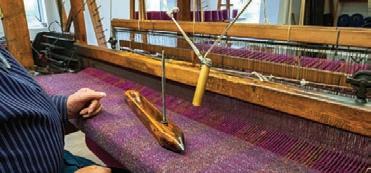
EDITOR: Trish Phelan trish@devlinmedia.org
SALES:
Linda Hickey | linda@devlinmedia.org
COPY & EDITORIAL:
Emma Mitchell | emma@devlinmedia.org
Sarah Phelan | sarah@devlinmedia.org
104. DELIGHTFULLY DIFFERENT
Full of character and creativity, Dublin packs a lot into a small cityvibrant, walkable, and delightfully different.
122. COPPER COAST
Shaped by time and rich in natural drama, the Copper Coast is a UNESCO Global Geopark of rugged cliffs, quiet coves, and geological wonders.
127. THE GREEN HEART
At the heart of the country, Ireland’s Hidden Heartlands offer peaceful waterways, lush trails, and welcoming towns; a place to unwind and reconnect with nature.
140. BORDER COUNTIES
Once a line that divided north and south, the Border Counties are now a bridge between them, where life moves at its own unhurried pace.
149. HAPPY EVER AFTER
Ireland’s finest invites couples to celebrate their big day in unforgettable style, with dream venues, breathtaking backdrops, and all the romance Ireland has to offer before and after “I do.”
169. CIRCLES OF LOVE
A wedding ring is the perfect symbol of eternity, a circle with no beginning or end, beautifully captured in the Claddagh, where hands, heart, and crown represent love, loyalty, and friendship.
177. FRUIT OF THE LOOM
Skill and design combine in hand looming, one of Ireland’s most enduring traditions.
186. A TASTE OF HOME
Savor Ireland wherever you are, from rich chocolates to teas, biscuits, and artisan treats that bring a taste of home to any corner of the world.
193. STORE STORIES
Irish stores all over the USA and Canada open their doors and their hearts to visitors every day. Here are some of their stories.
CONTRIBUTORS:
Tourism Ireland www.irelandinpictures.com
GRAPHIC DESIGN:
Dean Baker | info@disenoinspirado.es

DISTRIBUTION: North American Celtic Trade Association Tourism Ireland Celtic Stores USA & Canada Showcase
While every effort has been made to make the information contained herein as comprehensive and accurate as possible, the publishers accept no responsibility for additions, omissions or errors. No part of this publication may be copied or used without the editor’s consent.
JP DEVLIN USA
76 Ellsworth Rd, Hyannis 02601, USA

22nd November - 23rd of December 2025
Experience the festive enchantment of a 1km walk through the historic grounds of the Loughcrew Estate, where lights and installations surprise and delight at every turn. Children can meet Santa halfway and receive a present.
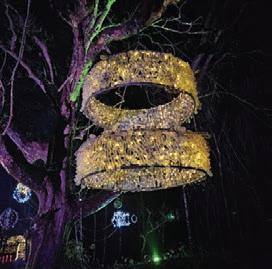
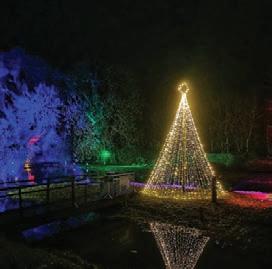
Details:
Open from 4pm on Fridays, Saturdays, and Sundays between 22nd November and 23rd December. Last entry 8pm.
Price:
Tickets starting from €20
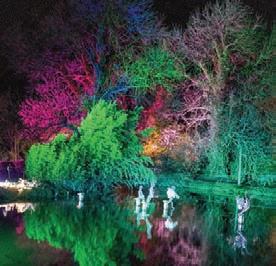
Facilities:
Refreshments at Lime Street Coffee Shop, restrooms and ample parking.
Wheelchair accessible. Dogs on leads are welcome
Location: Loughcrew Estate, Oldcastle, Co. Meath. A82 X4Y1
ONE EXTRAORDINARY WEEK IN IRELAND TURNED OUT TO BE THE PERFECT WAY TO CELEBRATE TWENTY YEARS OF MARRIAGE. WITH A LONG-HELD GRÁ (LOVE) FOR ALL THINGS IRISH, LAURA AND GRIFF HAMLIN FINALLY MADE THEIR DREAM TRIP A REALITY, AND IT DIDN’T DISAPPOINT.
Their adventure began in Dublin, Ireland’s buzzing capital. Because the city would bookend their journey, they wanted somewhere right in the heart of the action but with a touch of old-world charm. The Castle Hotel, a family-run treasure dating back to the 18th century, fit the bill perfectly. As Dublin’s oldest hotel, its warmth and easy elegance made it the ideal home base.
Wasting no time, Laura and Griff dived straight in to Dublin life. First stop? The Brazen Head, Ireland’s oldest pub, dating back to 1198. Beneath its low ceilings and timber beams steeped in history, they tucked into hearty fare and soaked up the friendly buzz that defines Dublin hospitality. From there, they crossed the River Liffey to The Jameson Distillery, where whiskey experiences range from guided tours to premium tastings and even blending sessions. For Laura, a dab hand at cocktail-making, the choice was easy - the cocktail masterclass. Shaking up whiskey sours and old fashioneds under expert guidance was pure joy, and she left with a few new tricks up her sleeve.
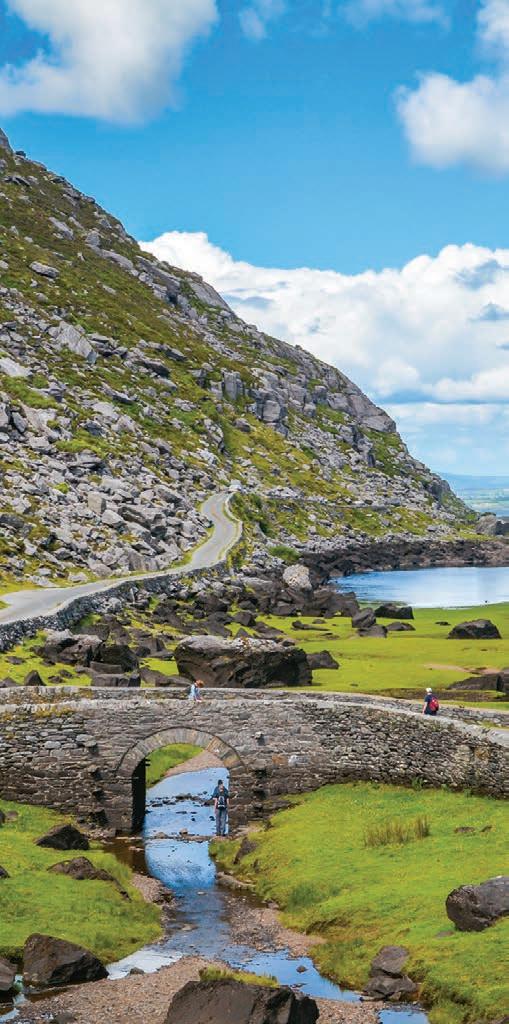
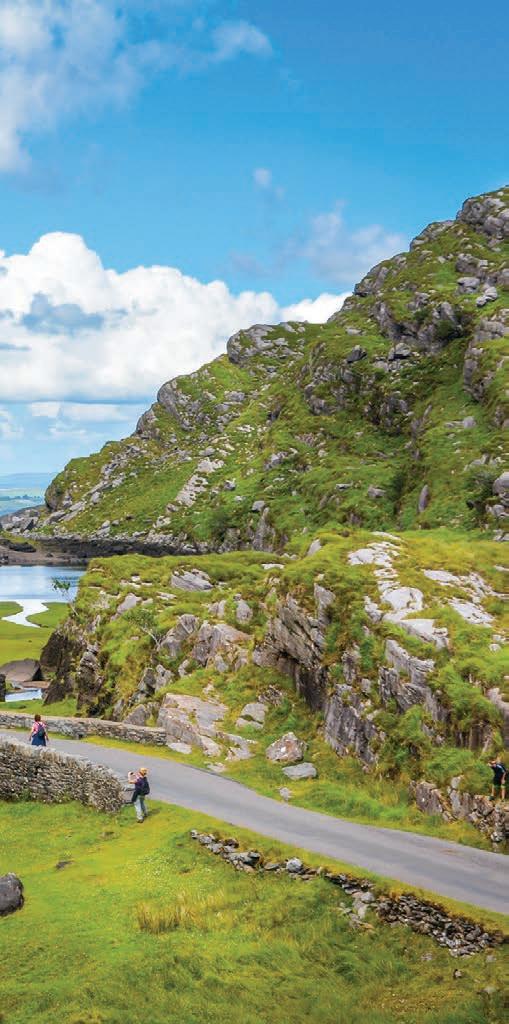
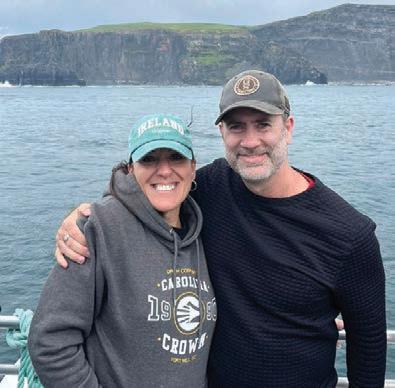
The next morning brought a train ride west to Galway. Known as the “City of the Tribes,” Galway was everything they had imagined and more. The streets buzzed with life, lined with colorful shopfronts, lively pubs, and craft stores showcasing local talent. Music filled the air as buskers played on every corner giving the city an unmistable energy.
Strolling along Shop Street and Quay Street, Laura and Griff soaked it all in. They couldn’t resist picking up traditional Aran sweaters; how could you not in the region that made them famous? The chunky knits are timeless and distinctly Irish, cozy reminders of a city that found its way into their hearts.
Next stop was the Claddagh, the historic fishing village where the world-famous ring was first crafted in the 17th century. Representing love, loyalty, and friendship, the Claddagh ring carries timeless meaning. Worn with the heart pointing outward, it signals freedom; turned inward, it shows the heart is taken. For Laura and Griff, marking twenty years together, buying matching Claddagh rings felt like the perfect way to say “happy anniversary, ”simple, meaningful, and unmistakably Irish.
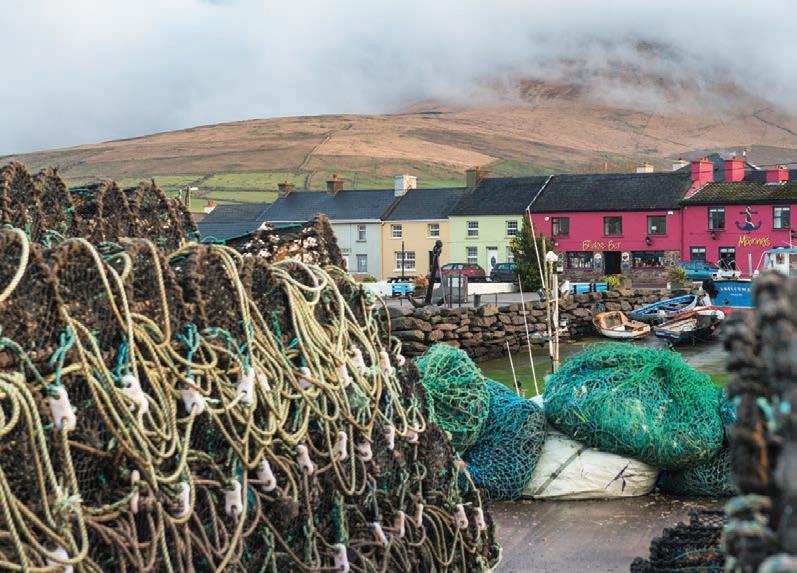
The following day, the adventure continued. From Galway Docks, Laura and Griff boarded an Aran Island Ferries boat bound for Inis Mór (Aran Mór), the largest of the Aran Islands. The ferry ride was an experience in itself; salty sea air, laughter among passengers, and a growing sense of excitement as the island came into view. It was a little early in the day for Irish coffee, but that didn’t stop a few fellow travelers from enjoying the classic pick-me-up, adding to the cheerful mood on deck.
As the ferry eased into Kilronan Harbor, the pace of life instantly shifted. Stone walls crisscrossed the fields, bicycles and horse drawn carriages waited by the pier, and the quiet rhythm of island life began to unfold. Waiting to welcome them was Padraig from Aran Offroad Experiences, a born storyteller with a quick wit and a deep love for his native island. In his all-terrain
jeep, he led them off the beaten path to hidden ruins, clifftop views, and places most visitors never get to see. His easy banter and tales of island life had them laughing, listening, and completely caught up in the magic of the moment.
No trip to Inis Mór would be complete without visiting Dún Aonghasa, the island’s ancient stone fort perched high above the Atlantic. Believed to be more than 3,000 years old, it’s often compared to the Cliffs of Moher, and some even say the two were once connected. Standing at the cliff face, Laura and Griff were struck by the sheer scale and beauty of it all.
From there, the tour led to the Wormhole (Poll na bPéist), a natural limestone pool that looks so perfectly rectangular it could have been carved by hand, yet it’s entirely shaped by the ocean. The pool fills and empties as the tides ebb and flow, a mesmerizing sight, powerful yet dangerous.


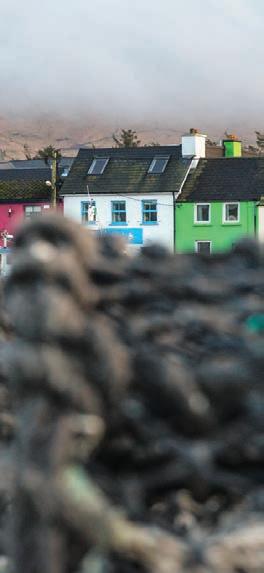

It’s forbidden to swim here due to strong currents, its depth, and unpredictable tides, but that doesn’t stop some locals from taking the plunge. Despite the only way out being a sheer rock climb, the Wormhole continues to draw thrill-seekers from near and far. It has even hosted the Red Bull Cliff Diving World Series, where elite divers launch themselves into the churning waters below. Watching the waves crash into the pool, Laura and Griff could only marvel at the raw power of it all. By the time they returned to the ferry, the Aran Islands had left them spellbound.
As the boat made its way toward Galway, the horizon began to change and a new wonder came into view. The Cliffs of Moher rose from the Atlantic in breathtaking fashion, their sheer faces towering more
than 700 feet above the sea. From the water, the scale was astonishing. Streaks of green and gold lined the cliffs where grass clung to narrow ledges, and the rhythm of the waves mixed with the calls of seabirds overhead. Puffins, razorbills, and guillemots darted across the sky as the couple looked up in quiet awe. It was more than a view; it was Ireland at its most elemental, where land and sea meet in perfect harmony.
That night back in Galway, they fell asleep easily, the day’s sights still vivid in their minds. It was hard to imagine Ireland offering more, but the adventure was far from over. Next stop was the Kingdom of Kerry, where another chapter of discovery awaited.

To see Kerry is to see Ireland at its most majestic, a place often described as the kingdom of landscapes. From Galway, the Hamlins traveled south to Killarney, the gateway to the famous Ring of Kerry. While most visitors explore “The Ring” by car or tour bus, Laura and Griff opted for something different. They wanted to experience Kerry as it was meant to be enjoyed; by water, by horsepower, and on foot, moving with the land’s natural pace.
The day began with a short ride from Killarney to Kate Kearney’s Cottage, a 150-year-old thatched inn once home to a woman famous for her beauty and her legendary poitín (moonshine). Today, it’s a lively stop for travelers, its thatched roof, turf fires, and cozy atmosphere capturing the charm of old Ireland. Inside, the smell of home baking and the friendly chatter of visitors filled the air as Laura and Griff enjoyed a quick cup of tea before setting off on the next leg of their adventure.

From there, they climbed aboard a jaunting car, one of Killarney’s beloved horsedrawn carriages. Their driver, full of wit and good humor, kept them laughing as the horse clip-clopped toward the spectacular Gap of Dunloe. The scenery was classic Kerry; rugged peaks, shimmering lakes, and glacial valleys at every turn. When the rain arrived, it only made the landscape more striking. A little soggy but spirits high, they agreed there was no better way to experience the heart of Kerry.
At the head of the Gap, Laura and Griff hopped into open boats for a trip across the Lakes of Killarney. The water was calm, the views incredible, and their boatmen kept everyone entertained. As they glided past wooded shores and rolling hills, the peaks of the MacGillycuddy’s Reeks came into view. Before long, Ross Castle appeared ahead, standing tall on the water’s edge. Built in the 15th century, it has seen plenty of history, but today it’s all about photo stops and soaking up the atmosphere. For Laura and Griff, it was the perfect end to a day that captured the striking beauty of Kerry.
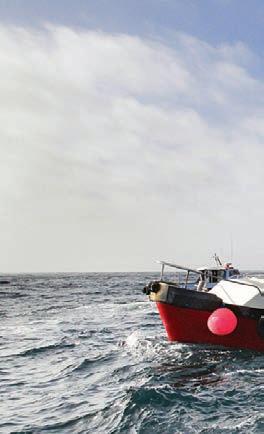
Skellig Michael wasn't just a view but an immersion, like witnessing the raw pulse of Ireland itself etched into stone and sea.

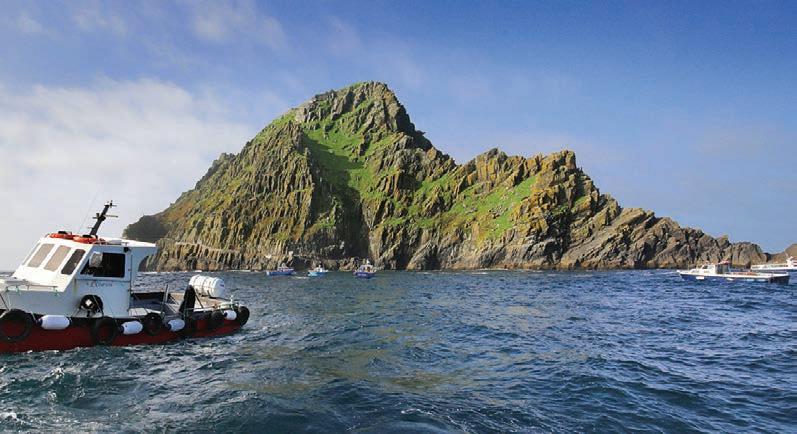
From Ross Castle, the adventure continued. Back at the starting point, local guide Mary Quigley was waiting with a picnic basket and a big smile. Friendly and full of local knowledge, Mary knew every turn of the Kerry landscape. She drove them out to Rossbeigh Beach, a glorious sevenkilometer stretch of golden sand where the tides shift constantly and the light seems to dance on the water. There, in the quiet beauty of the beach, a single picnic bench became the perfect lunch spot. Fresh rolls, local cheeses, and home-baked scones never tasted better. Rested and recharged, they set off again, this time for the bright and colorful village of Portmagee.
Portmagee is a postcard-perfect fishing village with plenty of character and the jumping-off point for the Skellig Islands. Laura and Griff were joined by two of their three sons, and for the boys, the name had extra meaning. The village takes its name from Captain Magee, a pirate who once roamed these waters, and with Magee blood in their family line, the brothers liked to think a hint of that swashbuckling spirit might run through their veins.
That evening, the family settled in for dinner at The Moorings, an awardwinning guesthouse known for its warm welcome, excellent seafood, and lively bar. When The Force Awakens was filmed on nearby Skellig Michael, members of the Star Wars cast and crew stayed here, and Mark Hamill even poured pints in the Bridge Bar. Now visitors can sit where Jedi once gathered or pick up a “May the Force Be With You” T-shirt, a fun reminder that this peaceful Kerry village once played its part in a galaxy far, far away.
The next morning, the family boarded a boat bound for Skellig Michael. As the jagged rock came into view, it was easy to see why filmmakers chose it as Luke Skywalker’s remote refuge. The climb of more than 600 steps is not for the fainthearted, but every step is worth it. At the top, the ancient stone huts of a sixthcentury monastic settlement stand against the sky, a sight so striking it feels almost unreal.
For Star Wars fans, the reward came with an extra thrill. Standing on the windswept
summit, the family found themselves in the exact spot where Rey handed Luke Skywalker his lightsaber in The Force Awakens. Seeing it with their own eyes, in the wild setting where movie magic met history was an unforgettable moment, as if the screen had disappeared and they’d stepped right into the scene.
The descent was quieter, each step carrying the weight of what they had just experienced. The cliffs were alive with sound and movemen; seabirds wheeling overhead while countless puffins with vivid orange beaks stood out brightly against moss green slopes. Surrounded by such energy, the family were reluctant to leave. As they finally stepped onto the boat
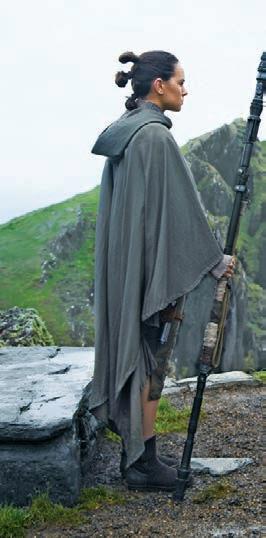
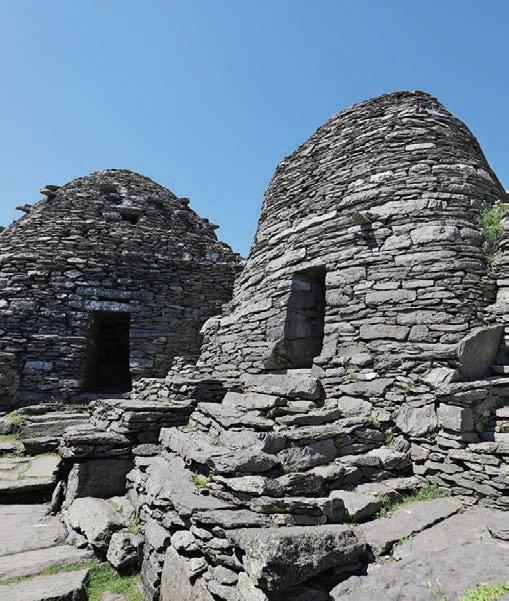


and watched Skellig Michael fade into the horizon, they knew they had touched something extraordinary.
That night in Portmagee brought a different kind of magic. With no light pollution to dull the view, the sky came alive with stars, each one shining in crisp, brilliant clarity. This corner of Kerry is part of a Dark Sky Reserve, and as the family looked up at the vast, endless heavens, it was easy to see why. In Kerry, you don’t just feel the force of nature, you feel The Force itself.
The following morning, their trusted guide Mary arrived to collect the family for the journey back to Dublin, with time to savor a final taste of Kerry’s beauty along the way. Their route took them across the water by ferry, passing Valentia Island, where the fossilized footprints of some of the earliest four-legged creatures on Earth are preserved in stone. Dating back 385 million years, these ancient tracks are a fascinating reminder of how deep Ireland’s natural history runs.
Standing at the windswept summit where Rey handed Luke his lightsaber was nothing short of breathtaking, as if the screen had dissolved and they had stepped into the story.
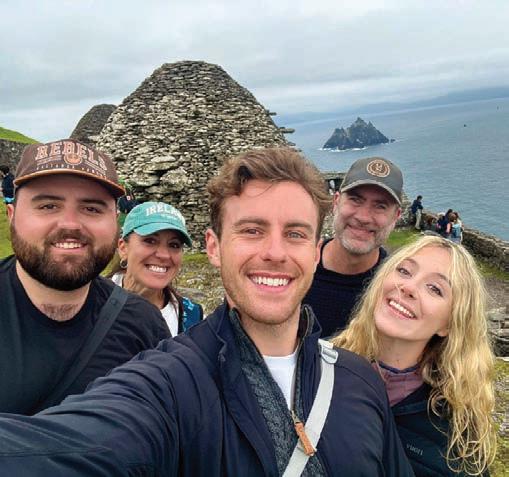
Safely back in Killarney, where the train would carry them to Dublin (with Mary’s homemade muffins tucked away for the ride), the family settled into their seats, their minds filled with everything they had experienced. They had come in search of Ireland and found more than they ever imagined, moments of beauty and joy woven into memories they would carry home forever.
That evening, the family returned to the friendly comfort of The Castle Hotel, just as they had on their first night in Ireland. It also happened to be Laura and Griff’s anniversary, and the hotel made sure the celebration felt extra special. The next morning, after a hearty Irish breakfast, they set out to make the most of their final day in Dublin. They wandered up busy
Grafton Street, where music filled the air and buskers drew smiling crowds, before strolling through St. Stephen’s Green and hopping aboard the Viking Splash Tour. Wearing horned helmets and laughing with their fellow “Vikings,” they roared their way through the city streets before making a dramatic splash into the Grand Canal Basin.
After conquering Dublin as Vikings, a thirst had definitely set in, so it was only fitting to finish their journey at the home of Ireland’s most famous export. A short walk brought them to the Guinness Storehouse, the country’s most visited attraction. There, they followed the story of “the black stuff,” from Arthur Guinness’s first brew in the 18th century to its rise as a world icon. The highlight was a pint-pouring class,
where they mastered the art of the perfect pour before heading up to the Gravity Bar. With creamy pints in hand and Dublin spread out below, the couple raised their glasses to twenty years of marriage, one unforgettable week, and a promise to return again to Ireland.
Clinking glasses at the Guinness Storehouse they toasted twenty years of marriage, one extraordinary week, and the certainty that Ireland was a place they would return to time and again.
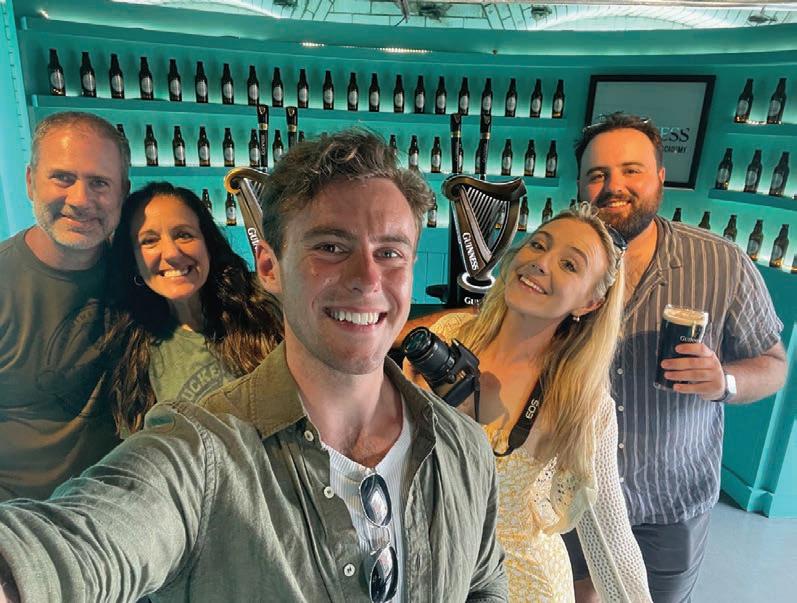

Castle Hotel Dublin castle-hotel.ie
Aran Offroad Adventures aranoffroadexperience.ie
Jameson Distillery jamesonwhiskey.com
Aran Island Ferries aranislandferries.com
Ring of Kerry Tour gapofdunloetraditionalboattours.com
The Moorings Portmagee moorings.ie
Skellig Island Boat Trip skelligislands.com
Viking Splash vikingsplashdublin.ie
Guinness Storehouse guinness-storehouse.com
Mary Quigley, Guide & Driver +35387 9542199
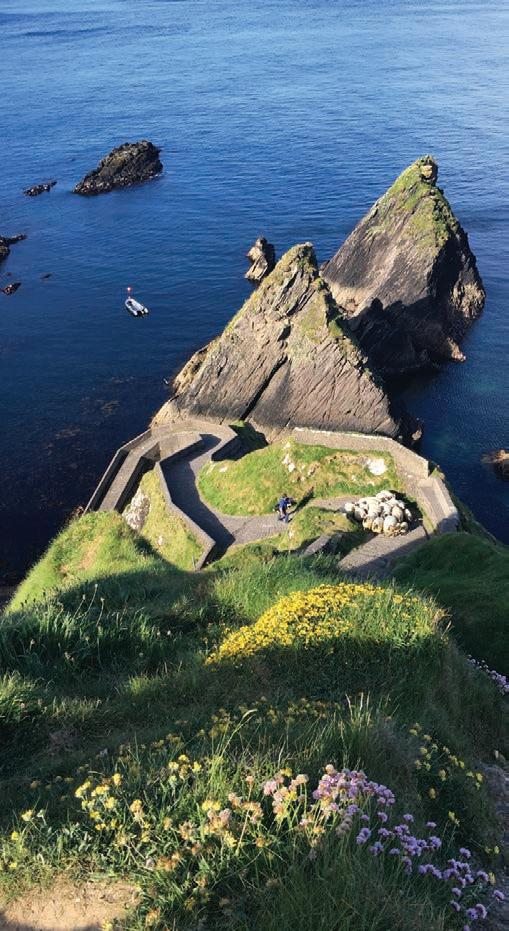
Gateway to the Blasket Islands, Dunquin Harbour is picture-postcard perfect.

THE IDEA FOR PADDYWAGON TOURS WAS WRITTEN ON THE BACK OF A NAPKIN IN A DUBLIN PUB. A QUARTER OF A CENTURY LATER, THE ICONIC GREEN TOURING COACHES ARE A FAMILIAR SIGHT ON IRELAND'S CITY STREETS AND COUNTRY LANES.
Visitors to Dublin, Cork, Limerick, Killarney and Belfast have an excellent range of possibilities to choose from, with something for almost every duration, style and budget.
Now Ireland's leading outfitter, Paddywagon's range of tours includes popular day trips, multi-day tours from two to eight days, and a portfolio of shore excursions meeting cruise ships at the country’s ports. Meanwhile the recent addition of Elegant Irish Tours, Paddywagon’s five-star sister brand, adds
small luxury day trips and private bespoke arrangements to the mix with its fleet of cobalt black Mercedes-Benz sedans, vans and MPVs.
Cathal O'Connell, Founder & CEO, says, "We've come a long way from the early days when touring Ireland was just for the privileged few paying a king's ransom for a couple of nights in the country. These days you can get out of town for an afternoon for the price of a good pub lunch and experience a world-class destination such as the Cliffs of Moher,
the Giant’s Causeway or the Wicklow Mountains. The freeway infrastructure into and out of Ireland’s rural national parks is better than ever, and the comfort levels of touring coaches are the highest they have ever been, including high-speed internet access and USB connections. This means that we can provide guests with all the structure they need alongside ample time for leisure - a walk by a lake, shooting Instagram stories atop ancient ruins, or sampling great local food and drink in a local hostelry."
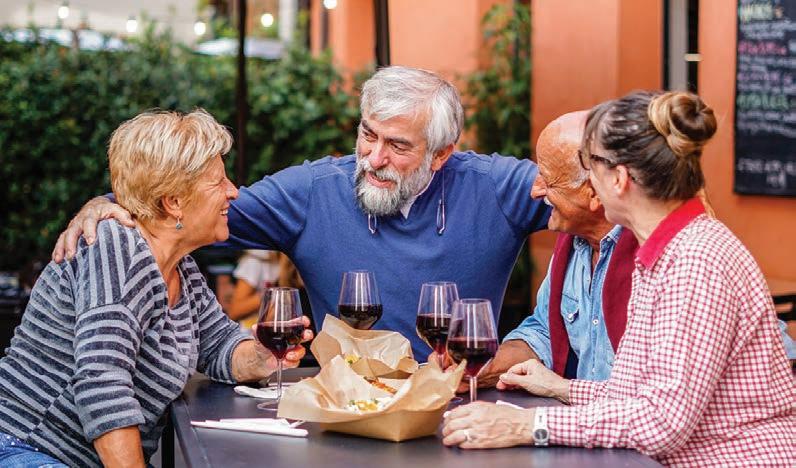
When asked about the difference between group touring and private touring, O'Connell maintains that the guest experience is broadly similar no matter which option one chooses. "Whether you choose a scheduled group or small group tour or a private chauffeur-driven tour to the Cliffs of Moher - you will still enjoy skip-the-line access to this wonder of the world, still enjoy the same road trip and a great local lunch. The main difference with private clients is that they have the convenience of having a black MercedesBenz waiting for them to finish their Irish breakfast and being dropped off at their door at the end of the day.
Depending on the route, there is also flexibility in how guests can approach the day, thereby taking advantage of the weather and a wider range of lunch options. Many private clients are couples and families who work long hours, hold positions of significant responsibility at home and have limited time in the country. We're talking medics, lawyers, business people, amongst many others. We also look after a significant number of the leading travel agents in the US, UK and Asia - not to mention the cast of Dallas and the Imperial Princess of Japan."
Whether you find yourself in Dublin, DC or Dubai, we hope you'll toast Ireland with a glass of your favorite beverage and promise to visit the 'auld sod’ sooner rather than later. Paddywagon Tours and Elegant Irish Tours will be waiting to show you first-class Irish hospitality - the céad míle fáilte - whatever your requirements.
A memorable day out can take many forms but to pack as much as possible into a short itinerary or just one day, Paddywagon has it covered.
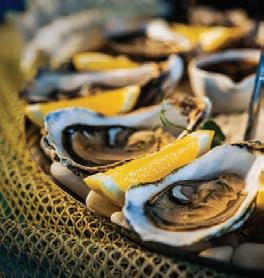
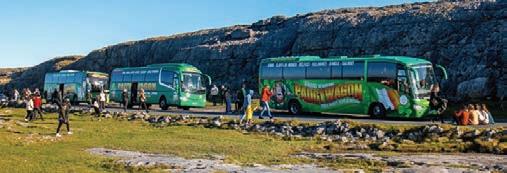



VISIT THE BLASKET CENTER ON IRELAND’S FAMED DINGLE PENINSULA TO EXPERIENCE THE EXTRAORDINARY LEGACY OF THE BLASKET ISLANDERS AND DELVE INTO THE HEART OF IRISH CULTURE, LANGUAGE AND HISTORY.
For many visitors to Ireland, no trip is complete without visiting the Dingle Peninsula. Famed for its spectacular natural beauty, photographs of the pubs and streets of Dingle town and Slea Head – the furthest westerly road in Europe - are among the most iconic images of Ireland. Noted for its welcoming culture of music and song, there is a sense of magic and adventure at every corner.
Dingle’s ancient historical sites, such as the 12th Century Kilmalkedar Churchyard and even earlier Gallarus Oratory, add a magical dimension to this hilly finger of land jutting 30 miles into the Atlantic Ocean on Ireland’s southwest coast. Walking on one of the many marked trails in the area, marine eco-tours, hill-
walking, and sea-angling are just some of the activities to be enjoyed in addition to the lively pubs and restaurants that abound.
The Dingle Peninsula stands out as one of the last bastions in Ireland where the Irish (Gaelic) language is used daily. This linguistic heritage imbues the region with a rich tapestry of history and a profound sense of belonging and serves as a conduit to the vibrant musical and literary legacies that continue to flourish.
The widely acclaimed Blasket Center, 13 miles west of Dingle, on the stunning Slea Head Drive, is a real jewel for visitors who want to cap off their experience by delving
into the unique culture and heritage of the Dingle Peninsula.
A striking piece of purpose-built architecture run by the Office of Public Works, the Blasket Center tells the story of the Blasket Islands. The Great Blasket Island was inhabited until 1953, when the remaining community was evacuated to the mainland.
The Blaskets are a Kingdom of Stories with a fascinating history on many levels, a history brought to life in the cuttingedge multi-media exhibitions of the Blasket Center. At its heart is the story of a tiny and isolated island community that survived for centuries, battling the elements and eking out a subsistence
living from the bounty of the sea and the small patch of arable land that was theirs. The islands had no running water, no shops, pubs, church, medical services, electricity or phones. In this bleak yet beautiful environment, islanders were cut off from the mainland for weeks at a time during Atlantic gales which battered the rocky coast.
In a microcosm of what happened throughout Ireland in the first half of the 20th century, the lure of a better life, particularly in the USA, depleted the Blasket population. The growing disparity between the standards of living achievable on the island and the opportunities abroad was stark and reinforced by the letters and remittances home from early emigrants that helped other family members make the journey to the New World.
A remarkable feature of emigration from the Blaskets, and indeed the Dingle Peninsula, was how immigrants settled mainly in one place: Western Massachusetts. A growing manufacturing and railroad center with an expanding
financial sector and plenty of work opportunities, the Dingle Peninsula emigrants - many with poor English language skills – relied on each other for a 'leg-up' in their new lives. Hungry Hill, an area of Springfield, Ma. was where most of the settlers lived, and it is said that in the 1940s and 1950s, Irish (Gaelic) was commonly spoken outside church services on a Sunday at St. Mary's of the Hill, the spiritual center of the community. Most of the settlers thrived and created new families and new lives in the USA, but the ties of kinship and heritage remain strong to this day.
The story of emigration is significant not just in a local context but also reverberates through numerous Irish hometowns and urban areas in North America. These areas witnessed the emergence of vibrant communities as early emigrants settled there, paving the way for subsequent waves of immigration from Ireland and other regions throughout the 20th century. This trend persists today, evident in the diverse immigrant communities across the USA and beyond.

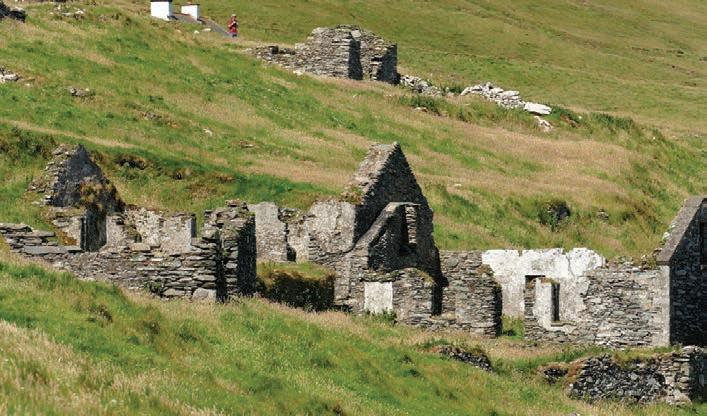
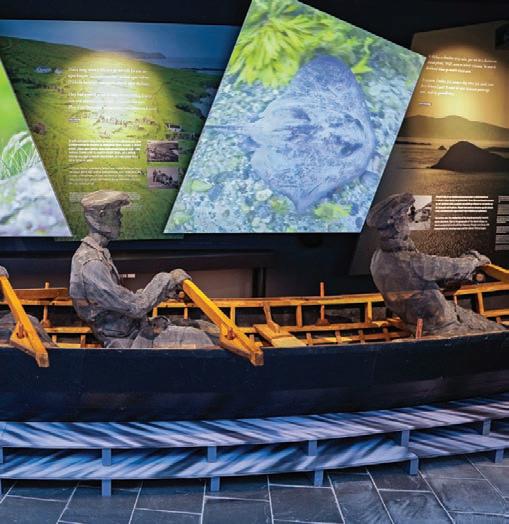

There was a resurgence of interest in Irish culture and language from the last years of the 19th Century in Ireland, an early expression of cultural Nationalism that developed into the political movement for Independence from Britain, which came to fruition in 1921. Arising from this 'Gaelic Revival', the Blaskets became a place that Irish and international scholars visited from the beginning of the 20th Century. They were drawn to an unbroken culture handed down orally from generation to generation, to a rich folklore that played a central role in the lives of the islanders. They were also attracted by the richness of the Irish (Gaelic) language in daily use in this remote outpost, largely unaffected by years of transition to the use of English in most of the country.
The playwright John Millington Synge visited the Great Blasket in 1905 and wrote of his experience there in a subsequent book. Noted international ethnologists and folklorists such as the Norwegian Carl Marstrander, Swede Carl
von Sydow, Kenneth Jackson and classicist George Thomson were only some of the early visitors. Robin Flower, a Keeper of Antiquities in the British Museum came in 1910 and became a perennial visitor and close friend to the islanders, as did many other visitors such as Brian O'Kelly. Many of the island's remarkable folktales were documented by leading island storytellers such as Peig Sayers and Tomás O'Crohan. A literary tradition from within the island community began to develop due to the encouragement and material assistance of some of these scholars. Most notable among the island authors were Tomás O'Crohan, Maurice O'Sullivan and Peig Sayers, and they have been followed by a host of autobiographies and stories over the past century, some of the most important 20th Century works in the Irish language, with some translated into many languages.
This outpouring of writing – some seventy works to date – means we have an extraordinarily detailed account of every aspect of life on the Great Blasket, a gateway to a rich and valuable heritage. This forms the basis of the Blasket Center –sharing its cultural and historical tapestry with the world.
The Center, refurbished in 2022, boasts a series of excellent exhibitions that give a remarkable account of the Islands' heritage. It has excellent parking and toilet facilities and a great Café serving the best of local produce, made daily on the premises. It also affords a spectacular set of views over the Blasket islands and has its own specially commissioned Wild Atlantic Way Clifftop Viewing Platform a short walk from the Center itself – a great way to stretch the legs and breathe in the fresh salty air.
In addition to visiting the Blasket Center, the ultimate experience in these parts is visiting the Great Blasket Island itself. Ferry services run - weather permitting - between April and September from Dunquin (Dún Chaoin), Ventry and Dingle. The trip is suitable only for able-bodied people as the journey involves transferring from ferries to dinghies to reach the tidal island slipway, and good footwear and rainy-day clothing are required. A typical visit takes

up to five hours pier-to-pier, including the sea journey.
The abandoned island village is now largely in ruins. Still, the whole island is a place of unparalleled natural beauty and an evocative reminder of the community that lived there for centuries. The beautiful beach, with its Grey Seal colony, one of the largest in Ireland, the spectacular walk along the island paths, and the staggering scenery make the Great Blasket a fantastic experience.
Expert OPW Guides provide free tours of the island village and give rich insights into the history and heritage of the island, including the restored home of the foremost Blasket writer, Tomás O’Crohan. The Great Blasket has the highest level of environmental protection, being in a Special Area of Conservation and its ownership is shared between the Irish state and private landowners. Privately operated accommodation is available on the island.
Join the thousands of visitors annually who visit the highly recommended Blasket Center and make a special memory that will be among the highlights of your trip to Ireland. The Blasket Center is open daily from March 7 to Nov 7 from 10AM to 6PM (last entry 5.15PM). Online booking is available but optional. For Great Blasket Island ferry information, contact the Blasket Center.
The rugged allure of the Blasket Islands captivates with its wild, unspoiled landscapes, dramatic cliffs, and cultural heritage, offering a serene retreat for nature lovers and history enthusiasts alike.
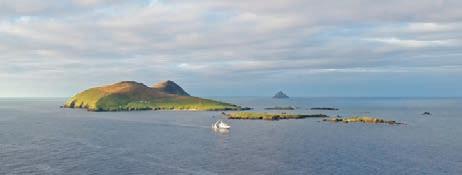
One of the Blaskets’ most famous residents, and a fluent Irish speaker, was Peig Sayers, a child of her time.
Máiréad “Peig” Sayers grew up in the small village of Dunquin at the lip of the Dingle Peninsula where Irish was the language of home, and storytelling was the family gift. Her father was a noted seanchaí (storyteller), and Peig inherited his craft, remembering every turn of phrase and the shape of every story.
She was born in 1873, in the shadow of the Great Famine when most families lived on the poverty line working small, stony fields with short harvests, and lives stretched thin. Here emigration was a fact of life. Letters arrived with the passage fare, farewells were spoken at the quays, and a ticket to America was the surest path forward. This backdrop shaped Peig’s early years and the choices that lay ahead.
Working life started early. At fourteen she went into service in nearby Dingle, long days that left her aching for independence. Like many young people, Peig dreamed of escape. Her best friend, Cáit, had already sailed to America and promised to send the fare, but it never came. Then one evening a group of men called to the Sayers house to speak with Peig's father. A bottle was set on the table and the talk ran late. Among them were Pádraig Ó Gaoithín of the Great Blasket and a local matchmaker. Peig understood the purpose of the visit. A mainland marriage would require a dowry her family did not have; on the islands no dowry was asked because they needed women. When her father sought her answer to the match, she agreed.
Within months Peig crossed the sound to the Great Blasket, trading the shelter of Dunquin for a ridge of rock where the ocean sets life's pace. Marriage brought high expectations. In island custom a child was hoped for within the year. Peig became a mother soon after and went on to bear eleven children in all, however only six survived.
Grief shadowed Peig's life, yet so did laughter. She worked hard, kept house,
and raised children in a place ruled by tide and time. Yet for all the challenges, the comfort of a close-knit community saw her through.
What made Peig extraordinary was what she gave back to the community. She was the life and soul of evening gatherings, a natural entertainer who could light a room with a story or a song. Her modest cottage became a hub for nights loud with laughter, with the sweet smell of turf in the air. Peig carried hundreds of tales in Irish, from long forgotten stories to proverbs and prayers, and she told them with a clear eye for fact and a respect for the seanchas (traditional lore).
Scholars and collectors heard about the storyteller on the island and came to listen.
Peig did not write her stories herself; she spoke them. Others wrote them down, most famously in her 1936 memoir, Peig, which fixed her voice on the page and preserved the texture of West Kerry Irish as it was spoken. For decades, thousands of Irish students studied her text for their Irish classes in high school, which is why her name still rings clear in all corners of Ireland.
Peig’s path was shaped by poor beginnings, a matchmade marriage, and the harsh demands of island life, yet what shines through in her writing is courage, wit, and a generous heart. That is why she remains one of Ireland’s most beloved storytellers. In the end, her gift endures where it began, in living Irish and in the telling of a tale.

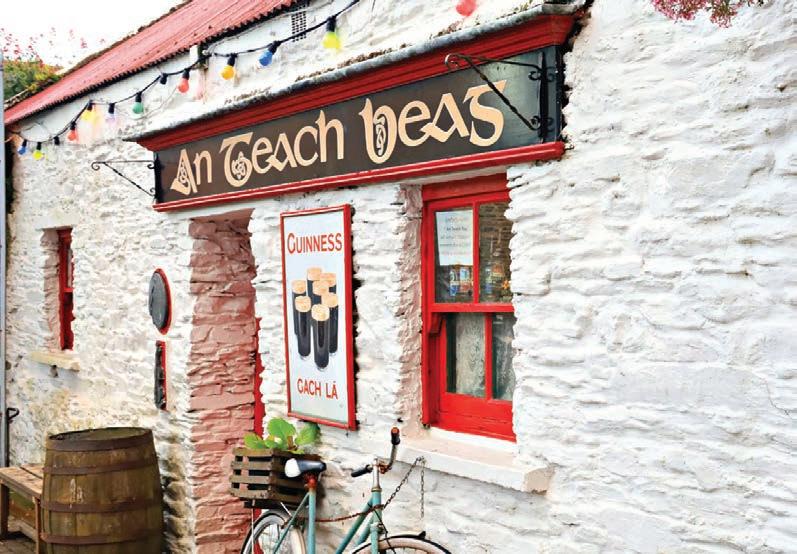

IRISH IS ONE OF EUROPE’S OLDEST WRITTEN LANGUAGES, FIRST CARVED IN STONE MORE THAN 1,500 YEARS AGO. TODAY IT IS SPOKEN FROM DONEGAL TO KERRY, WOVEN INTO EVERYDAY LIFE, OFFERING VISITORS A CHANCE TO EXPERIENCE A LIVING PIECE OF IRELAND’S SOUL.
The Irish language is more than words; it is a living link to Ireland’s history and identity. Known as Gaeilge, it is one of the oldest written languages in Europe, with roots stretching back over two millennia. Part of the Celtic family alongside Scottish Gaelic and Manx, it shares a common heritage across the Atlantic islands while keeping a character that is distinctly Irish in sound, structure, and expression.
For centuries, Irish was the everyday language of the Irish people. It produced a vast body of early literature and remained the main language across the country well into the 18th century. English colonization, however, brought devastating change.
The Penal Laws stripped away land, rights, and religion, and erased Irishness in every form. English became the language of government, trade, and the courts, and without it you could not get an education or a job. Even music, dance, and traditional customs were suppressed, forcing Irish culture underground. Families who wanted to survive had little choice but to abandon their mother tongue, and waves of emigration carried millions abroad in search of work and safety.
The National School system, established in 1831, deepened this decline. While it expanded access to education, it did so by enforcing English as the only language
of instruction. Irish was not only excluded but punished, with children beaten under the tally stick system if they were caught speaking it. By the 19th century, the language had sharply declined, but it never disappeared. In rural areas and particularly in the west and northwest, families continued to use it daily, passing it on despite the insurmountable odds. The fact that the language survived at all is a testament to the resilience of communities determined against all odds to preserve their identity.
Irish Identity
The determination to preserve Irish identity gave rise to the Gaelic Revival of the late

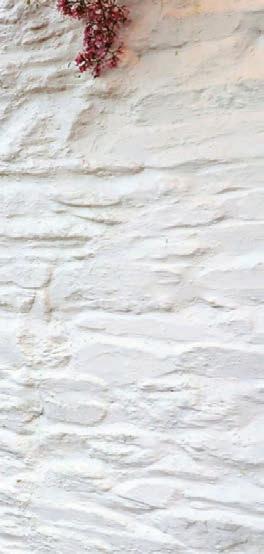
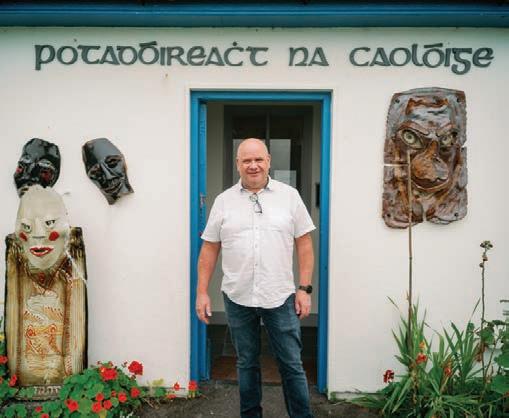
19th and early 20th centuries. Conradh na Gaeilge (the Gaelic League), founded in 1893, championed the language through classes, publications, and cultural events. Around the same time, the Gaelic Athletic Association (GAA) was founded, bringing traditional Irish sports such as hurling and Gaelic football to towns and villages all over the country. Together, these movements encouraged not only pride in Irish games and culture but also pride in the Irish language ensuring that the language was not just preserved but placed at the heart of Ireland’s emerging national identity.
Today, Irish is still spoken as a community language, particularly in the Gaeltacht regions of Connemara in Galway, the Dingle Peninsula in Kerry, and much of Donegal. Donegal’s dialect, in particular, is widely recognized for its strong character and distinct sound, attracting both linguists and learners. In these places, you can hear Irish in shops, schools, and homes, and see it proudly displayed on signs and in local events. Street signs in the Gaeltacht are written in Irish only, which can make it more challenging for visitors to navigate the winding bóithríní (little country lanes) and portach (bogs), but it adds to the sense of stepping into a living cultural landscape.
Every child in Ireland also learns Irish at school, ensuring the language remains part of Ireland’s modern-day identity. While not everyone is fluent, many return to it later through classes, conversation groups, or cultural programs. The spread of Irish media has helped too, with television, radio, podcasts, and online platforms offering new ways to engage with the language.
Like Irish dance and traditional music, Gaeilge has also stepped confidently onto the global stage. What once had to fight for survival is now being celebrated, taught, and performed worldwide. Learners come from across Europe, North America, and beyond to take part in summer schools and cultural festivals. Across Ireland, events such as the Willie Clancy Summer School in Clare and community-based courses in the Gaeltacht combine language learning

• Irish is an official language of Ireland and one of the 24 official languages of the European Union.
• Every schoolchild in Ireland learns Irish as part of the national curriculum, keeping the language present in everyday life.
• Around 1.8 million people in Ireland can speak Irish, with over 70,000 using it daily outside of school.
• The Gaeltacht regions, including parts of Donegal, Galway, Mayo, Kerry, Cork, Meath, and Waterford, are where Irish is still a community language.
• Irish has influenced English worldwide: words like galore, smithereens, hooligan, slogan, sleveen, and even trousers all come from Gaeilge.
with céilí dancing, traditional music, and storytelling, offering visitors a full immersion in Irish culture.
For those who want to take it a step further, Donegal is one of the best places to immerse yourself. Oideas Gael, based in Glencolmcille, has been welcoming learners from around the world for decades. Their courses combine language learning with culture, history, and the spectacular landscapes of southwest Donegal. It is a chance not just to study Irish, but to live it - proof that a language once under threat is now thriving in new and inspiring ways.
The Irish language, like Ireland itself has faced centuries of challenge yet continues to adapt, grow, and inspire. With more than 70 million people worldwide claiming Irish heritage, the story of Ireland is no longer confined to its shores. Out of adversity the Irish rose, carrying their language, customs, and culture to the four corners of the earth. Today, Irish and Ireland not only survive, they thrivea living testament to resilience, pride, and the enduring power of national identity.
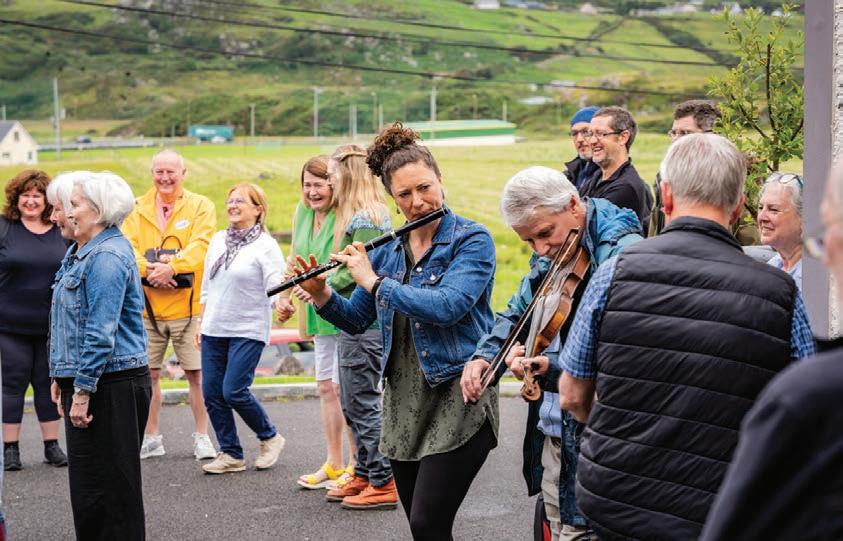
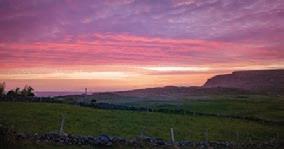
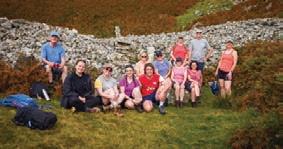
Discover the beauty and rich heritage of the Donegal Gaeltacht. Join us in 2026 for a unique learning experience in the north west of Ireland.

Beginners–advanced, weekend & week-long
Hill Walking, Archaeology, Environment, Geology, History, Painting, Tapestry
Weaving, Singing, Flute & Whistle, Harp, Language & Culture Summer School…


THE WILD ATLANTIC WAY IS THE WORLD'S LONGEST DEFINED COASTAL TOURING ROUTE, A SENSATIONAL JOURNEY OF SOARING CLIFFS BUZZING TOWNS, PRISTINE BEACHES AND EPIC BAYS.
Stretching more than 1,600 miles along Ireland’s western seaboard, it’s a spectacular drive that weaves through colorful towns, pristine beaches, and dramatic headlands. While County Clare's Cliffs of Moher may be one of the most iconic sights on the route, nowhere does this Atlantic adventure shine brighter than in County Kerry. Often called the jewel of the Wild Atlantic Way, Kerry is home to some of Ireland’s most photographed landscapes. Drive the Ring of Kerry for coastal views that stop you in your tracks, explore the wild beauty of the
Dingle Peninsula, or take a boat to the soaring rock pinnacles of Skellig Michael. It’s here that the Wild Atlantic Way truly comes into its own - rugged, vibrant, and unmistakably Irish.
They say you get more than a mile for an inch in Kerry, and it’s easy to see why. Home to some of the finest beaches in Ireland, this county boasts a stretch of coastline that would be the envy of anywhere in the world. Inch Beach alone runs for over three miles along the Dingle Peninsula, a golden sweep of sand that


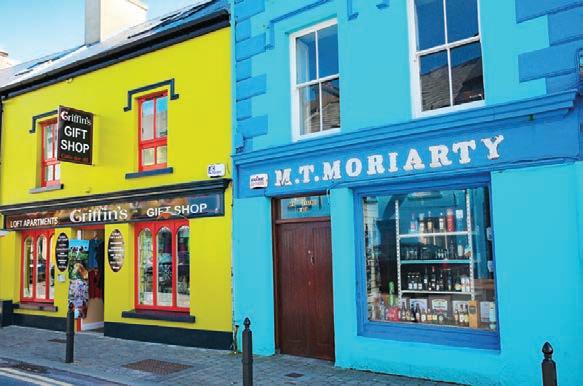
Kerry is a place that stays with you, not just for its scenery but for its spirit. It’s in the lively colorful pubs, the warmth of a local welcome, and the quiet awe that comes with standing at the ocean’s edge.
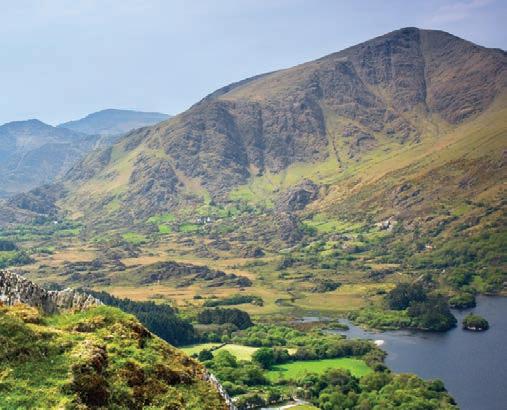
feels endless beneath the Atlantic sky. Surfers carve through the rolling breakers, families stroll along the shoreline, and photographers chase the changing light that has inspired filmmakers for decades; its pure Kerry magic, where sea and sky seem to stretch forever.
When the sun finally slips below that horizon, Kerry offers a show of a different kind. The Kerry International Dark Sky Reserve, Ireland’s first Gold Tier Dark-Sky region and the only one of its kind in the northern hemisphere, delivers a natural spectacle unlike anywhere else. On clear, moonless nights, the sky above the Iveragh Peninsula dazzles with countless stars, planets, and constellations, more visible to the naked eye than in the Grand Canyon or the desert plains of Africa. It’s a reminder that in Kerry, the beauty doesn’t end when the daylight fades.
Beyond the shoreline, Kerry’s islands add another layer to its appeal. From the haunting Skelligs to the bird-filled Blaskets each has its own gentle rhythm shaped by sea and solitude.
Just a short hop from the Iveragh Peninsula, Valentia Island captures all these contrasts in one small place. Joined to the mainland by bridge via Portmagee, it’s an island where rugged cliffs meet lush greenery and Atlantic winds mingle with the warmth of the Gulf Stream. The western side is defined by the dramatic cliffs of Bray Head, offering sweeping views across the Kerry coastline, while the island’s sheltered valleys bloom with subtropical plants thanks to its mild climate.
Valentia also played a remarkable role in global communication. It was here, at Foilhommerum Bay, that the first successful transatlantic telegraph cable connected Ireland to Newfoundland in 1866, shrinking the world in a single line of code. Yet the island’s story reaches much further back - some 350 million
years, in fact. On Valentia’s northern shore, fossilized footprints of a tetrapod, one of the first creatures to walk on land, mark a moment when life itself took its first steps from sea to earth.
Today, Valentia is a relaxed, vibey pace. You can visit the lighthouse at Cromwell Point, stroll through the harbor village of Knightstown, or sit with a coffee and watch the fishing boats across the bay.
Tucked between two stunning coastal rings, charming Kenmare is the kind of place that instantly steals your heart. The town packs a lot into its small footprint and is a renowned foodie destination, with top-quality restaurants tucked along its narrow streets.
At No. 35 Kenmare, a family-run favorite, much of the produce comes straight from the owners’ rare-breed pig farm, ensuring a true farm-to-fork experience. The Lime Tree Restaurant, set in a beautifully restored 19th-century stone building, serves elegant dishes featuring local seafood and Kerry lamb. On Main Street,
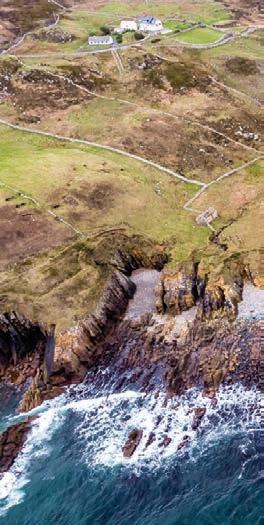
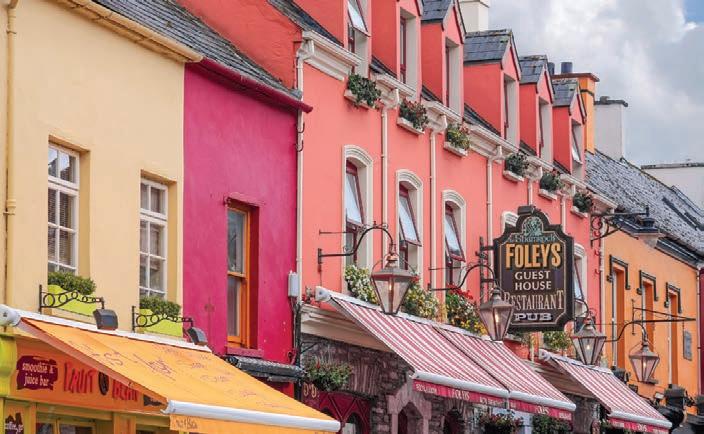
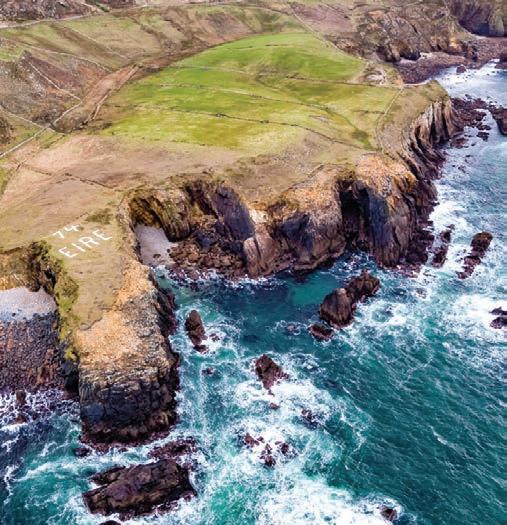
Mulcahy’s Bar & Restaurant blends Irish ingredients with Mediterranean flair in a relaxed yet stylish setting, while The Falls Restaurant at the luxurious Sheen Falls Lodge offers fine dining with sweeping views over the River Sheen. Surrounded by mountains and sea, Kenmare perfectly captures the easy charm of Kerry life while offering a relaxed sophistication.
The neighboring town of Sneem - often called the knot of the Ring - is one of Ireland’s prettiest villages. With its riverside walks, bright-painted houses, and lively pubs, Sneem is as welcoming as it is picturesque. The town’s sculpture trail and local craft shops make it a delightful stop for some shopping or a leisurely lunch.
The small town of Listowel may seem unassuming at first glance, but don’t be fooled; it’s a powerhouse of creativity.

Every year, this North Kerry gem bursts to life as award-winning authors, Hollywood stars, and book lovers of every kind descend on Ireland’s best-known literary festival. Founded in 1970, Listowel Writers’ Week has drawn literary greats such as J.M. Coetzee, Kazuo Ishiguro, Lionel Shriver, and Germaine Greer to its famously relaxed, small-town setting. It’s that perfect mix of big talent and local charm that keeps people coming back year after year.
Playwright Michael West puts it best: “Listowel is great because everyone likes books, of course, but they like to talk even more, so these household names go from pub to pub having deep chats with readers over a pint. It’s all a bit seatof-the-pants,” he laughs, “but that’s its charm. You’ll see big Hollywood stars get up, read something out, and then wander around seeing what else is going on.”




Beyond its festival fame, Listowel is a treat for food lovers, with cozy pubs, excellent restaurants, and a vibrant openair farmers market every Friday. Take a stroll through its colorful streets, walk in the footsteps of Bryan MacMahon and John B. Keane, and finish with a pint of the black stuff at John B’s Pub on William Street, where good conversation is an art form in itself.
Kerry is a place that stays with you, not just for its scenery but for its spirit. It’s in the lively colorful pubs, the warmth of a local welcome, and the quiet awe that comes with standing at the ocean’s edge. However long you stay, Kerry has a way of making you wish you could stay longer.
From crashing waves to colorful cottages, medieval monasteries to music festivals, the Dingle Peninsula is the perfect place to immerse yourself in rural Ireland life.
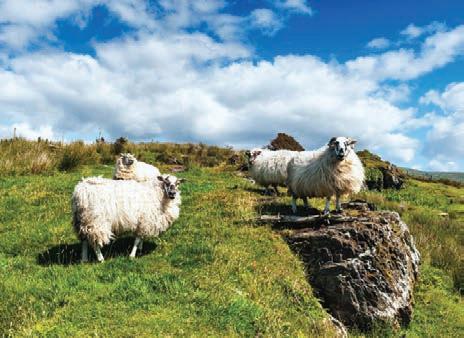


FROM A WORKSHOP OVERLOOKING THE SKELLIG ISLANDS, THIS KERRY CHOCOLATIER HAS BEEN PERFECTING THE ART OF INDULGENCE FOR NEARLY 30 YEARS, BLENDING FINE COCOA WITH IRISH INGREDIENTS AND LOCAL FLAIR.
Skelligs Chocolate is a renowned artisan brand based in County Kerry, Ireland, celebrated for producing high-quality, handmade chocolates using traditional methods and the finest ingredients. Nestled in the dramatic landscape of the Iveragh Peninsula, Skelligs takes its name from the nearby Skellig Islands, a UNESCO World Heritage Site. The rugged surroundings inspire not only the name but also the authenticity and craftsmanship that define its products.
Founded in 1996, the company has built a reputation for exceptional taste, texture, and attention to detail. Its chocolatiers use ethically sourced cocoa, combined with local Irish ingredients whenever possible, ensuring each piece is both a treat for the palate and a nod to sustainability and regional pride.
The collection is impressively varied. From hand-crafted truffles and pralines to chocolate bars, hot chocolate mixes, and chocolate-covered fruits, there is something to satisfy every craving. Skelligs is also well known for its luxury gifts and personalized creations, which make it a favorite for both everyday indulgence and special occasions.
Distinctive Irish flavors set Skelligs apart. Achill Island sea salt, Atlantic seaweed, Teeling Irish Whiskey, and Skellig Six18 Artisan Gin are just some of the ingredients that transform fine chocolate into something uniquely Irish, adding depth and character to every bite.
The company’s base along the Kerry coast is central to its story. Situated on the Wild Atlantic Way, the factory looks out
over the Skellig Rocks and lies only steps from St. Finian’s Bay beach. Visitors are welcomed from Easter through October with free tastings, the chance to watch chocolates being made, and the comfort of a café where a coffee pairs perfectly with something sweet.
For those farther afield, their website skelligschocolate.com delivers the same experience worldwide. Whether in Ireland or abroad, customers can enjoy indulgent chocolates rooted in craftsmanship, quality, and a sense of place.
For anyone with a sweet tooth, or anyone who appreciates the art of fine chocolate, Skelligs Chocolate represents Irish creativity at its most delicious.






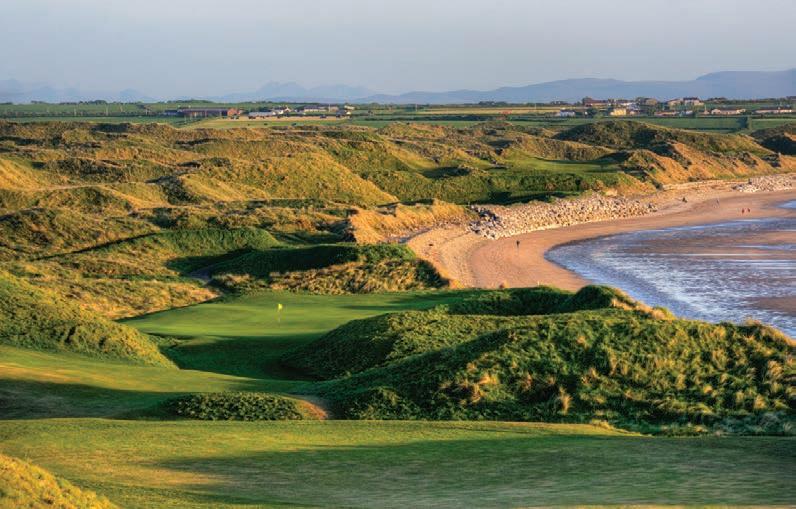


AS THE WORLD’S SPOTLIGHT SWINGS TOWARD IRELAND FOR THE UPCOMING RYDER CUP, THERE'S NO BETTER TIME TO TEE UP A TRIP TO ONE OF THE COUNTRY’S MOST ICONIC DESTINATIONS.
In Ireland’s rugged southwest, laced with scenic coastal routes, Kerry isn’t just postcard pretty. It’s a golfer’s paradise, with courses that regularly feature in international rankings and views that stop even seasoned pros in their tracks.
Let’s start with Waterville Golf Links, a true links course and among the most highly regarded in the world. It offers classic links terrain: dunes, wind, firm turf, and sweeping sea views. Perched at the edge of the Ring of Kerry, it’s a place where wind and waves challenge your swing and sea breezes sharpen your appetite, promising gastropubs, freshly caught seafood, and warm local hospitality. A favorite of Tiger Woods and Mark O’Meara during Ryder Cup prep seasons, Waterville offers 18 holes of pure drama and a warm, lowkey welcome at its 19th.
Waterville is a peaceful haven where the pace slows and the scenery takes center stage. Stroll the village promenade with its sweeping sea views or explore the heritage of the area, like the Charlie Chaplin statue honoring the film legend who vacationed here with his family for more than a decade. Anglers will love the salmon and sea trout fishing in nearby rivers and lakes, while walkers can venture onto the Kerry Way, one of Ireland’s longest and most scenic trails. The Skellig Coast is just a short drive away, offering access to Skellig Michael, which rises spectacularly straight from the sea. This UNESCO World Heritage site, with its ancient monastic ruins, was featured as Luke Skywalker’s hideaway in Star Wars: The Force Awakens and The Last Jedi.
Further north, Tralee Golf Club, designed by the legendary Arnold Palmer, stuns visitors with its cliffside holes and sweeping Atlantic views. “I may have designed the front nine,” Palmer famously said, “but surely God designed the back.” The club will host the Arnold Palmer Cup from July 3 to 5, 2026, where US men’s and women’s collegiate golfers compete against an international team. It will be the sixth time the event has been held in Ireland. The club is also a firm favorite among golf’s elite, including Gary Player, Tom Watson, Rory McIlroy, Justin Thomas, and Jordan Spieth.
While golfers flock to Tralee Golf Club, the town of Tralee itself offers character, warmth, and charm. Framed by mountains and sea, Tralee blends rich heritage with natural beauty. The town is home to the
National Folk Theatre at Siamsa Tíre and the Kerry County Museum, where Ireland’s traditions and stories come vividly to life. Nature lovers can explore the Tralee Bay Wetlands, visit Ireland’s largest working windmill in Blennerville, or cycle the scenic Tralee-Fenit Greenway, which winds through lush countryside to the coastal village of Fenit. Each August, Tralee comes alive with the Rose of Tralee International Festival, where women of Irish heritage from around the world gather to celebrate culture, character, and community. The crowning of the Rose is a highlight, but the festival also features music, parades, and family fun. Running alongside it, Féile Thrá Lí adds a fresh, local energy with street performances, food, and arts, making Tralee a true summer celebration of Irish spirit.
And then there’s Ballybunion: legendary, raw, and revered. The Old Course has drawn presidents and pros alike (Bill Clinton played here in 1995) and consistently ranks among the best links courses in the world. Rugged dunes, ocean winds, and a layout that rewards
strategy over strength make it the kind of course that stays with you long after the scorecard fades.
Ballybunion is more than a golf destination. It’s a seaside escape with heart. The town boasts pristine golden beaches, perfect for swimming, surfing, or a breezy walk along the water. The dramatic cliff walk offers panoramic views of the ocean, castle ruins, and caves carved by centuries of tides. History buffs can explore the old castle overlooking the sea or visit the nearby Bromore Cliffs, home to seabirds and seasonal wildflowers. After a day on the fairways of Ballybunion, unwind in Listowel - where literary heritage, great food, and a lively atmosphere await.
Kerry is rich with off-course adventures, offering as much wonder between rounds as it does on the fairways. One of the best ways to experience it is by following the Ring of Kerry, the legendary circular route that sweeps through mountains, coastlines, and storybook towns. Now
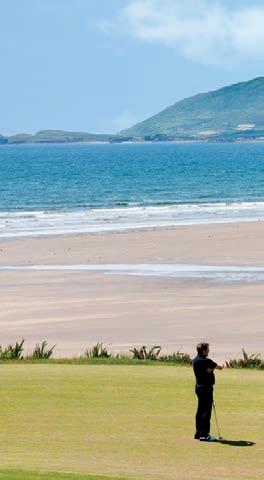
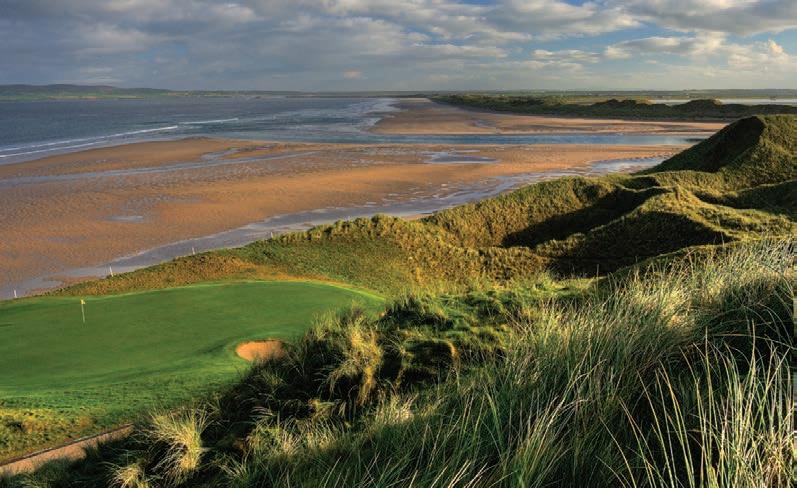
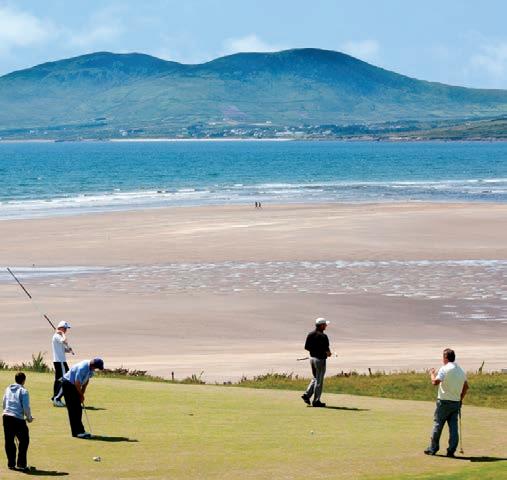
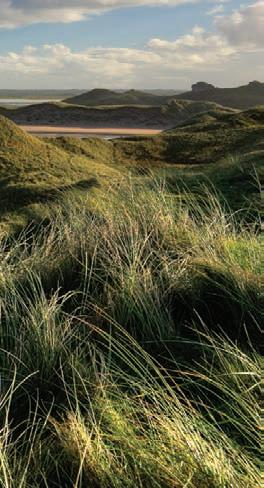
part of Ireland’s Wild Atlantic Way, this 111-mile loop connects many of Kerry’s top sights and lesser-known treasures, making it the perfect itinerary for travelers who want to see it all.
Killarney, the county’s vibrant hub, is an ideal starting point. It’s home to majestic Killarney National Park, with shimmering lakes, tumbling waterfalls, and the grand Muckross House, a Victorian estate steeped in timeless charm. A jaunting car ride through the Gap of Dunloe or a kayak on Lough Leane offers a fresh perspective on this largely untouched landscape.
Further west lies Dingle, a colorful harbor town famed for its lively music scene, artisan shops, and seafood fresh off the boat. The journey there is half the magic, especially over the winding, dramatic road of the Conor Pass.
While Dingle is a perfect day trip from Tralee or a destination in its own right,
Kerry isn’t just postcard pretty. It’s a golfer’s paradise, with courses that regularly feature in international rankings and views that stop even seasoned pros in their tracks.
its true jewel is the Slea Head Drive. This spectacular coastal loop begins just outside the town and takes you to Dunmore Head, the westernmost point of mainland Europe. The drive offers sweeping views of cliffs and beaches immortalized by Hollywood in films like David Lean's Ryan's Daughter and, more recently, Star Wars: The Last Jedi. To the south lies Kenmare, a vibrant town of elegant charm with boutique shops, gourmet restaurants, and five-star hideaways. It is a natural base for exploring the quieter Beara Peninsula, where winding roads and epic views lead to moments of pure stillness. Nearby, the postcard-perfect village of Sneem offers river walks, local crafts, and an artistic sculpture trail.
With Adare Manor in neighboring County Limerick set to host the 2027 Ryder Cup, the southwest of Ireland is buzzing with anticipation. Kerry is just a short drive away, making it an ideal part of a golf pilgrimage leading up to the big event.
It’s not just about the courses. It’s the full experience: toasting the day’s round with fellow travelers in a fireside snug, sharing stories, and soaking in the timeless atmosphere. Whether you are chasing links legends or simply seeking a perfect blend of heritage and spectacular scenery, County Kerry delivers. Bring your clubs, your camera, and a sense of curiosity, because the memories made here will linger long after the final putt drops.

COUNTY CLARE IS A LAND WHERE ATLANTIC WAVES CARVE THE COASTLINE INTO DRAMATIC CLIFFS AND HEADLANDS, WHILE TOWNS AND VILLAGES PULSE WITH MUSIC, WARMTH, AND TRADITION.
County Clare combines spectacular landscapes with a rich and lively culture. Along its western edge, the ocean relentlessly shapes the land, carving the coastline into dramatic formations and sheer headlands. From the soaring Cliffs of Moher to the windswept beauty of Loop Head, the drama continues inland across the Burren, where limestone terraces, rare wildflowers, and ancient monuments create a landscape as haunting as it is unique.
Any time is a good time to explore Clare, but come in the fall and you will encounter something entirely different: the Lisdoonvarna Matchmaking Festival.
A Match made in Heaven
Tucked at the edge of the Burren, Lisdoonvarna has been welcoming visitors for centuries. Once a Victorian spa town famous for its mineral waters, today it is better known as the matchmaking capital of Ireland. For more than 160 years, the town has hosted one of the country’s oldest
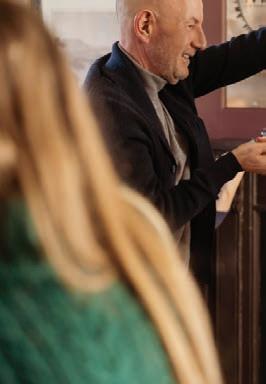
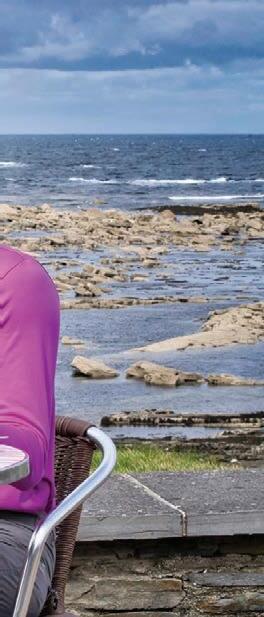

and liveliest festivals, drawing thousands of visitors every year. What began as a way for farmers to meet prospective partners after the harvest has grown into a monthlong celebration of music, dancing, and connection.
Throughout the festival, live music spills from pubs and marquees, while openair dances keep the streets alive from afternoon until the early hours of the morning. Traditional Irish tunes mingle with country and rock, catering to every taste and ensuring no one stays still for long. Whether you are a seasoned dancer or just testing the waters, you will find plenty of willing partners and plenty of fun.
At the heart of it all is Ireland’s most famous matchmaker, Willie Daly. With his well-worn matchmaking book in hand, he
has introduced countless couples, many of whom have gone on to marry. Festivalgoers still line up for a chance to meet him, hoping his gift for pairing people will bring them luck in love. Even if romance is not on your agenda, it’s worth the experience for the warmth and humor that comes with the tradition.
Although matchmaking is the headline act, the festival is about much more. There are music sessions, comedy shows, and latenight parties, alongside quieter moments in cafés and pubs where locals and visitors share conversation over a pint. The atmosphere is inclusive and welcoming, a reminder of the Irish gift for hospitality. Whether you come with friends, with family, or on your own, you are quickly swept up in the camaraderie of the event.

Lsdoonvarna also makes the perfect base for exploring the rest of Clare. Just a short drive brings you to the lunar landscapes of the Burren, where the Poulnabrone Portal Toumb can be found. It is the oldest dated megalithic monument in Ireland and one of the most photographed dolmens in the country. Food lovers will want to stop at the Burren Smokehouse to sample locally smoked salmon, then drop into The Roadside Tavern, run by Birgitta and Peter Curtin, where fine brews and lively conversation flow in equal measure. For an unforgettable meal, and even an overnight stay, the Wild Honey Inn offers Michelin-starred dining that celebrates Clare’s seasonal produce at its finest.
There are many reasons to visit Clare, from its dramatic scenery to its rich cultural traditions, but the Lisdoonvarna Matchmaking Festival adds a sparkle all its own, where strangers become friends
on the dance floor, and where the spirit of Ireland shines through in every encounter. So yes, tick off the Cliffs of Moher, walk the Burren, and follow the Wild Atlantic Way, but if coming in the fall, leave time in your itinerary for Lisdoonvarna, because here, in this small Clare town, you will find an Irish celebration unlike any other, and maybe even a chance of romance.
At the heart of it all is Ireland’s most famous matchmaker, Willie Daly. With his wellworn matchmaking book in hand, he has introduced countless couples, many of whom have gone on to marry.
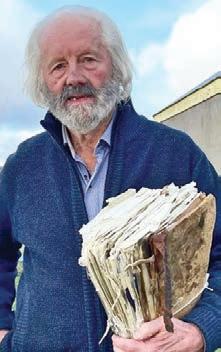
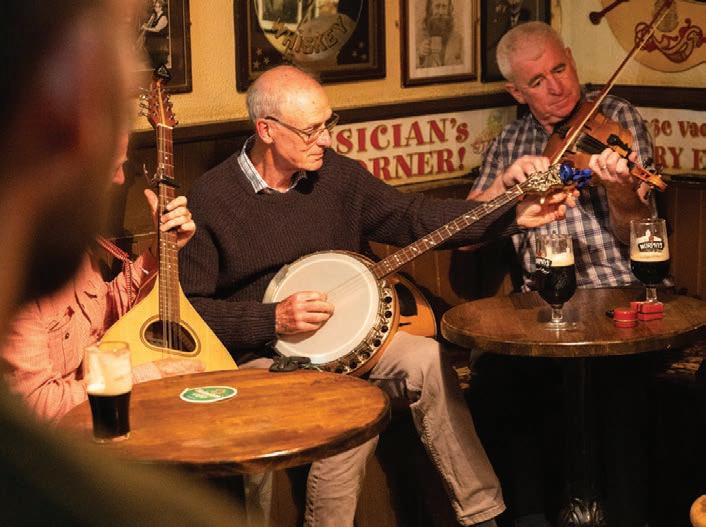



THE SMALL TOWN OF LISDOONVARNA, ON THE EDGE OF THE BURREN AND THE WILD ATLANTIC WAY, IS THE HOME OF THE BURREN SMOKEHOUSE - A PLACE WHERE IRISH TRADITION AND SCANDINAVIAN CRAFT MEET OVER A SMOLDERING OAK FIRE.
Since 1989, Birgitta and Peter Curtin have been hand-smoking Irish organic salmon, mackerel, trout and eel, building a reputation that stretches far beyond County Clare.
The roots of the story go back much further. In 1865, Peter’s grandparents bought the Roadside Tavern. It was a bustling pub, bakery and butter market rolled into one. Today, it’s a gastropub serving Burren Brewery craft beers, great food and music-filled nights. It’s also
where Birgitta, a Swede on holiday, first met Peter. A chance meeting, a marriage, and soon - a smokehouse.
At the back of their home, Peter built the first smoker, and even patented the process still used today. Birgitta recalls delivering sides of salmon in her car, her first-born baby in tow. From those beginnings, word of their smoked salmon spread across Ireland and then the world. Prestige followed. Burren Smoked Salmon was served at Queen Elizabeth II’s State


Dinner in 2011 and gifted to King Charles III. It was also very much enjoyed by King Carl XVI Gustaf and Queen Silvia of Sweden during their visit to the Burren Smokehouse. It has also been presented to U.S. Presidents and Vice Presidents in Bord Bía’s St. Patrick’s Day hampers.
But the Burren Smokehouse is more than a producer - it’s an experience. At the visitor center, guests taste the salmon, learn the secrets of smoking, and see how a small family business grew into a global name, supplying the likes of Harrods, Fortnum & Mason and Dean & Deluca. For those who want more, VIP “Meet the Makers” tours with Birgitta and Peter offer an exclusive glimpse behind the scenes of the Smokehouse.
In 2019, they added the “Taste the Atlantic - Salmon Experience” - an interactive,
self-guided journey through salmon’s place in Irish culture, from the legend of the Salmon of Knowledge to modern sustainability. Perfect for intergenerational families, it mixes storytelling, history and hands-on exploration.
The food trail continues at the Roadside Tavern and Burren Brewery, where Peter leads craft beer tastings, often weaving in stories of Lisdoonvarna and the Burren. It’s a half-day of food, flavor and folklore that captures the spirit of Ireland.
For those who can’t make it to Clare, Burren Smoked Irish Organic Salmon is available to order online at: www.burrensmokehouse.ie - a gift of Ireland, sent to doors around the world.
Sustainably sourced from the pristine waters around the Irish coast, Wild & Organic Irish Salmon is smoked using real fire, blending ancient Irish and Scandi methods.

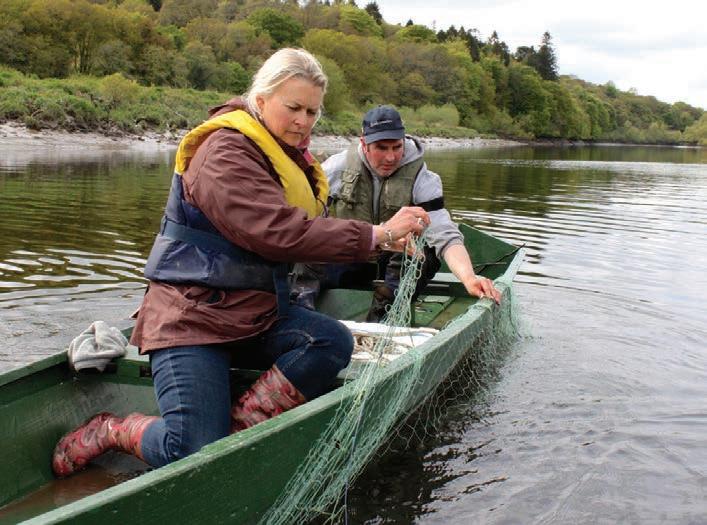

LEAVING BEHIND THE LIMESTONE FOLDS OF THE BURREN, THE ROAD WESTWARD CARRIES TRAVELERS INTO A LANDSCAPE WHERE IRELAND FEELS AT ITS MOST PRIMAL, WHERE MOUNTAINS RISE SUDDENLY ABOVE BOGLAND AND GLACIAL LAKES, AND WHERE SHIFTING LIGHT TRANSFORMS LAND AND SKY FROM ONE MOMENT TO THE NEXT.
For miles you might see nothing but a stray sheep along the roadside, then suddenly come upon a small herd of wild Connemara ponies grazing against the backdrop of the hills.
What unfolds here is a terrain carved by time, weather, and tide. Rugged peaks like the Twelve Bens tower above valleys veined with rivers, while low stone walls mark boundaries across open bogland. Along the coast, hidden inlets, sandy strands, and tidal flats stretch toward the horizon where sky and sea seem to
merge. At every turn, the scenery is raw and elemental, timeless in a way that is both immense and intimate.
For photography buffs and outdoor enthusiasts, Connemara is a dreamscape. Hike the trails of Connemara National Park, where boardwalks cross bogland toward sweeping views of mountains and lakes. Cyclists find quiet roads winding past peat bogs and stone cottages, while kayakers explore a jagged shoreline that feels endlessly discoverable. Moments of stillness are just as powerful, pausing
by a lake at dusk, hearing the call of a curlew, or watching clouds sweep across the peaks. These quiet interludes are part of what makes Connemara truly spectacular.
Yet Connemara is more than wilderness. Its towns and villages are as much a part of the landscape as the mountains and lakes. Clifden, often called the “Capital of Connemara,” bustles with colorful shopfronts, lively pubs, and restaurants serving the freshest seafood. Letterfrack and Leenane draw visitors with their
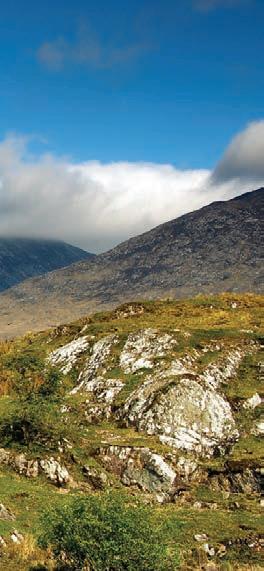
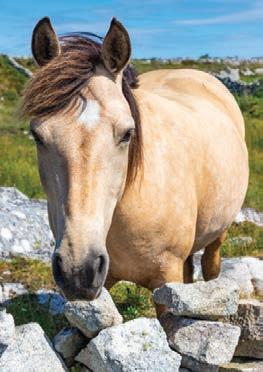
proximity to the mountains and fjord, while Roundstone enchants with harbor views and a thriving artistic spirit. What unites them all is a living tradition, for Connemara is one of Ireland’s great Gaeltacht regions, where the Irish language is spoken daily and music often spills from pub doorways. Fiddle and flute carry rhythms passed down through generations, while in markets and workshops craftspeople keep ageold skills alive, whether weaving, pottery, or jewelry, offering visitors the chance to
Connemara National Park spans 2000 dramatic hectares of bog, mountains, heath and woodlands.
bring home something created with both hand and heart.
For those coming west from the Burren, Connemara feels like both a continuation and a transformation, proof of how much variety Ireland holds within such short distances. Then just when the landscape feels as wild as it can be, another side of Connemara reveals itself. Nestled at the foot of the mountains and mirrored in a still lake stands one of Ireland’s most iconic sights: Kylemore Abbey.


APPEARING AS IF FROM THE PAGES OF A STORYBOOK, KYLEMORE ABBEY, A MAGNIFICENT BARONIAL CASTLE, IS NESTLED BETWEEN MOUNTAIN AND LAKE IN ONE OF IRELAND’S MOST SPECTACULAR REGIONS, CONNEMARA.
Embracing the very essence of a fairy tale, the beauty, history, serenity, and hospitality for which Kylemore Abbey is known draws hundreds of thousands of visitors every year to discover this little slice of heaven for themselves.
“From Generation to Generation” is the apt title of the visitor experience inside Kylemore Abbey. Reopened with restored period rooms and modern multi-media interpretation in 2019, the experience guides visitors through the fascinating history of the castle as it passed through the hands and lives of its owners over the centuries.
Over 150 years ago, Kylemore Lodge was transformed into Kylemore Castle but the
wealthy, liberal politician, Mitchell Henry. Born and raised in Manchester, Henry considered “every drop of blood in his veins” as Irish and after touring the area on his honeymoon in the 1840’s, he fell in love with Kylemore and vowed to make it a nesting place for his new wife and planned family.
Granite was transported from the east to the west coast to construct the magnificent structure that stands proudly today. Renowned architect James Franklin Fuller was responsible for designing the castle. It is believed that the mountain was deliberately blasted to ensure that the castle sits in such a way that its reflection is perfectly mirrored in the waters of Pollacapul Lake, a sight that continues to enchant visitors.
Kylemore became, as Henry liked to refer to it, an estate with "all the innovations of the modern age". The 70-room castle boasted Italian decor, a magnificent ballroom, billiard room, library, study, drawing room, morning room; a dining room draped in black and gold silks and an elaborate Turkish bath house. The estate also had its own dark room, post and telegraph office, two model farms, an abattoir, sawmill, icehouse and a fire brigade of scarlet-clad volunteer firemen. A mile away from the castle, the eight acre Walled Garden and its 21 heated glass houses was tended by up to 40 gardeners.
Henry, his beloved wife, and his nine children made a summer home for themselves in Kylemore in 1867, upon
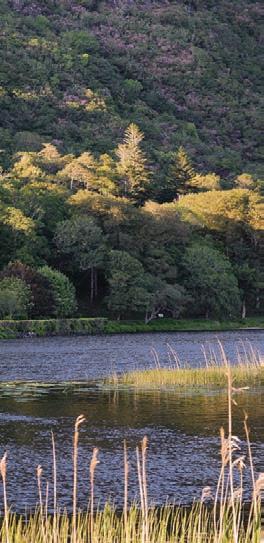
the castles completion, and enjoyed a pampered lifestyle of hunting, fishing and expensive hobbies including yachting and photography, punctuated by picnics, parties, and balls. Archive photographs show the sons posing with fishing gillies and gamekeepers dressed in their Scottish tweeds and happy in their role of countrified young gentlemen. For the five Henry daughters, Kylemore provided a break from the formality of London life, and they too enjoyed the outdoor pursuits of the ‘Irish Highlands'.
The uninterrupted joy was short-lived however. The first family tragedy struck just four years after the castle was completed when Margaret Henry died while on holiday in Egypt, aged just 45 years, leaving behind Henry and their nine young children. The family continued to Summer in Kylemore, and a heartbroken Henry had the neo-Gothic Church built in his wife’s memory. Tragedy struck yet again when one of Henry’s daughters, Geraldine, ‘the flower of the flock’ died in a carriage accident on the estate. This was to signal the end of Henry’s passion for the estate and he put the castle and grounds up for sale in 1902.
The next owners of the estate were the glamorous Duke and Duchess of Manchester. The ever-fashionable couple did not stay long, but they had a marked impact on the castle as they brought much of its interior décor in line with the Edwardian style of the day. An American heiress and a fun-loving Duke, they departed Kylemore Castle just ten years after their initial purchase, and unfortunately did so under a cloud of debt. This meant that the estate was to lie empty for almost seven years before the next inhabitants took up the mantle in 1920.
On the night of December 3rd, 1920, the Benedictine Nuns of Ypres discovered the site that would become their sanctuary and place of prayer, a role it continues to fulfil to this day. This venerable order was compelled to flee their monastery in Ypres, Belgium, during World War One, due to shelling. Their decision to settle in Connemara, drawn to its tranquil and secluded atmosphere and the protective granite walls of Kylemore Castle, was undoubtedly influenced by the destruction they faced. Their presence at Kylemore
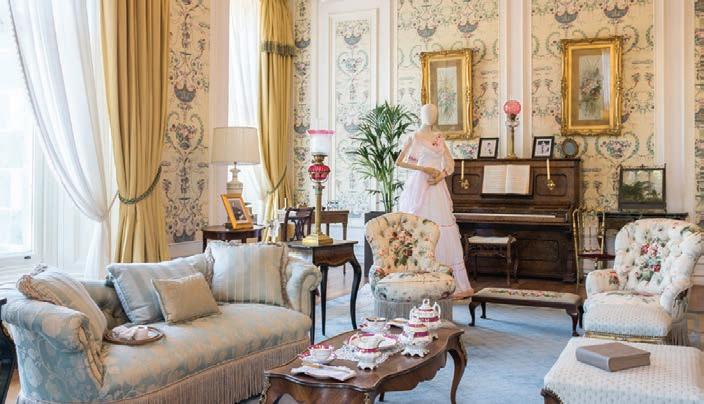
transformed the site from its original identity as Kylemore Castle to its now well-known status as Kylemore Abbey.
The nuns time in Kylemore didn’t stay quiet for too long, however. In 1922, following the Benedictine tradition, the nuns established an International Boarding School for girls. This educational institution welcomed young women from various parts of the world until its closure in 2010. This closure enabled more areas of the castle and grounds to be accessible to the numerous visitors who came to admire the Abbey's beauty and the peacefulness of the surrounding estate.
Kylemore Abbey has a long-standing tradition of crafting and selling its own artisan products including handmade chocolates, soaps, baking mixes and a selection of rustic pottery, all available for worldwide shipping.
A trip to Kylemore invites visitors to delve into the lives of its past inhabitants and immerse themselves in the natural splendor of the surroundings. The ‘From Generation to Generation’ experience leads guests to the magnificent neoGothic Church, a small cathedral honoring Margaret Henry, adorned with exquisite sandstone flowers, angels, and Ireland's marbles. Another must-see is the 6.5 acre Victorian Walled Garden, featuring both formal flower beds and vegetable patches. Here, visitors can witness how pineapples and bananas were cultivated in the late 1800s, within the 21 interconnected glasshouses.
No visit to Kylemore would be complete without indulging in the renowned homebaked goods prepared by the nuns. From traditional breads and cakes to fruit pies and scones, accompanied by freshly brewed coffee, these treats will rejuvenate even the most exhausted traveler before they continue exploring the charming avenues and tree-lined paths of the Kylemore Estate. Surprises abound, including a charming children's

fairy village, rare breed pigs, a herd of magnificent Connemara Ponies, and even a Giant's Wishing Stone!
Kylemore Abbey has a long-standing tradition of crafting and selling its own artisan products, including handmade chocolates and soaps by the Benedictine Nuns, baking mixes, and a selection of rustic pottery, all available for worldwide shipping. The Craft and Design shop is also worth exploring as it ranks among the finest you will find on your Irish journey.
The Benedictine nuns, proprietors and overseers of Kylemore, extend an invitation to visitors to participate in midday prayer or evening Latin vespers in their church. Regardless of one's faith or beliefs, visitors are encouraged to find solace in the serene atmosphere of the church, whether it be by lighting a candle for a loved one or simply taking a moment of quiet personal reflection. To journey through Ireland without including a visit to Kylemore Abbey would be a missed opportunity. Once experienced, the captivating allure of Kylemore will leave a lasting impression for a lifetime.
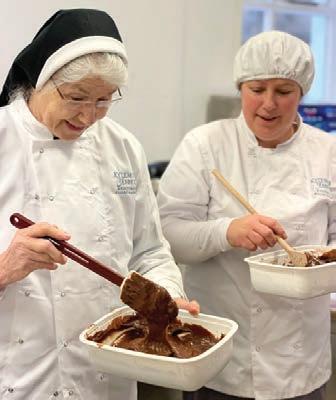

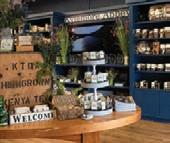
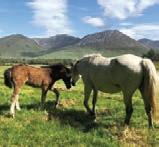
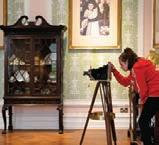
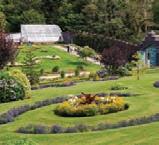




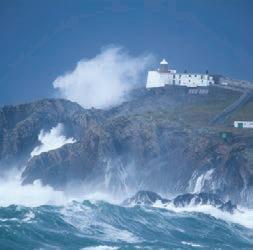
The jewel of the Wild Atlantic Way – explore Co Mayo’s captivating coastline and hidden landscape. Your adventure awaits...


For further information on things to do and places to see in Mayo, please visit:


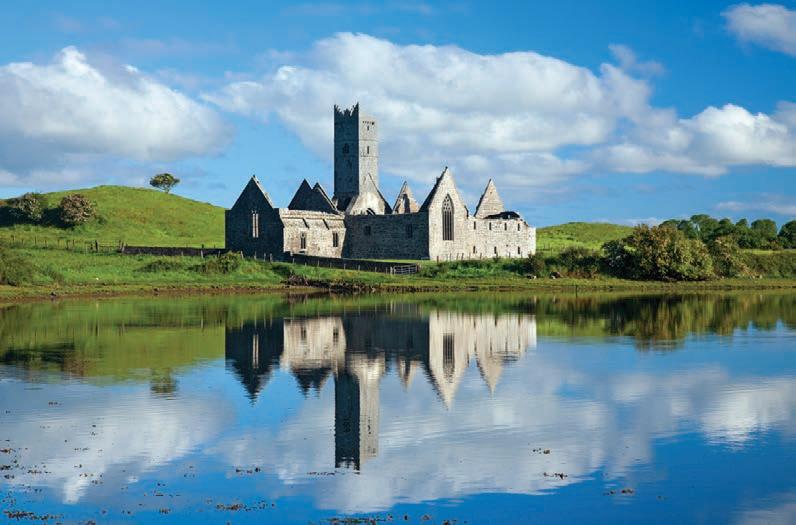


WHERE RUGGED LANDSCAPES MEET LIVELY COMMUNITIES, VIBRANT CULTURE, AND STUNNING SCENERY, THERE IS ALWAYS SOMETHING TO CELEBRATE IN THIS GEM OF THE WEST OF IRELAND.
Mayo lies at the heart of the Wild Atlantic Way and is the perfect place to embrace the beauty of Ireland’s west coast. From the spiritual heights of Croagh Patrick to the tranquil sweep of Clew Bay and the dramatic cliffs of Achill, the county’s shoreline is lined with iconic landmarks, inviting visitors to explore its scenic wonders.
Known as Ireland’s holy mountain, Croagh Patrick has drawn pilgrims for centuries. Each year thousands climb to its summit, retracing the steps of St. Patrick, who is said to have fasted here for forty days in the 5th century. The climb rewards walkers with sweeping views over Clew Bay’s scatter of islands, a sight that feels as much a spiritual experience as a scenic one.
Renowned for its dramatic beauty, Achill Island has long captured the imagination of filmmakers. It provided the stunning backdrop for the award-winning The Banshees of Inisherin, cementing its place as one of Ireland’s most cinematic landscapes and a destination that continues to draw both storytellers and travelers.
Mayo’s Atlantic coastline is also a playground for adventurers, offering world-class deep-sea fishing, kite surfing, windsurfing, coasteering, and kayaking, along with an array of Blue Flag beaches. The Blueway Trails at Old Head, Killary, and Achill give visitors the chance to experience snorkeling and ocean kayaking in spectacular surroundings. Inland, the award-winning Great Western
Greenway connects Westport to Achill Island, winding past villages, abbey ruins, and craft workshops with scenery at every turn.
For many U.S. visitors, Mayo is more than a holiday destination, it is a place of personal connection. The county has strong ties to Irish America, with many families tracing their heritage to this region. At Mayo County Library’s Local Studies Department in Castlebar, you can dive into family records in paper and microfilm, while the county’s two family history centers provide invaluable guidance for those tracing their lineage. It is an experience that connects past and present, linking today’s journey with generations gone by.
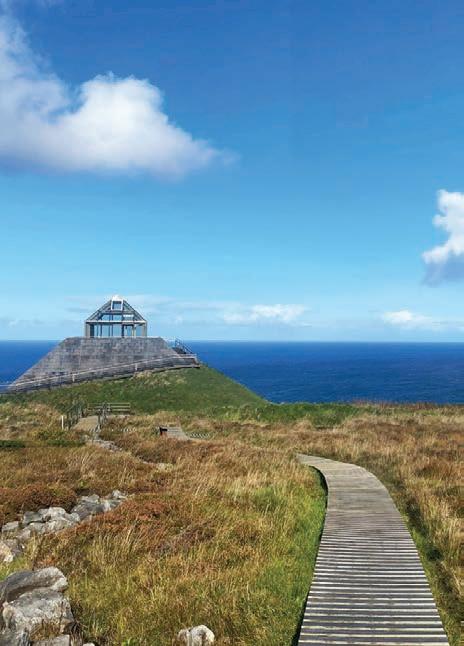
Céide Fields is the world's most extensive Stone Age monument, with the oldest known stone-walled fields, dating back 6,000 years.
Beyond heritage, Mayo’s landscapes are a haven for outdoor enthusiasts. The county boasts Ireland’s longest coastline, its largest island, and even its only fjord at Killary Harbour. Walkers and anglers are spoiled for choice, with renowned rivers like the Moy, Furnace, and Owenmore internationally celebrated for salmon and sea trout angling. Climbers can take on Mweelrea, Connacht’s highest peak, while Wild Nephin and Ballycroy National Park offer vast wilderness where the elusive call of the corncrake marks the arrival of spring. The Bangor Trail, stretching through remote bog and mountain, carries you into a silence broken only by the wind.
Nowhere is Mayo’s depth of history felt more strongly than at the Céide Fields. This remarkable archaeological site reveals a 5,500-year-old Neolithic farming system, the oldest known in the world. Standing on its windswept clifftop, with Atlantic waves crashing far below, you glimpse a way of life preserved in time, proof that Mayo’s story is as old as Ireland itself.

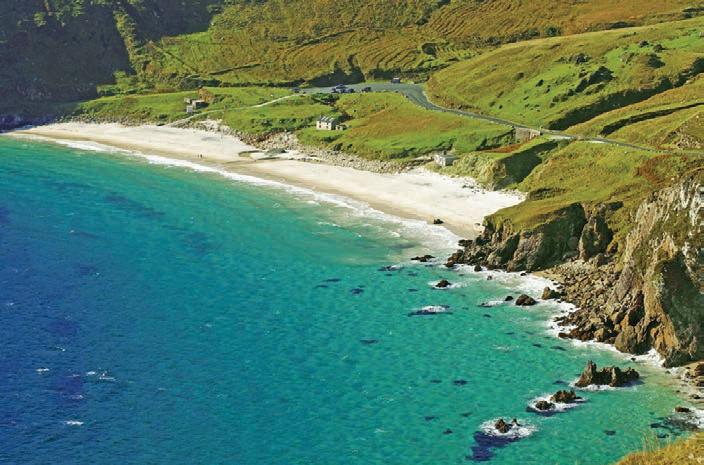

When the day’s exploring is done, Mayo’s necklace of seaside villages and welcoming towns offers an authentic Céad Míle Fáilte, where lively pubs, traditional music, and warm hospitality ensure you feel part of the community. In Mayo, every path leads to discovery, whether it’s a breathtaking coastal view, a genealogical connection, or a timeless encounter with Ireland’s ancient past.
For many U.S. visitors, Mayo is more than a holiday destination, it is a place of personal connection. The county has strong ties to Irish America, with many families tracing their heritage to this region.

WITH ITS FAMOUS 365 ISLANDS, ONE FOR EVERY DAY OF THE YEAR, CLEW BAY IS A RICH CLUSTER OF DRUMLIN-FORMED ISLETS - A VISUAL SPECTACLE UNIQUE TO THE WILD ATLANTIC WAY.
Clew Bay is one of Ireland’s most striking coastal landscapes. Shaped by the Ice Age into a scatter of green-topped drumlins, the bay is a mosaic of tiny islets shimmering in the Atlantic light. Surrounded by the mountains of Mayo, including Croagh Patrick to the south, it’s a place where land, sea and sky seem to merge in ever-changing shades of blue and green.
The bay’s calm waters are perfect for kayaking, sailing and island-hopping adventures, while the views from the coast are nothing short of spectacular. Westport sits proudly on its eastern edge, a lively base for exploring both sea and shore. From here, ferries cross to the islands, with Clare Island – the largest and most striking of them all – guarding the entrance to the bay.
Clare Island’s most famous landmark is its lighthouse, perched high on rugged cliffs at the island’s northern tip. Built in 1806, it guided seafarers safely along the Atlantic coast for more than 150 years. The adjoining keeper’s cottages still stand beside it, offering a glimpse into a time when life here meant watching the weather, tending the light and keeping sailors safe from the rocks below.
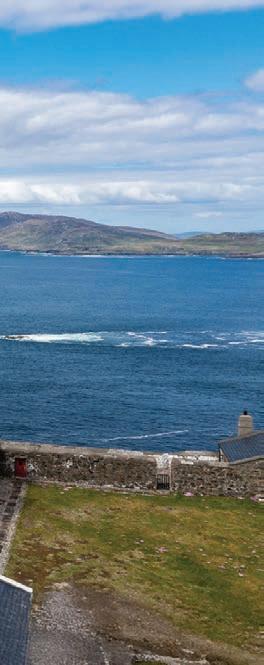
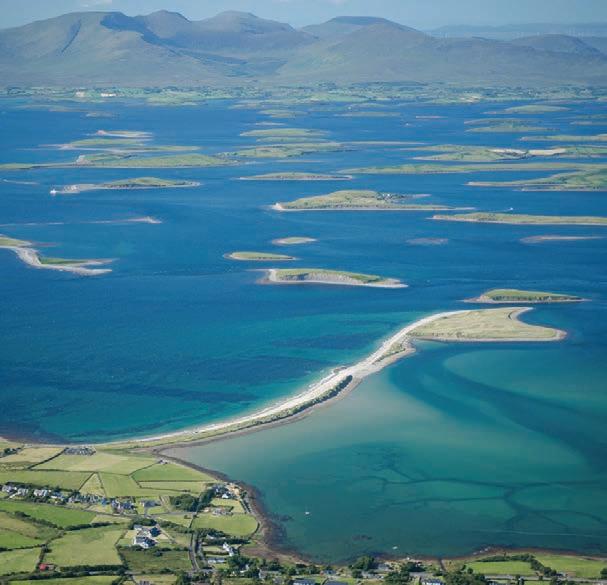

Today, the cottage and lighthouse have been restored and re-imagined as part of a unique accommodation experience. Think cliffs, salt spray, and a true escape from the ordinary. Guests can enjoy boutique self-catering stays or bed and breakfast accommodation, all framed by sweeping sea views and the soothing rhythm of the ocean. Interiors are simple, elegant and true to the spirit of the place, where comfort meets quiet luxury. Without televisions to distract (there is WiFi), time here flows to the natural rhythm of the island, inviting visitors to slow down, breathe deeply, and simply be.
Clare Island Lighthouse is the ultimate retreat when in these parts, a special place where guests are free to while away
their time in solitude or mingling in the local pubs with friendly locals, live music, and hearty food - great places to round off a day before heading back to the calm of the lighthouse. Then when it doesn’t seem like things could get any better, beacons of another kind light up the sky. After dark, low light pollution turns the setting into a natural planetarium; a breathtaking reminder of just how immense the universe really is.
Salt on the lips and wind in your sails, that’s Ireland at lighthouse level. These beacons aren’t just for navigation anymore; they’re trailheads, museums, and keys to keeper’s cottages.
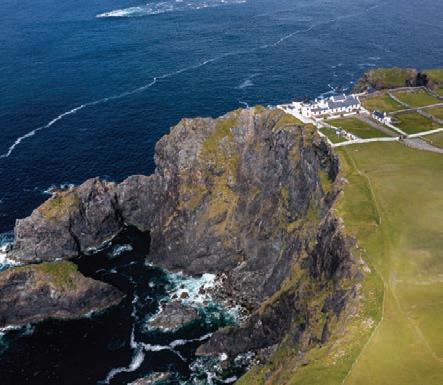


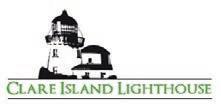




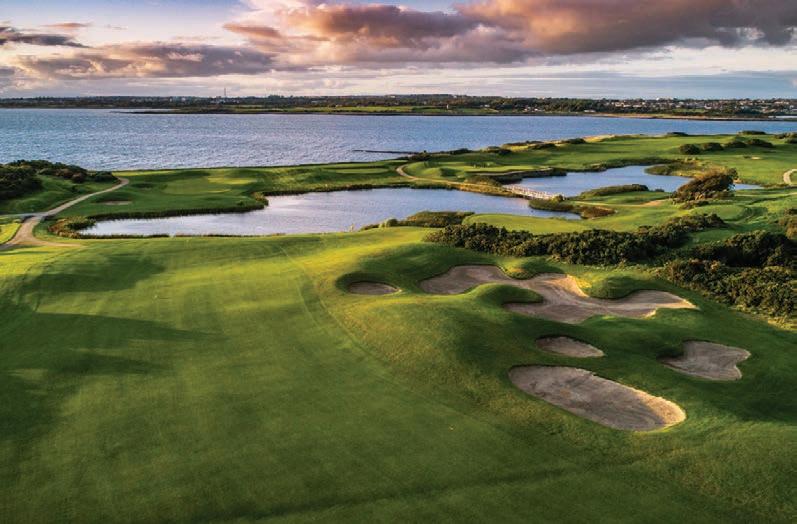
GOLF ON THE WILD ATLANTIC WAY IS PURE COASTAL THEATER. EXPECT FIRM-RUNNING FAIRWAYS, SALTY WIND AND VIEWS THAT STEAL FOCUS. THIS IS GOLF WHERE THE LANDSCAPE DOES THE TALKING.
Ballina may be small in size, but it packs quite a punch. Whether you're venturing out to the dramatic cliffs of Downpatrick Head or enjoying a round of golf at one of the nearby world-class courses, Ballina puts you in the heart of some of Ireland's most breathtaking scenery and activities.
For golfers, this part of the world is home to some classic examples of links courses, highly valued in the golfing world for their unique natural beauty and challenge. A links course is typically located along coastal areas, featuring sandy soil, natural dunes, and minimal trees. These courses are known for their rugged terrain, shaped naturally by the land rather than through heavy landscaping. The coastal location means that wind plays a significant role, adding an extra challenge for golfers. The firm, fast fairways on a links course require
players to adjust their game, making it a distinctive and traditional golfing experience. It is often considered the purest form of the sport as it remains closest to the game's origins in Scotland, where golf was first played on similar coastal terrain.
A favourite of Tom Coyne, author of ‘A Course Called Ireland,’ and of actor Bill Murray who is a life member, Carne Golf Links is located on the remote and rugged Belmullet Peninsula in County Mayo. A true gem for golf enthusiasts, this course offers a unique and idyllic golfing experience, set amidst magnificent, unspoilt sand dunes that stretch 150 meters above sea level. The sweeping views of the Atlantic Ocean, Blacksod Bay, and the legendary islands of Inis Glóire and Inis Géidhe add to its charm.
A fifteen-minute drive from Ballina, Enniscrone Golf Club in County Sligo is celebrated as one of the premier and most demanding traditional Irish links golf courses. Spanning 400 acres of stunning links terrain, the club features 27 holes, including the acclaimed par 73 Dunes Championship Links Course. This course is frequently ranked among the top links courses in Ireland and the UK, lauded for its dramatic dunes, breathtaking coastal vistas, and challenging design.
The Dunes Championship Links Course offers a rigorous golfing experience with towering dunes, rolling fairways, and strategically placed bunkers. It provides spectacular views of the Atlantic Ocean, ensuring every round is unforgettable.

The course has garnered praise from numerous golf enthusiasts and professionals.
Ballina Golf Club, nestled in County Mayo is a charming parkland course located close to the heart of Ballina town. This 18-hole course, with a par of 71, spans 5,993 meters and features a variety of four par threes, eleven par fours, and three par fives. Known for its pristine fairways, meticulously maintained greens, and strategically placed water hazards, the course offers a fair yet challenging experience for golfers of all abilities. Set against the stunning backdrop of the Ox Mountains, Ballina Golf Club is celebrated for its scenic beauty and serene atmosphere.
Strandhill Golf Club is a magnificent 18hole links course on Ireland's Atlantic coast in Strandhill, County Sligo. This par 70 course is known for its stunning vistas, with the imposing Knocknarea Mountain as a dramatic backdrop. Spanning over 6,200 yards, the course features undulating fairways and challenging shortcuts, providing a rewarding experience for golfers of all skill levels. The natural beauty

of the surrounding landscape, including Culleenamore Strand and Strandhill Beach, enhances the allure of playing here. Just one hour from Ballina, it’s well worth the drive - both to the course and on the fairways!
Rosses Point Golf Course, officially known as County Sligo Golf Club, is a distinguished links course nestled in the charming seaside village of Rosses Point, County Sligo. This historic course, crafted by the legendary Harry Colt, is celebrated for its traditional links design that seamlessly integrates with the natural contours of the dune-covered landscape.
The course provides a challenging and rewarding experience for golfers of all skill levels, featuring dramatic undulations, elevated tees, and raised plateau greens. The true beauty of Rosses Point reveals itself in the loop of holes from No. 9 to No. 12, with the final Par 5 sweeping dramatically towards the edge of Sligo Bay. This stretch offers golfers breathtaking views over the Drumcliff Estuary, framed by the powerful presence of Ben Bulben. The vista extends to the Glencar Valley, where W.B. Yeats immortalized Glencar Waterfall in his poem The Stolen Child. This poetic and scenic backdrop adds magic to the round.
No visit to Ballina is complete without going out to the awe-inspiring Dún Briste (The Broken Fort) and enjoying a scenic loop walk at Downpatrick Head. This Wild Atlantic Way Signature Discovery Point features a stunning blowhole, a WWII lookout post, and the historic Éire 64 sign etched into the headland. Follow a brisk walk with a visit to Mary's Bakery in Ballycastle - It's the perfect mix of fresh air and nature, followed by the warmth and comfort of an open fire with freshly baked Irish soda bread, scones and cakes.
For those interested in history, The Jackie Clarke Collection is a treasure trove of Irish historical material. The collection includes over 100,000 items spanning 400 years, with artifacts tied to significant figures in Irish history, including letters from Michael Collins and Theobald Wolfe Tone. It's a must-see for those interested in Ireland's revolutionary past.
The centrally located Ballina Manor hotel is more than just a place to stay. It's a perfect base for Enniscrone, Strandhill, Rosses Point, Carne and Ballina, offering comfortable accommodations with stunning views over the River Moy. This charming hotel places guests in the heart of Ballina, making it an ideal base for exploring the nearby attractions.
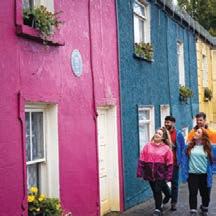
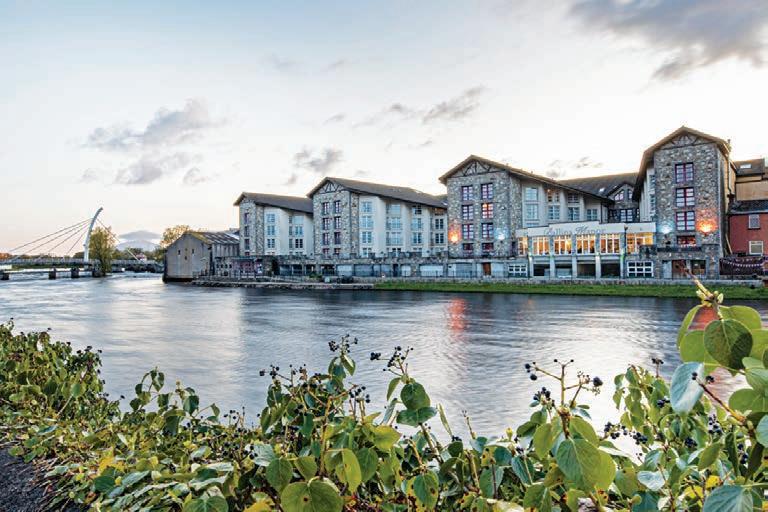
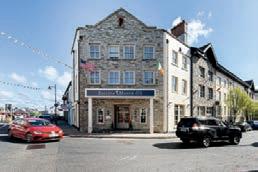


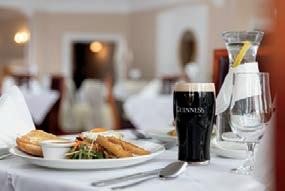


IRELAND'S WILD, RUGGED, WESTERLY MULLET PENINSULAR IS A HAVEN FOR GOLFING ENTHUSIASTS WHO ENJOY LINKS GOLF IN ITS PUREST FORM. IRISH CULTURE AND LANGUAGE ABOUNDS IN THE PLACE WHERE LOCALS SAY THAT NEW YORK IS THE NEXT PARISH OVER.
Tucked away on Ireland’s Wild Atlantic Way, the Mullet Peninsula is a hidden gem of County Mayo, offering windswept beaches, dramatic coastal scenery, and a deep connection to Irish language and culture, and home to Carne Links, one of Irelands' premier Golf Links, offering links golf at its most natural..Golf at the edge of the earth, providing a truly authentic Irish golfing experience.
Carne was the final masterpiece of the late Eddie Hackett, one of Ireland’s most celebrated golf architects. True to his philosophy of respecting the natural landscape, the course was shaped with minimal earth movement. Greens and tees emerged naturally, leaving the terrain largely untouched. Many consider Carne his greatest and most challenging creation - links golf in its purest form.
The story didn’t end there. In recent years, designers Ally McIntosh and Jim Engh completed Hackett’s vision by weaving nine new holes through the most dramatic section of the dunescape. Opened in 2020, the Wild Atlantic Dunes course integrates these new holes with Hackett’s back nine, creating a routing hailed as one of the most spectacular in the world. Golf commentators call it “the finest example of natural links golf” anywhere. Ranked number 11 among Ireland’s links courses and in the top 50 across the UK and Ireland, Carne offers traditional raw links golf at its very best in a truly unique and idyllic golfing location - a course where the landscape itself dictates the game.
Carne consistently ranks among the best, currently number 11 among Ireland’s links courses and in the top 50 in the UK and Ireland. It hosted the PGA Championship
in 2021, 2022, and 2023, and has earned multiple honors, including the Irish Golf Tour Operators Association Quality Assurance Mark, the Outstanding Service Award, and Best Links Course in Connacht in 2021, 2023, and 2025.
Golfers typically stay two days to experience both routings - Hackett’s original and the Wild Atlantic Dunes - or tackle all 27 holes in one unforgettable day. However you choose to play it, Carne offers golf as nature intended - dramatic and exhilarating.
Once you leave the fairways, relax in the wonderful seaside town of Belmullet, 3km from Carne Links. Stop into McDonnells, the town’s oldest traditional pub, where owner Padraig Conroy is as much a legend as the lively Irish music and warm
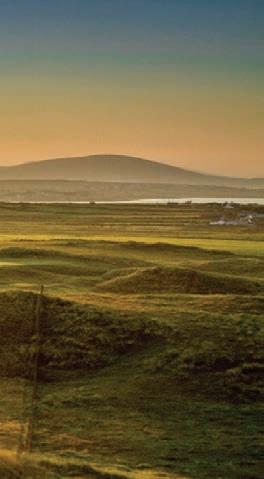
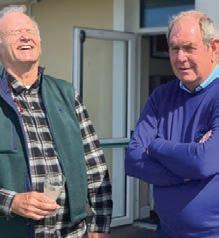
Carne Golf Links, ranked among Ireland’s top 11 links and the UK & Ireland’s top 50, has hosted the PGA Championship three years running and earned multiple awards for service and excellence, including Best Links Course in Connacht.
welcome inside. Belmullet also boasts a variety of pubs and restaurants, each worth exploring in their own right. The next morning, clear your head with a dip in the tidal pool on Shore Road. It takes bravery to face the chill of the Atlantic, but the reward is spectacular views across the bay to Achill Island. For a different kind of adventure, head offshore to the Iniskea Islands, where dolphins often play alongside the boat, or venture out to see the dramatic Stags in the Atlantic - a group of five steep rocky islands off Benwee Head. Back on the peninsula, visit Blacksod Lighthouse, famed for the critical role it played in the D-Day landings, then spend time at the nearby Solas Visitor Center to uncover the area’s rich heritage. A short drive brings you to the Céide Fields Visitor Center, home to an extraordinary Neolithic site dating back nearly 6,000 years - older than the pyramids. Continue onward to Downpatrick Head, where the famous Dún Briste Sea Stack rises from the Atlantic in one of Ireland’s most striking coastal views, rivaling even the Cliffs of Moher. The wider Erris region of North Mayo is a treasure trove for walkers and nature lovers, with trails that remain largely undiscovered and landscapes among the most scenic in Europe. For travelers who crave both beauty and authenticity, it is a place not to be missed.
When it comes to accommodation, visitors are spoiled for choice. In Belmullet, just a short drive from Carne Links, options include The Talbot Hotel, Broadhaven Bay, and the Erris Coast Hotel, each offering
comfortable stays with easy access to the course. For golfers planning to play several courses across the Northwest, the nearby town of Ballina makes an excellent base. There you’ll find a range of quality hotels including Mount Falcon, the Ice House, Belleek Castle, Hotel Ballina, and the Diamond Coast - a convenient hub for exploring the region’s golf and natural beauty.
For those planning a golf trip through Ireland’s Northwest, Carne pairs naturally with Enniscrone and Strandhill Links for a classic three-course itinerary. From there, many golfers continue north to Ballyliffin, host of the Irish Open, before pushing further into Northern Ireland to play Castlerock, Portstewart, Portrush, and the world-renowned Royal County Down. Turning southward, the journey can take in Beltray in County Louth and the Jamieson Links at Portmarnock, before returning to Dublin for the flight home. Another option is to play Carne and then head toward Westport Golf Course, passing through the beautiful Nephin National Park. From there, continue to Connemara Links, reached via one of the most spectacular road trips in Ireland through Killary Fjord and Harbor, with the chance to stop at Kylemore Abbey before arriving in Ballyconneely. From Connemara, the route south naturally flows to Lahinch, one of Ireland’s most celebrated links.
For more information, visit: www.carnegolflinks.com

In Ireland, faith and everyday life have always gone hand in hand. In almost every town, there’s a church and a pub; two gathering places that speak to the heart and spirit in different ways. Over centuries, this balance of belief, community, and tradition has shaped how people live, celebrate, and reflect. Spirituality here isn’t confined to churches or rituals; it’s felt in the landscape itself, in quiet valleys, mountain paths, and the rhythm of village life.
Across the country, holy sites and pilgrim trails tell stories of devotion that reach back through time. At Glendalough in County Wicklow, stone churches and round towers stand among forested hills, where early monks sought peace and purpose. At Clonmacnoise, on the banks of the River Shannon, carved crosses and ancient ruins mark one of Ireland’s earliest centers of worship and learning.
Nowhere, though, does that connection between faith and place feel stronger than in County Mayo, long regarded as the spiritual heart of the west. Here, Croagh Patrick rises above Clew Bay, a place of pilgrimage and endurance for more than 1,500 years. Known locally as the Reek, the mountain is said to be where St. Patrick fasted for forty days and nights in the fifth century. Each year, particularly on the last Sunday of July - Reek Sunday - thousands of pilgrims climb the steep, stony path to the summit, some barefoot, in a tradition that connects faith and resilience. From the small white chapel at the top, the view stretches across the bay, dotted with islands that seem to mirror the rosary itself. Whether climbed as an act of devotion or simply as a test of spirit, Croagh Patrick is a powerful symbol of Ireland’s living faith.
Ireland’s holy places have a grounded kind of strength. Many are part of everyday life - a small church at the heart of a town, a holy well on the edge of a field, or a shrine looking out to sea. They remain places of quiet connection, where people come to pause, give thanks, or simply take a moment to be still.
In Mayo, that spirit continues to draw people from near and far. Knock Shrine, one of the world’s major Marian pilgrimage sites, welcomes visitors drawn by the story of the 1879 apparition. Often described as Ireland’s Lourdes, Knock followed the famous French shrine by just two decades and has become a place of comfort and renewal for generations of pilgrims. Not far away, the Father Peyton Centre in Attymass honors the legacy of the Rosary Priest, whose message of faith and family prayer continues to inspire people worldwide.
Together these sites represent Ireland’s enduring tradition of pilgrimage, a journey not only across distance but inward, toward stillness and meaning. In these places, visitors find what generations before them have always found: moments of reconcilliation and reflection.
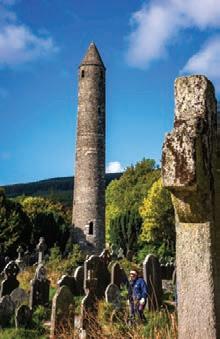

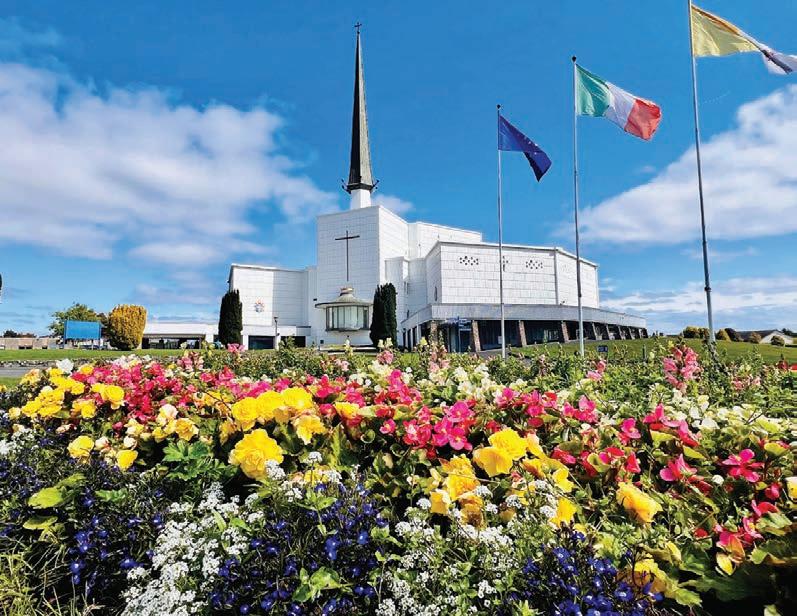
IN THE HEART OF COUNTY MAYO, KNOCK SHRINE IS IRELAND’S INTERNATIONAL EUCHARISTIC AND MARIAN SHRINE, A SACRED PLACE THAT WELCOMES OVER A MILLION PILGRIMS AND VISITORS EACH YEAR.
Spread across more than 100 acres of tranquil gardens and mature woodland, this unique destination offers a deeply moving experience, blending faith, history, and the natural beauty of the Irish countryside.
In the late 19th century, Knock was a modest rural village like many others in the west of Ireland, with simple thatched cottages, two small schools, and a humble parish church at its center. On the
evening of August 21, 1879, something extraordinary happened: Our Lady appeared at the gable wall of the church, accompanied by St. Joseph and St. John the Evangelist. At the heart of the vision stood a Lamb on an altar before a cross, a powerful Eucharistic symbol unique to the Apparition at Knock. This divine encounter transformed the village forever, turning it into a spiritual destination for pilgrims seeking healing, peace, and connection.
Today, Knock Shrine remains a place of pilgrimage, hope, and renewal, drawing people from across the world. The Apparition Chapel, a glass-encased structure built around the gable wall where the vision occurred, houses a stunning Carrara marble tableau that faithfully recreates the scene, based on the detailed accounts of the fifteen witnesses.
This sacred site invites reflection, awe, and a deep sense of the presence of God.

Steeped in fascinating history, Knock Shrine is a unique place of pilgrimage that continues to welcome people from all over the world, who come to experience the sacred, peaceful atmosphere of Ireland’s International Eucharistic and Marian Shrine.
Whether you visit for a few hours or a few days, Knock offers countless opportunities for prayerful reflection and peaceful retreat. Its expansive grounds, more than 100 acres of landscaped gardens, woodlands, and winding pathways, encourage a slow, meditative pace.
A highlight is the Creation Walk, which invites pilgrims to experience the beauty of nature as a reflection of God’s presence, offering moments of silence, stillness, and renewal along the way.
Knock Shrine is also home to an inspiring collection of sacred art by both Irish and international artists:
• Stained glass windows by the celebrated Harry Clarke
• Sculptures of Irish saints by Canadian artist Timothy Schmalz
• Outdoor holy water fonts by GermanIrish sculptor Imogen Stuart
• The magnificent Apparition Mosaic in Knock Basilica, created from over 1.5 million pieces of glass, designed by acclaimed illustrator PJ Lynch These works do more than beautify the grounds. They enrich the pilgrimage experience and uplift the soul.
Within the Shrine grounds, five churches await exploration, each with its own
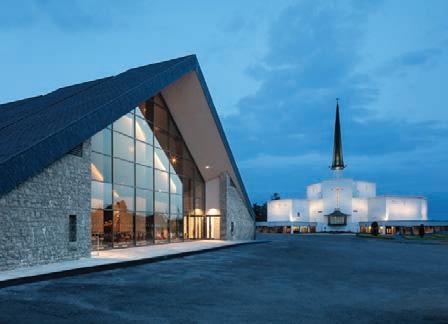


unique story and spiritual atmosphere. From the historic Parish Church, dating back to 1828, to the vast and modern Knock Basilica, the architecture reflects both Ireland’s deep Catholic heritage and its living faith.
Knock Shrine offers a full spiritual program throughout the year, including daily Mass, Confessions, and a rich calendar of Faith Renewal events such as retreats, workshops, and guided reflections. During the pilgrimage season (April to October), visitors can take part in special ceremonies, processions, and outdoor devotions.
Pilgrims are welcome to light candles at the outdoor candelabra, seek Prayer Guidance or Spiritual Direction, or join Evening Prayer in the Apparition Chapel,
where silence deepens the sense of the sacred.
Groups accompanied by a priest are invited to celebrate Mass in the intimate and holy setting of the Apparition Chapel.
To fully appreciate Knock’s story, begin your visit at the award-winning Knock Museum. This carefully curated space traces the timeline of Knock from the night of the Apparition through to the present day. Highlights include:
• Original witness testimonies from 1879
• The poignant “Diary of Cures,” letters from pilgrims who experienced healing
• A detailed 3D model of the village as it appeared in the 19th century, offering a fascinating glimpse into the simplicity of life at the time
For those exploring independently, free audio guides are available, while guided group tours can be arranged through the Museum’s experienced and welcoming team.
Knock Shrine inspires the spirit, lifts the heart, and allows visitors to return to everyday life recharged, renewed, and at peace.
More than a historical site, Knock Shrine is a living sanctuary of faith, peace, and comfort. Visitors of all ages and backgrounds are welcomed with warmth and compassion, creating a space where hearts are lifted, burdens eased, and hope rekindled.
Whether you come seeking healing, silence, inspiration, or connection, Knock invites you to slow down, breathe deeply, and let stillness find you.
More information about Knock Shrine is available at www.knockshrine.ie, where you can also join ceremonies live online each day from Ireland’s International Eucharistic and Marian Shrine.
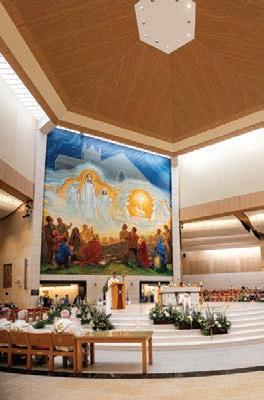



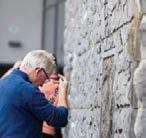
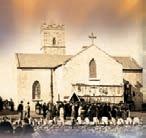


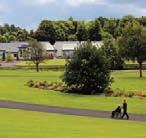
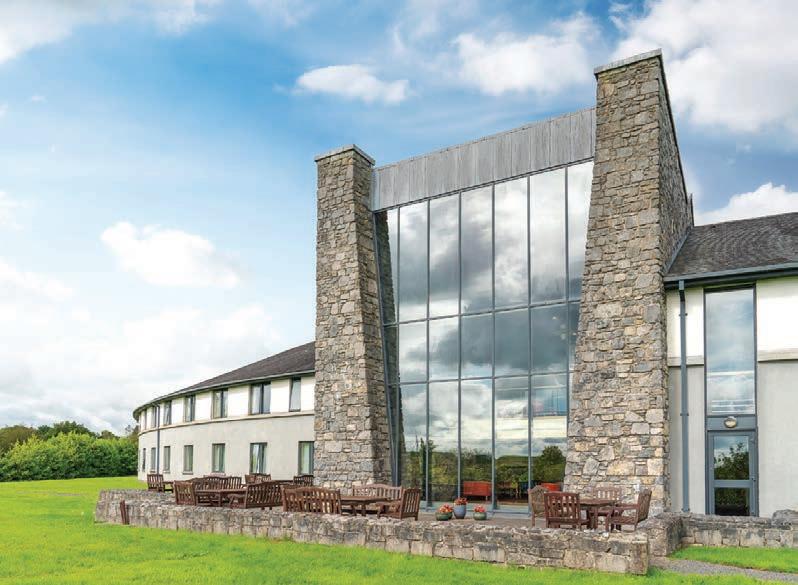
PEACEFULLY SET WITHIN THE GROUNDS OF THE WORLD-RENOWNED INTERNATIONAL MARIAN AND EUCHARISTIC SHRINE, KNOCK HOUSE HOTEL OFFERS MORE THAN JUST A PLACE TO STAY - IT OFFERS A CHANCE TO PAUSE, REFLECT, AND RECONNECT.
As the only hotel located on the Shrine grounds, guests enjoy the unique privilege of walking directly from their rooms to daily Mass, prayer services, and the peaceful atmosphere that draws pilgrims from around the world. The hotel warmly welcomes both individual tourists and group pilgrimages from Ireland and abroad, offering thoughtful hospitality for tours, retreats, and faith-based journeys. Whether booking in advance or planning a last-minute visit, guests are encouraged to reserve directly through the hotel's website, or over the phone, for the best rates and personalized service.
Conveniently located in the heart of Connacht, Knock House Hotel enjoys a central setting amidst a tapestry of cultural and natural attractions. Situated on the grounds of Knock Shrine and adjacent to the enlightening Knock Museum, guests have easy access to both spiritual reflection and historical exploration. The hotel is also just a five-minute drive from the Connacht GAA Air Dome in Bekan, a nearby venue for sports events and activities. Positioned along the N17 main route in the scenic west of Ireland, the hotel provides a strategic link between
the vibrant cities of Sligo and Galway via Mayo. Claremorris railway station is a convenient 10-minute drive away, offering seamless travel connections for guests arriving by train. For air tourists, Knock House Hotel is the closest hotel to Ireland West Airport, ensuring a hassle-free journey for visitors flying into the region. Thanks to its central location in Connacht, guests are ideally positioned to explore the many wonders of the surrounding area, from the rugged beauty of Mayo’s coastline to the cultural charm of Galway and Sligo.
A visit to this part of Ireland offers many opportunities to enrich your stay. Just a short and scenic drive from Knock House Hotel lies Croagh Patrick, Ireland’s sacred mountain. For centuries, pilgrims have climbed its slopes in prayer and contemplation, drawn by its deep spiritual significance and the breathtaking views over Clew Bay from the summit. Guests are also well placed to explore the charming town of Westport, known for its colourful streets, vibrant culture, and welcoming cafés, shops, and restaurants - all just a convenient journey from the hotel. No matter the season, Knock House Hotel is open 365 days a year, and we extend a warm invitation to guests wishing to stay with us at Christmas and throughout the festive season. Whether you seek a peaceful retreat, time for reflection, or simply a restful getaway, you will find a true sanctuary here at any time of year.
Beyond Knock, the surrounding Mayo and Connacht region is rich in spiritual heritage. Within a short and scenic drive, visitors can explore:
• The iconic Kylemore Abbey, known for its breathtaking setting and enduring Benedictine tradition.
• The Fr. Peyton Centre, dedicated to the global mission of Fr. Patrick Peyton, the Irish-born priest affectionately known as “The Rosary Priest.” Famous for his powerful prayer campaigns and media
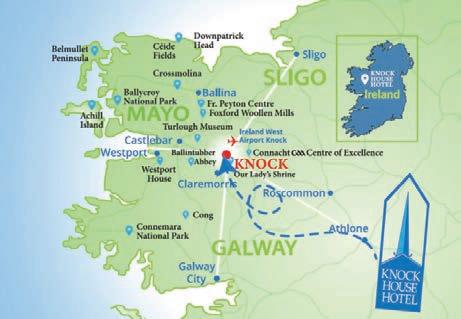
outreach in the U.S., he founded the American-based Holy Cross Family Ministries and remains a beloved figure among Irish American families.
• The historic Ballintubber Abbey, where Mass has been celebrated for over 800 years.
• And many more sacred sites, ancient churches, holy wells, and spiritual landscapes that echo Ireland’s deep religious roots.
While summer is a popular time to visit, Ireland’s climate is famously mild yearround, with few extremes. This makes

Knock an ideal destination for those seeking a quieter, more contemplative experience outside the peak season. Every time of year brings its own grace to this sacred corner of Ireland. With warm Irish hospitality, home-cooked meals, and a peaceful setting, Knock House Hotel offers a true sanctuary for the soul - no matter the season.
Knock House Hotel Knock, Co. Mayo, F12 R6Y5 | T: +353 (0)94 9388088 Book direct at www.knockhousehotel.ie


DISCOVER TRANQUILITY AND LEGACY AT THE FATHER PEYTON CENTRE IN COUNTY MAYO
Nestled at the foot of the Ox Mountains in the heart of County Mayo, the Father Peyton Centre is a true hidden gem. Welcoming visitors from across the globe, this year-round sanctuary is both a cultural treasure and a peaceful retreat, a place where history, faith, and natural beauty come together in harmony.
The Centre honors the life and legacy of Venerable Patrick Peyton C.S.C., one of Ireland’s most influential spiritual figures and a beloved advocate for family prayer. Known worldwide as “The Rosary Priest,” Father Peyton dedicated his life to
spreading the message: “The family that prays together stays together.”
Patrick Peyton was born in 1909 in the rural village of Attymass, the sixth of nine children raised on a small farm. Though he dreamed of becoming a priest, his family could not afford to send him beyond primary school. Together with his brother Tom, he emigrated to the United States, where he completed his high school studies and later attended Notre Dame University in Indiana. Near the end of his training for the priesthood, he contracted tuberculosis and was given little hope of survival.
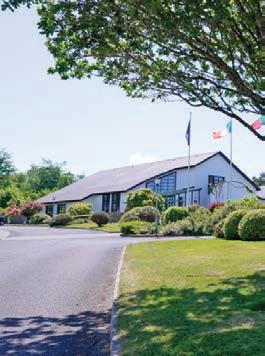


Choosing prayer over surgery, he and his family turned to Our Lady for intercession. To the astonishment of his doctors, Patrick recovered and was ordained in 1941.
In gratitude for what he saw as a miraculous healing, Father Peyton pledged to devote his life to promoting family prayer. He launched the Family Theatre program in Hollywood, enlisting stars like Bing Crosby, James Stewart, and Maureen O’Hara, who volunteered their talents to the cause. His Rosary rallies drew millions across the world, reaching an estimated 26 million people during his lifetime and bringing family prayer into hundreds of millions of homes through radio, television, and film.
The Father Peyton Centre now stands in the very village where he was born, offering
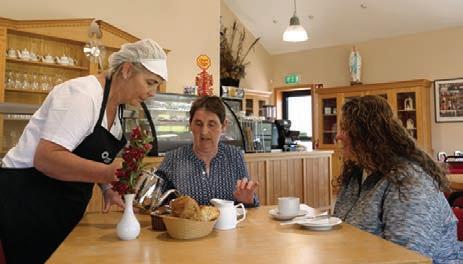



a rich and immersive experience of his vision. Highlights include:
• A DVD presentation of Father Peyton’s remarkable life story
• Guided tours featuring personal items such as his rosary beads, vestments, and photographs
• A gift shop and bookstore filled with religious items, Irish crafts, and literature on Father Peyton and Irish heritage
• A restaurant renowned for its fresh, locally sourced ingredients and homemade baking, especially apple tarts and scones
• A prayer garden and looped walking trails, perfect for quiet reflection or for walkers and cyclists exploring the Mayo countryside
The Centre is also a hub of community life. Each Tuesday, senior citizens from surrounding areas gather for Mass, lunch, and social activities with support from Local Link Bus Services. More than 1,000 students participate annually in its school retreat program, which fosters selfawareness and connection through group activities. For those planning pilgrimages or retreats, staff can tailor programs for both youth and adults.
For visitors seeking an overnight stay in peaceful surroundings, the Melody Residence offers seven ensuite bedrooms, each fully wheelchair accessible, along with spacious communal areas. Named after Father William Melody, a cousin of Father Peyton and a key supporter of the Centre’s establishment, it is an ideal base for families, groups, or solo travelers. Set between Ballina and Foxford, the residence is perfectly placed for exploring the River Moy, the Foxford Woollen Mills, or simply enjoying the serenity of Mayo’s countryside.
Whether you are drawn by history, faith, or the desire for a quiet escape, the Father Peyton Centre and Melody Residence offer a unique experience rooted in inspiration, steeped in legacy, and surrounded by natural beauty. To learn more, plan a visit, or book accommodation at the Melody Residence, contact the Father Peyton Centre or visit www.fatherpeytoncentre.ie

A HISTORIC LAND OF CULTURE AND SCENERY IS CLOSER THAN YOU THINK. WITH EUROPCAR, EVERY ROAD IN IRELAND OPENS INTO AN ADVENTURE OF ITS OWN.
As autumn leaves give way to winter sparkle, and spring blossoms herald longer days, Ireland extends a timeless invitation. This is a country where heritage and modern culture meet across landscapes that linger in memory. Then comes summer, when golden evenings stretch across the countryside and coastal drives reveal breathtaking views. For US visitors arriving at Shannon or Dublin, every road leads to discovery, and each journey begins with the freedom of a Europcar rental car.
Winter Warmth and Spring Renewal
Winter in Ireland is alive with warmth. Dublin glistens with lights, Cork and Galway hum with Christmas markets,
and villages gather around music, food, and tradition. For those tracing ancestral roots, this is the chance to walk through cobblestoned streets where stories began, or step inside centuries-old churches that carry echoes of family history.
Ireland’s landscapes at this time are cinematic. The Wild Atlantic Way, one of the world’s most celebrated coastal routes, unveils dramatic cliffs and windswept beaches. The Wicklow Mountains and Connemara shimmer with mist and renewal. Whether you seek festive celebration or quiet reflection, Ireland offers experiences that unfold with the rhythm of the seasons.
Ireland Today
Ireland is known for castles and folklore, but today’s Ireland is equally about vibrant culture and creativity. Dublin brims with literary heritage, Michelin Star restaurants, and a thriving arts and music scene. Limerick has become a hub for food and design, while Galway blends performance and music into everyday life. Beyond the cities, the adventure continues. With Europcar, travelers can hike the limestone landscapes of the Burren, kayak the lakes of Killarney, or explore the wild beauty of Donegal. Whether during winter’s stillness or summer’s long evenings, the landscapes remain unforgettable, paired with the warmth of Irish hospitality.
Your Travel Hub Europcar is offering 10% off car rental for travel between September 2025 and May 2026. For US travelers, Shannon and Dublin Airports are the key gateways. Shannon opens directly onto the Wild Atlantic Way, while Dublin provides immediate access to city adventures and Ireland’s eastern beauty.
With 27 locations nationwide, Europcar makes it easy to pick up a car where you land and drop it off at the end of your trip. This wide network of locations means you’re never far away from a Europcar branch. This coverage means you are always close to support and convenience. Travelers heading north to Belfast, the Giant’s Causeway, or Game of Thrones filming locations can cross the border with ease, with only a small additional charge.
For US Travelers Europcar makes the road easy to navigate
with automatic transmission cars, perfect for visitors from the United States. From compact city cars to spacious SUVs for families, there is a vehicle for every trip. Seamless airport pick up and drop off make starting and ending your journey simple.
Travelers may also choose to work with established tour operators for curated experiences, then combine this with Europcar’s flexibility. It is the best of both worlds: guided insight and the freedom to explore at your own pace.
Dream. Drive. Discover. Ireland is waiting. Europcar is more than car rental - it is freedom: to linger in a seaside café, to pause at a hidden ruin, or to take a detour through a charming village.
Ireland Awaits: Your journey begins the moment you arrive.
With 10% off, simply scan the QR code below to book your Irish adventure today or for more information see: www.europcar.ie/en-ie/p/offers/ustravel
• 27 locations across Ireland for unparalleled convenience
• Automatic cars tailored for US travelers
• A premium fleet from compact cars to SUVs
• Nationwide support always within reach
• Seamless pick up and drop off at airports
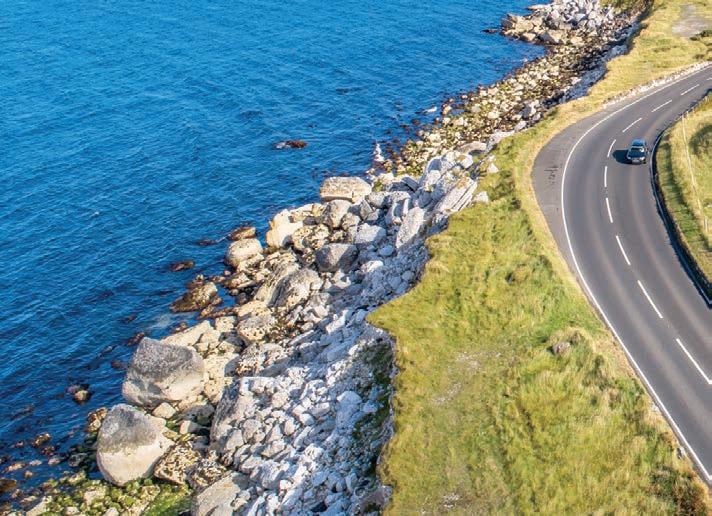




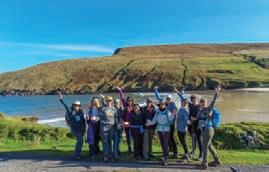

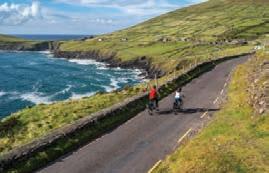



FOR TRAVELERS WHO LOVE THE OUTDOORS AND DREAM OF EXPLORING IRELAND’S CHARACTER-FILLED VILLAGES, WILD CLIFFS, AND ROLLING HILLS, IRELAND WALK HIKE BIKE OFFERS THE PERFECT SOLUTION.
For thirty years, this award-winning company has been crafting adventures for those who want to discover the soul of Ireland through guided and self-guided hiking, cycling, and self-drive tours.
Ireland Walk Hike Bike takes care of every detail, whether you prefer the sociability and camaraderie of group travel or the independence of going solo. All you need to do is enjoy the seamless, hassle-free experience of 24/7 support, detailed route notes, and carefully selected accommodations. Whether your goal is to explore iconic routes such as the Ring of Kerry, Dingle Peninsula, or Wicklow Way, or you’re dreaming of roaming off the beaten path, Ireland Walk Hike Bike reveals a landscape of ancient ruins, secret coves, and welcoming, authentic pubs.
For those who prefer an experienced local guide to share the history and stories of
the land, the company’s Guided Hiking or Cycling Tours turn each trail into a lasting memory. Hike the limestone flats of the Burren, follow the pilgrim path up Croagh Patrick, or feel the wild winds atop the Cliffs of Moher with confidence, knowing your guide has everything in hand - including where to find the best spot for a pint of the black stuff at day’s end.
The Self-Guided Hiking or Cycling Tours are designed for free spirits with adventure in their hearts who prefer to explore at their own pace. Ireland Walk Hike Bike’s experts handle the logistics, from luggage transfers and GPS navigation to insider local tips, leaving you free to enjoy the open road. Whether you dream of cycling the famous Wild Atlantic Way, rambling the paths less traveled through the untouched panorama of the Sheep’s Head Peninsula, or pedaling at leisure along country lanes with the coastal
stretches of Dingle unfolding before you, a Self-Guided Tour will leave Ireland etched in your heart.
Travelers short on time but unwilling to compromise on experience can enjoy the ultimate flexibility of a Self-Drive Tour. These curated itineraries let you skip the hours of planning and dive straight into discovery, exploring mountain passes, dramatic coastlines, and cultural highlights with hand-picked accommodations and expert recommendations along the way.
Whether your perfect adventure is on foot, by bike, or behind the wheel, Ireland Walk Hike Bike crafts experiences that go beyond sightseeing. Each journey connects you to the people, places, and captivating beauty that make Ireland unforgettable.

STEP INTO IRELAND’S ANCIENT HEARTLANDS WHERE KINGS ONCE RULED, WARRIORS FOUGHT, AND LEGENDS WERE BORN. FROM TARA TO RATHCROGHAN, THESE LANDSCAPES STILL HUM WITH THE SPIRIT OF IRELAND’S LEGENDARY PAST.
Ireland is often described as a mythical land but nowhere is that more tangible than at the Six Royal Sites. These were not castles in the medieval sense but ceremonial landscapes where Irish kings were inaugurated, rituals performed, and gatherings held that shaped the destiny of entire provinces. Today they are places where visitors can walk in the footsteps of High Kings and legendary warriors, while also experiencing some of the island’s most atmospheric landscapes.
Taken together, the Royal Sites form a trail into Ireland’s deepest past. They are at
once archaeological wonders, mythological landmarks, and living reminders of how Irish communities once ordered their world. For U.S. travelers looking for more than sightseeing, they offer something rare: a chance to step into landscapes where history and imagination still mingle.
If there is a spiritual heart to Ireland, it may well be found at the Hill of Tara. Rising gently from the Boyne Valley, this landscape was once the seat of Ireland’s High Kings, a place where rulers were inaugurated at the Lia Fáil, the Stone of Destiny. Legend
has it the stone would roar if touched by the rightful king.
From its grassy summit, views stretch for miles across the fertile countryside, a panorama that explains why Tara held such importance. Archaeologists have identified over 100 monuments here, from Neolithic passage tombs to Iron Age earthworks. For visitors, the sense of continuity is remarkable; to stand where kings once stood, where druids once invoked the gods, and where myths were woven into memory. Tara remains a place of pilgrimage, not just for historians but for those seeking


connection with Ireland’s soul. You don’t need to know the myths of Cormac mac Airt or the invasions of the Fianna to feel the atmosphere here, though hearing them, often told by local guides, enriches the experience.

If Tara was the royal seat of Ireland’s High Kings, Rathcroghan was the capital of Connacht, the western province. This sprawling landscape of over 240 archaeological monuments includes burial mounds, ringforts, ceremonial avenues, and inauguration sites, many still visible in the fields today.
It is here that Queen Medb, the great warrior queen of Irish mythology, is said to have ruled. Her palace mound still dominates the horizon, and beneath the surface lies the Cave of Oweynagat, the “Cave of the Cats.” Medieval scribes recorded that at Samhain - the Celtic festival that gave birth to Halloween - monstrous creatures emerged from this cave to ravage the land. No wonder it is often called Ireland’s “Gate to Hell.”
Rock of Cashel, Tipperary
Few places in Ireland strike as dramatic a profile as the Rock of Cashel. Rising from the plains of Tipperary, this limestone
outcrop crowned with medieval towers and battlements seems almost made for legend. Once the seat of the kings of Munster, it later became a major ecclesiastical center. St. Patrick is said to have converted King Aenghus here in the 5th century, cementing Cashel’s reputation as both a royal and a sacred site. The buildings that remain - a 12th-century round tower, a vast cathedral, and Cormac’s Chapel with exquisite Romanesque carvings - testify to centuries of power.
Today, Cashel is one of Ireland’s most visited landmarks, and for good reason. It combines epic scenery with layered history, from pagan kingship to medieval Christianity. Walking among its ruins, with the wind whipping across the fields, visitors often describe a sense of awe. Cashel doesn’t just tell Ireland’s story, it embodies it.
Navan Fort (Emain Macha), County Armagh In Ulster, the royal site was Navan Fort, known in Irish as Emain Macha. It looms large in the Ulster Cycle, one of the great collections of Irish mythology. Here ruled King Conchobar mac Nessa and the warriors of the Red Branch, and here the boy hero Cú Chulainn performed feats that still echo in legend.

Archaeology confirms that Navan Fort was more than myth. Excavations reveal massive wooden structures and ritual deposits, including the remains of a huge temple-like building deliberately burned and buried around 95 BC. Scholars believe it was a ceremonial site of immense importance, tied to both kingship and the cycles of the natural world.
The Navan Centre & Fort allows visitors to experience both sides of this story, the archaeology and the myth. Interactive exhibits, reconstructed dwellings, and storytelling bring the Iron Age to life, making it easy to picture warriors feasting, druids divining, and rituals unfolding on this sacred hilltop.
Dún Ailinne and Knockaulin, County Kildare.
Leinster’s royal site was Dún Ailinne, a hilltop enclosure near Kilcullen. Though little is visible today, excavations have uncovered evidence of vast wooden halls and ritual activity, pointing to a place where communities gathered for seasonal festivals and ceremonies of kingship.
Unlike Cashel or Tara, Dún Ailinne is quieter, less visited, but no less evocative. Standing on its summit, you look out over the Kildare countryside and sense the significance it once carried. This was not a fortress but a

ceremonial center; a place of gathering, of feasting, and of ritual that bound people together.
Not far from Dún Ailinne lies Knockaulin, another earthwork site linked with Leinster’s royal tradition. Its broad ringed enclosure, over 1,300 feet in diameter, marks it as a place of real significance. Though little is visible to the casual eye, the site offers sweeping views and a sense of quiet majesty.
Together, Knockaulin and Dún Ailinne emphasize that kingship in ancient Ireland was not centralized in a single palace but expressed across landscapes. They remind us that power was a ritual as much as a reality, rooted in the land itself.
To explore the Six Royal Sites is to weave together archaeology, mythology, and landscape. Each site is different - some dramatic and crowded with visitors, others quiet and little known, but all offer insight into how Ireland once saw itself.
For U.S. travelers, they provide more than sightseeing; they are a way to experience Ireland not as postcard views but as a living story. Stand on Tara’s summit and picture the High Kings, wander Rathcroghan and listen for the echoes of Queen Medb, climb
Cashel and think of St. Patrick’s conversion, walk Navan Fort and imagine Cú Chulainn’s feats. Each place invites participation, imagination, and reflection. Perhaps most powerfully, they remind us that Ireland’s past was never just about rulers and warriors. It was about communities, beliefs, and connections to the land - themes that still resonate today.
Ireland is often described as a mythical land but nowhere is that more tangible than at the Six Royal Sites.
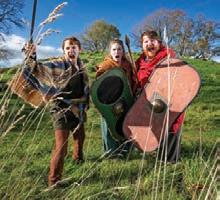
Rathcroghan Visitor Centre lies within the archaeological landscape of Rathcroghan / Cruachan Aí. As one of the six Royal Sites of Ireland, the Rathcroghan Archaeological landscape has been nominated to the tentative list for UNESCO World Heritage status and boasts over 240 archaeological sites which vary from Stone Age tombs to royal burial mounds, great ringforts to ceremonial inauguration sites and massive linear earthworks.
At Rathcroghan you will discover the archaeology, history and mythology of Connacht’s prehistoric royal Capital and tread across this ancient landscape in the footsteps of the Warrior Queen Medb. You will hear the epic tale of the Cattle Raid of Cooley which features a host of legendary heroes including Medb herself, the Battle Goddess Mórrígan, the Connacht warrior Fráoch, and the boy hero Cú Chulainn.
Samhain /Halloween at Rathcroghan
Samhain traditionally marks the coming of winter and it would have been a last
chance to celebrate the end of the harvest before preparing for the challenge of winter. As Samhain also marks the natural interval between summer and winter, this time of the year provided ease of access across the borders from this World to the Otherworld, whose traditional entrance is the Cave of Oweynagat (Cave of the Cats), centrally located on the Rathcroghan landscape.
It is from this cave at Samhain that medieval scribes recorded the emergence of fearsome otherworldly beasts to ravage the surrounding landscape and make it ready for winter.
With the cave of Oweynagat being the home of Halloween, and reputed as Ireland’s Gate to Hell, what better way to spend Halloween, the ancient festival of Samhain, than by a special guided visit to Rathcroghan. To facilitate this journey, we offer both our daily site tours and our unique seasonal ‘Origins of Samhain’ tour. This is a daily tour to Oweynagat, the birthplace of Samhain … for those who dare…!
Outside of our award-winning site tour and museum rooms, Rathcroghan Visitor Centre regularly host a series of extracurricular events, including Reviving the Óenach - a blended lecture series marking the traditional seasonal Gaelic festivals, Heritage Week, Culture Night and Seachtain na Gaeilge events and Archaeology Above & Below - Ireland’s only annual community archaeology conference.
If you are interested in any of our tours, events and activities, why not find out more by following us on social media or subscribing to our mailing list via our website at www.rathcroghan.ie

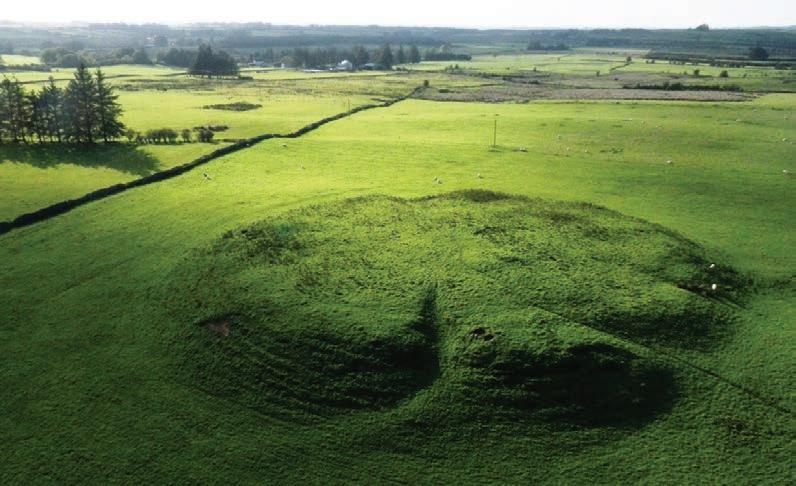
County Meath, often called the Royal County, carries layers of spirituality that reach far beyond the legends of kings and coronations. While the Hill of Tara is celebrated as the symbolic seat of power, the wider landscape of Meath hums with a sanctity that predates kingship itself.
The Boyne Valley is Meath’s spiritual spine. Here rise the great passage tombs of Newgrange, Knowth, and Dowthmonuments that are older than both the pyramids of Egypt and Stonehenge. Together they form Brú na Bóinne, a UNESCO World Heritage Site that stands among the most significant prehistoric landscapes in the world. These were not merely burial places but cosmic temples, aligned with the movements of the sun. Most famously, at dawn on the winter solstice, sunlight pierces the inner chamber of Newgrange, flooding it with light in a moment of extraordinary drama - proof that Ireland’s ancestors built
with engineering genius and cosmic vision. Christianity layered new forms of sanctity upon this sacred ground. Monasteries such as Monasterboice, with its towering high crosses, and the great monastic city of Kells became beacons of early faith. Monks in Meath illuminated manuscripts, carved scripture into stone, and preserved learning that would later spread across Europe.
What makes Meath so powerful is the atmosphere created by this fusion. The Boyne Valley, with its tumbling river and fertile plains, feels like a natural cathedral. Fields hold echoes of ceremony, mounds conceal ancient chambers, and medieval ruins stand as reminders of prayer and pilgrimage. Many visitors describe a sense of calm here that is hard to put into words, as if the land itself carries memory and meaning.
For modern travellers, Meath offers not only monuments to explore but also moments of quiet reflection. Guided tours of Brú na Bóinne bring visitors face to face with
chambers that have stood since before the pharaohs. At Trim, Ireland’s largest Norman castle towers over the River Boyne, its formidable walls recalling centuries of sieges. Nearby, heritage centres, walking trails, and local guides bring the county’s sacred and historic landscapes to life, offering a journey that blends awe, discovery, and connection.
County Meath is a sacred landscape, where Ireland’s spiritual story is written into every ridge, mound, and river bend. To journey here is to touch something timeless, and to discover why this land has been the heart of Ireland for over 5,000 years.
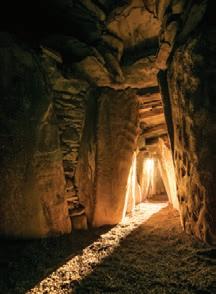
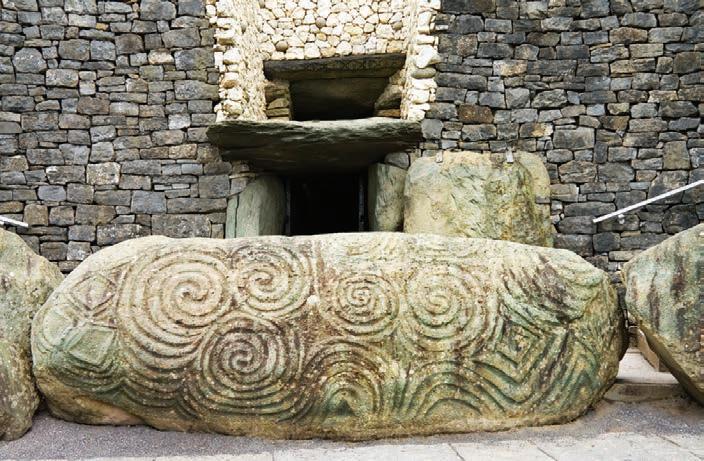
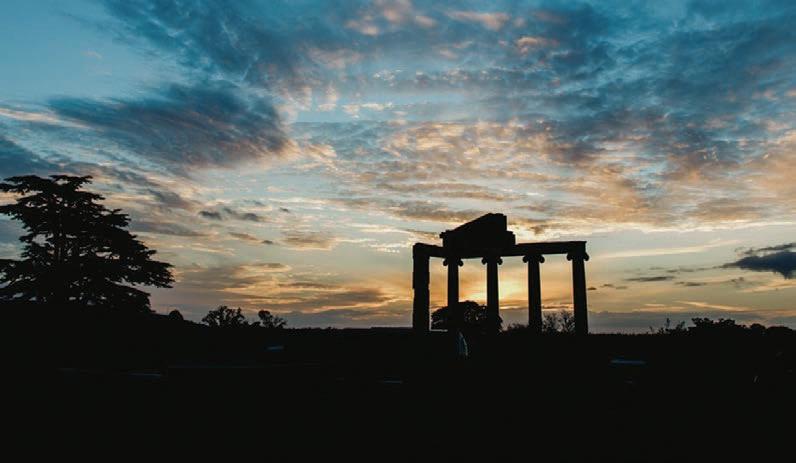
SET IN THE HEART OF COUNTY MEATH, LOUGHCREW ESTATE OFFERS A RETREAT SETTING STEEPED IN HISTORY AND SPIRITUAL ENERGY WHERE ANCIENT CAIRNS, TRANQUIL GARDENS, AND TIMELESS HOSPITALITY CREATE SPACE FOR RENEWAL AND CONNECTION.
The estate offers an extraordinary setting for retreats of every kind. Just an hour from Dublin Airport, it combines elegant accommodations, inspiring practice spaces, and a location steeped in history. Groups come to Loughcrew to slow down, reconnect, and rediscover balance. The estate provides a backdrop where guests can step away from everyday life, immerse themselves in nature, and return renewed. Yoga, meditation, mindfulness, spiritual, and wellness retreats all find a natural home here, with both indoor and outdoor spaces designed to inspire focus and creativity.
Accommodation is available in the main house, and courtyard apartments. Exclusive use of the house and surrounding buildings allows retreat leaders to shape the experience entirely to their needs. A fully equipped commercial kitchen and generous dining areas make it easy to
gather, while gardens, fire-lit courtyards, and expansive lawns provide space to connect or simply reflect in solitude.
Nearby, spiritually significant landmarks such as Fore Abbey, the Hill of Uisneach, and the Hill of Tara invite deeper exploration. Rising just behind the estate, the ancient Loughcrew Cairns infuse the landscape with a powerful energy, their passage tombs aligned with the rising and setting sun at solstices and equinoxes. To stand among them is to feel the presence of five millennia of ritual, a living reminder that this land has long been a place of connection between the earthly and the spiritual. Retreat guests often use Loughcrew as a central hub, enjoying daily practice and dining on the estate before venturing out to these historic sites. Additional activities, tours, and transport can be arranged, with Emily and her team on hand to help plan and support every
stay. Seasonal gatherings, guided walks, and equinox celebrations add to the rich calendar of experiences available.
Loughcrew Estate also plays host to internationally recognized teachers. Among them is Shiva Rea, the renowned yoga innovator and founder of Prana Vinyasa, who deepens her practice within Ireland’s mythological and spiritual landscape.
Every retreat at Loughcrew carries the unique imprint of the estate itself: sweeping views, golden sunsets, cozy firesides, fragrant gardens, and quiet corners perfect for reflection. Communal spaces invite friendship and connection, while the timeless character of the estate lends a sense of magic to every gathering. Guests leave not only refreshed but with memories and insights that last long after their retreat ends.
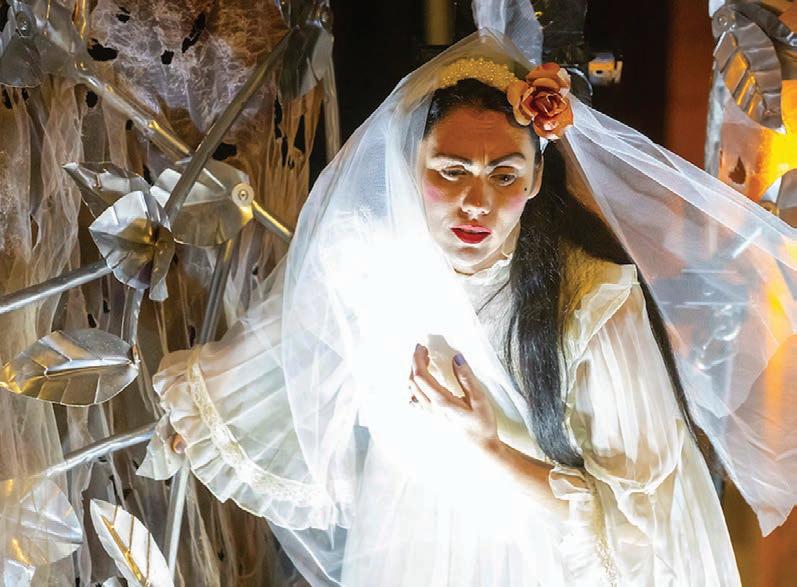
IRELAND DOESN’T JUST CELEBRATE HALLOWEEN; IT INVENTED IT. FROM ANCIENT SAMHAIN FIRE FESTIVALS TO TODAY’S PARADES AND STREET SPECTACLES, THIS IS THE BIRTHPLACE OF THE SEASON OF SPIRITS.
When October rolls around, few places in the world mark Halloween with as much authenticity and flair as Ireland. Long before jack-o’-lanterns lit up porches in the United States, the ancient Celtic festival of Samhain (pronounced “Sow-in”) marked the turning of the seasons. Celebrated on October 31, Samhain was one of the great Celtic fire festivals, a liminal time when spirits were believed to cross into the human world. Bonfires blazed, people wore disguises to confuse wandering souls, and tales of fairies, ghosts, and shapeshifters filled the night air.
Irish emigrants carried these traditions across the Atlantic, blending them with local customs. Over time, Samhain became Halloween, a name drawn from “All Hallows’ Eve,” the night before All Saints’ Day. In the United States it grew into the holiday we know today, but in Ireland the old customs never disappeared. They simply took on new life.
Today, the past lingers everywhere. Kilkenny’s medieval streets echo with tales of plague victims and ghostly monks. In the Boyne Valley, ancient mounds and passage tombs hint at stories of the
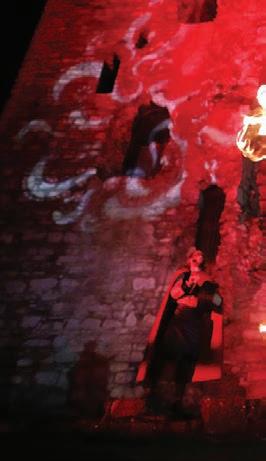
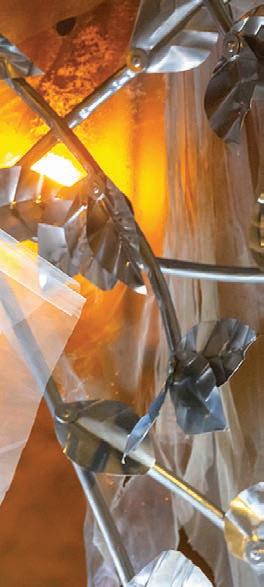

otherworld, while across the countryside, lone “fairy trees” often a solitary hawthorn, are still treated with reverence. Farmers will plough around them rather than cut them down for fear of bad luck if they disturb a place touched by the fairies. In County Clare, a motorway was even rerouted to avoid disturbing an ancient fort, a reminder of how myth and legend still hold sway.
Modern Ireland brings this heritage vividly to life with festivals that light up towns and cities:
• Derry~Londonderry hosts Europe’s largest Halloween carnival. The colorful parades and fireworks are matched by eerie walking tours along the city’s ancient walls, where centuries of siege, sorrow, and ghostly tales seep through the stone. Here, revelry and the supernatural walk hand in hand.
• Drogheda’s Lú Festival of Light transforms medieval streets into glowing stages for Ireland’s myths. Vast projections tell stories of warriors like Cú Chulainn, of Ferdia’s tragic battle,
and of the Morrígan, the goddess of fate and death. Against the backdrop of ancient gates and abbeys, the myths feel startlingly alive.
• The Púca Festival in County Meath is named for the mischievous shapeshifter of legend, a spirit said to roam fields at Samhain, sometimes blessing the harvest, sometimes causing havoc. With bonfires, music, and storytelling, the festival embraces this wild spirit in the very region where Samhain itself was born.
• The Spirits of Meath Festival runs throughout the Boyne Valley with haunted house tours, ghost hunts, and family events. This region, steeped in sacred sites and fairy lore, is the very cradle of Halloween tradition.
• The Samhain Food & Culture Festival recalls the ancient custom of feasting at the year’s end. Long ago, households would leave food at the doorstep for visiting spirits or set an extra place at the table for ancestors. Today, chefs reimagine these rituals in a celebration that blends food with folklore.
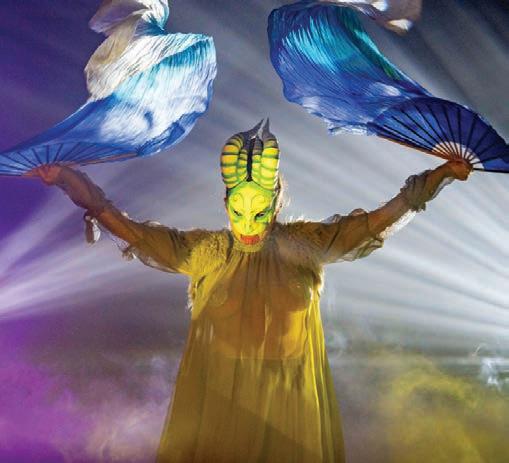
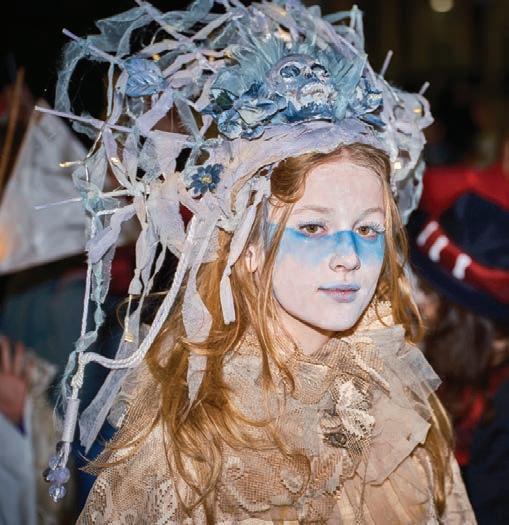
Beyond the festivals, Ireland’s supernatural traditions remain part of everyday life. Many castles claim resident spirits, but none more so than Leap Castle in County Offaly, often described as the most haunted castle in Ireland. With its bloody history, eerie tales of a spirit known as “the Elemental,” and countless ghostly sightings, it has even featured on American TV’s Ghost Hunters, drawing international attention to its dark reputation.
Elsewhere, Ballygally Castle in Antrim is said to be haunted by Lady Isobel Shaw, who fell to her death centuries ago and still knocks on doors. Loftus Hall in Wexford is another notorious site, where legend has it the Devil himself once appeared during a storm, leaving a permanent mark on the building. Charleville Castle in Offaly tells a gentler but equally haunting tale of a young girl named Harriet whose laughter is said
to echo through the halls. Malahide Castle near Dublin, with its mischievous court jester, and the gothic ruins of Duckett’s Grove in Carlow, said to be visited by a keening spirit, add to the long list of places where Ireland’s past lingers on in spectral form.
Then there is the banshee, Ireland’s most famous harbinger of the supernatural. More than just a ghost story, she embodies the island’s deep connection between myth, mortality, and memory. Her mournful cry, said to foretell a death in the family, has been passed down in whispered tales for generations, especially on dark autumn nights when the veil between worlds is at its thinnest.
For travelers, Halloween in Ireland is more than a festival, it is an invitation to step into a world where bonfires glow against autumn skies, castles whisper with ghost

stories, and the legends of Samhain live on in every flicker of candlelight. Here, the past and the present, the living and the otherworldly, mingle as naturally as they did thousands of years ago. Nowhere else does Halloween feel as authentic, as atmospheric, or as unforgettable.
Over time, Samhain became Halloween, a name drawn from “All Hallows’ Eve,” the night before All Saints’ Day.
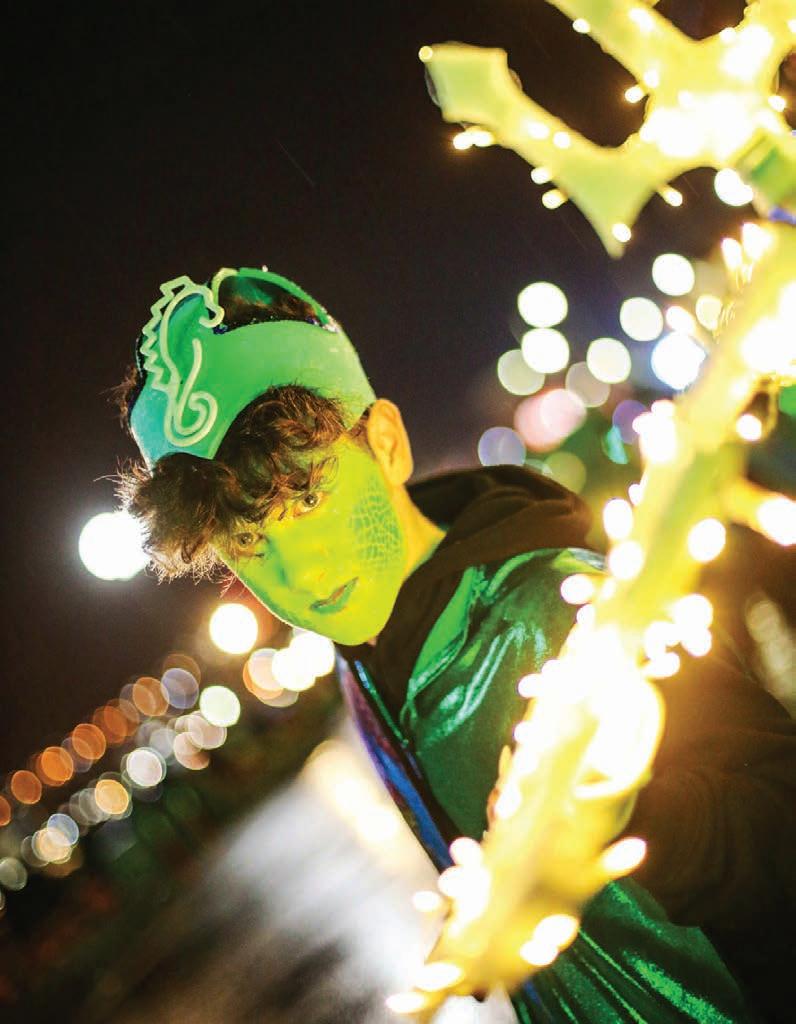
Modern Ireland brings this heritage vividly to life with festivals that light up towns and cities
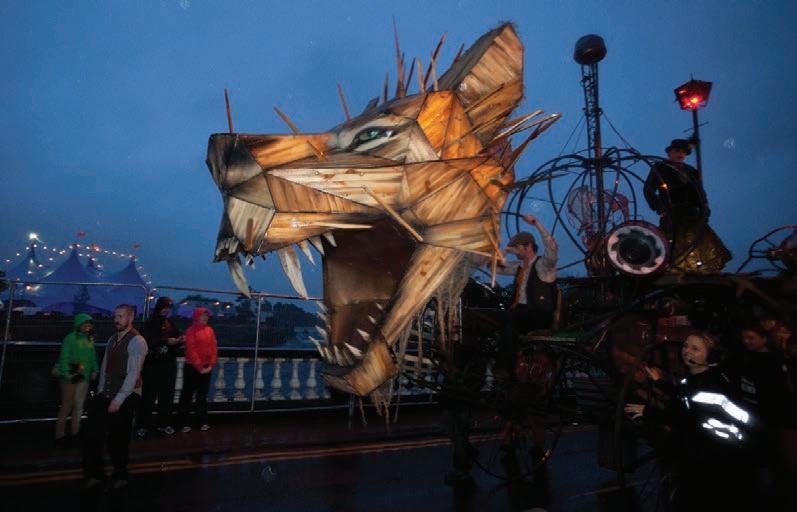
STEP INTO GALWAY ANY OCTOBER, AND YOU MIGHT SWEAR THE CITY HAS BEEN DIPPED IN MOONLIGHT, FOLKLORE, AND A BIT OF THEATRICAL MISCHIEF. THAT’S THE MAGIC OF GAILLIMH AHBOO!, THE ANNUAL HALLOWEEN FESTIVAL THAT TRANSFORMS STREETS, PLAZAS, AND BACK ALLEYS INTO STAGES OF MYTH, LIGHT, AND COMMUNITY CELEBRATION.
Running typically from early October into early November, Gaillimh Ah-Boo! brings together elements of art, folklore, food, theatre, and street spectacle in a way that feels fresh, immersive, and deeply local. In 2025, the festival spans October through November 5. What makes it stand out is this: it is unabashedly Galway’s take on Halloween, rooted in Celtic tradition, bolstered by modern creativity, and powered by community engagement.
A City Transformed By night, Galway becomes a living canvas. The internationally acclaimed Macnas Parade returns, lighting up dark streets with puppetry, movement, and spectacle that balance the eerie and the whimsical. Iconic landmarks like St
Nicholas’s Church, Spanish Arch and Salthill Promenade serve as projection surfaces and focal points for mythic scenes and legend-inspired installations.
During daylight hours, the city hosts a vibrant array of events: Light & Projection Installations, Dark History Tours that peer into Galway’s shadowed past, Samhain feasts and supper clubs in local restaurants, and themed workshops for families and artists alike. You’ll find bilingual storytime sessions, local artists collaborating on murals, and culinary events that draw on heritage and myth.
Galway’s identity as a pilot “Home of Halloween” festival city underscores the ambition behind Gaillimh Ah-Boo! In
2025, Galway was chosen as one of five pilot cities receiving funding to develop Halloween as a signature tourism base, with the festival central to that vision.
What sets Gaillimh Ah-Boo! apart is that it doesn’t just borrow Halloween tropes, it reclaims the Celtic festival of Samhain and reinvents it for a modern audience. It invites locals and visitors to re-engage with the land, the legends, and the transitional time between harvest and winter, between light and dark.
For U.S. visitors, Gaillimh Ah-Boo! offers more than spectacle. It’s a chance to experience Ireland in its seasonal rhythm, when cities slow down, fire and folklore return, and tradition is not static but alive
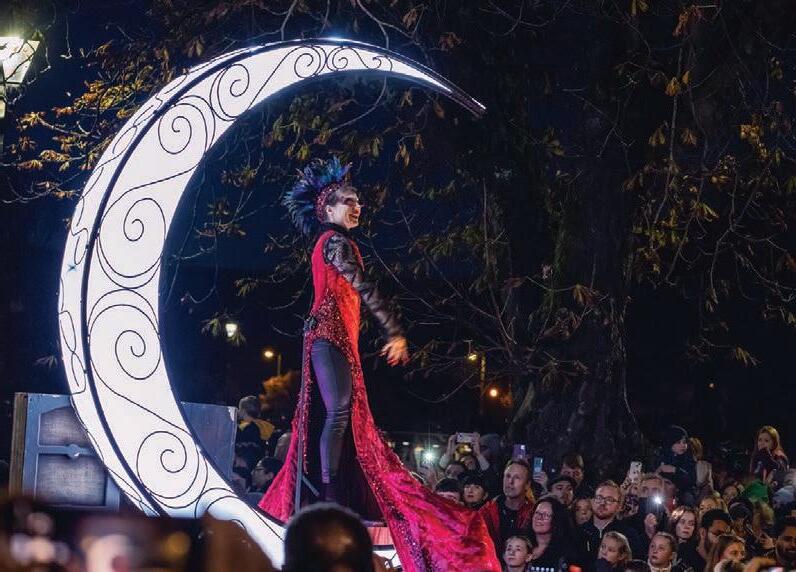

and evolving. It’s part festival, part cultural reclamation, part artistic playground.
Arrive a few days early or stay on afterward to soak up the joys of Galway City. With more than 130 festivals each year, this is a city that never stops celebrating. From world-class arts and music to food, film, and sport, the calendar is bursting with color and creativity, and that energy spills into every corner of daily life.
Galway’s reputation as a festival city rests on some big names. The Galway International Arts Festival draws audiences from around the world with theater, music, and visual art on a grand scale. The Galway Races bring the thrill of the track to summer, while the Christmas Markets turn Eyre Square into a wonderland of lights and festive cheer.
But the city offers more than just events. Set along the Wild Atlantic Way, Galway
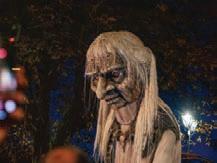
• Evening parades & theatrical processions
• Projection mapping & installations
• Dark History Tours
• Samhain Supper Clubs & pop-ups
• Workshops & family events:
• Music, performance, and latenight events
Gaillimh Ah-Boo! is not just a festival to see; it’s one to feel. It marries the theatricality of performance with the quiet strength of heritage inviting visitors not just to spectate, but to participate. Gaillimh Ah-Boo! offers a rare blend: a festival with heart and creativity, a city in transformation, and an invitation to celebrate the roots of Halloween in a place that shapes the story from the inside out.
blends maritime heritage with a vibrant cultural soul. Known as the “City of the Tribes,” its cobbled streets brim with independent shops, lively pubs, and award-winning restaurants. Street performers add a spark of spontaneity, while theaters like the Druid and Town Hall keep Galway’s creative spirit thriving. Food lovers will find plenty to savor. Named the world’s number one foodie destination by BBC Good Food Magazine in 2020, Galway continues to impress with local produce, innovative chefs, and unforgettable dining experiences.
Whether visiting for a weekend or a week, Galway makes every stay feel like a celebration. It’s a city with a festival for every passion and a welcome for every visitor.


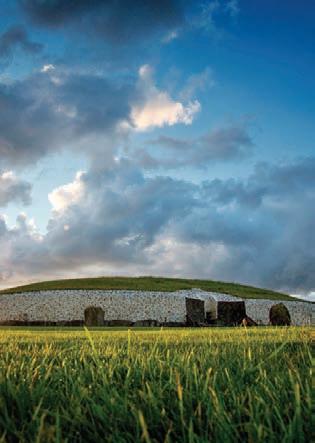


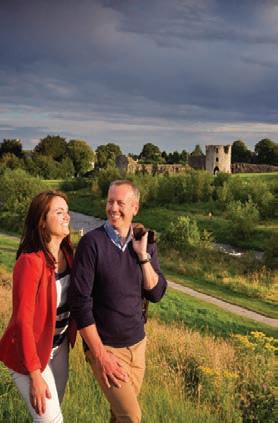



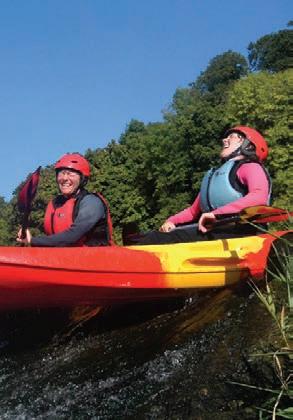








FROM ANCIENT FIRE FESTIVALS TO MODERN CELEBRATIONS OF LIGHT, BOYNE VALLEY OFFERS TRAVELERS A MAGICAL SEASON WHERE HISTORY, MYTH, AND REVELRY MEET.
The Boyne Valley, encompassing County Meath and South County Louth, is a landscape that seems to breathe with history. Rolling green fields, winding rivers, and ancient monuments scatter its hillsides, each one whispering stories of kings, warriors, saints, and poets. For travelers, it offers everything one might dream of in Ireland: passage tombs older than the pyramids, castles with centuries of intrigue, winding waterways perfect for cycling, and cozy villages serving farm-fresh food and drink. But for those who seek the heart of Ireland’s mysteries, there is one season when the Boyne Valley truly comes alive: Halloween.
Meath was the birthplace of Samhain, the ancient Celtic festival that marked the end
of harvest and the beginning of winter.
More than 2,000 years ago, a great bonfire blazed on the Hill of Tlachtga in Athboy each October 31st, lighting the sky and guiding spirits between worlds, where the veil between the living and the dead was thought to thin and otherworldly forces to flow freely. Today, that ancient spirit has not faded. Instead, it has blossomed into a five-week celebration of light, folklore, food, and fright: the Spirits of Meath Festival.
From October through early November, more than 100 events unfold across the Boyne Valley under the banner of Spirits of Meath. The festival brings Samhain’s legacy into the modern age with a mixture of “fun
by day” and “fright by night.” For families, there are pumpkin patches, treasure hunts, and trick-or-treat trails. One of the most popular is the Tricky Trail at Emerald Park, where children are given maps to follow through a treasure hunt filled with magical surprises, ending with treats and laughter. Historic estates open their grounds for family-friendly activities, adventure centers put on Halloween discos, and the region buzzes with excitement for little ghouls and goblins.
When the sun sets, the mood shifts. The Boyne Valley becomes darker, more mysterious, and charged with the thrill of Halloween. Haunted mansions creak with restless spirits, folklore tours lead travelers down shadowy lanes, and Ireland’s

largest scare attraction takes center stage. Farmaphobia at Causey Farm sprawls across 100 acres, offering six terrifying haunts designed to test even the bravest souls. Each corner hides something unexpected: roaming ghouls, live performers, eerie music, and the pulsing energy of DJ Spooks, who keeps the adrenaline high late into the night. For teens and adults, Farmaphobia has become the ultimate Halloween pilgrimage, blending artistry and fear in unforgettable fashion. These events help make the Spirits of Meath Festival the beating heart of Halloween, rooted in ancient tradition yet alive with modern creativity.

Still, the Boyne Valley’s Halloween magic doesn’t stop there. In the riverside town of Drogheda, a different kind of enchantment unfolds with the Lú Festival of Light, held the weekend before Halloween. Over four nights, Drogheda is transformed into an open-air gallery, where myths, legends, and history are projected onto the town’s landmark buildings. Massive animations illuminate facades, telling stories of Cú Chulainn, Ferdia, Queen Meábh, and the Morrigan. Visitors stroll freely through the streets, watching the town glow and pulse with vibrant colors and swirling images. The experience is mesmerizing, ancient myth reborn in light and celebrated with a creative energy that connects Drogheda to the world. For travelers, it is as if the town itself has become a canvas, its walls alive with the stories of Ireland’s heroic past.
The following weekend, during Halloween itself, the Púca Festival casts its spell on the towns of Trim and Athboy. The Púca, a mischievous spirit from Irish folklore, was said to appear at Samhain, sometimes bringing good fortune and at other times wreaking havoc. This festival embraces that playful, magical energy. It is an immersive journey where costumed creatures dance through the streets, traditional ceremonies recall ancient rituals, and stages fill with comedy, storytelling, and music. The atmosphere is both haunting and joyous, with visitors sipping local brews, laughing at comedy sets, and swaying to electrifying performances by well-known Irish acts. Trim’s medieval castle and Athboy’s ancient sites provide the perfect backdrop, grounding the revelry in a sense of timelessness. For Americans who love festivals like Mardi Gras but crave something older and more mysterious, the Púca Festival is an unmissable adventure.
And then, just as the veil of Samhain begins to close, the Samhain Festival of Food & Culture takes place in Kells the weekend after Halloween. While Samhain was always a time of feasting, this modern festival transforms that ancient tradition into a celebration of Irish culinary excellence. Here, Ireland’s top chefs and food producers gather to showcase the country’s food culture and creativity. Visitors can sample artisan produce, craft drinks, and seasonal dishes from across the island, join immersive tasting events,
or take part in workshops that highlight the skills behind Ireland’s food culture. Families are welcomed with kids’ activities and hands-on fun, while the highlight for many is the Samhain Long Table Supper. This spectacular dining event brings guests together to enjoy a communal feast featuring the best of local produce, echoing the gatherings that have taken place at Samhain since time immemorial.
Together, these four festivals - Spirits of Meath, Lú, Púca, and the Samhain Festival of Food & Culture - form a tapestry of celebration unlike anywhere else in the world. They capture the essence of Halloween as both ancient and modern, fun and frightening, communal and otherworldly. In the Boyne Valley, Halloween is not a single night of costumes and candy. It is a season of storytelling, ritual, and wonder, layered over a landscape that has been sacred for millennia.
Of course, beyond the Halloween season, the Boyne Valley offers countless reasons to visit. Just thirty minutes from Dublin airport, travelers can explore the UNESCO World Heritage site of Brú na Bóinne, home to Newgrange, Knowth, and Dowth, passage tombs that predate Stonehenge and the Egyptian pyramids. They can stand on the Hill of Tara, once the seat of Ireland’s High Kings, or stroll through medieval Trim with its looming Norman castle. Adventure seekers can kayak on the River Boyne, cycle along the Royal Canal Greenway, or take to the skies in a hot air balloon drifting over patchwork fields. And for those who crave coastal air, Bettystown and Clogherhead offer sandy beaches just a short drive away. Add in local pubs, artisan food producers, and a thriving cultural scene, and the Boyne Valley becomes not just a destination but an immersion into Ireland’s way of life.
For American visitors, the Boyne Valley offers something truly rare: the chance to experience Ireland at its most authentic, where history is not locked in museums but alive in the landscape and the people. In the fall, that authenticity shines brightest. Halloween began here, and here it is still celebrated in ways that honor its roots while welcoming the world to join in. Whether carving pumpkins with children at Funtasia
Theme Park, gasping at the lights of Drogheda the weekend before Halloween, laughing under the mischievous spell of the Púca on Halloween weekend, or savoring a feast in Kells the weekend after, you become part of a story that began thousands of years ago and still shapes how the world celebrates today. Come for the history, stay for the food, and lose yourself in the magic of Halloween’s true home. For more information visit boynevalley.com and spiritsofmeath.ie
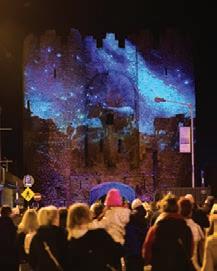


Louth is a place where the air is crisp, the landscapes are breathtaking, and every corner has a story waiting to be uncovered. Whether visitors long for thrilling adventures along stunning coastlines, the warm charm of medieval villages, or simply the delight of enjoying the freshest seafood by the sea, Louth offers it all with open arms.
Just an hour’s drive from both Dublin and Belfast, this small county is packed with unforgettable experiences. Visitors can gaze in awe at the majestic Cooley Mountains, feel the golden sands of Blue Flag beaches between their toes, and lose themselves in vibrant cultural spots or tranquil hidden trails. It is a place where history meets nature and memorable
moments are always close at hand. Out here, it is truly legendary.
Louth’s connection to the sea runs deep. The Sea Louth trail stretches over 70 kilometers of stunning coastline, linking charming villages with marvelous views and some of the best local seafood in Ireland. This is a culinary journey where fishing traditions meet mouthwatering flavors.
The adventure begins with a Sea Louth passport, available at tourist offices in Carlingford (main image), Dundalk, or Drogheda. The trail features 14 beautiful spots that showcase the county’s coastal treasures. Visitors can stroll along the
peaceful shores of Annagassan, enjoy the lively atmosphere of Blackrock’s promenade, or relax on the sandy stretch of Clogherhead’s Blue Flag beach. Along the way, local fishermen share the bounty of the ocean, offering the chance to savor seafood at its freshest.
Drogheda brings history vividly to life. This vibrant town combines medieval charm with modern energy. At the Tourist Office in The Tholsel, visitors can pick up maps and guides before exploring the DRAWDA Urban Art Trail, where colorful murals reimagine the town’s past.
Highlights include Laurence’s Gate, one of the most beautiful surviving medieval
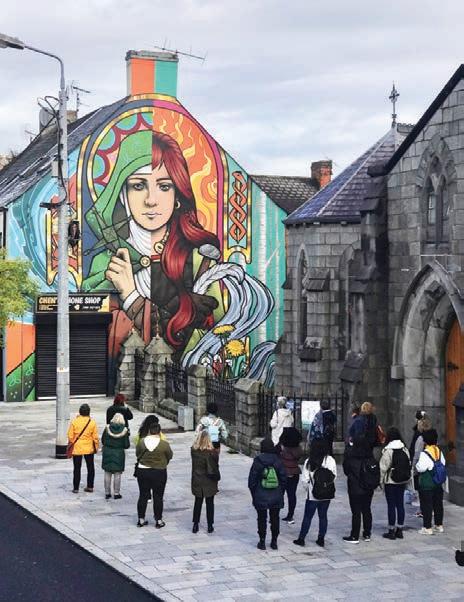
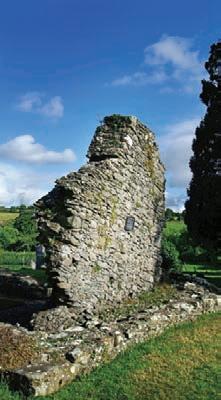
town gates in Ireland, and the Highlanes Gallery, set in a former Franciscan church. The ceremonial sword and mace gifted to Drogheda by King William III after the Battle of the Boyne are also on display.
For sweeping views, Millmount Martello Tower - affectionately called the Cup and Saucer - offers a commanding perspective over the town. Next door, the Millmount Museum tells stories of local life through fascinating exhibits. Beyond the town, the Boyne Valley Camino, a 25-kilometer looped trail, follows the Boyne River past peaceful woodlands and the ancient ruins of Mellifont Abbey. Drogheda is more than a stop on a journey; it is an experience rich with history and culture.
Dundalk – A Cultural Hub
Dundalk sits between Dublin and Belfast and hums with life where history and creativity converge. At the Tourist Office,
visitors can pick up a map of the eyecatching SEEK mural trail before exploring the town’s artistic spirit.
The An Táin Arts Centre showcases performances and exhibitions by local talent, while the Oriel Centre at Dundalk Gaol is a must-visit for fans of traditional Irish music. Architecture lovers can admire St. Patrick’s Pro-Cathedral, modeled on the grandeur of King’s College Chapel in Cambridge. The County Museum Dundalk adds further depth with artefacts ranging from Viking treasures to a bright red Heinkel motorcar.
On the town’s edge, Cúchulainn’s Castle, also known as Castletown Motte, is said to be the birthplace of Ireland’s legendary warrior hero. Dundalk blends past and present seamlessly, offering art, history, and music in abundance.
Ardee brims with legend and charm. The town commemorates the epic battle between Cúchulainn and Ferdia with a bronze sculpture marking the site of their famous duel. Visitors can explore Ardee Castle, Hatch’s Castle, and the quirky Jumping Church, each with stories to spark curiosity.
Nearby, the shrine of St. Brigid in Faughart offers a peaceful retreat with its holy well and medieval church ruins. The site is especially meaningful on St. Brigid’s Day, February 1st. A short distance away, the remarkable Proleek Dolmen stands as a proud symbol of Ireland’s prehistoric past. Tradition holds that tossing a pebble onto its capstone may grant a wish.
Carlingford & The Cooley Peninsula
Carlingford combines medieval charm with outdoor adventure. Set between Slieve Foye, Carlingford Lough, and the Mourne Mountains, it is one of Ireland’s most picturesque villages. Visitors can wander narrow streets lined with castle ruins and ancient walls, or venture into the outdoors along the Carlingford Lough Greenway, up the slopes of Slieve Foye, or out on the water for sailing, windsurfing, or canoeing.
Evenings in Carlingford are equally memorable, with local restaurants serving
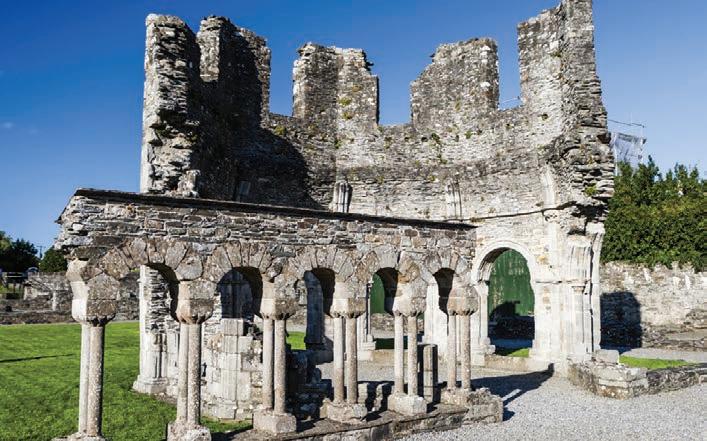
delicious meals in warm, welcoming settings. Carlingford is both an invitation to adventure and a celebration of Ireland’s rich heritage.
In the fall Drogheda hosts the Lú Festival of Light from 24 to 27 October 2025. As part of Ireland’s Home of Halloween, the festival transforms the town into a glowing stage for myth and legend. Projection installations at St. Peter’s Church, The Old Abbey, and St. Laurence’s Gate bring stories of Cú Chulainn, Ferdia, and The Morrigan to life through light and sound.
The Boyne Valley adds further magic with a trio of partner festivals: the Spirits of Meath Festival (3 October–9 November), the Púca Festival (30 October–2 November), and the Samhain Festival of Food & Culture (6–9 November). Together, these events celebrate Ireland’s role as the birthplace of Halloween with unforgettable experiences for every age.
In County Louth, every road leads to something extraordinary. More information is available by visiting: www.visitlouth.ie, www.sealouth.ie, and www.irelandsancienteast.com


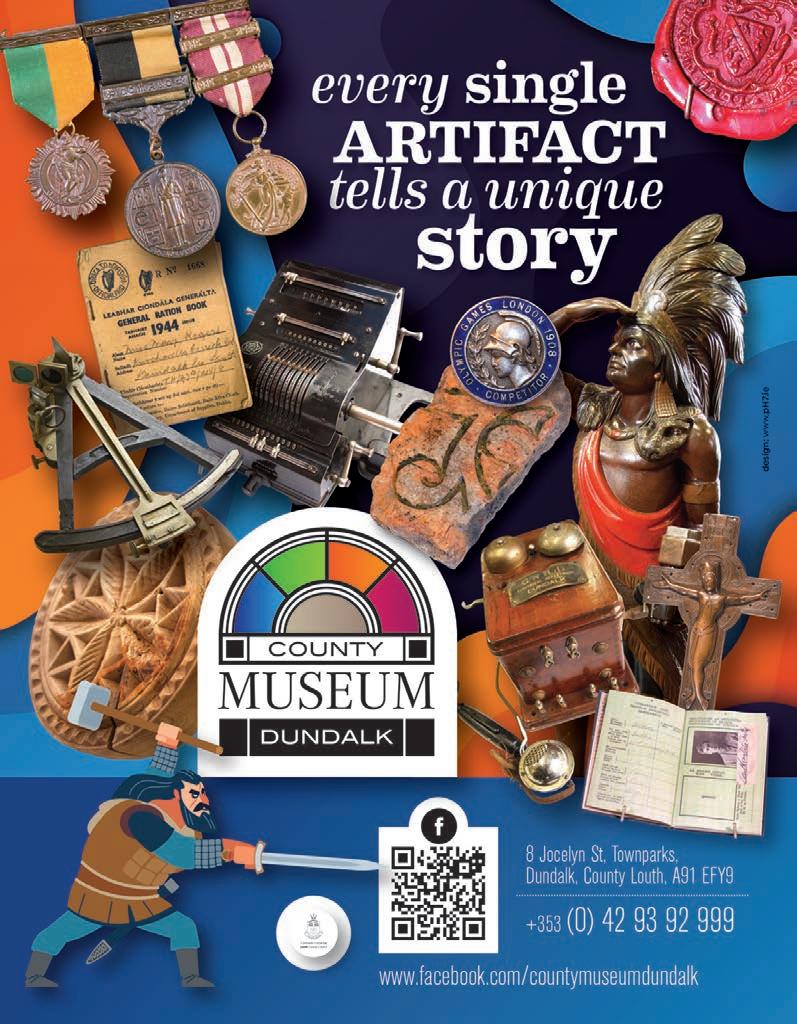
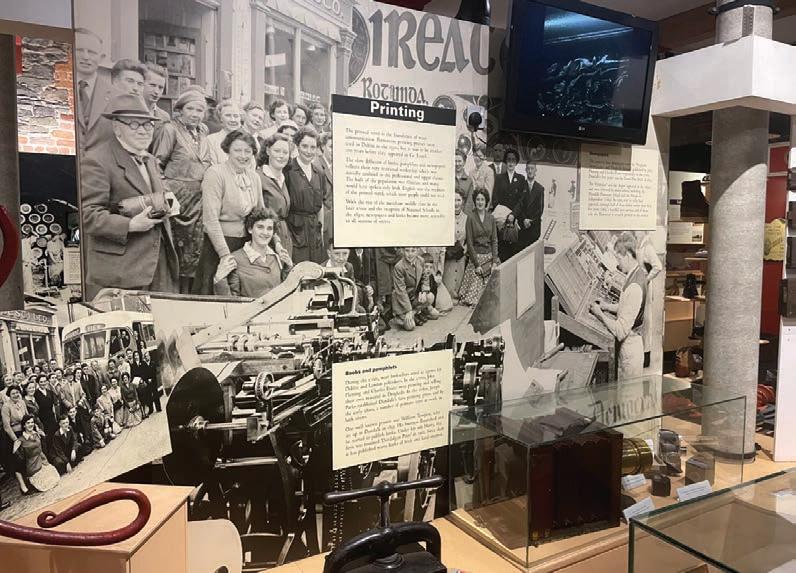
AT ITS HEART, THE KEY IDEA BEHIND THE COUNTY MUSEUM, DUNDALK IS CURIOSITY. ACROSS THREE GALLERIES OF PERMANENT EXHIBITIONS AND DISPLAYS, VISITORS ARE GUIDED THROUGH AN UNFOLDING STORY THAT SPARKS CURIOSITY ABOUT THE PAST AND FUELS THE IMAGINATION.
This is a museum that makes history accessible, highlighting Louth’s rich industrial heritage, a story unique in Ireland. The county’s history is one of achievement, rooted in engineering excellence and industrial innovation. It is the county of the three-wheeled Heinkel motorcar, the home of engineers James Barton and Peter Rice, and the birthplace of pioneers such as Arctic explorer Sir Francis Leopold McClintock and boxer Deirdre Gogarty.
Equally important is the recognition of everyday life as experienced by the general public. In an industrial community, the
story is as much about the worker as it is the entrepreneur. There is a well-known American saying that “if you want to understand someone, walk a mile in their shoes.” This idea is revisited throughout the museum, most notably in its display of shoes. Dundalk was once the shoe capital of Ireland, home to companies such as Clark’s, Halliday’s, and Blackthorn. Their contribution is celebrated not only through a collection of beautifully made shoes but also by inviting visitors to handle and examine them. Through this multi-sensory approach, visitors literally sample the fashion and craftsmanship of a unique artifact.
This hands-on experience continues in the industrial gallery, where visitors gain insight into what life was once like in the region. It is an approach that engages both mind and heart, encouraging a deeper appreciation of the past at an emotional level. Families often find themselves sharing these moments, whether older generations recalling what life was like, or younger visitors discovering it for the first time. What emerges is a connection to history that is as rewarding as it is memorable.
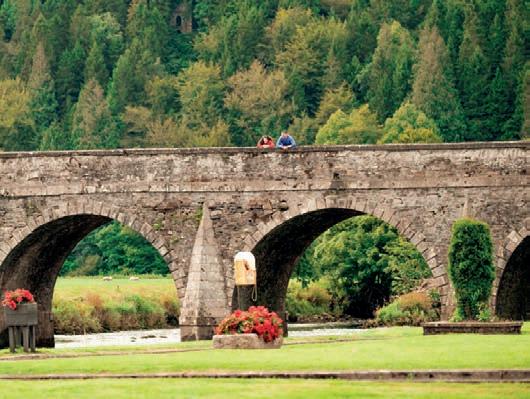

Discover rich flavours, authentic craft and unhurried days in Kilkenny this autumn
Plan your slow escape at VisitKilkenny.ie

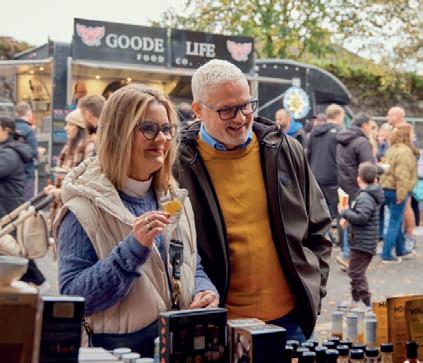





KNOWN AS THE MARBLE COUNTY FOR ITS LOCALLY QUARRIED LIMESTONE, KILKENNY IS A DESTINATION RICH IN HISTORY, STUNNING LANDSCAPES, AND WARM HOSPITALITY THAT MAKES EVERY VISIT UNFORGETTABLE.
County Kilkenny is where medieval heritage meets modern vibrancy, where cobblestone streets hum with creativity, and where every turn reveals something new to explore. Whether you are drawn by its majestic castles, world-class arts scene, buzzing festivals, or incredible food, this is a place that captures the heart of every visitor.
In the heart of Ireland’s picturesque Southeast, Kilkenny is incredibly easy to reach. Just 90 minutes from Dublin Airport and Rosslare Europort, the county is well connected by motorways, bus routes, and train services. Once you arrive, you will find Kilkenny a joy to explore, with walkable medieval streets, scenic country roads, and a charming mix of old-world architecture and contemporary energy.
A Walk Through the Ages
Kilkenny is a living, breathing storybook, where tales of knights, monks, witches,
and medieval dynasties unfold with every step. The county’s history is best experienced along Ireland’s Medieval Mile, a fascinating stretch through the heart of Kilkenny City that links some of Ireland’s most spectacular medieval landmarks.
Kilkenny Castle, standing proudly over the River Nore since 1195, is the crown jewel of the city’s medieval past. Once the stronghold of the powerful Butler family, this magnificent fortress has evolved into one of Ireland’s most treasured heritage sites. Visitors can explore its grand halls, admire an impressive art collection, and stroll through beautifully manicured gardens while soaking in the echoes of centuries past.
Just a short walk away, St. Canice’s Cathedral rises above the cityscape, a testament to nearly 900 years of history. This stunning medieval cathedral is a place of quiet grandeur, where intricate
stonework and stained-glass windows tell their own stories. For those seeking a bird’s-eye view of Kilkenny, climbing its perfectly preserved round tower, a rare gem among Ireland’s medieval structures, offers a panoramic vista of the city and beyond.
Continuing the journey through Kilkenny’s past, Rothe House and Garden offers a glimpse into the life of a wealthy merchant during the Renaissance era. This beautifully preserved 17th-century townhouse invites visitors to wander through its carefully restored rooms, explore an enchanting walled garden, and step back in time to an age of trade, craftsmanship, and flourishing prosperity.
For those fascinated by folklore, Kyteler’s Inn is a must-visit. One of Ireland’s oldest pubs, it carries a history as intriguing as the city itself. Established in 1324, it was once owned by the notorious Alice Kyteler,
a wealthy businesswoman who became Ireland’s most infamous accused witch. After multiple marriages, each ending with mysteriously deceased husbands, Alice was charged with heresy, witchcraft, and poisoning. She managed to escape to Europe, leaving behind a legacy that still lingers in Kilkenny’s folklore.
Today, the inn embraces its eerie past, offering visitors the chance to enjoy a pint in a setting steeped in medieval charm, with stone walls, candlelit corners, and an atmosphere that feels like stepping back in time. Many claim the pub is haunted, with ghostly whispers and unexplained happenings adding to its mystique. Whether you are drawn by the supernatural or simply in search of a lively pub with great food, traditional music, and a rich history, Kyteler’s Inn offers an experience like no other.
Kilkenny is alive with festivals, ensuring there is always something happening, whether you love music, arts, comedy, or food.
The Kilkenny Cat Laughs Comedy Festival sets the stage for a weekend of sidesplitting humor, drawing world-class comedians and comedy lovers alike. For those seeking a more immersive cultural experience, the Kilkenny Arts Festival transforms the city into a creative wonderland, with live performances, open-air concerts, and striking visual art exhibitions. Adding a touch of cinematic magic, Kilkenny Animated brings Ireland’s rich storytelling and animation heritage to life, making it a must-visit for film buffs and creatives.
Live music is woven into the fabric of Kilkenny’s culture, making every festival an experience to remember. The Kilkenny Roots Festival fills the city with the sounds of Americana, folk, and roots music, attracting performers from Ireland and beyond. Traditional Irish music spills out of cozy pubs, while rock, jazz, and contemporary acts take to venues across the county, ensuring there is a rhythm for every visitor to enjoy. Whether it is a lively pub session or a world-class festival performance, Kilkenny’s music scene keeps the city’s energy alive year-round.

For food lovers, Savour Kilkenny is a gastronomic paradise, showcasing Ireland’s best chefs, food producers, and culinary delights. Kilkenny has firmly established itself as one of Ireland’s top food destinations, offering everything from Michelin-starred fine dining to traditional Irish comfort food. The county’s abundance of local producers, organic farms, and passionate chefs ensures that every meal is fresh, local, and bursting with flavor.
Running in late October, Savour Kilkenny dovetails with one of Kilkenny’s newest festivals, Toil and Trouble. This Halloween celebration builds on the 2024 commemoration of Petronella’s burning and immerses visitors in authentic Samhain traditions and tales of medieval witch trials. Running from October 17 to November 8, it transforms Kilkenny into a Halloween capital with storytelling, street
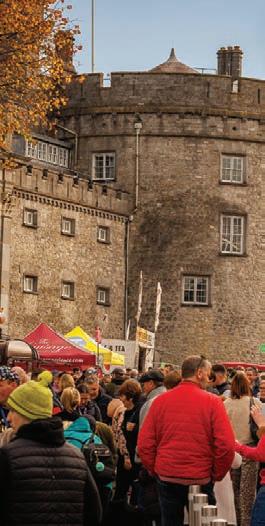
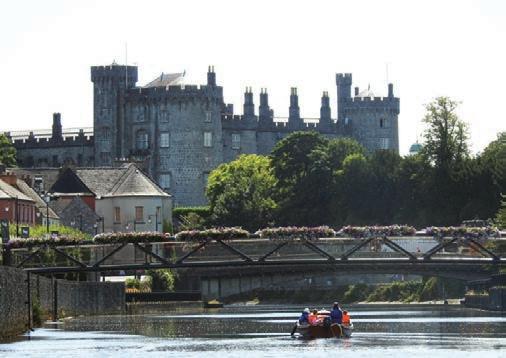

spectacles, and folklore-inspired events. Together with Savour Kilkenny, the Witches and Wizards program, and the quirky Kilkenomics Festival, the city buzzes with energy and creativity well into the autumn season. Streets and venues are dressed for the occasion, adding a festive edge that makes Kilkenny one of Ireland’s most exciting places to celebrate Halloween.
Beyond its medieval streets, Kilkenny’s landscape is an outdoor playground, offering everything from peaceful riverside retreats to high-energy adventures. The River Nore and River Barrow weave through the county, creating the perfect setting for kayaking, fishing, or leisurely walks along their scenic banks, where lush greenery and charming villages line the way.
The county is also home to some of Ireland’s most picturesque towns and villages, each bursting with character. Thomastown, Inistioge, Windgap, Graiguenamanagh, Bennettsbridge and Kells are inviting gems where visitors can wander quiet streets, visit local markets, and soak up the relaxed countryside atmosphere. The vast open spaces are ideal for golfers, with greens that blend seamlessly into the natural landscape. For those seeking a thrill, Castlecomer Discovery Park delivers
Whether you're drawn by its majestic castles, world-class arts scene, buzzing festivals, or incredible food, this is a place that captures the heart of every visitor.
with ziplining, treetop adventures, and forest trails that wind through stunning woodlands.
Kilkenny is a powerhouse of creativity, with a thriving arts and craft scene among the best in Europe, earning it a prestigious World Crafts Council Craft City and Region designation. The county is home to talented artisans producing handcrafted woolen textiles, delicate ceramics, intricate glasswork, and stunning jewelry.
At the Kilkenny Design Centre, visitors can watch crafters at work, meet the artisans behind Ireland’s finest handmade goods, and even try their hand at crafting. Jerpoint Glass Studio, famous for its exquisite handblown glass, offers demonstrations where visitors can see fiery molten glass transformed into beautiful works of art. For anyone looking to bring home a unique piece of Ireland, Kilkenny’s craft shops and studios are filled with one-of-a-kind treasures.
Butler Gallery, housed in a beautifully restored historic building, showcases contemporary and modern art exhibitions, while Watergate Theatre brings drama, music, and dance to life on its stage. The county was named Global Cultural Destination 2024 at the World Luxury Travel Awards, proving that Kilkenny’s arts scene is truly world-class.
With history, culture, adventure, and incredible food, Kilkenny has something for everyone. See more at VisitKilkenny. ie and discover why Kilkenny is one of Ireland’s most magical destinations.
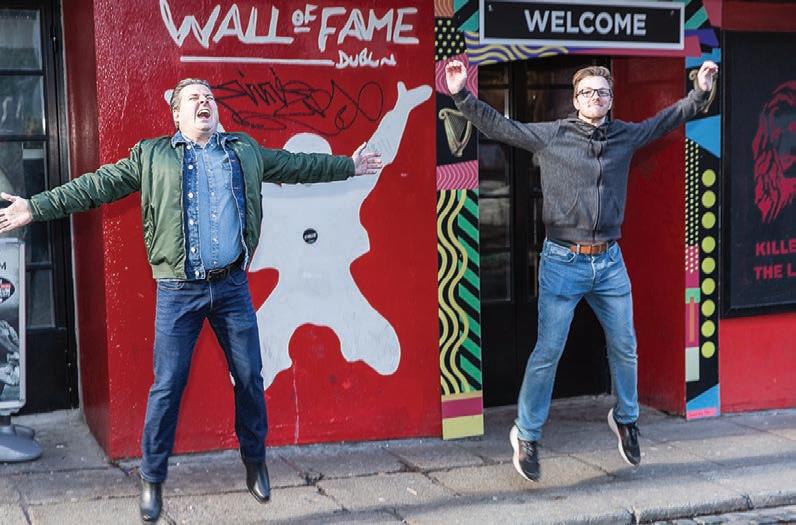
FEW CITIES BALANCE PAST AND PRESENT QUITE LIKE DUBLIN. LAYERED, CREATIVE, AND FULL OF LIFE, THE CITY IS A PLACE WHERE CENTURIES OF HISTORY MEET A VIBRANT MODERN PULSE.
Dublin wears its history well. From Dublin Castle, standing for more than 800 years, to lively galleries and libraries, this is a capital where every corner invites exploration.
Forget any notion of dusty display cases. Dublin’s museums are vibrant places where the city’s journey is told in fascinating detail. At the Hugh Lane Gallery, once one of Dublin’s finest Georgian townhouses, the interiors are as impressive as the art. Step through the blue doors on Parnell Square and you will find works by Monet, Degas, and Harry Clarke, alongside Francis Bacon’s studio, preserved exactly as he left it.
Nearby, Marsh’s Library feels like stepping back to 1707. The oak bookcases are filled with priceless volumes, and you can
still see the 18th-century cages once used to stop eager readers from stealing the rarest books! Bullet holes from the 1916 Rising scar the walls, a reminder that history here is written into the very fabric of the city.
The National Museum of Ireland anchors the capital’s cultural landscape. With four branches across the city, it spans archaeology, decorative arts, natural history, and the story of Ireland’s road to independence. From Celtic gold and haunting bog bodies to political artifacts that shaped the modern state, each collection adds a new layer to Ireland’s identity.
Dublin’s museums don’t just preserve the past - they bring it to life. Explore your Irish roots at EPIC, the Irish Emigration Museum,
named by Lonely Planet as Europe’s Leading Tourist Attraction. Using cuttingedge interactive technology, it reveals the journeys of those who left Ireland and shaped the world. Relive the Easter Rising at the GPO Museum on O’Connell Street, uncover the art of printing at the National Print Museum, or revel in literary brilliance at MoLI, Museum of Literature Ireland. For something playful, step into the Irish Rock ’n’ Roll Museum, where U2, Thin Lizzy, and The Cranberries remind visitors that music is one of Ireland’s greatest exports. The Little Museum of Dublin tells the city’s modern story through quirky donated objects, while the National Leprechaun Museum dives into Ireland’s folklore with immersive, larger-than-life storytelling. Together, these living experiences prove that Dublin’s museums are anything but ordinary.
The story of Dublin isn’t only told in its museums; it’s written into the very stones of the city. Long before galleries and libraries lined its streets, Dublin took shape as a Viking stronghold on the banks of the Liffey. Out of that early settlement grew Dublin Castle, which later became the seat of British rule and has stood at the city’s heart for more than 800 years. Within its grounds lies the Chester Beatty Library, hailed by Lonely Planet as not just Dublin’s best museum but one of the best in Europe. Its extraordinary collection spans Asia, the Middle East, North Africa, and Europe, offering a global perspective in the heart of Ireland’s capital.
Faith and power have long stood side by side in Dublin, and nowhere is that more evident than in its two great cathedrals.
Christ Church Cathedral, founded in 1038 by the Viking king Sitric, is Dublin’s oldest building still in use. What began as a modest wooden church grew into a magnificent medieval cathedral. Its interior dazzles with intricate floor tiles and vaulted stonework, while beneath it lies a vast 12th-century crypt - the oldest surviving structure in Dublin.
Nearby stands St. Patrick’s Cathedral, founded in the 12th century to honor Ireland’s patron saint. With its soaring nave, ancient choir dating to 1432, and long association with Jonathan Swift, author of Gulliver’s Travels, the cathedral is both a place of worship and a living repository of Irish culture. To this day, it hosts regular services and world-class choral performances. Together, Christ Church and St. Patrick’s embody the


St. Patrick’s Cathedral, founded in the 12th century to honor Ireland’s patron saint.


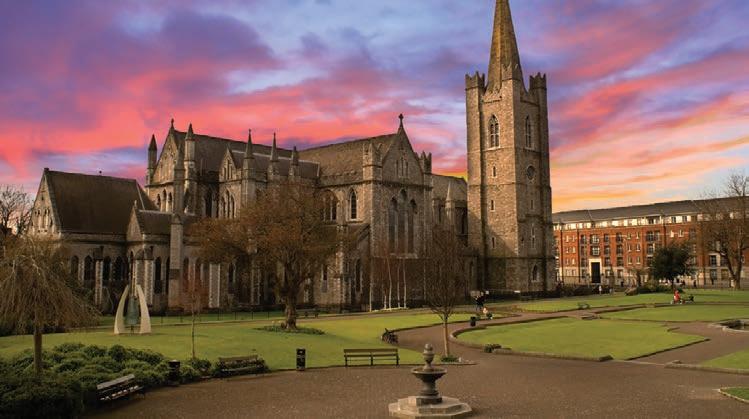
layers of Dublin’s past - Norse, medieval, literary, and spiritual, capturing how faith, power, and creativity have shaped the city.
Next door to Christ Church, Dublinia brings the Viking and medieval city to life with interactive exhibits that explore old streets, ships, and daily life. All three buildings stand in The Liberties, one of Dublin’s oldest quarters, where heritage and living traditions mingle. Today, this same neighborhood is also home to the Liberties Distilleries Trail, part of Dublin’s “Golden Triangle” of whiskey - a pilgrimage of a different kind!
The Liberties is one of Dublin’s most characterful quarters. In medieval times, you either lived inside the city walls or outside them, and those beyond were said to be “at liberty,” free from city taxes and rules. The name stuck, and so did the independent spirit. Once home to weavers, tanners, and traders, The Liberties was the industrious heart of old Dublin.
Lined with distilleries and breweries, The Liberties was at the center of Dublin’s golden age of whiskey until the early

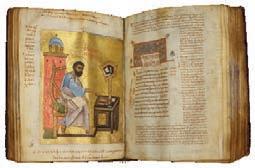

twentieth century, when Ireland’s whiskey industry collapsed under the weight of war, trade barriers, and Prohibition in the United States. In recent years, however, a new generation has revived that proud tradition. The Dublin Liberties Distillery, Teeling, and Roe & Co. have restored the art of whiskey-making to the neighborhood, transforming historic buildings into vibrant visitor experiences that attract enthusiasts from around the world. Just beyond The Liberties in Smithfield, one name continues to define Dublin’s whiskey legacy: Jameson - or “Jemmy,” as it’s fondly known.
Founded in 1780, Bow Street was where John Jameson first perfected the triple-distilled smoothness that made his whiskey world-famous. The distillery operated here for nearly two centuries, and today its restored stone warehouses and timber-beamed interiors offer a tangible link to that legacy. Reimagined as a contemporary visitor experience, the site blends the warmth of its industrial past with striking modern design. Immersive tours, guided tastings, and mixology sessions bring the craft of Jameson to life in the place where it all began.
Jameson is the classic - as deeply woven into Dublin’s identity as Guinness, Georgian doorways, or its literary greats. Its journey mirrors that of the city itself: bold, creative, and forever welcoming. From the scent of oak casks in the maturation rooms to the warm buzz of the Bow St. Bar, every moment here feels distinctly Dublin.
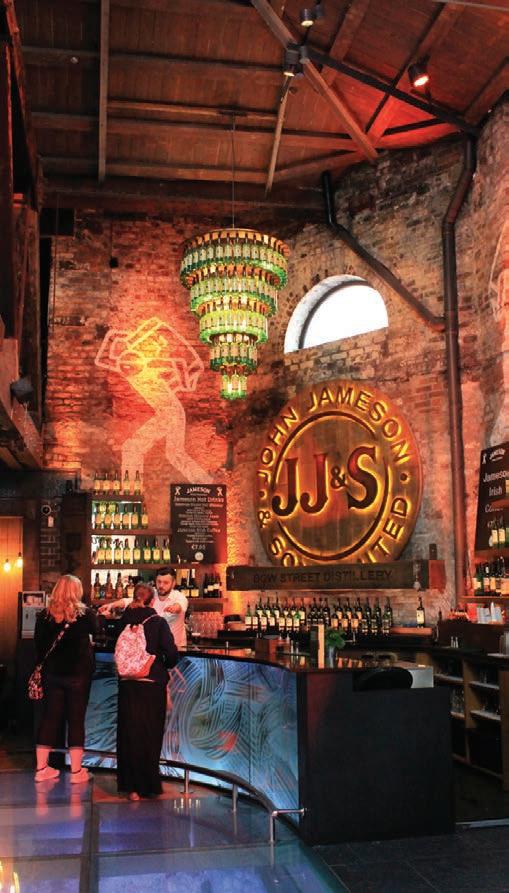
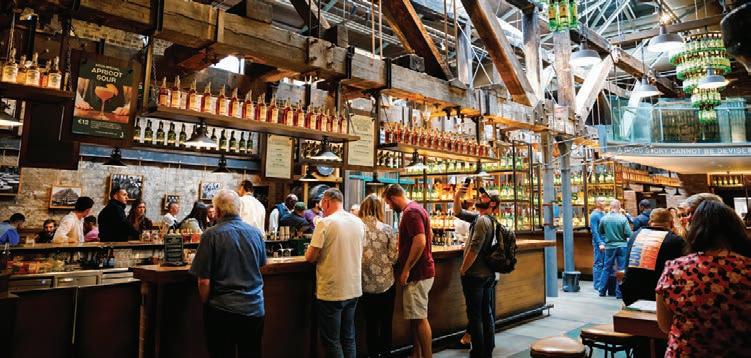
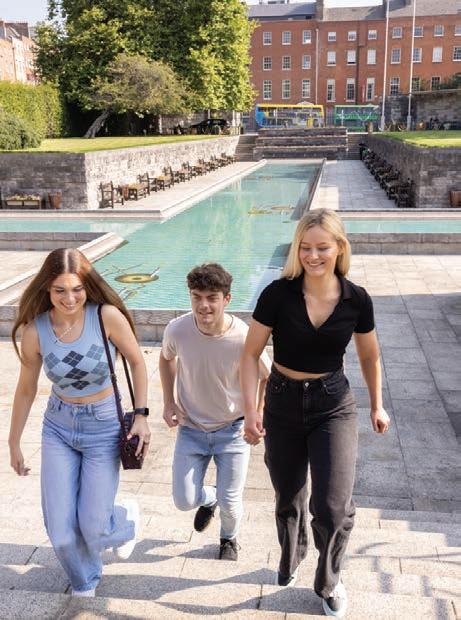
Dublin’s Garden of Remembrance is a peaceful memorial in the heart of the city, dedicated to those who gave their lives for Irish freedom. Located at the northern end of O’Connell Street on Parnell Square, the garden was opened in 1966 to mark the 50th anniversary of the Easter Rising. It features a tranquil reflecting pool shaped like a cross and a striking bronze sculpture depicting the Children of Lir, symbolizing rebirth and transformation. Surrounded by quiet terraces and colorful flowers, the Garden of Remembrance offers a reflective space amid the bustle of the city.
Just a short two-minute walk away is The Castle Hotel, making it easy to combine a moment of reflection with a warm Dublin welcome. The hotel is a time capsule of Georgian elegance where eighteenthcentury charm meets modern comfort.
The Garden of Remembrance is a peaceful memorial garden dedicated to those who fought for Irish freedom.



WITH EXTENSIVE COLLECTIONS SPANNING ARCHAEOLOGY, DECORATIVE ARTS AND DESIGN, MILITARY HISTORY, NATURAL HISTORY, AND IRISH FOLKLIFE, THE NATIONAL MUSEUM OF IRELAND OFFERS SOMETHING TO CAPTIVATE, INFORM, AND DELIGHT VISITORS OF ALL AGES AND BACKGROUNDS.

The Kildare Street location is a treasure trove of archaeological artifacts, showcasing Ireland’s rich past. The stunning collection of early medieval treasures, which bridge the country’s pagan heritage and early Christian culture, provides a fascinating insight into Ireland’s history. The Ór exhibition, a dazzling display of prehistoric gold dating from 2200 BC to 500 BC, highlights the craftsmanship of ancient Irish artisans.
The Vikings, once raiders, profoundly shaped Ireland’s economy, culture, and politics. At Kildare Street, visitors can explore an impressive collection of artifacts from Viking graves and settlements. Immersive
guided tours of the National Museum bring history to life in inspiring and captivating ways.
For those interested in decorative arts, design, and military history, the Collins Barracks location is a must-visit. Here, Gaelic Athletic Association (GAA) artifacts dating back to the 15th century are on permanent display. The museum also houses an important collection of works by Eileen Gray, Ireland’s pioneer of 20thcentury design and architecture. Her modernist furniture sits alongside personal items such as photographs, lacquering tools, and ephemera that offer a glimpse into her creative world. The National
Museum at Merrion Street is closed for refurbishment, you can explore the Natural History Collection at the Dead Zoo Lab here in Collins Barracks.
The Changing Ireland Galleries opening at Collins Barracks October 2025 marks the largest expansion of the National Museum of Ireland in over two decades. The stateof-the-art galleries represent a landmark public investment in the exhibition of the national collection. Situated in the over 300-year-old Military Barracks, they provide unprecedented public access to the nation’s 20th and 21st century history collections.
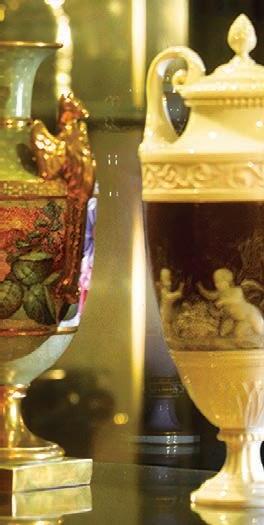

The Changing Ireland Galleries are an invitation to conversation with the everyday and extraordinary objects that witnessed or contributed to the transformation of Ireland over the last 150 years such as Hannah Sheehy Skeffington’s suffrage banner, James Connolly’s hat from the Easter Rising, and exciting new acquisitions including worldrenowned guitarist Rory Gallagher’s 1961 Fender Stratocaster and Former President of Ireland and Human Rights Trailblazer Mary Robinson’s inauguration suit designed by Louise Kennedy.
In County Mayo, the National Folklife Collection at Turlough Park offers an indepth look at Ireland’s cultural traditions. This fascinating museum is set within 30 acres of lush parkland, gardens and woodland with a large contemporary museum building, a historic house and lots of interesting features to explore outdoors. There are four floors of exhibition


galleries where objects, archive film and photography present a tapestry of daily life in Ireland from the 1850s to the 1950s. Families will also enjoy The Murmur of Bees, an interactive exhibition looking at the essential role of bees in nature, their impact on the environment, and their influence on Irish culture.
The history of the National Museum of Ireland dates back to the 1800s, when Parliament established a state-run museum in response to requests from the Royal Dublin Society (RDS) for continued government funding for its growing collection. The Science and Art Museums Act of 1877 transferred the RDS’s buildings and collections to state ownership. Today, the National Museum of Ireland operates as a semi-state autonomous agency under its own Board, continuing its mission to preserve and showcase the country’s rich cultural and historical heritage.
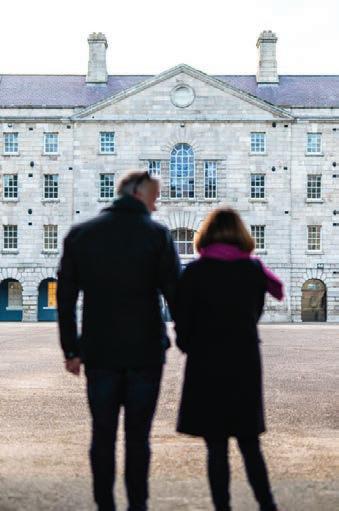
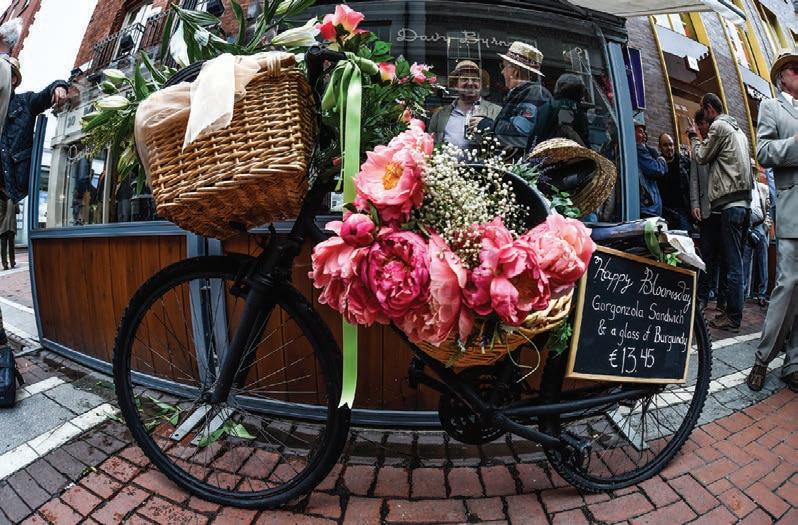
DUBLIN IS A CITY STEEPED IN LITERARY HISTORY, AND NO WRITER IS MORE CLOSELY ENTWINED WITH ITS COBBLED STREETS AND GEORGIAN FACADES THAN JAMES JOYCE.
For lovers of literature and culture, there is no better place to begin your Joycean journey than at The James Joyce Centre, located in the heart of the city at 35 North Great George’s Street, Dublin 1.
Housed in a magnificent 18th-century townhouse, the James Joyce Centre is a literary sanctuary, preserving and promoting the legacy of one of Ireland’s greatest writers. The building itself is a work of art - its ornate fanlight windows, original plasterwork, and sweeping staircase echo the grandeur of Dublin’s Georgian architecture.
Once home to the Earl of Kenmare, the building later became a dancing school run by Denis Maginni, a character
immortalized in Ulysses. Since 1996, it has been dedicated to Joyce and now serves as a museum, cultural venue, and hub for Joycean activity all year round.
Inside, visitors can marvel at the original front door of No. 7 Eccles Street, the fictional home of Ulysses’ central character, Leopold Bloom. The Centre also features rotating exhibitions, historical artefacts, and insightful installations that shed light on his complex writings and enduring cultural influence.
The Centre hosts a vibrant program of events, lectures, film screenings, and workshops designed to engage everyone from seasoned Joyceans to curious newcomers. A cornerstone of their offering
is a year-round selection of walking tours. These guided excursions lead visitors through the real streets walked by Joyce’s characters, bringing to life the pubs, shops, churches, and hidden corners featured in his work.
Whether you’re standing outside Davy Byrne’s pub on Duke Street or listening to stories beneath the portico of the National Library, the city becomes a living text, a Joycean map waiting to be explored.
Each year on June 16th, Dublin bursts into celebration for Bloomsday, the date on which Ulysses is set. What began as a quiet tribute in 1954 has grown
into a global literary festival that draws thousands of pilgrims and fans from around the world.
The James Joyce Centre is the epicenter of the festivities. People dress in Edwardian costume, read aloud from the book, and recreate Bloom’s iconic day through the streets of Dublin. The air is filled with music, theatre, lectures, food, and the distinctive rhythm of Joycean language.
Beyond Bloomsday, Dublin invites visitors to embark on a personal odyssey through its Joycean landmarks. The James Joyce Tower and Museum in Sandycove, once the home of Joyce’s friend Oliver St. John Gogarty, offers sweeping views of Dublin Bay and hosts ongoing events and exhibitions.
Pop into Sweny’s Chemist, still preserved in 19th-century style, where you can pick up a bar of lemon soap and hear volunteers read from Joyce’s works. Wander through Marsh’s Library, unchanged since the 18th century, where young Joyce once
read. Or take in the Museum of Literature Ireland (MoLI), which brings Joyce’s legacy to life through immersive exhibits in the university where he once studied. Even a quiet moment in the National Library of Ireland’s reading room, or a walk along the Royal Canal, where Bloom reflects on life and love, offers a deep connection to Joyce’s Dublin.
James Joyce once claimed that if Dublin “disappeared,” it could be recreated from the pages of Ulysses. Nowhere else in the world has a city been so thoroughly and lovingly immortalized by an author. The James Joyce Centre ensures this legacy lives on, inspiring new generations to discover the richness of Dublin’s literary soul.
Whether you're a devoted Joycean or simply curious about Irish culture, a visit to the Centre and its associated events is an unforgettable immersion into the heart of Dublin—past, present, and imagined. Explore the legacy. Walk the words. Rediscover Dublin. www.jamesjoyce.ie
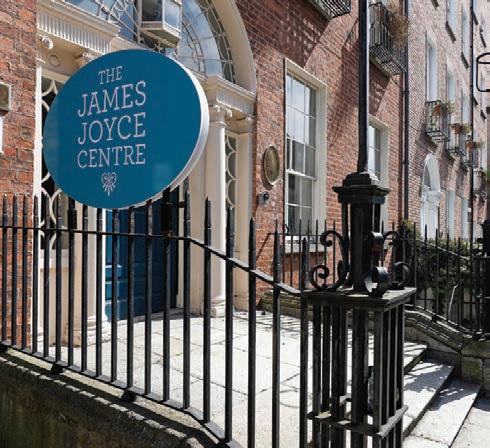
“When I die, Dublin will be written on my heart.”
James Joyce


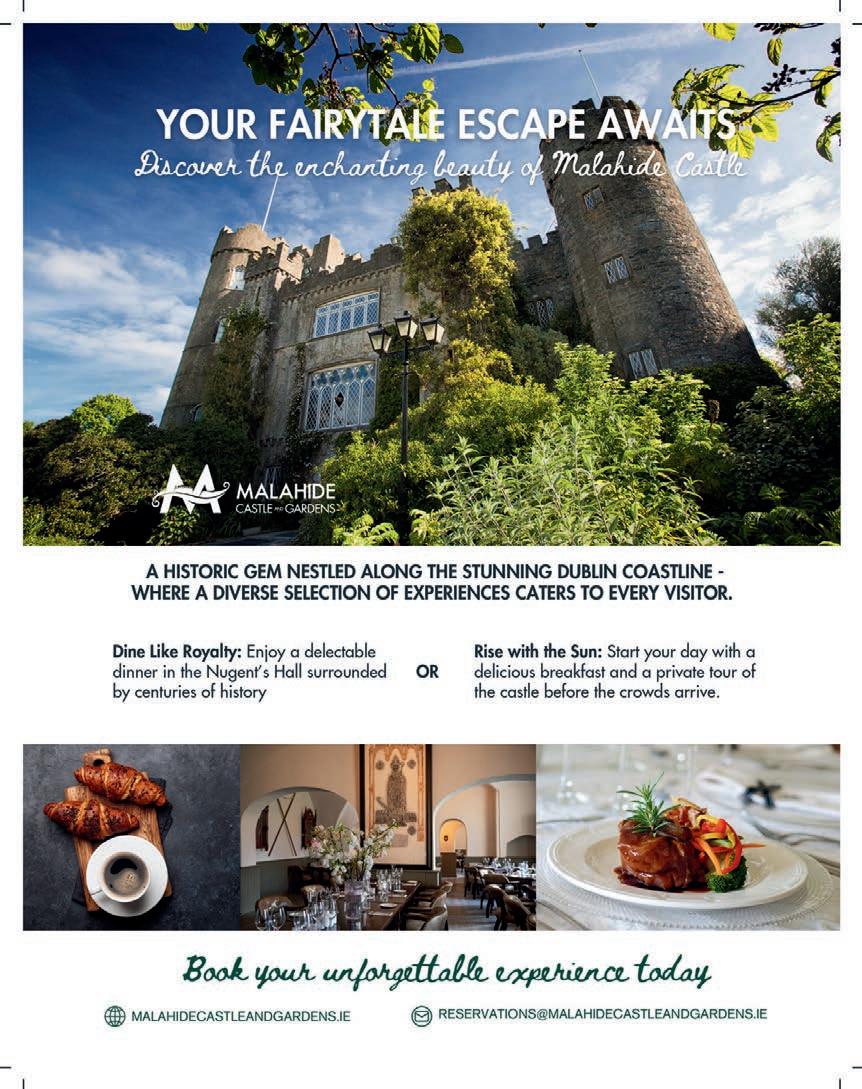

MALAHIDE CASTLE COMES ALIVE IN THE FALL WITH GHOSTLY TALES, WHISKEY TRAILS, AND BANQUETS IN CENTURIES-OLD HALLS.
Just a short drive from Dublin along the sweeping coastline, Malahide Castle is one of Ireland’s great historic treasures. Dating back to the 12th century, the castle was home to the Talbot family for nearly 800 years, making it one of the oldest castles in Ireland continuously occupied by the same family. Its story is one of power, politics, and resilience, surviving wars, sieges, and centuries of change. Today, it welcomes visitors from around the world to walk in the footsteps of lords, ladies, and legends.
Malahide itself is more than a pretty seaside village. The community grew in
the shadow of the estate, with many early residents working as tenants, servants, or tradespeople connected to the castle. Over time, the sheltered harbor brought fishing and trade, but the influence of the castle remained at the heart of village life. Visitors today can still sense that historic bond while strolling the quaint streets lined with boutique shops, cafes, and cozy pubs. It is a place where history and modern charm blend seamlessly with the grandeur of the castle and its vast estate. Peacocks can often be seen parading the castle grounds, adding a touch of pageantry to the estate’s sweeping lawns, while the gardens are home to Ireland’s
only Butterfly House, where hundreds of exotic butterflies drift gracefully among tropical blooms.
In the golden light of fall, the story deepens. Nature paints the parklands in copper and crimson strokes, the air sharpens, and the castle opens its doors to events that embrace the magic of the season.
When twilight falls, Malahide Castle takes on a haunting beauty, every stone seeming alive with ancient tales. Guests are invited to step inside the 800-year-
old fortress under the cover of darkness, where the line between history and legend blurs. A Traitorous Tale immerses visitors in the castle’s supernatural past, where chilling stories and ghostly encounters stir the imagination. Among the spirits said to linger is Puck, the castle’s mischievous jester, and the mysterious White Lady, who has been sighted drifting silently through the corridors. These tales, rooted in the ancient Celtic festival of Samhain, the origin of Halloween, give visitors a spinetingling sense of Ireland’s oldest traditions in a setting like no other.
For those who favor warmth over chills, Malahide Castle also offers intimate evenings of whiskey tasting and dining

within its historic walls. Guests savor some of Ireland’s finest whiskies while experts share stories of craft, heritage, and the legends surrounding the “water of life.” The evening continues with a gourmet dinner served in a private dining room, where candlelight, character, and centuries of history combine to create an unforgettable experience. It is a rich, sensory way to taste Ireland while surrounded by the echoes of eight centuries of hospitality.
Beyond its autumn festivities, Malahide Castle is a destination in its own right year-round. The estate is home to beautifully landscaped gardens, rare plant collections, and one of Ireland’s
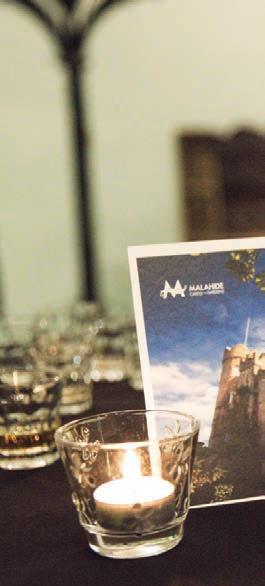

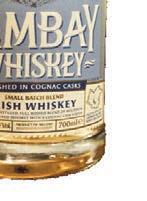
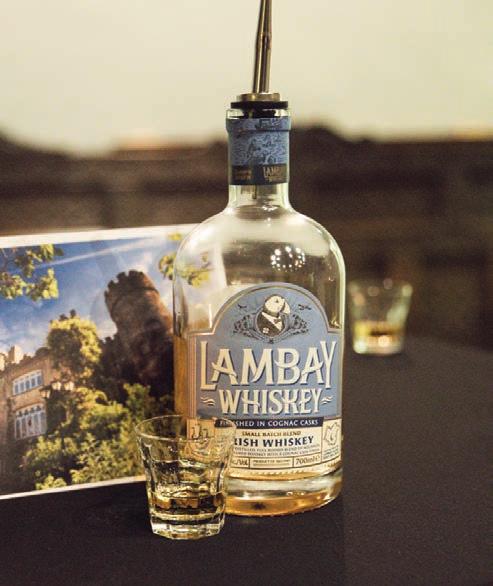
most celebrated botanical displays. Families delight in the interactive fairy trail through the woodlands, while history enthusiasts explore guided tours of the castle’s furnished rooms, filled with period décor and centuries of stories. Seasonal events, from summer outdoor concerts to festive Christmas activities and markets, ensure the castle remains a vibrant hub of culture and community.
Whether it is a ghostly tale at twilight or a fireside toast with friends, fall at Malahide Castle is an unforgettable experience. Add in a stroll through Malahide village or a walk along the scenic coastline, and it becomes a perfect Irish getaway.
This fall, step into the past and into living history at Malahide Castle. Check the castle’s website and social media channels for dates, tickets, and upcoming events.
Beyond its history, Malahide Castle is a vibrant and immersive destination set within 260 acres of stunning parkland and gardens. The walled garden bursts with color and fragrance, featuring a diverse collection of plant species from around the world.

If you like your city breaks with a side of old-world elegance, Dublin delivers. Around St. Stephen’s Green and Merrion Square, rows of Georgian townhouses keep their poise with fanlight doors, high ceilings, and salons made for slow mornings. Check in and you are essentially borrowing a slice of the city’s architectural heritage, with modern comfort tucked behind centuries-old brick.
Start with the grand old dame, The Shelbourne on St. Stephen’s Green. Think marble lobby, chandeliers, and a sense of occasion from the moment the doorman tips his hat. This is the Dublin address for afternoon tea, a fireside nightcap, and people-watching in the Horseshoe Bar. Rooms feel plush and classic, and the park across the street sets you up for early walks before the city stirs.
A few minutes away, The Merrion turns four restored Georgian townhouses into one of the most beautiful hotels in the country. It is elegant and calm, with period detail, a serious Irish art collection, and a courtyard garden that feels like a private square. The spa and pool make it hard to leave, and dinner here is a treat, but be ready for top-tier pricing. If you are celebrating, it’s worth the splurge.
By the Green, you will also find handsome Georgian and Georgian-inspired hotels that keep things stylish without being showy. The Stephen’s Green Hotel sits near the park and places you steps from Grafton Street, the Little Museum of Dublin, and the leafy loop around the Green. For similar townhouse character at a gentler price point, look to long-loved addresses near government buildings and museums, where you can settle into sashwindowed rooms and slip out to a café in minutes.
If a castle stay is on your wish list, Dublin can do that too. Clontarf Castle Hotel blends castellated drama with contemporary comfort on the city’s north side. You get turrets, tapestries, and a lounge under vaulted stone, plus quick access to coastal walks around Clontarf
and Howth. It feels like a getaway while still being a short hop from the city center.
Whichever style you choose, the pleasures are the same. Wake to a quiet courtyard or a view over the Green. Wander out for museums, shopping streets, and Georgian squares where the doors wear bright paint like jewelry. Come back for tea by the fire or a cocktail before dinner. In a city that moves easily between past and present, staying in a stately home or castle-style hotel lets you live the Dublin you came to see, with history in the walls and everything you want just beyond the front steps.

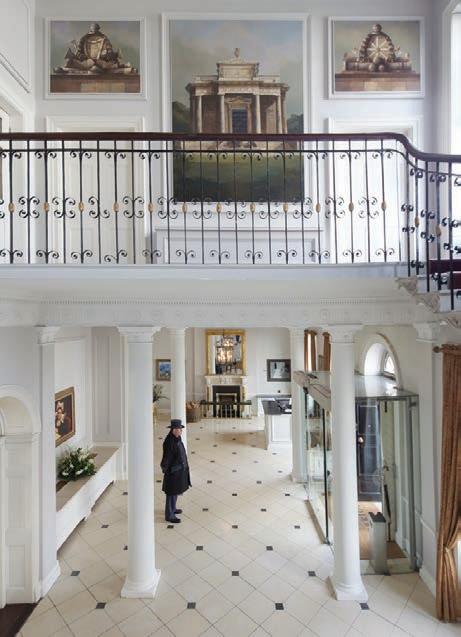

DUBLIN’S OLDEST HOTEL BLENDS HISTORY, LIVE MUSIC, AND A WARM IRISH WELCOME IN THE HEART OF THE CITY.
It’s an ordinary night in the center of Dublin, but an unforgettable evening is about to unfold. Downstairs in the vaulted basement of the Castle Hotel, soloist Ray Cox sings and plays to an enraptured crowd. Over pints of Guinness and hearty steak dinners, guests clap and laugh as his Irish ballads fill the bar. Each song is accompanied by charming, personal stories. The spell is unbroken, even as Irish dancer Jeanne Kennedy’s taps echo across the stone floor.
The appeal of this traditional independent hotel is not simply its nightly live music or wholesome Irish cuisine, but its outstanding hospitality and personal service. From the moment you arrive, there is no doubt you are in Ireland.
“Whether it is a homecoming for those with Irish roots, an exhilarating European adventure with your extended family, or a solo trip to Ireland, our guests find a sense of connection and security when they stay at the Castle Hotel. Many of our guests return time and again, seeking the comfort and familiarity that define our hospitality,” explains General Manager Yvonne O’Keeffe. One regular guest put it best: “My home is my Castle, and when in Dublin, the Castle is my home.” It is this warm Irish welcome, she adds, that lingers long after you have left Ireland.
Stepping through the famous red Georgian door, you are immediately greeted by antique-filled lounges, large windows, grand staircases, and
chandeliers that recall a bygone age. Irish eyes are smiling throughout, from check-in to check-out. The personable Castle team is always ready with recommendations and genuinely eager to hear about your adventures in the city. And you will have plenty to share.
Set in a prime location, the hotel is within walking distance of iconic attractions such as Trinity College and the Book of Kells, Hugh Lane Gallery, and O’Connell Street’s GPO. Hop-on, hop-off bus tours stop right outside, taking you to hidden gems and famous sites like the Guinness Storehouse, St. Patrick’s Cathedral, Kilmainham Gaol, and Dublin Zoo. The Castle Hotel is also within easy reach of leafy neighborhoods and coastal villages
where you can explore spectacular gardens, castles, cliff paths, and beaches. A warm Irish welcome extends yearround with festivals and events, including January’s TradFest in nearby Temple Bar, the St. Patrick’s Festival, which begins just outside the hotel on Parnell Square North, and the Aer Lingus College Football Classic in August. The hotel comes alive for the winter holidays as well, with festive décor throughout and special menus marking Thanksgiving and the lead-up to Christmas.
Steeped in history and brimming with character, the Castle Hotel has a legacy stretching back to 18th-century Georgian Dublin. Designed by Richard Castle, executed by John Ensor, and established in 1809, it holds the distinction of being Dublin’s oldest hotel. Quietly expanding ever since, this historic gem now has two restaurants, a garden terrace, a charming bar, parking, and 130 en-suite rooms, including spacious family rooms that are in high demand.
Guests can expect great value and modern amenities such as Wi-Fi, elevators, barista coffee, and luggage storage service. Traditional touches remain too, like afternoon tea in the elegant dining rooms of the Old Music Shop Restaurant and
Irish Coffee after dinner in the Castle Vaults Bar and Restaurant. Enjoy live music every night from 8 p.m., with Irish dancing on Fridays and Saturdays from 9 p.m. For the best rates, book direct at www.castlehotel.com
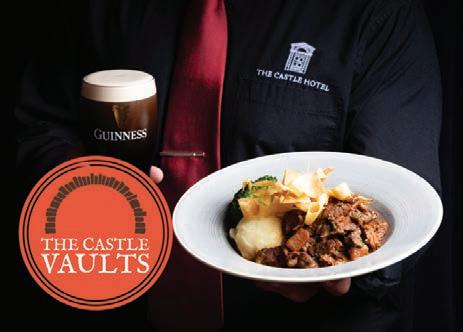
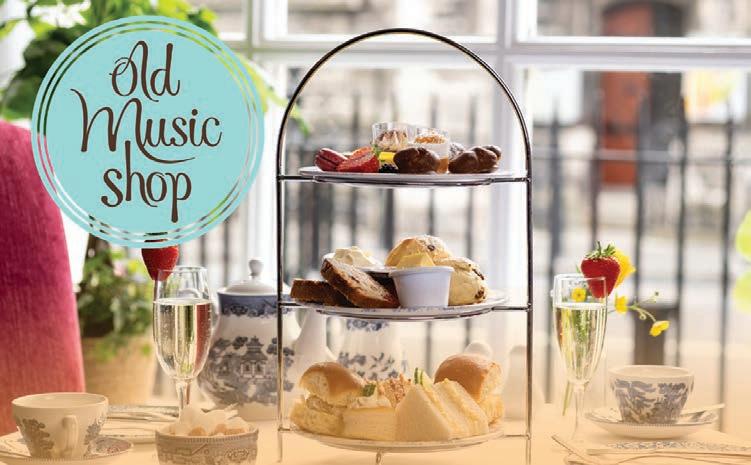


When you think of Waterford, centuries of crystal and craftsmanship may come to mind, but beyond the city’s famous glassworks lies another kind of artistry; one carved not by hand, but by time and tide.
Along the county’s southern edge, the Copper Coast stretches between Tramore and Dungarvan, a spectacular sweep of cliffs, coves, and sea-sculpted headlands that tell a story hundreds of millions of years in the making.
Designated a UNESCO Global Geopark, the Copper Coast is one of Ireland’s most striking natural landscapes. Its cliffs are layered with volcanic rock, sandstone, and shale that reveal the geological drama of ancient oceans and fiery eruptions. In the nineteenth century, these same cliffs glittered with seams of copper,
sparking a mining boom that drew families from across Ireland, Cornwall, and continental Europe. At its height, the industry supported thriving communities around Bunmahon and Tankardstown, where miners lived and worked in tough but vibrant conditions.
The copper that gave the region its name eventually ran out by the 1870s, and with it, the mines fell silent. What remains today are the atmospheric ruins of engine houses and chimneys, their stone outlines softened by grass and sea air. These remnants stand as reminders of the area’s industrial past, a time when this quiet coastline was alive with the sounds of picks, carts, and ships loading ore for export. The Geopark now protects these sites, celebrating both their human history and their geological significance. Around Bunmahon, the Copper Coast Geopark
Visitor Centre tells that story in full, charting how this wild stretch of coastline has evolved from a place of hard industry to one of education, conservation, and discovery.
Today, choughs, peregrine falcons, and seals have replaced the miners as regulars along these cliffs, thriving in the protected habitats that have returned to this remarkable coast.
The Copper Coast isn’t just admired from a distance, it’s experienced. The cliffs and coves invite exploration, whether through sea kayaking, paddleboarding, or coasteering, an adventure that blends swimming, climbing, and leaping from the rocks into the Atlantic. Local groups such as Bunmahon Adventures help visitors experience this raw, exhilarating


side of the coastline, while surfers, divers, and walkers find their own rhythm along its trails and beaches. It’s a stretch of shore that encourages both reflection and adrenaline, alive with color, motion, and salty air.
That same sense of vitality flows through the people who live here. Local artisans channel the landscape into their work, from potters shaping clay the color of the cliffs to artists capturing the shifting light of the sea. Even the region’s name continues to inspire, with copper craft enjoying a quiet revival that nods to its mining heritage. Across workshops, kitchens, and small studios, there’s a pride in creating something that feels rooted in place.
The connection between land, craft, and community runs deep, and it finds its flavor, quite literally, in the beers of Dungarvan Brewing Company. Drawing inspiration from the same coastline that fuels so much creativity, the brewery has captured the essence of West Waterford in its range. The Helvick Blonde, Black Rock

Stout, and Copper Coast Red Ale each evoke a different note of the landscape - bright and crisp like sea air, dark and deep as the ocean, and warm with the amber tinge of the cliffs.
In a county long associated with skill and artistry, the Copper Coast is a place where tradition continues to find new expression.
Lonely Planet named Ireland’s Copper Coast among the world’s best off-grid destinations - a landscape where nature still leads the way.
On Ireland’s southeast coast, where the mountains meet the sea, Dungarvan Brewing Company has been crafting small-batch, bottle-conditioned beers since 2010. Rooted in the charm of County Waterford and shaped by the beauty of its surroundings, this independent brewery is both a local favorite and a must-visit stop for travelers who love authentic Irish flavor.
Located in the seaside town of Dungarvan, the brewery offers immersive tours that give visitors a genuine taste of Ireland’s thriving craft beer culture. Guests are invited behind the scenes to watch the brewing process unfold, from selecting the finest malt and hops to seeing the finished beer bottled and ready to enjoy. It’s a hands-on experience that blends heritage and modern craft, finishing with a guided tasting session featuring the brewery’s award-winning beers.
Leading Dungarvan Brewing Company into a new era are its owners, Tom and Becky Dauber, who hail from Vienna, Virginia, near Washington, DC, to take over the brewery in 2023. Tom brings more than 30 years of experience in business growth and strategy, along with a lifelong passion for brewing inspired by his years growing up in Germany. Becky, a former math teacher, now divides her time between family life and supporting the brewery’s vision. Together, they’ve embraced West Waterford’s community spirit and set out to expand the brewery’s reach while keeping its artisanal roots intact.
While Tom and Becky chart the course, it’s the small, dedicated team in Dungarvan


For over a decade, Dungarvan Brewing Company has been a cornerstone of the Irish craft beer scene, handcrafting traditional, bottle-conditioned ales and stouts that have delighted beer enthusiasts across the South East.
that gives the brewery its heart. Head Brewer and Client Relationship Manager Cormac O’Dwyer, a local and one of the brewery’s original founders, brings deep knowledge and character to every pint. His name appears proudly on each bottle, a mark of craftsmanship and care. Alongside him is General Manager Katrina Murphy, originally from Dublin, who blends hospitality expertise with a creative approach to beer pairings and collaboration. When you visit, it’s likely Cormac and Katrina you’ll meet, ready with a smile, a story, and a sample.

At the core of Dungarvan Brewing Company’s lineup are three signature beers that reflect both the artistry of craft brewing and the landscapes of West Waterford. Helvick Gold Blonde Ale is crisp, light, and refreshing, with gentle floral and citrus notes that mirror the coastal breeze of nearby Helvick Head in the Gaeltacht area. Copper Coast Red Ale, named for the dramatic UNESCO Global Geopark that stretches from Fenor to Stradbally, is a rich, ruby-colored ale with hints of caramel and roasted malt, as warm and welcoming as the coastline that inspires it. And Black Rock
Irish Stout, dark and velvety with notes of coffee and chocolate, takes its name from the rugged sea stack visible from Helvick Head looking back across Dungarvan Bay. Each beer tells its own story of place, flavor, and craftsmanship, weaving the essence of West Waterford into every sip.


The region itself offers plenty to explore before or after a tour. From the cliffs and wildflowers of Helvick Head, where dolphins dance in the bay, to the striking geological wonders of the Copper Coast, this corner of Ireland captures the connection between land, sea, and culture that defines Dungarvan Brewing’s spirit.
Visitors are warmly invited to join a tour and tasting at the brewery and experience this blend of creativity and community firsthand. Groups of eight or more can enjoy a 10% discount by pre-booking and mentioning this article.
For bookings, contact: hello@dungarvanbrew.com visit: www.dungarvanbrew.com or follow: @dungarvanbrewco on social media for updates and events.
From its roots in the heart of Dungarvan to its ties with the wild beauty of West Waterford, Dungarvan Brewing Company stands as a testament to what makes Irish craft beer so special - a balance of tradition, innovation, and pure local character poured into every glass.
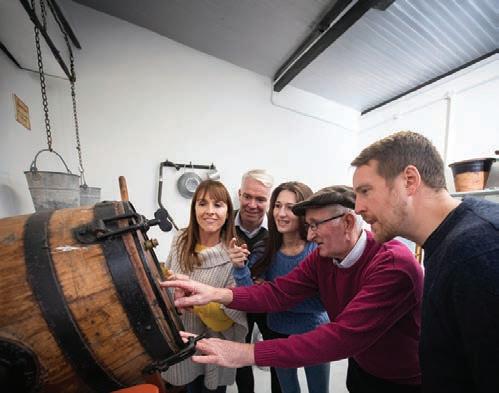
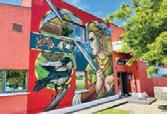

Experience a Personalized Tour of Ireland’s Rural History
Delve into 250 years of Irish Rural life and be guided through an unforgettable glimpse into the past

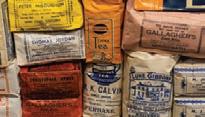



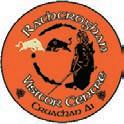

Rathcroghan, Cruachan Aí, is known as the Ancient Capital of Connacht, where the festival of Samhain (Halloween) is said to originate. This majestic landscape is the oldest and largest unexcavated Royal Site in Europe, and home of the Iron Age Warrior Queen Medb. Experience Rathcroghan’s rich archaeology, mythology and history through our interpretive rooms and expertly guided tours. The Rathcroghan Visitor Centre, the home of our museum, is located in the medieval village of Tulsk, Co. Roscommon.
Rathcroghan Visitor Centre is open all year round, so why not book a place on one of our tours by visiting our website.



DEFINED BY ITS CONNECTION TO BOTH LAND AND WATER AND HERALDED FOR ITS BEAUTY, IRELAND’S HIDDEN HEARTLANDS IS A REAL BACK TO NATURE DESTINATION.
As the trail of Ireland’s Ancient East winds westward, the rhythm changes. The grand monuments, castles, and market towns give way to gentler landscapes, open fields, winding rivers, and quiet corners where time moves at a slow pace. This is Ireland’s Hidden Heartlands, a region stretching through the midlands and along the waterways of the Shannon, linking the bustle of the east to the calm of the west.
Often called the country’s green heart, the Hidden Heartlands follow the course of the River Shannon, which runs like a spine through the landscape from Cavan in the north to Limerick in the south.
The Shannon, Ireland’s longest river, is the thread that ties the region together, shaping the towns and villages that rise gently along its banks.
If Ireland’s Ancient East tells the story of where the island came from, the Hidden Heartlands reveal what rural Ireland feels like today; unhurried, genuine, and defined by its sense of place.
While the coasts may claim the drama, the Hidden Heartlands hold a quieter strength. At Clonmacnoise, round towers and stone crosses still keep watch over centuries of
change. In nearby County Offaly, the imposing Birr Castle adds a touch of grandeur, its turrets rising above sweeping lawns and stately gardens famed for rare trees and towering hedges. Once home to the world’s largest telescope, built in the 1840s by the 3rd Earl of Rosse, the estate became a hub of scientific discovery and innovation. Today, visitors can explore its science galleries, tranquil gardens, and the restored great telescope that once revealed distant galaxies to Victorian astronomers. Further north, Clough Oughter Castle in County Cavan stands isolated on its island, a 13th-century fortress once held by the O’Reilly clan. Besieged and damaged in
the Cromwellian wars, it still rises defiantly from the lake’s surface, a haunting reminder of Ireland’s turbulent past.
At the very heart of it all lie the midland counties of Roscommon and Westmeath, shaped by open skies and soft horizons. Roscommon, known as the Land of Lakes, carries the calm confidence of a county defined by its broad landscapes and unhurried pace. Westmeath, its neighbor, balances that stillness with an active spirit
with green parklands, forest trails, and canal paths leading through some of the Heartlands’ most tranquil scenery.
Together, they capture what the Hidden Heartlands are all about – nature, heritage, and a slower way of life that feels refreshingly real. Whether you’re following the flow of the Shannon, cycling a greenway, or relaxing beside a quiet lake, this is Ireland at its most tranquil and inviting.

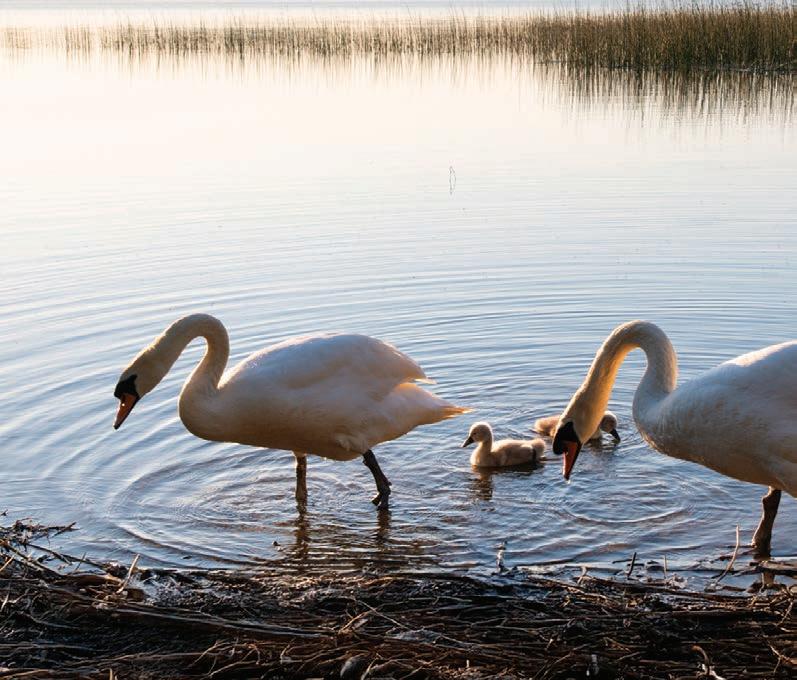

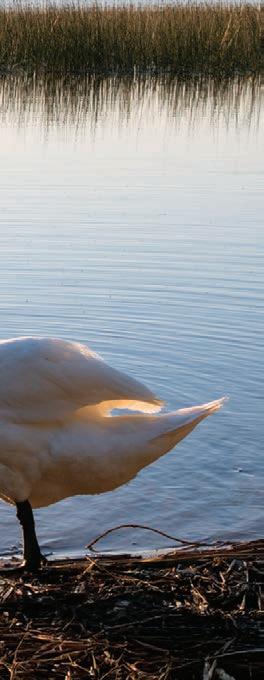
The Hidden Heartlands follow the course of the River Shannon, which runs like a silver thread through Ireland’s green heart.
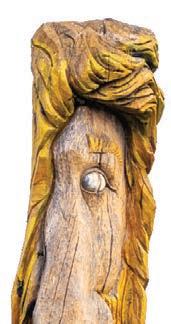


In the heart of Ireland, where tranquil lakes, rich heritage, and peacful landscapes invite you to slow down and explore.
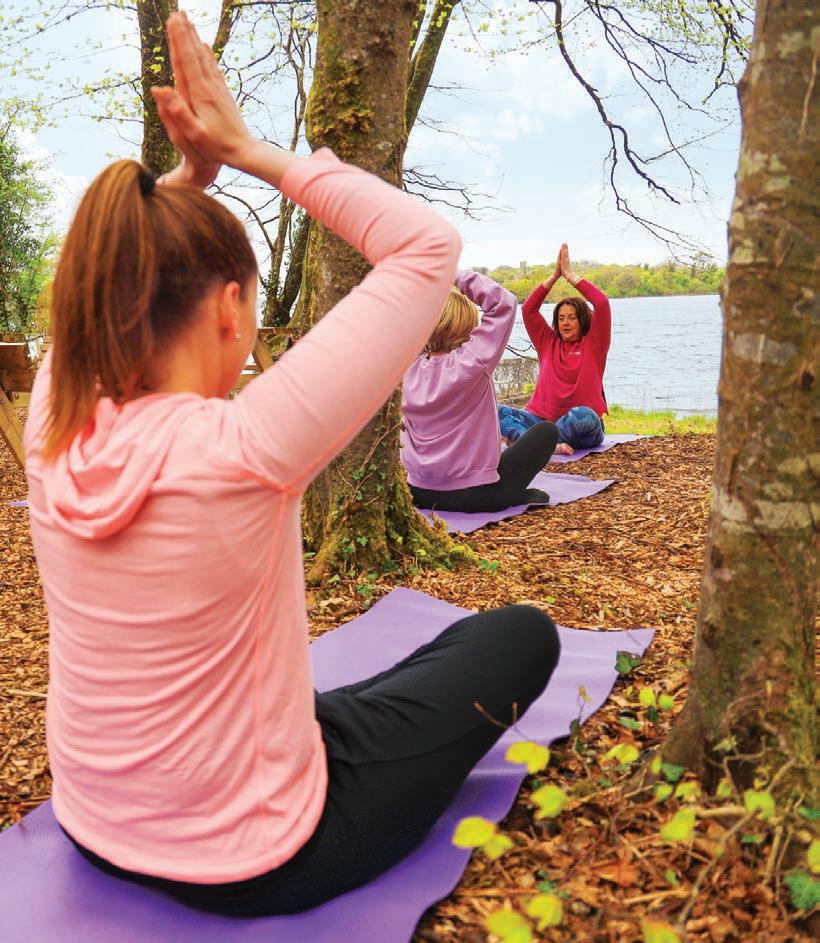




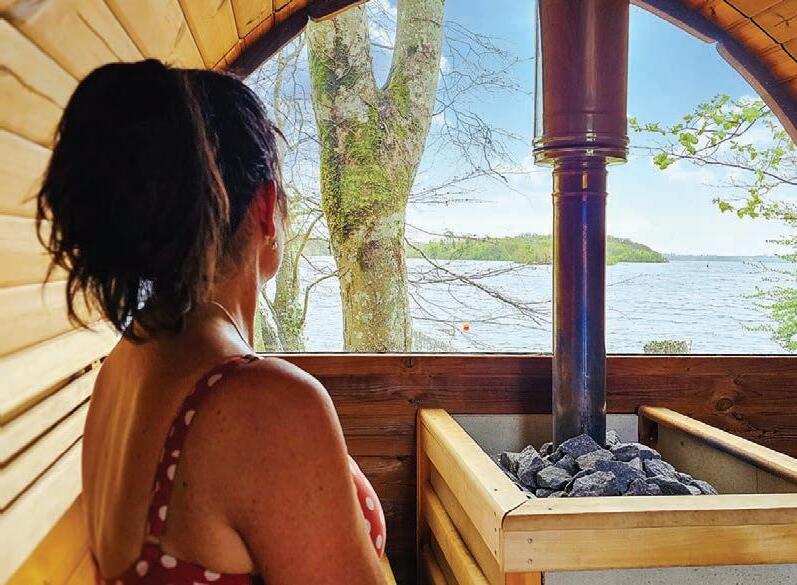
IN THE HEART OF IRELAND, ROSCOMMON INVITES YOU TO SLOW DOWN, EXPLORE LAKES AND TRAILS, PEEL BACK THE LAYERS OF TIME, AND ENJOY WARM HOSPITALITY IN A PLACE THAT FEELS TRULY AUTHENTIC.
Roscommon is just a short drive from Ireland West Airport and less than two hours from Dublin and Galway. Here, visitors can slow down, lace up their boots, hop on a bike, and immerse themselves in big skies, tranquil lakes, scenic trails, and lively festivals. From the peaceful solitude of a misty riverside walk to adrenaline-fueled treetop challenges and waterslides, the county offers a season of unforgettable experiences.
Roscommon is not just a place to visit; it is a place to feel. With more than 25 waymarked trails winding through boglands, ancient woodlands, and
lakeshores, every step reveals something new. Hike the Miners Way, follow the National Famine Way, or explore hidden gems along the Beara Breifne Way and Cloonlarge Bog Walk.
On the water, thrill-seekers will find plenty to enjoy. Shannon River Adventure in Rooskey offers kayaking, mudslides, climbing walls, and archery for all ages. Anglers can cast off from Lough Ree or Lough Key, while families can dive into fun at Baysports, Ireland’s largest inflatable waterpark at Hodson Bay. Lough Ree Access for All Boat Tours provide 90-minute cruises around Lough Ree, with sweeping views of its mythical islands.
For a slower pace, take a swim at Lough Errit, Cavetown Lake, or Lough Key, then relax in a lakeside sauna as the mist rises. Whether it is a gentle dip or a quiet moment by the water’s edge, Roscommon lets visitors breathe deeply and recharge.
Roscommon is built for family fun. Fly through the trees at Zipit Forest Adventures, kayak with P Macs Kayaks on Lough Key, or take on the challenges of the indoor Boda Borg at Lough Key Forest and Activity Park.
In Roscommon town, the new playground and Sculpture Trail at Mote Park features a stargazing seat and winding nature paths. Families can also discover Mountallen Eco Tours, Glendeer Pet Farm, and Knockvicar Alpacas, each offering a hands-on way to connect with the land. This is a county where kids run free, grown-ups reconnect, and families leave with stories worth retelling.
Step underground at the Arigna Mining Experience, Ireland’s last working coal mine, and explore the new discovery park before relaxing in the café with views of Lough Allen.
In Boyle, King House, a beautifully restored Georgian mansion, brings history to life through interactive exhibits, lifelike figures, and tales of the King family and the Connaught Rangers. Its courtyard café and Saturday farmers market add to the charm.
Strokestown Park House and National Famine Museum offer a powerful journey through Ireland's darkest chapter.


At Rathcroghan, one of Ireland’s four major royal sites, daily guided tours explore the Neolithic, Stone Age, and Iron Age landscapes where kings were crowned and legends like Queen Medb were born.
Strokestown Park House and the National Famine Museum offer a powerful journey through Ireland’s darkest chapter. Visitors can explore the historic house, gardens, and woodland before reflecting in the onsite café.
Derryglad Folk Museum showcases farm machinery, household treasures, schoolroom artifacts, and vintage memorabilia, capturing everyday Irish life from the 18th to 20th centuries.
Roscommon’s festival calendar bursts with music, art, and celebration. Each June, the Night and Day Festival brings international and Irish music, family fun,
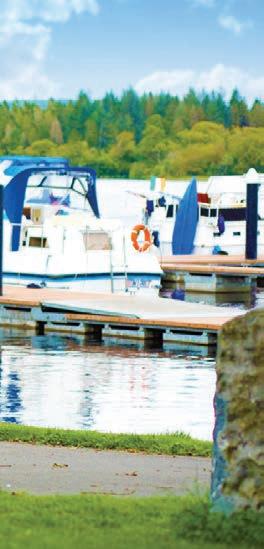
and creativity to Lough Key Forest and Activity Park. July sees the prestigious Boyle Arts Festival take center stage, while the Castlerea Rose Festival delivers family-friendly entertainment for all ages. In December, the Roscommon Christmas Festival lights up the county with markets and the enchanting Christmas Trail in Loughnaneane Park.
From castle hotels and country houses to friendly B&Bs, camping, and glamping, Roscommon offers accommodations to suit every style. Dining is just as varied, with everything from tearooms and cozy waterside pubs to vibrant cafés and award-winning restaurants. Wherever you choose, a warm Roscommon welcome awaits.
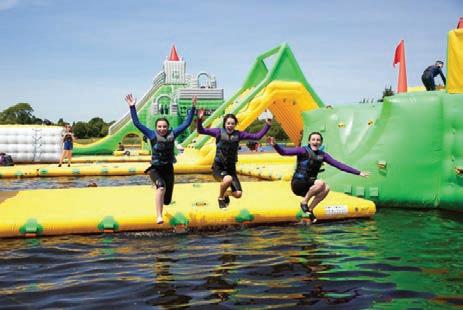

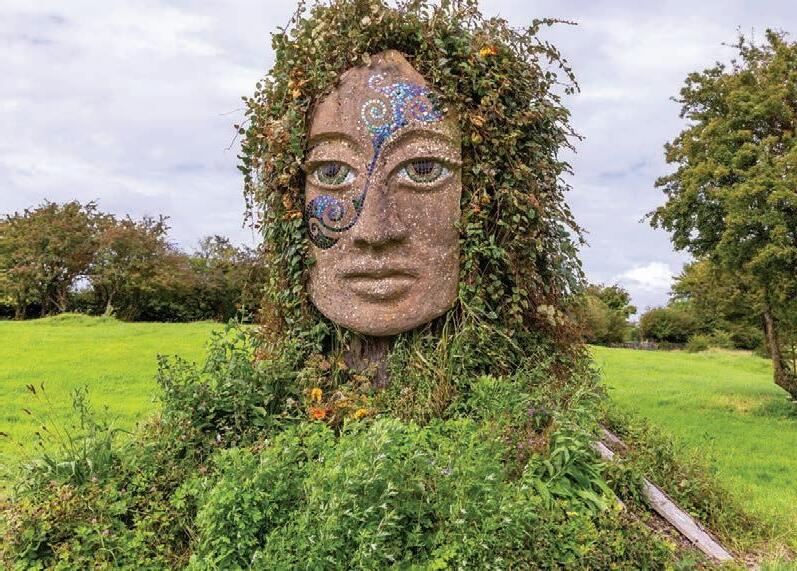
COUNTY WESTMEATH CAPTURES THE ESSENCE OF THE HIDDEN HEARTLANDS - UNHURRIED, WELCOMING, AND WONDERFULLY AUTHENTIC.
While Roscommon offers miles of waterways, Westmeath trades gentle currents for open countryside shaped by centuries. At the very heart of Ireland, it stands as a crossroads between past and present, where traces of ancient Ireland are seldom far from view.
Nowhere is that heritage felt more deeply than on the Hill of Uisneach, long regarded as both the spiritual and geographic center of Ireland. It’s said to be the meeting point of the island’s five ancient provinces and the burial place of the Earth Goddess Ériu, from whom Ireland gets the name Éire. Today, the hill still draws people together during annual
gatherings and re-enactments that revive age old traditions with music and flame-lit processions.
Not far away, the ruins of Fore Abbey offer a glimpse into Ireland’s early Christian heritage. Founded in the 7th century by St. Feichin, the site once housed a large Benedictine community and became known for the “Seven Wonders of Fore,” curious features such as water that won’t boil, a tree that won’t burn, and a monastery built on a bog.
To the north, Tullynally Castle and Gardens near Castlepollard offers a fascinating window into Westmeath’s later
grandeur. Home to the Pakenham family for more than 350 years, it’s one of the few great houses in Ireland still owned by its original family. What began as a 17thcentury fortified house later transformed into a striking Gothic Revival castle, its towers and turrets lending it a fairytale charm amid shaded walks and walled gardens.
Another of the county’s most intriguing estates is Belvedere House and Gardens, an 18th-century masterpiece overlooking Lough Ennell. Known for its elegant design, woodland trails, and elaborate follies, it reflects both the artistry and eccentricity of its age. The Jealous Wall, Ireland’s

largest folly, was built by Robert Rochfort, the first Earl of Belvedere, to block the view of his brother George’s nearby estate after a bitter family feud. Rochfort’s personal life was equally dramatic. He imprisoned his wife Mary for more than 30 years after accusing her of an affair with his other brother, Arthur. Elsewhere in the grounds, the Gentleman’s Secret, a secluded summerhouse, is said to have been the Earl’s private retreat and a place he couldn’t fall out with anyone! Together, these fabulous follies capture the intrigue and extravagance that shaped Belvedere’s past.
No trip to these parts would be complete without a visit to Athlone. Dating back to the 12th century, this garrison town grew around a strategic crossing on the River Shannon, with a castle later built to guard the route between east and west Ireland.

Long known as the gateway between the two halves of the country, Athlone blends its rich past with a lively modern energy.
Sean’s Bar, sitting in the shadow of the castle, proudly holds the title of Ireland’s oldest pub. Dating to around 900 AD, it’s recognized by both Guinness World Records and the National Museum of Ireland as the oldest in the country and possibly one of the oldest in Europe. During renovations in the 1970s, workers uncovered wattle-and-daub walls and ancient coins later confirmed to be from the 9th century. These fascinating finds are now on display inside, connecting today’s visitors to more than a thousand years of history. Step inside and you’ll find the welcome just as warm as ever, with open fires, live music, and an atmosphere that feels timeless.
In many ways Westmeath captures the very essence of the Heartlands, unhurried, welcoming, and full of quiet character. Start your morning with a walk or cycle along a canal towpath, visit a distillery or gallery in the afternoon, and finish the day with good food and a round of drinks in a friendly pub.
For those who enjoy a different kind of round, Westmeath is home to some beautiful parkland golf courses set among gentle countryside. Play beside Lough Ree at Glasson Golf Club, test your accuracy at the classic Mullingar Golf Club, or enjoy a relaxed game at Moate, one of Ireland’s oldest member clubs. When it’s time to unwind, New Forest Hotel & Golf Club offers the best of both worlds. From here, you’re only minutes from lakes, canal-side trails, and lively towns, making it the perfect base for discovering the Heartlands at an easy pace.
Once the sacred center of Ireland, now brought to life each year with fire lit re-enactments and ancient celebrations.



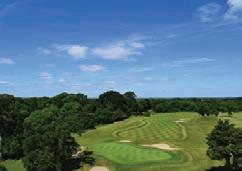

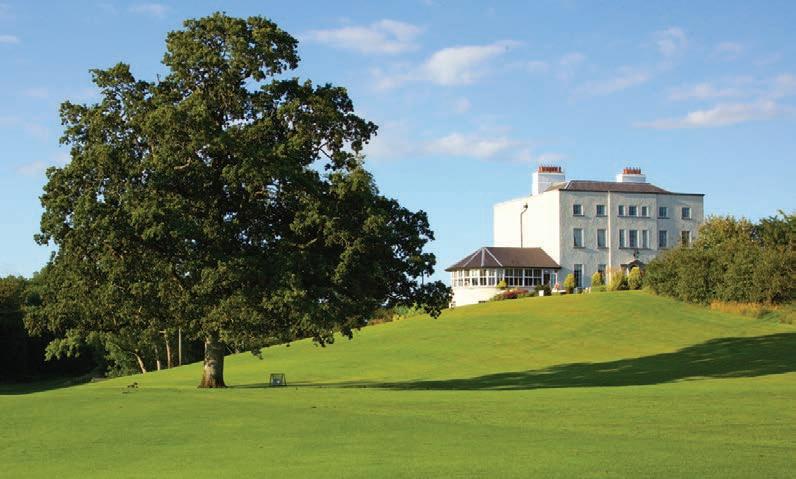
TUCKED AWAY IN THE HEART OF COUNTY WESTMEATH, NEW FOREST ESTATE OFFERS VISITORS AN EXPERIENCE THAT BLENDS IRISH HERITAGE WITH MODERN COMFORT. JUST OVER AN HOUR FROM DUBLIN, THIS 18TH-CENTURY ESTATE HAS BEEN REIMAGINED AS A DESTINATION WHERE HISTORY, HOSPITALITY, AND LEISURE MEET.
The centrepiece is New Forest House; a mid-18th century residence originally built for the local gentry. Carefully restored, it retains all the character of its Georgian past while welcoming today’s guests with warmth and style. Inside, the house reveals fine interiors with elegant dining rooms, a cozy lounge, and the light-filled Conservatory Restaurant. Once a private home, it now plays host to visitors from across the world who come to enjoy refined surroundings in the Irish countryside.
For those who wish to stay, the original 18th-century courtyard has been transformed into luxurious two-bedroom lodges. Each combines traditional character with modern comforts, making them ideal for families, groups, or couples seeking an extended stay in the Irish midlands.
Yet what sets New Forest apart is its versatility. The estate has established itself as a venue for weddings and special occasions, with five unique event rooms inside the house as well as outdoor spaces for marquee celebrations. Couples can say their vows against a backdrop of Georgian elegance, while families and corporate groups alike find the house perfectly suited to both intimate dinners and larger gatherings. The estate also welcomes family get-togethers, coach tours, and business events with the same thoughtful attention. Practical touches add to the appeal, with showers and drying rooms for walkers and cyclists, plus more than 300 parking spaces that make visiting effortless.
Leisure lies at the heart of the experience too. The championship-standard golf course draws players of all levels, winding
through mature woodland, historic stone walls, and natural water features that make each hole memorable. Beyond golf, guests can explore walking trails, enjoy the natural beauty of the estate, or relax with fine dining in the Conservatory Restaurant, where menus highlight local produce with modern flair.
New Forest Estate is not just a historic house, nor simply a venue – it is a living place that continues to evolve. It is an invitation to step into Ireland’s past while enjoying the very best of its present. Whether you arrive for golf, a weekend escape, or a once-in-alifetime celebration, you will find a place where history and modern comfort come together to create something truly memorable.

CAVAN GENEALOGY, A 'NOT FOR PROFIT' ORGANIZATION, IS THE DEDICATED IRISH FAMILY HISTORY FOUNDATION MEMBER CENTER FOR COUNTY CAVAN.
Established in 1987 to build a database of all sources of a genealogical nature known to County Cavan, the center provides a professional, reliable, and confidential service for those wishing to learn more about their family background in County Cavan. Manager Mary Sullivan, and researcher Concepta McGovern, have more than fifty years of experience between them sourcing and analyzing local, national, and international genealogical material and producing comprehensive family history reports in a timely manner and at excellent value.
The key to unlocking family history lies in the broad local knowledge and connections that Cavan Genealogy has built over the past thirty-five years. The center also provides tourist information on behalf of Fáilte Ireland.
There are now almost one million records (mostly pre-1920) in Cavan Genealogy's database, which is growing daily. The center has computerized church records for all Roman Catholic, Church of Ireland, Presbyterian, and Methodist parishes and congregations for County Cavan, and also some for parishes in the diocese of Kilmore, which are outside County Cavan. Not all of the data computerized is included in the Online Research Service at www.rootsireland.ie, and new data is continually being placed online.
There is no uniform starting date for church records. Each parish and denomination has different starting dates depending on history and circumstances. For example, the records of the Church of Ireland parish of Kilmore begin in 1702, and the
records for the Roman Catholic parish of Larah do not commence until 1876. The earliest Roman Catholic records are from the parish of Castlerahan and date from 1751.
The center has also computerized almost all civil births, marriages, and deaths. It is working towards completing all County Cavan’s Registration Districts from their start date in 1864 to 1910 and including non-Catholic marriages from 1845. The database includes complete returns for the 1901 and 1911 census and the 1841 census for the parish of Killeshandra. The Killeshandra returns include those from each household who had died in the previous ten years and those who were away from the household, either in the county, in other parts of Ireland or abroad.
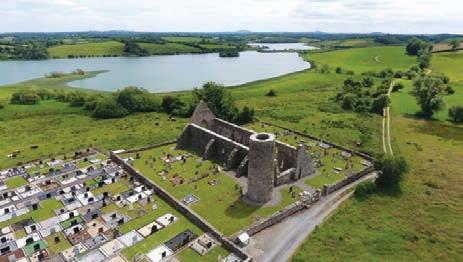
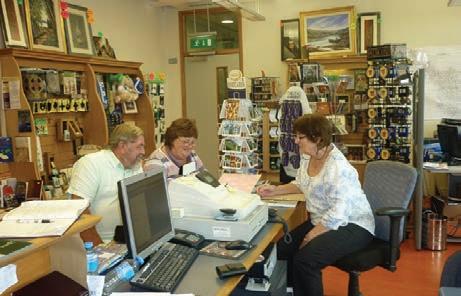

Complete returns for sixteen County Cavan parishes survive for the 1821 census. Although the originals for almost the whole country were destroyed in the Four Courts fire in 1922, the surviving sixteen for County Cavan had been copied and stored in Cavan Courthouse. Returns have survived for Annagelliffe, Ballymachugh, Castletara, Castlerahan, Crosserlough, Denn, Drumlumman, Drung and Laragh (joint returns), Kilbride, Kilmore, Kinawley, Lavey, Lurgan, Mullagh and Munterconnaught. Cavan Genealogy has computerized all surviving parishes.
The database also includes pre and post-famine land records, gravestone inscriptions, occupational directories, some school registers, and numerous other smaller sources of a genealogical nature. The center subscribes to Irish Newspaper Archives, an online database of Irish newspapers, which includes many of Ireland's leading national, regional, and out-of-print titles. It also subscribes to other genealogy websites, which allow extra research to complement the center's own resources.
The center further provides an information service for people doing historical research, writing local histories, studying various topics, carrying out graveyard surveys and cleanups, etc. Mary and Concepta have delivered numerous genealogy workshops/lectures throughout the county and held innumerable exhibitions which have traveled county wide. The center also puts people in contact with other people researching the same ancestors, always with the consent of both parties.
Email: info@cavangenealogy.ie
Phone: 00353 (49) 4361094
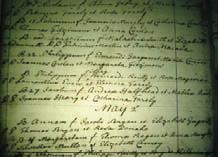

ONCE THE EDGE OF TWO WORLDS, IRELAND’S BORDERLANDS ARE NOW A BRIDGE BETWEEN THEM, WHERE LIFE MOVES AT ITS OWN UNHURRIED PACE.
Sitting on the border between Northern Ireland and the Irish Republic, the border counties of Cavan, Monaghan, Armagh, Fermanagh, and Louth have evolved into a region of connection, where history, culture, and community flow together.
Here the hills of Cavan and Monaghan roll into the glens of Armagh, with towns such as Clones and Carrickmacross bound together by lakes, backroads, and a rich creative spirit. Monaghan, at the heart of it all, rewards those who pause to explore a little further. Once famed for its delicate lace, the intricate craft was so exquisite it
was sought by royalty and leading fashion houses across Europe. That same artistry seems woven through the county itself, finding new expression in another kind of craft, the poetry of Patrick Kavanagh, born in Inniskeen, whose verses still drift through the fields and quiet lanes that shaped his imagination.
Monaghan moves at an easy pace, inviting visitors to slow down and enjoy its drumlin hills, clear lakes, and peaceful woodland trails. Lough Muckno offers boating, fishing, and scenic walks, while heritage routes and sculpture trails link towns and
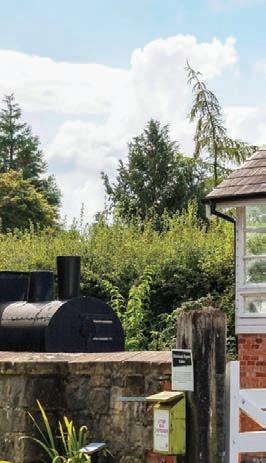

villages rich in character. With a lively arts scene and a strong sense of community, Monaghan reveals its charm to those who take the time to look a little closer.
The county also enjoys a prime position, perfectly placed between Dublin and Belfast, making it an ideal base for exploring both sides of the island. Within an hour’s drive north, you can be in Belfast or walking the tranquil shores of Lough Neagh. Head south to the heritage towns of Cavan and Meath, go west to the lake country of Fermanagh, or east toward the coast and the ancient passage tombs of Newgrange.
That same creative spirit flows north to Glaslough, one of Ireland’s prettiest villages. It grew up around the Leslie family’s grand castle estate and maintains close ties to it to this day. Many of the stone cottages were originally built for estate workers, their charm lovingly preserved with colorful paintwork, sash windows, and

stone details. The streets bloom with color from flower troughs and hanging baskets, and the village retains a timeless feel with an easy old-world charm. Glaslough has earned national acclaim as Ireland’s Tidiest Village multiple times, admired for its picture-perfect streets and strong sense of community. That pride is reflected in its heritage trail, which winds through the village and out into the surrounding countryside, passing the historic famine wall built by the Leslies to support local tenants during the 1840s, a quiet testament to the village’s resilience and pride.
It’s the kind of place that invites you to linger, and there’s no shortage of places to stay, from welcoming B&Bs to charming cottages tucked along its colorful streets. If you’re after something dramatically different, treat yourself to a castle escape at Castle Leslie, where elegance and quietly quirky come together in unforgettable style.

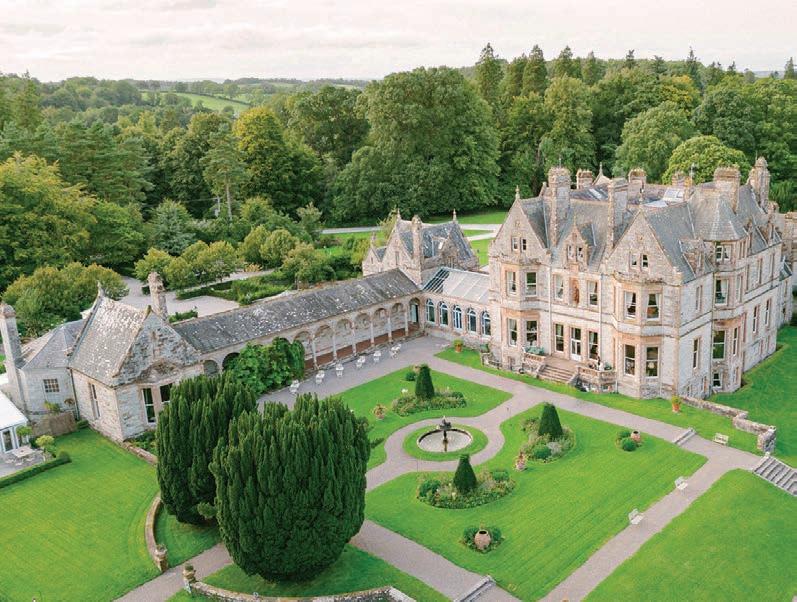
CASTLE LESLIE ESTATE IN COUNTY MONAGHAN IS NO ORDINARY CASTLE HOTEL. STILL IN THE HANDS OF ITS FOUNDING FAMILY, THIS ROMANTIC RETREAT INVITES GUESTS TO STEP INTO A WORLD OF HISTORY, BEAUTY, AND QUIET LUXURY.
There are places that feel like a retreat, and then there are places that feel like a revelation. Castle Leslie Estate is just such a place. Set amid a thousand acres of ancient woodland, glistening lakes, and green parkland, this extraordinary estate is a world apart. Only 80 minutes from Dublin and 60 minutes from Belfast, it feels hidden and secluded, yet entirely accessible.
Castle Leslie Estate has long been one of Ireland’s most sought-after destinations
for weddings, honeymoons, and romantic getaways. Its appeal lies in the perfect combination of history, atmosphere, and quiet luxury. Unlike the polished grandeur of some castle hotels, this is still a family home. The Leslie family has lived here since the 1660s, and the current custodian of the estate, Samantha Leslie, continues to keep its spirit very much alive. Staying here feels less like a hotel visit and more like stepping into a historic home, where you experience true luxury in surroundings alive with character and history.
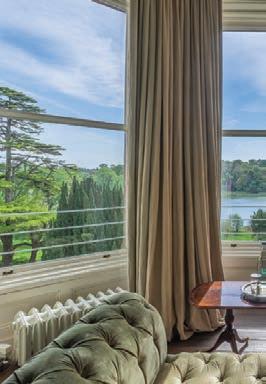


To wander through Castle Leslie Estate is to step into a living chapter of Ireland’s heritage. The house brims with original antiques, family heirlooms, and treasures that reflect its long lineage. In the library, shelves are stacked high with leatherbound volumes, while the Drawing Room holds some of its most fascinating pieces. Here, Sir Winston Churchill’s christening gown is carefully preserved alongside one of his childhood garments, and a centuryold Bechstein grand piano chosen by Lady Leonie Leslie still anchors the room, a reminder of evenings filled with music. These are the kinds of relics you might expect to find in a museum, yet here they feel entirely at home, woven naturally into their surroundings.
That is what makes the estate so enchanting. The Leslie family history may stretch back for centuries, yet the house feels alive, with roaring fires and staff who welcome guests as though they were part of the family. It is no surprise that the estate has been voted one of the best places to work in Ireland and one of the best places to stay, a reflection of the warmth and pride that shines through in every guest experience. It is this balance of splendor and intimacy that makes a stay at Castle Leslie Estate truly remarkable.
Castle Leslie Estate has earned its reputation as one of Ireland’s most romantic destinations. Couples come here to celebrate engagements, honeymoons,
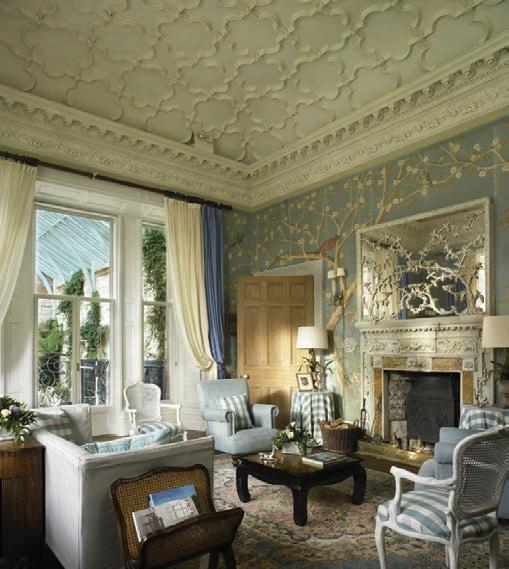
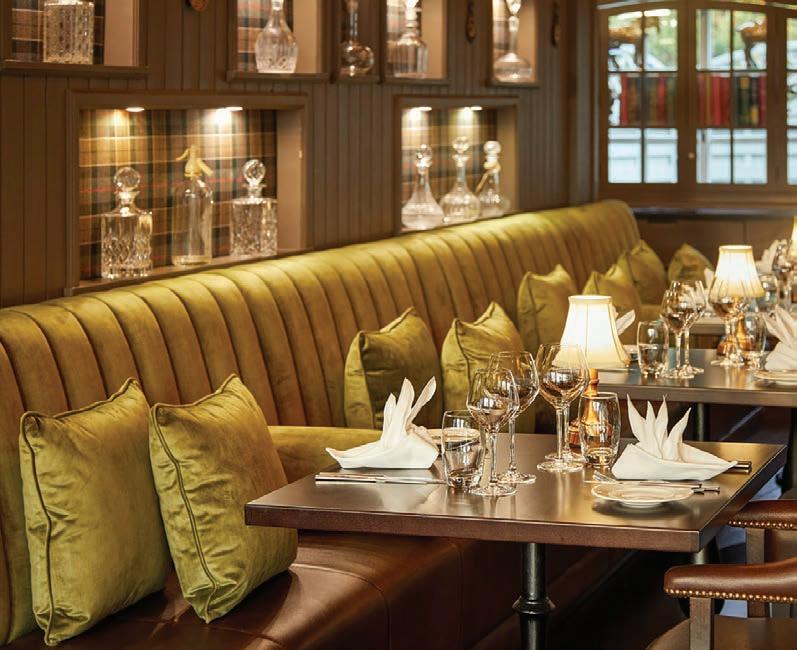
anniversaries, or simply the joy of time together. It is no wonder that celebrities have also been drawn to its magic. Sir Paul McCartney married here, as did Pretty Little Liars star Sasha Pieterse, who tied the knot with Hudson Sheaffer. Celebrity stylist and TV personality Anthony Pazos, known for his work with Beyoncé, also chose the estate for his wedding. Add to that past visits from famous guests like Mick Jagger, and it is clear that Castle Leslie Estate has long held a magnetic pull for those in search of romance and privacy.
The estate’s sweeping views, stately interiors, and lakeside Pavilion create a remarkable backdrop for weddings of every style. Civil ceremonies, blessings, and traditional church services can all be arranged, with the entire estate available for exclusive use to ensure complete privacy.
Honeymooners and guests staying on will find plenty to enjoy. The estate offers boating on Glaslough Lake, fishing, falconry, archery and clay target shooting, along with a world famous equestrian
center and indulgent treatments in the spa
The Victorian Treatment Rooms. For many, though, the greatest luxury lies in slowing down, lingering over wine on the terrace, wandering the pleasure garden, or simply watching swans glide across the lake.
Whether attending a wedding, marking a special occasion, or simply enjoying a short escape, most guests find little reason to leave the estate during their stay. Conor’s Bar at The Lodge is the lively heart of the estate offering a warm
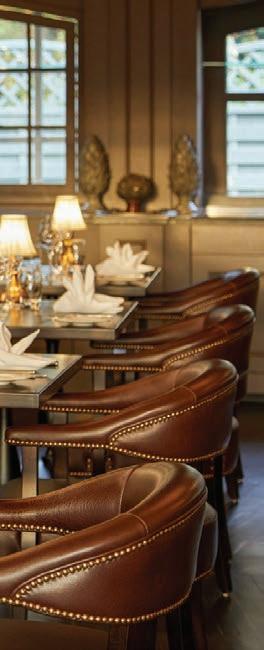
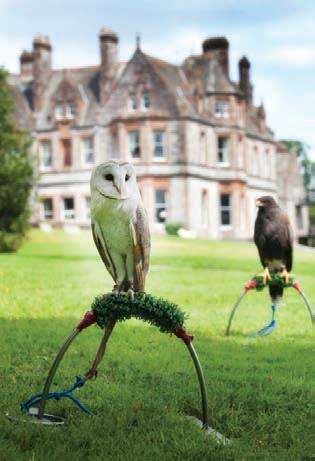
and relaxed setting for drinks and casual dining. For a more refined experience, Snaffles Restaurant serves award-winning fine dining beneath its dramatic vaulted ceiling, with an extensive drinks menu featuring a wide range of gins, including the estate’s own signature The Fighting Bishop gin, alongside expertly crafted cocktails. Guests can enjoy casual dining in Conor’s Bar & Lounge with traditional country home cooking. With a variety of dishes served throughout the day, there’s something to suit all guests from hungry horse-riders and ravenous walkingenthusiasts to health-conscious guests on a breather between treatments at The Victorian Treatment Rooms.
Wining and dining are only part of the experience, as the estate’s accommodations are every bit as distinctive as its cuisine. The castle’s twenty-one bedrooms are as individual as the estate itself, each one brimming with personality and uniqueness. Guests can stay in The Mauve Room, where Mick Jagger once laid his head, or The Red Room, chosen by Sir Paul McCartney for its views and history. The Red Room boasts the first bath ever installed at Castle
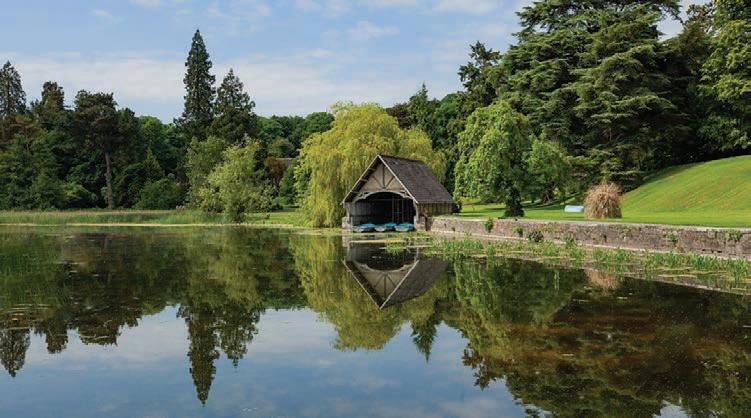
Leslie along with a decorative throne toilet, wood-paneled and bearing the Leslie coat of arms. Other rooms feature four-poster beds, claw-foot tubs, and sweeping lake or woodland views. None of the castle rooms include televisions, a deliberate choice meant to invite guests to disconnect from the modern world and sink into the stillness of the estate.
For those who prefer a different kind of stay, the estate offers additional accommodation in The Old Stable Mews and in the ivy-clad Lodge. Formerly known as The Hunting Lodge, it was repurchased by the Leslie family in 2004 and restored to its former glory, retaining its period features and original character. With fifty beautiful bedrooms, it blends sumptuous decor with striking artwork and generous proportions. Some rooms offer private patios or balconies overlooking the equestrian center or courtyards. The Lodge also houses the spa, known as the Victorian Treatment Rooms, outdoor hot tubs, and the stables, adding layers of indulgence to every stay.
Despite its reputation, Castle Leslie Estate retains the feel of a hidden gem. Perhaps it is the location in County Monaghan, a county often overlooked by international visitors yet filled with charm. Perhaps it is the fact that the estate remains in family hands, giving it a sense of continuity and authenticity that many luxury venues lack. Or perhaps it is simply the atmosphere, that intangible blend of history, beauty, and warmth that leaves every guest feeling rejuvenated.
Visitors often remark that a stay at Castle Leslie Estate is unlike any other. It is not just the antique-filled interiors, the expansive grounds, or the impeccable service, but the sense that you are stepping into something surreal. To arrive here is to leave the ordinary behind. To stay is to experience Ireland at its most authentic. Castle Leslie Estate is not just a destination but a retreat where each guest becomes, in some small way, part of its ongoing narrative.
For further details and to view their array of overnight packages, visit: www.castleleslie.com +353-4788100
E: info@castleleslie.com


Conor’s Bar captures the essence of an authentic Irish pub with rustic décor, stone floors, and cozy seating - the perfect spot to unwind with friends and family.
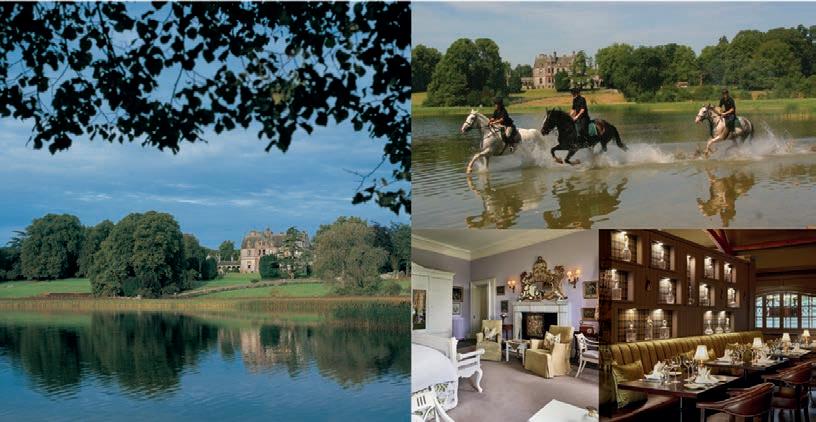
Nestled on 1,000 acres of undulating Irish countryside, dotted with ancient woodland and glittering lakes, Castle Leslie Estate is one of the last great Irish estates still in the hands of its founding family. Steeped in history, full of character and charm, it is the ultimate Irish rural escape.
Only 80 minutes from Dublin and 60 minutes from Belfast, Castle Leslie Estate boasts a variety of accommodation and activities to suit all tastes. The Castle, at the heart of the Estate, offers authentic original interiors and old-style hospitality and is a complete respite from the world. The Lodge is the social hub of the Estate, a country house boutique hotel that brings locals and guests together in an atmosphere of conviviality and comfort. The Old Stable Mews are the perfect spot for groups that want the convenience of hotel living combined with private luxury home rental.
Castle Leslie Estate offers an idyllic setting for outdoor activity and adventure. A host of activities are on offer including pike fishing for the nature enthusiast, exceptional walking trails for those who want to breathe in fresh country air, archery and clay target shooting for the more adventurous, falconry for those to experience nature up close, a fabulous spa for rejuvenation and of course the famous worldclass equestrian centre - just some of the choices that await you in this hidden corner of Ireland.

At Loughcrew Estate, we believe that every love story is unique and deserves to be celebrated in a way that reflects its individuality. Whether you dream of an intimate gathering or a grand celebration, we offer a variety of tailored wedding options to suit your preferences and guest count.

Banquet Room
Elegant event space - for 20 to 120 guests
Intimate Weddings
The Millhouse - for up to 24 guests
St Oliver’s Church
Embrace nature in history - for up to 120 guests
Outdoor Weddings
Size dependent on marquee hire, and imagination
Loughcrew Estate
Accommodating 30 guests overnight



FROM STATELY CASTLES AND CANDLELIT CHAPELS TO ANCIENT CELTIC RITUALS AND LIVELY CÉILÍ DANCING, IRELAND OFFERS DESTINATION WEDDING COUPLES A CELEBRATION LIKE NO OTHER.
For couples dreaming of a destination wedding, few places on earth capture the imagination like Ireland. A land of sweeping scenery, warm welcomes, and timeless traditions, it offers not just a setting for a wedding but an experience that feels like stepping into a story. From timeless country estates to charming manor houses, Ireland has become a sought-after place for couples who want to say “I do” in a way that blends romance with unforgettable atmosphere.
Yet what really sets an Irish wedding apart is more than its backdrops. It is the way old traditions and heartfelt rituals weave their way into the modern-day celebration, giving couples and guests a sense of being part of something unique and timeless.
Imagine gathering loved ones in a castle with ivy-covered walls or exchanging vows beside a tranquil lake as wild ponies graze in the distance. Ireland is filled with venues that feel both intimate and grand, whether it is a stately Georgian townhouse, a rustic country estate, or a coastal retreat.
Ireland is also perfect for couples seeking something a little more offbeat. Some venues come with their own chapel on site, while others offer elegant conservatories, cliffside terraces, or banquet halls that turn a wedding into a medieval experience. For those drawn to the unusual, lighthouses along the Atlantic coast, ancient ruins in the countryside, or private islands,
Ireland offers so many options that feel adventurous as well as romantic.
The beauty of choosing Ireland is the variety. Couples can tailor their celebration to fit their style, whether they prefer a multi-day experience or a quiet elopement surrounded by timeless scenery. The value of the strong US dollar against the euro also makes the dream of an Irish wedding surprisingly attainable, often more affordable than similar celebrations at home.
An Irish wedding is defined by the details. These are the touches that give the day its unique magic and provide moments that guests will remember long after the last song has been played.
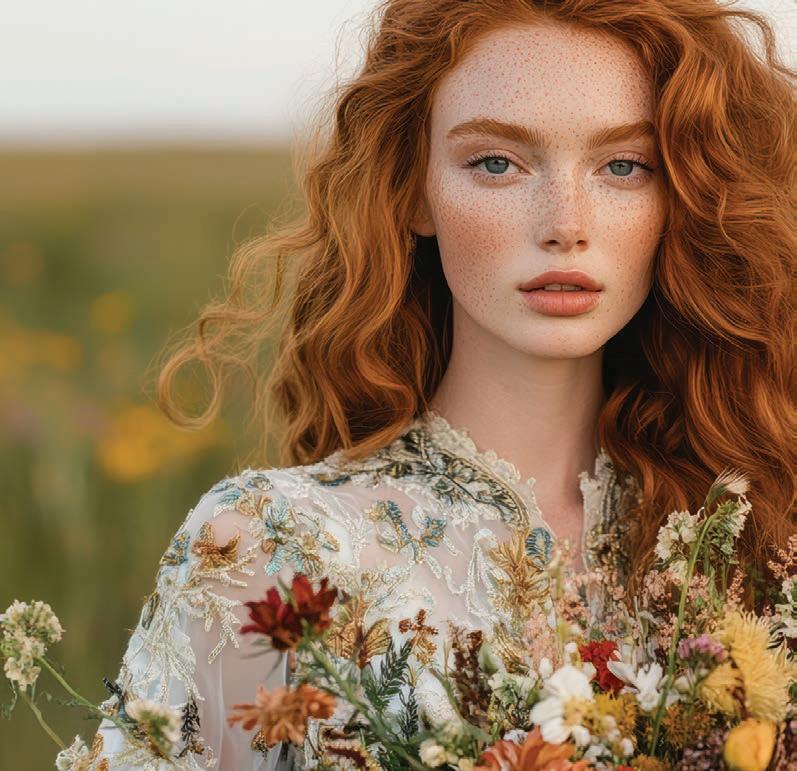
One of the most cherished traditions is the handfasting ceremony. Dating back to ancient Celtic times, the ritual involves binding the couple’s hands with ribbon or cord, symbolizing their union. It is believed to be the origin of the phrase “tying the knot.” Today, couples often choose cords in their wedding colors, weaving in charms or symbols of personal meaning, which makes the ritual a highlight of the day.
Another tradition is the Claddagh ring, which originated in Galway over 300 years ago. Its design of two hands holding a crowned heart represents friendship, loyalty, and love. Many couples exchange Claddagh rings or incorporate them into their ceremony as a symbol of enduring commitment.
Music also plays a central role. Traditional musicians with fiddles, harps, and
bodhráns bring a distinctly Irish sound to the celebration. Whether played as the bride walks down the aisle or later during the reception, music connects guests with Ireland’s cultural heartbeat. And no Irish wedding is complete without a céilí, a lively dance where guests are encouraged to join in. Even if no one knows the steps, the fun of learning together fills the night with laughter.

No celebration is complete without food and drink, and Irish weddings are a feast in every sense of the word. Chefs create menus that showcase the best of Irish produce, from freshly caught Atlantic salmon and oysters to farm-reared lamb and garden vegetables. Farm-to-table dining is not a trend in Ireland, but a way of life, so couples will find their wedding meal as memorable as the setting.
Drinks flow just as generously. A champagne toast may be followed by glasses of Guinness raised high, or a round of Irish whiskey offered in place of the traditional shot. Whiskey tastings are increasingly popular as part of the wedding celebration, with distilleries from Jameson to boutique craft producers adding a distinctly Irish flavor to the event. Guests often remark that these simple touches become standout moments.
Sweet traditions also linger. Some couples serve a rich Irish whiskey fruitcake as their wedding cake, a nod to the past, while others offer guests miniature bottles
of whiskey or local honey as favors. Whatever the choice, food and drink at an Irish wedding are not just about sustenance but about storytelling, a way of sharing Ireland’s bounty and warmth with every guest.
Ireland’s deep well of folklore has always found its way into weddings. Many couples choose to incorporate lucky charms or follow old customs thought to bring good fortune.
Horseshoes, for example, are a traditional Irish symbol of luck. Brides once carried real horseshoes down the aisle, though today they are often given as keepsakes or worked into the décor. The important part is that the horseshoe is always kept upright so the luck does not ‘spill out’.
Another popular tradition is the wedding bell. In the past, guests would give bells as gifts to help couples settle any disputes. Today, a small bell often sits on the table, a reminder of the old saying that “the sound of a bell chases away discord.”
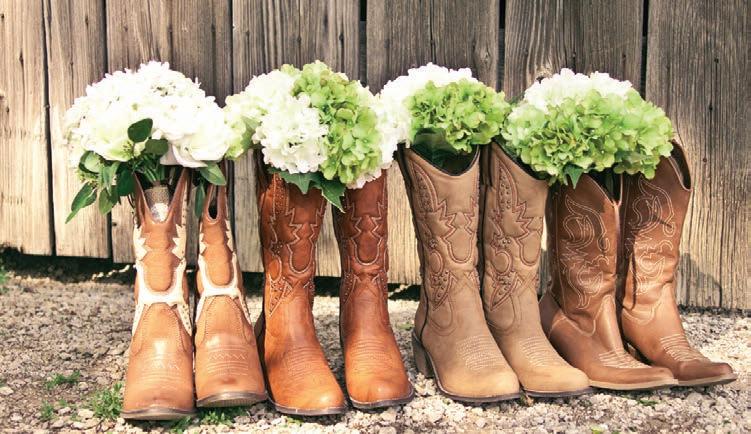
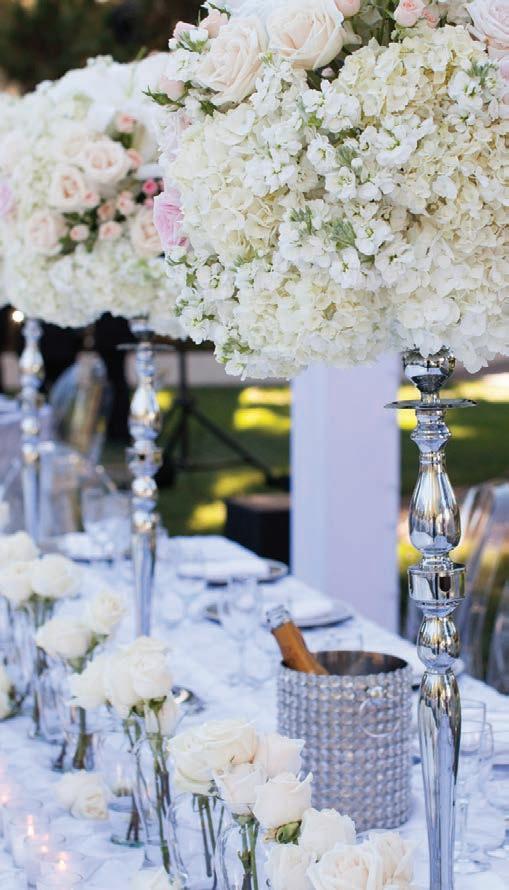
Many couples also embrace the Irish love of poetry and blessing. The traditional Irish wedding blessing - “May the road rise to meet you, may the wind be always at your back” - is often read during ceremonies, creating a heartfelt moment that resonates across generations and cultures.
Destination weddings in Ireland usually become more than just one day. Couples and their guests turn the event into a multiday celebration filled with adventures that create shared memories. A rehearsal dinner might be held in a local pub with live music and dancing. The day after the wedding, guests may take a trip offsite or onsite there might be food tucks, activities, or even hot air ballooning. For couples, this means that their wedding is not just a ceremony but a fully immersive Irish experience. Families bond over shared discovery, and friends leave with memories that stretch far beyond the wedding itself.
At the heart of it all is the Irish welcome. Hospitality is second nature here, and venues go out of their way to make couples and guests feel the “Céad míle fáilte" - a hundred thousand welcomes. The food is fresh and locally sourced, the landscapes are cinematic, and the Celtic traditions are as meaningful as they are beautiful.
An Irish wedding is more than a celebration of love. It is a journey into a culture that honors connection, heritage and joy. So, when the question is where to hold the wedding of a lifetime, the answer lies in a place where ancient traditions meet modern celebrations. Ireland is not just a destination; it is a love story waiting to be written.
The beauty of choosing Ireland is the variety. Couples can tailor their celebration to fit their style,
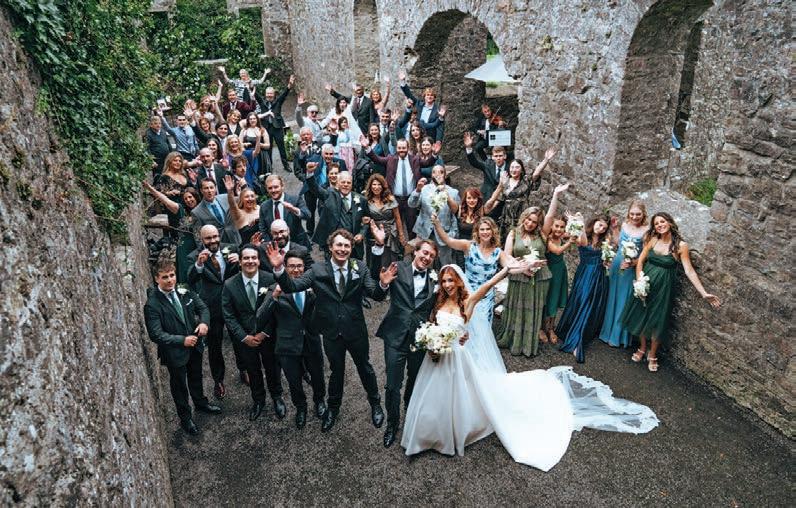
AN EXCLUSIVE GEORGIAN ESTATE IN IRELAND’S ROYAL COUNTY, LOUGHCREW COMBINES HISTORY, INTIMACY, AND NATURAL BEAUTY, GIVING U.S. COUPLES THE RARE CHANCE TO MAKE IRELAND ENTIRELY THEIR OWN.
For American couples dreaming of Ireland, the appeal is timeless: fairytale castles, dramatic landscapes, and stories etched into every stone and sacred site. Yet not every couple wants a grand, impersonal castle or a one-size-fits-all package. That is where Loughcrew Estate stands apart. Just an hour from Dublin, this exclusive Georgian estate offers history, elegance, and natural beauty on an intimate scale, giving couples the rare gift of having an authentic piece of Ireland all to themselves.
To understand why Loughcrew Estate is so perfectly suited for destination weddings, you have to appreciate the layers of history that shape its land. Located in County Meath, known as Ireland’s “Royal
County,” it was once the seat of Ireland’s earliest High Kings and remains home to sacred valleys and some of Europe’s oldest archaeological treasures.
At the heart of the estate stands Loughcrew House, a Georgian country home surrounded by 200 acres of parkland, gardens, and woodland. Unlike some larger castle venues that can feel grand but impersonal, Loughcrew radiates intimacy. Its scale is human, its atmosphere warm, offering couples the rare sense of stepping into their own private world.
The estate also carries echoes of Ireland’s mythic past. Nearby rise the Loughcrew Cairns, Neolithic passage tombs older than the Egyptian pyramids. Known as
Slieve na Calliagh, the Hill of the Witch, these ancient monuments stand like guardians of time, connecting the estate to Ireland’s deeper story of love, life, and continuity.
And on the grounds themselves lies one of Loughcrew’s most extraordinary treasures: the ruins of St. Oliver Plunkett’s Church, more than 400 years old. Its weathered stone walls carry the story of Ireland’s martyred saint and last Catholic Archbishop of Armagh before the penal era. To exchange vows here is to stand in the midst of Irish history, where faith and resilience have endured for centuries. It is one of the most meaningful and soughtafter ceremony sites for couples coming from abroad.
For U.S. couples, Loughcrew offers everything a destination wedding should be: authentic, intimate, and flexible.
From its Georgian house and antiques to open fires, walled gardens, and the ruins of St. Oliver Plunkett’s Church, Loughcrew feels like living heritage rather than a staged attraction.
The estate is designed for small to medium weddings, giving couples exclusive use of 200 acres of parkland and gardens. It is private, personal, and never shared with other events.
Whether the ceremony takes place in ancient ruins, blooming gardens, or elegant rooms indoors, every detail can be tailored with the estate’s team. No fixed packages, no one-size-fits-all, just a celebration that feels uniquely your own.
Guests arrive along winding country lanes, past fields bordered by ancient stone walls. As they approach, the Georgian façade of Loughcrew House appears, framed by sweeping lawns and woodlands. The welcome is immediate and the sense of wonder unmistakable.
Wedding parties often stay on the estate, where period charm meets modern comfort. On the morning of the wedding, the day begins with birdsong in the gardens and mist rising over the hills. Vows may be exchanged in the hauntingly beautiful ruins of St. Oliver Plunkett’s Church or outdoors among the walled gardens, scented with roses and lavender.
The reception might unfold inside Loughcrew House, with its dining and drawing rooms set for feasting, music, and dancing, or in a marquee on the lawns for larger gatherings. Irish cuisine, paired with fine wines and whiskeys, delights guests with flavors of the land: lamb, salmon, and seasonal produce. As night falls, music carries onto the lawns, where traditional Irish fiddles and American classics blend beneath a canopy of stars.

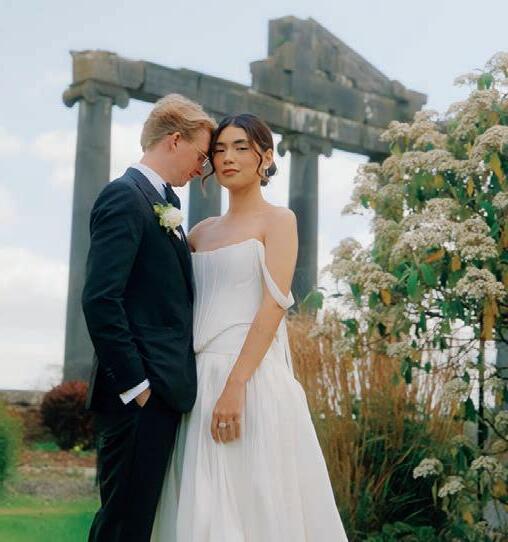
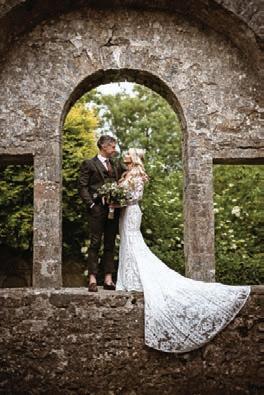

What makes Loughcrew unique is that it is not simply a venue but a world of its own, one that couples and their guests inhabit fully during their stay.
The essence of Loughcrew lies in its balance of intimacy and grandeur, history and hospitality, myth and modern comfort. Couples step into a story larger than themselves while celebrating in a way that feels deeply personal. For Americans dreaming of Ireland, Loughcrew embodies everything that draws them here: romance, tradition, beauty, and belonging. It is not just a venue. It is a home for love stories.
In a world where weddings can sometimes feel fleeting, Loughcrew Estate offers something lasting. To marry here, whether in the gardens, the Georgian house, or the ruins of St. Oliver Plunkett’s Church, is to weave your own love story into the fabric of Ireland’s timeless landscape.
For U.S. couples seeking a destination wedding that is intimate, unique, and steeped in authenticity, Loughcrew is more than a choice. It is an invitation to step into Ireland’s spirit, celebrate with those who matter most and begin married life in a place where love has always been at home.
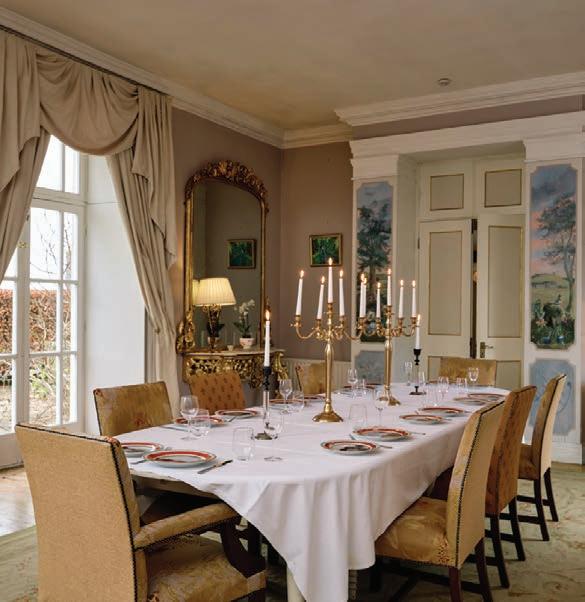
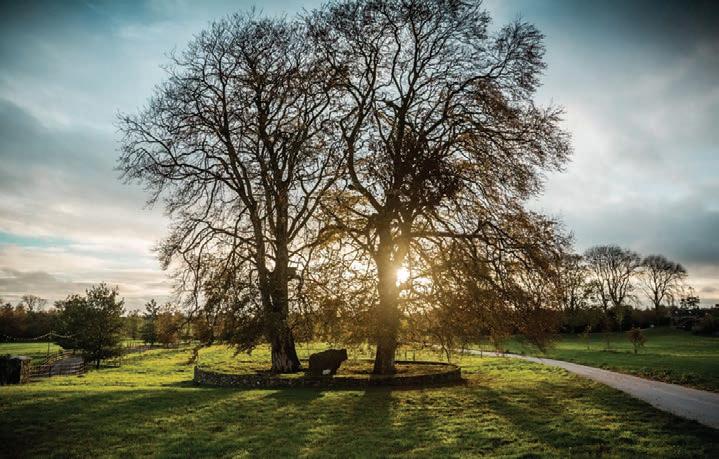
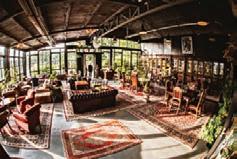




IF YOU DREAM OF TYING THE KNOT IN THE VERDANT IRISH COUNTRYSIDE, SURROUNDED BY ANCIENT TREES, VINTAGE CHIC AND ONE-OF-A-KIND CHARM, MOUNT DRUID IN COUNTY WESTMEATH IS WAITING TO CAPTURE HEARTS AND IMAGINATIONS WITH ITS QUIRKY BEAUTY.
The 100-acre private estate, tucked away in the pretty village of Castletown Geoghegan, offers a truly unique wedding experience for couples seeking out an experience that’s authentic, unforgettable and sprinkled with just a little bit of Irish magic. And at just over an hour from Dublin, getting there is a breeze for your guests.
At Mount Druid, everything feels like a scene from a romantic novel. Say “I do” in the venue’s iconic Tin Chapel, a whimsical, unconsecrated chapel peeping out from amongst the pines, with seating for up to 180 guests. After the ceremony, guests can stroll through the grounds
to the Boathouse, a warm and artfully furnished lakeside venue, complete with antique decor and inviting cozy seating.
A lakeside deck invites guests to enjoy drinks and canapés whilst watching a glorious sunset settle over the waters.
The Boathouse’s wood-burning pizza oven, situated in its own glazed kitchen, transforms the space into an informal dining space where your guests can be entertained on your wedding’s eve, or the day following the ceremony.
Your reception takes place in the beautifully converted Barn - stepping into the light-filled space is to step into another, gentler age. A grand piano sits,
waiting to entertain your guests as they arrive, whilst the Jacobean library tempts them to relax amid an abundance of soft furnishings. Wander through the Arts and Crafts wallpapered entrance to the magical Garden Room and linger by the wood-burning stove where the charms of the restored walled garden can be viewed. Whether you’re planning a laid-back BBQ or a multi-course formal seated dinner, the space easily transforms to match your vision.
What makes Mount Druid especially attractive to American couples is its authentic Irish character and deep connection to nature. The venue is owned
by the Murphy family, who hold a deep affinity with the nature and heritage of their land. As well as running an organic sheep farm on the site, they have planted more than 300,000 trees over the years. Sustainability and beauty go hand in hand here, and are evident in every corner of the estate, from the organic food grown in the rich soil to the wood that crackles in the glowing fires.
The accommodation is just as unique as the venue itself. Guests can choose from cozy shepherds' huts, tin huts, luxurious yurts, or charming restored cottages. For those who prefer more traditional comforts, the restored 19th-century Kindalin House and Forge Lodge offer warm, welcoming spaces with all the modern amenities.
Whether you’re planning a destination wedding in Ireland or looking for a oncein-a-lifetime venue with heart and soul, Mount Druid delivers an unforgettable celebration with a distinct Irish twist. It’s a place where vintage chic meets wild beauty, and where your love story becomes part of the landscape.
Interested in learning more or booking your dream Irish wedding? Visit www. mountdruid.ie to start planning.
A truly unique wedding experience for couples seeking out an experience that’s authentic, unforgettable and sprinkled with just a little bit of Irish magic.

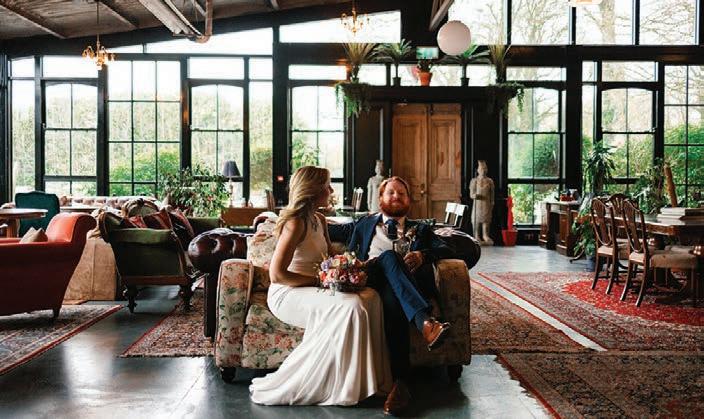

SANDBROOK HOUSE & GARDENS IN COUNTY CARLOW OFFERS A UNIQUE AND CHARACTERFUL VENUE FOR WEDDINGS AND SPECIAL FAMILY GATHERINGS. THIS PERIOD HOUSE IS RICH WITH CHARACTER, CLASSIC YET GLORIOUSLY QUIRKY, GRAND YET WONDERFULLY INTIMATE.
Set on the Wicklow–Carlow border, Sandbrook is a handsome Queen Anne–style country house dating back to the early 1700s. It sits on twenty-five acres of mature parkland, framed by views of Mount Leinster and the Wicklow Mountains. From the moment guests arrive, it feels more like a welcoming home than a formal venue. That sense of warmth is intentional. Owners Christopher and Bella Bielenberg live at Sandbrook, and the care they have poured into restoring and styling the property is evident in every detail.
Bella’s background in interior design and together with her love of textiles and antiques, the interiors have a layered, personal feel. Christopher’s eclectic art
collection adds a worldly touch to the traditional Georgian architecture. The result is a house that feels refined yet relaxed, where weddings flow as naturally as a weekend with family.
Sandbrook adapts beautifully to weddings of every size and style. The house can sleep up to twenty-seven guests, with capacity extended to thirty-one when the newly renovated loft apartment is included. Inside, five interconnecting reception rooms on the ground floor provide a graceful flow for ceremonies, drinks receptions, and dancing. Upstairs, the bedrooms are individually styled, each offering charm and comfort.
The grounds are equally versatile. Couples can exchange vows in the gardens, celebrate with cocktails on the covered terrace, or host a marquee reception on the lawn. A converted stable barn loft, opening on to the gardens, is perfect for rustic-chic gatherings and tempts guests out to stroll through fragrant flower beds. Because the estate is licensed for civil ceremonies, couples can keep every part of their celebration on site, eliminating the need to move guests between venues.
Sandbrook distinguishes itself through atmosphere. Every corner feels authentic and lived in, rather than polished to uniformity. Reception rooms are filled with antiques, art, and carefully chosen
furnishings. The drawing room invites laughter and toasts, while the library provides space for quiet conversations. Outside, the gardens set a romantic backdrop for photographs and evening strolls. Rose beds and paddocks stretch as far as the eye can see, where horses graze in view of the mountains.
A wedding feast at Sandbrook is designed to be as memorable as the setting. Menus are crafted with locally sourced produce, blending beloved Irish flavors with a refined modern twist. Guests can dine beneath chandeliers in the elegant dining rooms or enjoy a more relaxed buffet in the barn loft. Hospitality is at the heart of the experience. The in-house chef and team ensure that every detail, from table settings to wine pairings, reflects the couple’s vision. Guests frequently remark on the seamless balance of formality and friendliness, where service feels polished yet never stiff. The rustic bar is a charming place to slack the thirst, and couples can choose to order a keg or two in advance for their guests.
Intimacy and exclusivity are central to Sandbrook’s appeal. When couples book the estate, the house is theirs alone. There are no competing events or shared
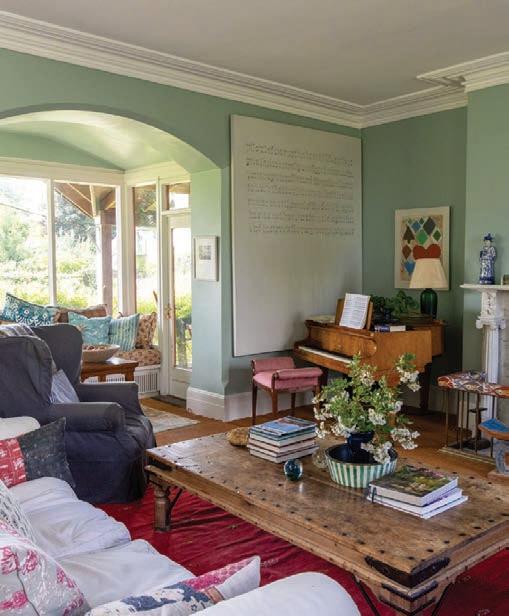


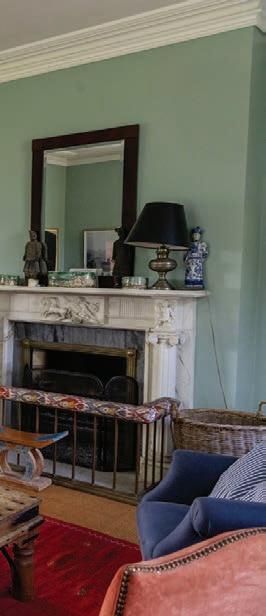


spaces. Celebrations unfold at their own pace, shaped by personal choices rather than rigid schedules.
Exclusivity is paired with genuine support. The Sandbrook team works closely with couples, offering guidance on florists, caterers, décor, and logistics. Their local knowledge and attention to detail allow couples to focus on the joy of the day rather than the stress of planning.
For destination weddings, accessibility is another advantage. Sandbrook feels wonderfully secluded, yet it is just over an hour from Dublin Airport, making it remarkably easy for U.S. couples and their guests to reach. The estate offers a delight of scenic and sporting opportunities on its doorstep, including several championship golf courses within easy reach.
Guests often describe their time at Sandbrook as “relaxed elegance.” Fires crackle in the hearths on cool evenings, books line the shelves, and chickens wander the grounds, laying tasty eggs for your breakfast. Children play hide and seek in the gardens while adults linger over wine on the terrace. That sense of lived-in comfort makes the grandeur of the setting even more inviting; it creates an atmosphere where guests can truly relax and celebrate. The ceremony, the photographs, the meal, and the dancing flow naturally from one space to another, indoors and out. Couples often find this blend of indulgence and intimacy to be the most memorable part of their day.
Sandbrook House is more than a venue. It is a home with history, character, and soul, where beauty and atmosphere meet
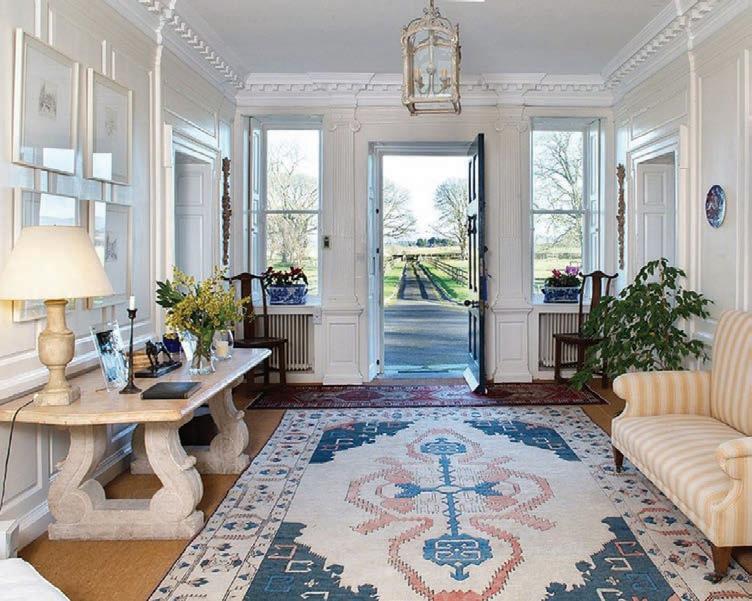
genuine exclusivity. For couples seeking a destination wedding in Ireland, it offers all the romance they dream of without the impersonal feel of larger properties. The magic is found in the details: the thoughtful restoration, the care of the hosts, and the sense that each celebration adds to the estate’s story.
Practicality is another strength. With accommodations for more than thirty guests on site, a wedding easily becomes a full weekend gathering. Friends and family can come together the night before, settle into the rhythm of the house, and linger on the day after. What might otherwise pass in a blur unfolds instead as a shared experience of connection and joy.
At the heart of every celebration at Sandbrook is the sense that it belongs entirely to the couple. This is not a staged backdrop, but a living house where every gathering feels authentic. From the sweeping approach up the drive to the final dance beneath the chandeliers, the setting elevates each moment.
Sandbrook House & Gardens is not just a backdrop but a partner in celebration, shaping memories that couples and their guests will treasure for a lifetime. For those seeking a destination wedding in Ireland that blends timeless charm with modern comfort, exclusivity and warmth, Sandbrook is an unforgettable choice.
The balance of grandeur and intimacy is what couples fall in love with. A wedding at Sandbrook never feels staged. It feels personal - a celebration wrapped in history, comfort, and individuality.
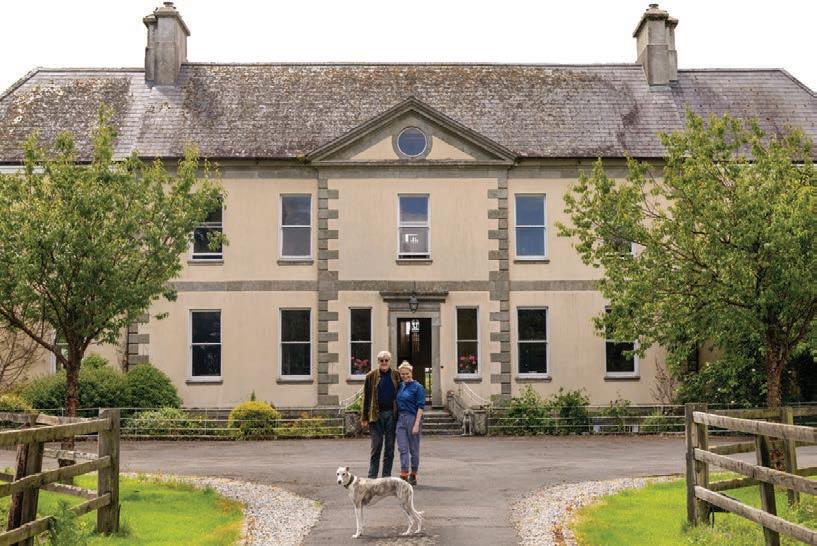
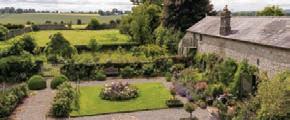


When you book your intimate dream wedding at Sandbook House, the entire estate is yours for the duration of your celebration. Built in the early 1700s with reaching views to Mount Leinster and the Wicklow mountains, Sandbrook House offers five interconnecting reception rooms, covered terrace, expansive lawns and 25 acres of lush parkland. The beautiful house, with its eclectic mix of antique and contemporary interior design, sleeps 27 people, within ten bedrooms. We offer a range of bespoke packages to ensure your wedding is as unique as your love story.



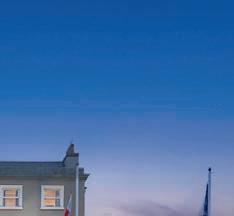





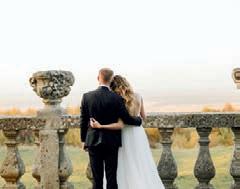

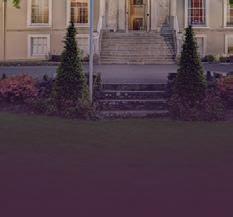







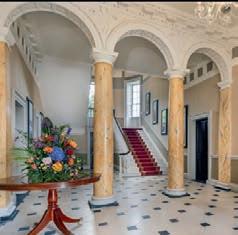






AN HISTORIC WEDDING VENUE LIKE NO OTHER, WOODSTOCK HOUSE AT DRUIDS GLEN HOTEL & GOLF RESORT COMBINES GEORGIAN GRANDEUR WITH MODERN LUXURY, OFFERING COUPLES A TIMELESS BACKDROP FOR A DAY THEY WILL NEVER FORGET.
Set amidst the breathtaking grounds of Druids Glen Hotel & Golf Resort, Woodstock House is a beautifully restored late Georgian country house dating back to the 18th century. Overlooking the famed Druids Glen Golf Course, the majestic Wicklow Mountains, and the glistening Irish Sea, it offers spectacular views from every angle, creating an unforgettable backdrop for weddings.
The house itself is steeped in history and elegance. Lovingly restored, it retains all the charm of its Georgian heritage while blending seamlessly with the comforts of modern luxury. Guests are welcomed into an atmosphere of sophistication, romance, and warmth from the moment they arrive.
With nine individually designed and luxurious guestrooms, Woodstock House
provides an intimate setting ideal for both elegant receptions and smaller, more personal ceremonies. Each space within the house tells its own story, from the enchanting rooftop terrace with panoramic views, to the charming bar perfect for pre-celebration toasts, to the beautifully appointed drawing room that radiates old-world character.
The dining rooms, adorned with chandeliers, marble accents, and period features, provide a magnificent setting for wedding meals. At Woodstock House, menus highlight the best of Irish cuisine, crafted to showcase local flavors while adding a sense of grandeur and sophistication to the celebration.
What makes Woodstock House truly special is its ability to feel both grand and personal. Whether couples envision
a lavish wedding with every detail or an intimate gathering with just their closest family and friends, the venue adapts effortlessly. The dedicated wedding team at Druids Glen works with each couple to ensure the celebration is seamless, stressfree, and tailored to their vision.
Woodstock House is more than a venue. It is a storybook setting where history, beauty, and romance intertwine. From sweeping views outside to refined interiors within, every element comes together to create an extraordinary stage for a wedding day. Each celebration becomes part of the continuing history of Woodstock House - a place where memories are not just made but cherished forever.


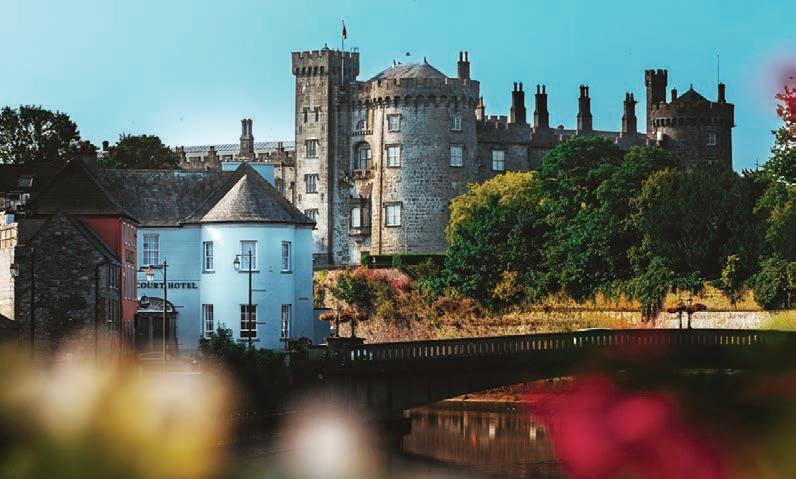
A FAIRYTALE WEDDING AT THE BRIDGE HOUSE IN KILKENNY BRINGS HISTORY, ROMANCE, AND IRISH CHARM TOGETHER, OFFERING COUPLES FROM NEAR AND FAR A DESTINATION CELEBRATION THAT FEELS TIMELESS AND UNFORGETTABLE.
For couples dreaming of a destination wedding with a touch of magic, Ireland has long held a special allure. At the heart of that dream is The Bridge House at the River Court Hotel in Kilkenny, a venue that blends historic charm with modern elegance.
Once a traditional Irish townhouse, The Bridge House now stands proudly on the banks of the River Nore, directly overlooking the medieval splendor of Kilkenny Castle. Its walls have borne witness to centuries of life unfolding across the river, from bustling market days to royal visits. Today, it gives couples the opportunity to write their own chapter in a setting filled with echoes of the past.
What truly sets this venue apart isn’t just the view. Guests arriving from across the Atlantic are instantly immersed in
the atmosphere of Kilkenny, Ireland’s medieval capital. Cobblestone streets, lively pubs, and centuries of history surround the hotel, offering an authentic Irish experience at every turn. The River Court Hotel’s dedicated wedding team weaves these elements seamlessly into each celebration, ensuring every detail from décor to dining reflects both the couple’s personal style.
Food and drink are central to any Irish gathering, and weddings at The Bridge House are no exception. Menus feature locally sourced produce, presented with a modern twist on traditional Irish flavors, ensuring a dining experience that is every bit as memorable as the setting.
Practicality is also part of the appeal. Kilkenny’s location, just ninety minutes from Dublin Airport, makes it simple for
overseas guests to reach, yet it feels like a world away from the bustle of the capital. Whether planning an intimate gathering or a larger celebration with family and friends, the venue offers flexible spaces and bespoke packages designed to bring each couple’s vision to life.
For couples seeking not just a venue but a wedding steeped in beauty, character, and heart, The Bridge House at the River Court Hotel delivers. It is a place where history and romance meet, and where memories created will last a lifetime.
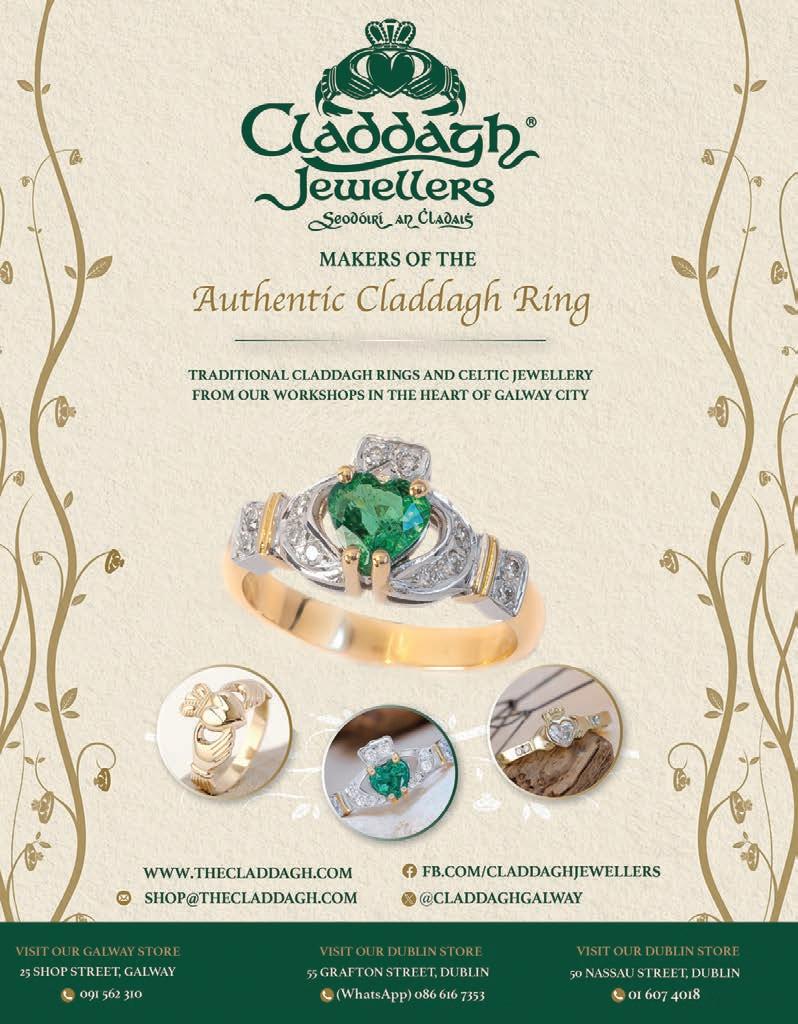

A WEDDING BAND IS AN UNBROKEN CIRCLE OF LOVE THAT BEGAN LONG BEFORE AND WILL CONTINUE LONG AFTER THE WEDDING DAY ITSELF.
Few symbols carry as much meaning as the wedding ring. A simple band of precious metal, it is both universal and deeply personal, its circular form representing eternity, wholeness, and the endless nature of love. Exchanging rings has become one of the most recognized rituals worldwide, yet the tradition goes back thousands of years.
The practice is thought to have originated with the ancient Egyptians, who saw the circle as a sacred symbol of eternal life and love. They placed the ring on the fourth finger of the left hand, believing it contained the “vena amoris,” or vein of love, that ran directly to the heart.
The Romans adopted the custom, and it spread through Europe and beyond, becoming one of the central moments of a wedding ceremony.
In Ireland, wedding rings have long carried both symbolism and story. The Claddagh ring is perhaps the most famous example. Its motif of hands, heart, and crown represents friendship, love, and loyalty. As a wedding ring, the Claddagh is worn with the heart turned inward on the left hand, binding it to one person forever. Today, couples around the world choose Claddagh wedding bands as a nod to Irish heritage and its enduring message.
Celtic-inspired designs are also popular, often featuring the spirals, knots, and interlacing patterns seen in ancient Irish art. Each carries layers of meaning. The Celtic knot, for instance, with no beginning and no end, symbolizes eternity and interconnectedness, making it a natural choice for wedding jewelry. The Trinity Knot, or Triquetra, is especially beloved, its three interwoven loops said to represent different trinities: life, death, and rebirth; earth, sea, and sky; or in Christian tradition, the Holy Trinity. For couples, it often signifies the union of two lives bound together by a shared spiritual journey.
One of the most appealing aspects of choosing rings today is the opportunity for customization. Increasingly, couples want their bands to reflect their unique journey, and many jewelers offer bespoke services. From incorporating meaningful symbols and inscriptions to selecting metals and stones with personal significance, the ring becomes more than jewelry; it becomes a wearable story of two lives joining together.
Some couples go further and take part in making their own rings. Specialist jewelers offer workshops where future brides and grooms can design and craft their bands under expert guidance. The process of shaping, soldering, and finishing the ring adds an intimate layer of meaning, transforming it from an object exchanged on the wedding day into something created together as part of a lifelong journey.
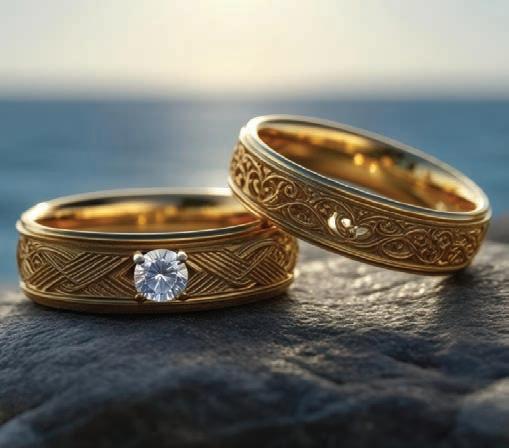
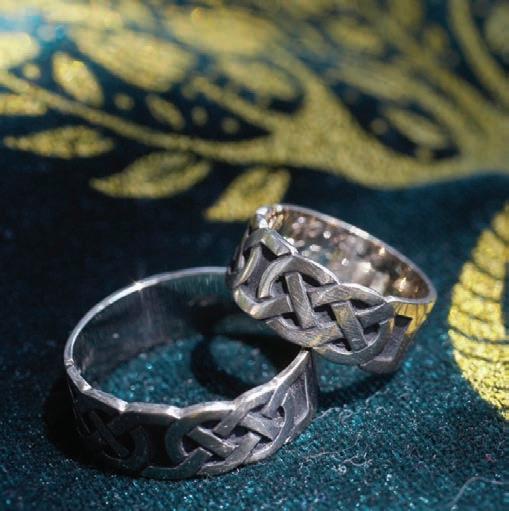


Jewelry makers are also embracing sustainability and ethical sourcing, ensuring that gold, silver, and gemstones come from responsible suppliers. This commitment resonates with modern couples who want their rings not only to symbolize love and unity but also to reflect values of care and respect for the wider world.
Irish wedding jewelry is renowned for the craftsmanship behind it. Many jewelers still hand-finish each band, drawing on generations of skill to bring out fine detail in knotwork or polish a simple band to perfection. It is this human touch that sets Irish jewelry apart, giving every ring a sense of individuality and soul. Makers such as Boru Jewellery in Dublin, Solvar, Glencara and Faller are among those offering
Celtic-inspired designs are also popular, often
featuring the spirals, knots, and interlacing patterns seen in ancient Irish art.

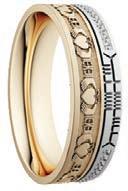

couples the chance to customize their designs, from personal inscriptions to bespoke patterns and stone settings, ensuring every ring tells its own story.
The appeal of Irish designs stretches far beyond Ireland’s shores. Couples across the world choose Claddagh or Celtic wedding rings to connect with heritage, celebrate ancestry, or simply embrace the symbolism of the designs. For many, it is a chance to carry a piece of Ireland into their future together, wherever life may take them.
Modern couples are also blending tradition with contemporary style. Some favor mixed metals, combining yellow and white gold to echo the intertwining of two lives. Others set diamonds or colored gemstones within Celtic motifs, adding a spark of brilliance without losing the meaning of the design. Engraving, whether in Irish or English, further personalizes the ring with words of love, poetry, or dates that mark a shared journey.
Family legacy plays a role too. Rings are often handed down across generations, each new wearer adding another layer of meaning. Some couples choose to have heirloom gold or gemstones reworked into new designs, creating rings that honor the past while looking to the future. Whether you choose a Claddagh, a Celtic-inspired motif, or a design entirely your own, the Irish approach to wedding rings combines history, artistry, and heartfelt symbolism. In the end, it is not the material value of the ring that matters most, but the meaning invested in it. A circle of gold or silver, shaped by centuries of tradition, becomes a lasting reminder of the promises exchanged on that special day.
In Ireland, wedding rings have long carried both symbolism and story. The Claddagh ring is perhaps the most famous example. Its motif of hands, heart, and crown represents friendship, love, and loyalty.


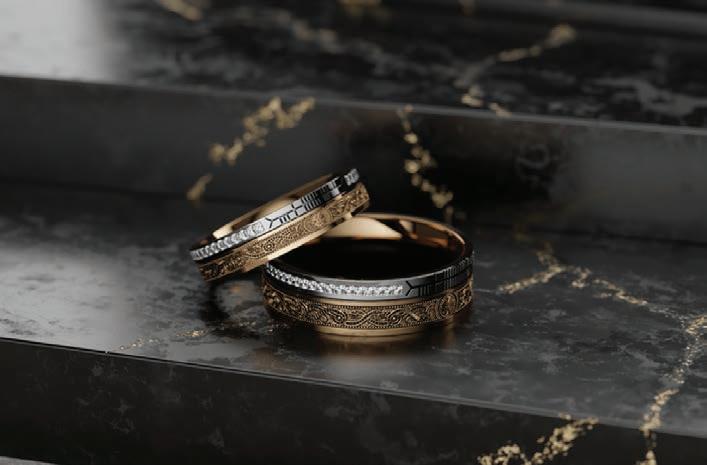
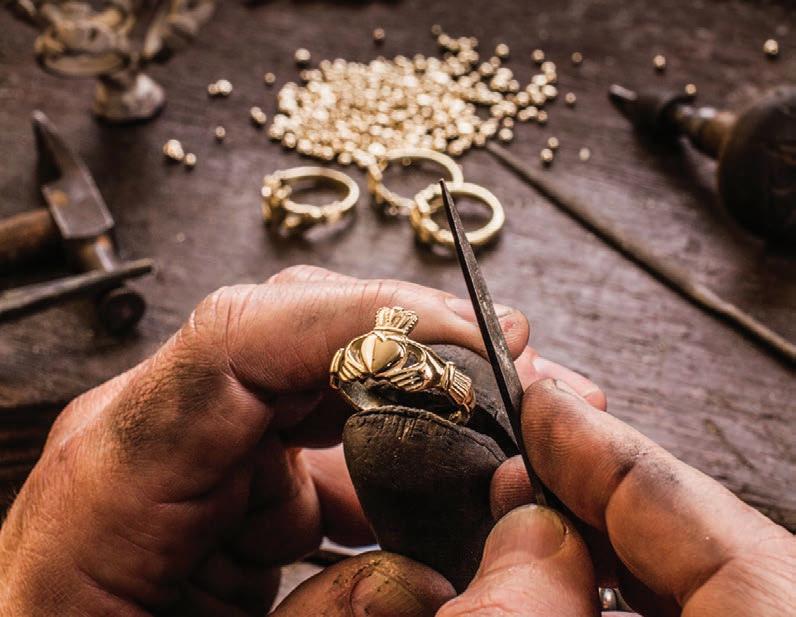
TUCKED AWAY IN THE MEANDERING STREETS AND LANES OF GALWAY'S LATIN QUARTER ARE THE LEGENDARY WORKSHOPS OF CLADDAGH JEWELLERS. HERE, CRAFTSMEN WITH UNPARALLELED EXPERIENCE DESIGN AND MANUFACTURE EXQUISITE JEWELRY FROM PRECIOUS METALS AND THE FINEST GEMSTONES.
The Claddagh Jewellers workshops, retail shop, and visitors’ center are spread over two separate buildings at 25-26 Shop Street. Visitors can enjoy daily screenings of the Legend of the Claddagh Ring, a short film explaining the story behind this most beloved symbol of Galway.
With its origins in the 1600s, the Claddagh Ring is said to be the inspiration of Richard Joyce, a man captured by pirates and sold into slavery in Algeria, where he was trained in goldsmithing. With his beloved left behind in Ireland, he crafted
a ring featuring a heart to symbolize his love, clasped by hands of friendship and topped with a crown for his loyalty and fidelity.
The legend has a happy ending: Joyce was freed in 1689 and returned to Galway, where he presented the Claddagh Ring to his sweetheart. They were wed, and today, Joyce’s Claddagh Ring design is a popular gift of love and affection worldwide.
Adjacent to Taafes Bar and right next door to Tigh Coilis, the melodies of traditional
music drift upwards to their workshops overlooking the oldest church in Ireland. Here, their jewellers form and craft the precious metals and produce exquisite and exclusive Claddagh rings of silver and gold, some with semi-precious gems and others set with diamonds and emeralds.
The makers of the Authentic Claddagh Ring invite you to visit their stores to experience a traditional Irish welcome for yourself and view their ever-increasing range of jewelry, which showcases the best of Irish jewelry design.

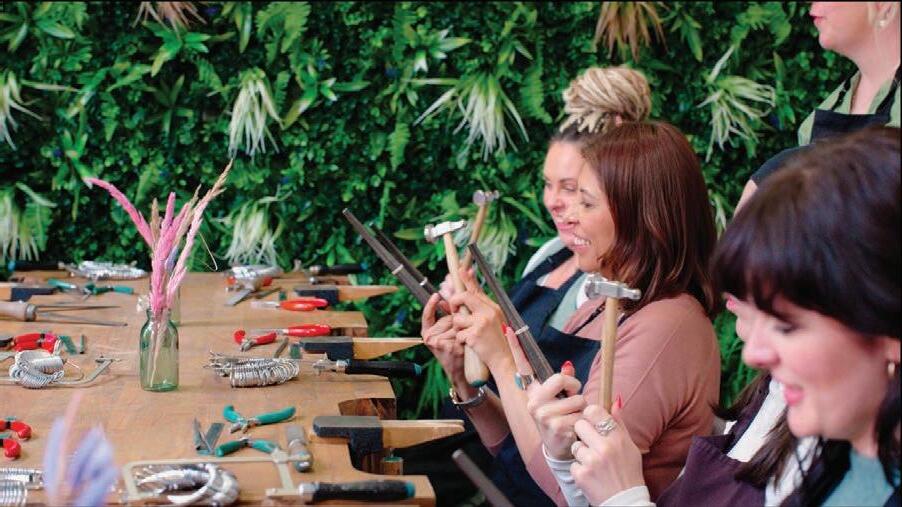

Silver Works is an award-winning jewellery school in the heart of Dublin’s Creative Quarter. Founded by MD Maddy Blaine, the studio is home to a team of talented goldsmiths who love sharing their craft. Whether you’re visiting Dublin or live here, our hands-on workshops let you learn traditional techniques and create a beautiful piece of jewellery to take home.
Learn the basics- sawing, filing, hammering, then choose your texture for a sterling silver ring you’ll forge and take home. Beginner-friendly, in small friendly classes.
Create a sterling silver Claddagh - the Irish symbol of love (heart), loyalty (crown) and friendship (hands) - starting from a ring strip and shaping it to your size. A meaningful Dublin keepsake you make yourself.
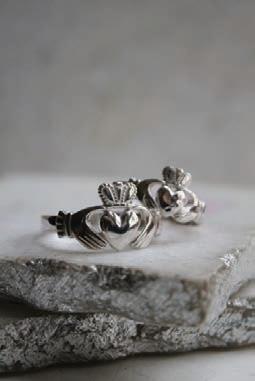


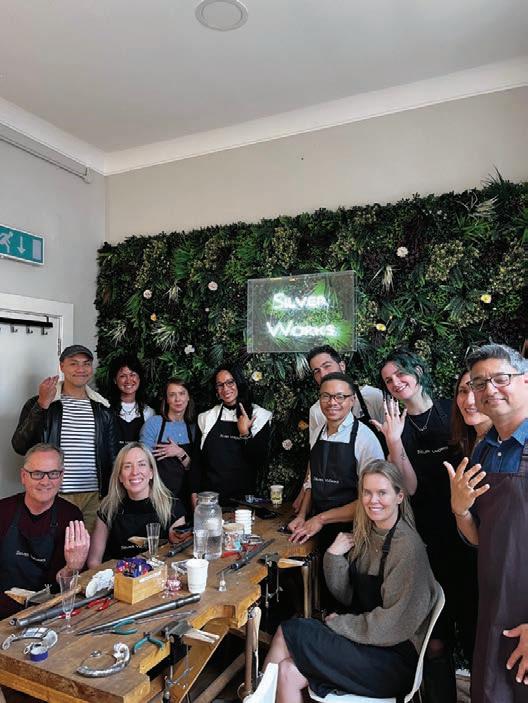
Mark your wedding with a truly meaningful experience - handcrafting the rings you’ll wear for a lifetime. In our Dublin studio, you and your partner will work side by side with one of our expert jewellers, learning traditional techniques as you shape, solder and polish your own wedding bands.

For couples who want to weave family history into their story, we can repurpose gold or stones from heirloom jewellery, transforming them into new rings filled with sentiment. The result is a pair of wedding bands that are not only beautiful, but deeply personal. Contactweddings@silverworks.ie
Celebrate in style with a hands-on jewellery workshop, complete with a glass of prosecco. Perfect for hens, birthdays or team events, our private bookings can even include a gin tasting for something extra special.
Guided by our jewellers, your group will craft unique pieces and unforgettable memories.
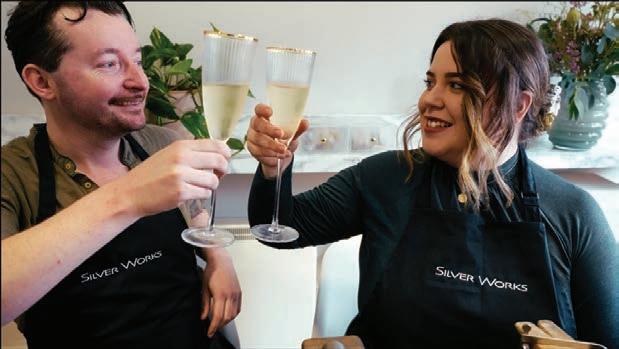


“To
lose an indigenous craft is to lose a part of our history, our culture, our link to the past”
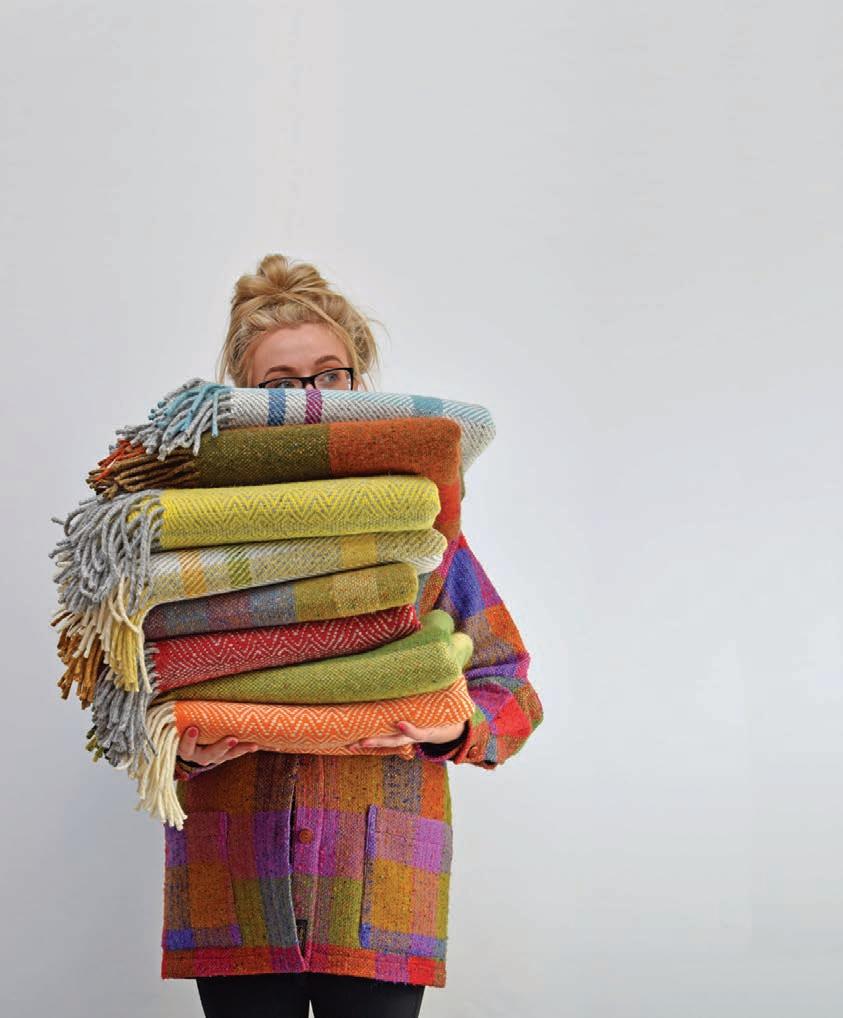
A working mill devoted to the traditional indigenous craft of handweaving, producing original, colourful and creative designs in throws, tweeds and garments, designed, handwoven & made in-house in Kilcar, Co Donegal.
Free self guided tours of the mill
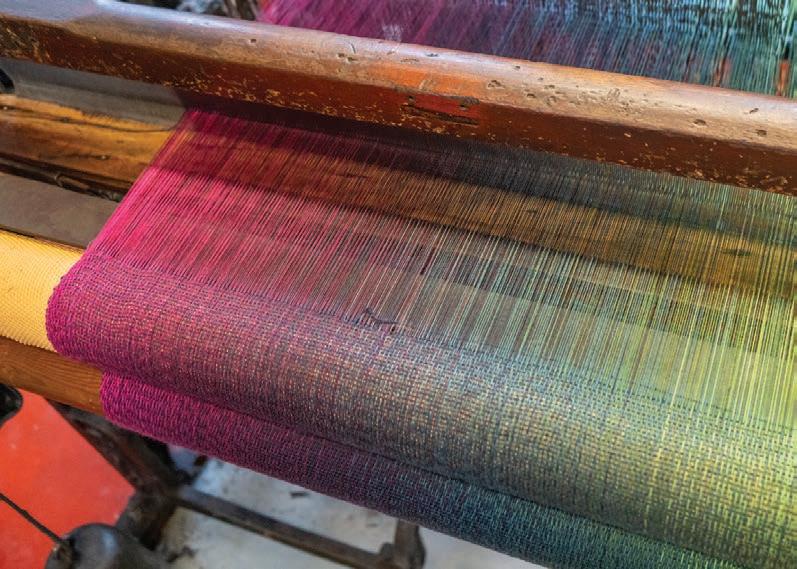
HAND-LOOMING REMAINS ONE OF IRELAND’S MOST ENDURING TRADITIONS, LINKING PAST AND PRESENT THROUGH SKILL AND DESIGN.
In every fold of Irish cloth there is a story of sheep grazing on hills, of wool dyed with peat and plant, of looms humming in cottage corners. Hand-looming and weaving are not relics of a distant past; they are living traditions, quietly shaping Ireland’s cultural identity and inspiring contemporary makers who carry the torch forward.
The story of weaving in Ireland stretches back millennia. Archaeological findsfragments of woven fabric, loom weights, spinning tools - suggest textile arts were practiced in Ireland as early as 1600 B.C. Over time, flax, wool, linen, and other
fibers found their place in Irish hands, and the craft became bound to social, economic, and artistic life.
In medieval and early modern Ireland, weaving took two main forms: rural handweaving, where families crafted cloth at home for local use, and cottage trades producing cloth for wider markets. The rise of power looms changed the landscape, but many pockets of handloom weaving persevered, especially in remote regions. Through economic shifts, famine, emigration, and industrialization, Ireland’s weaving traditions were tested. Yet in places like Donegal, parts of the west, and the Gaeltacht, the craft endured, nurtured
by local initiative, cultural pride, and a determination to preserve identity.
In Irish weaving, landscape and locality often reveal themselves in the cloth. Donegal tweeds are known for their heather flecks and fleuri tones, with patterns inspired by stone walls, sea strands, and Celtic motifs. Traditionally, natural dyes were drawn straight from the land - yellows from lichens, reds from berries, and rich browns from the bog. These earthy tones gave Irish textiles their depth and subtlety, echoing the hills and coastlines from which they came. Even today, traces of the land live on in the color
palettes and textures, linking every piece back to the place that inspired it.
Within these landscapes weaving communities took root. Towns such as Kilcar and Ardara became hubs of craft, where generations refined their techniques and shared knowledge. Weaving is patient, technical work, demanding mastery of warp and weft, tension and dye, pattern and material. Today, many mills still train new generations, passing down every stage of the process, from dressing the loom to finishing the cloth.
Across the country, weavers, spinners, dyers, and textile artists are reimagining tradition, working with natural fibers such as wool, mohair, and alpaca, and blending heritage with fresh design to create work that feels alive, relevant, and distinctly Irish. Every detail matters, from the choice of materials to the techniques that shape them, and even the tools themselves play a vital role. At Mucros Weavers, 200-yearold Hattersley looms are still in daily use, producing cloth with a softness and character that modern machines cannot replicate. At Studio Donegal, traditional drop-box shuttle looms remain central to production, giving each piece of tweed the depth and texture that define this unique craft.
Organizations such as the Guild of Master Irish Weavers champion quality, standards, and awareness of Ireland’s weaving heritage, and mills like Mucros and Studio Donegal uphold the same values in their own work. In this renewed era, Ireland’s mills are interlacing old traditions with

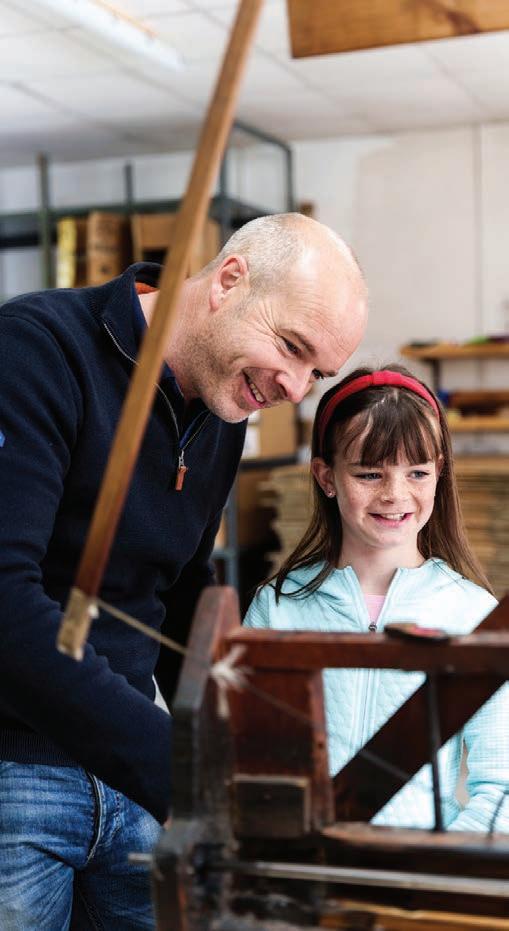

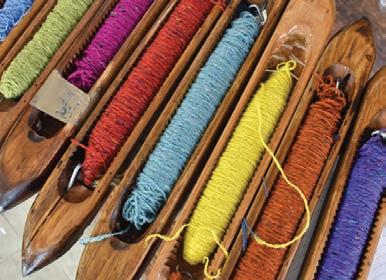
fresh ideas, sustainable practices, and contemporary design. In every thread, past and present come together, ensuring Irish craft continues to inspire far beyond these shores.
Irish weaving is not only preserved at home but also celebrated on international runways. Donegal tweed has been featured in collections by Chanel, Dior, and Yves Saint Laurent, its texture and depth admired in Paris and Milan. In New York and London, Irish-born designers such as Paul Costelloe, Simone Rocha, and Don O’Neill have incorporated Irish fabrics into their collections, proving that these textiles can stand proudly on the global stage. From couture jackets cut in Donegal tweed
to contemporary silhouettes woven in Irish wool, Ireland’s craft heritage continues to influence fashion at the highest level.
The beauty of this living tradition is that it can be part of your life, too. When you visit Ireland, many mills open their doors to visitors, offering the chance to watch garments being made and to take home a piece of Ireland you can wrap yourself in every day. If you can’t make the journey, online shopping with shipping worldwide is widely available.
But perhaps the closest thing to being here is right on your doorstep. Across the United States and Canada, NACTA stores are little pieces of Ireland in every community; warm, welcoming shops where you’ll find everything from tea to textiles. You may not be able to stroll the mills of Kerry or Donegal in person, but by visiting your local Irish store you can still take home the craft, culture, and comfort of Ireland.
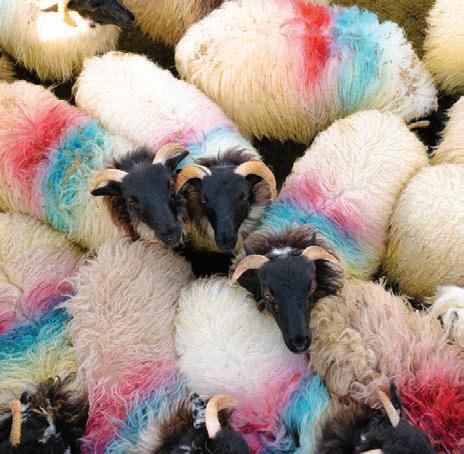
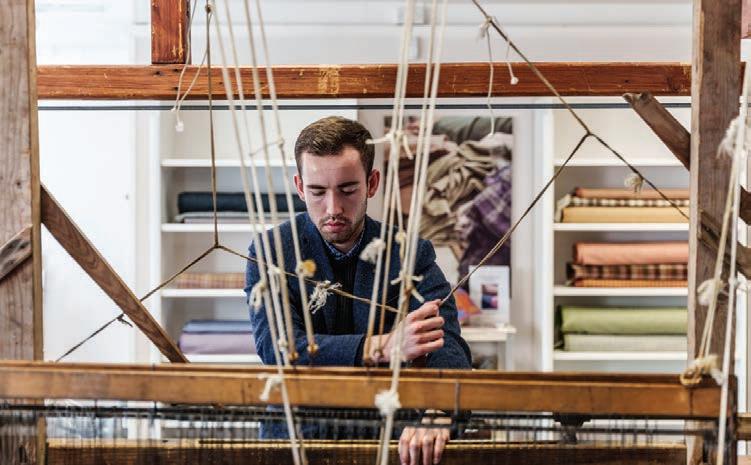
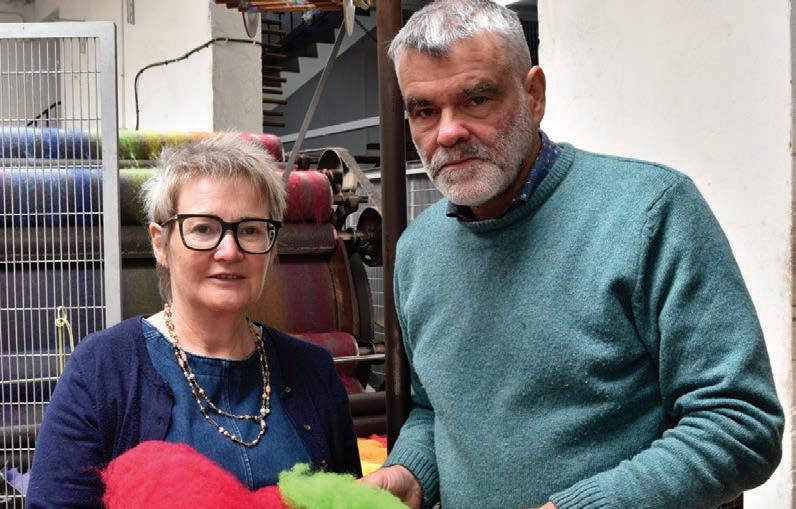
“HAND WEAVING IS PART OF THE INTANGIBLE CULTURAL HERITAGE OF THE AREA. TO LOSE AN INDIGENOUS CRAFT IS TO LOSE PART OF OUR HISTORY, OUR CULTURE, OUR LINK TO THE PAST.”
Studio Donegal is owned and operated by husband-and-wife team Tristan and Anne Donaghy. This small woolen mill in the picturesque village of Kilcar, in southwest Donegal, was established in 1979 to preserve the traditional craft of hand weaving indigenous to the area. Tristan is the second generation at the mill, having inherited it from his parents, Kevin and Wendy, when they retired. He and Anne met when she joined the company in 2014. Anne, a talented and creative maker with a passion for textiles, learned to crochet, knit, and sew at her mother’s knee. She had worked in knitwear manufacturing for many years before returning to college to study graphic design and digital media. The grá for textiles drew her back to the industry when an opportunity arose at Studio Donegal.
Slow fashion and slow living have always been at the heart of Studio Donegal. All of their tweeds are handwoven on restored wooden looms dating back over 100 years. They have tailored a permanent collection of women’s and men’s garments, hats, and accessories designed to remain ageless and timeless, wearable regardless of changing fads and fashions. Making in this way ensures that waste is kept to a minimum, with no end-ofseason stock to dispose of which is much more friendly to the environment. Offcuts of tweed from garment making are put to good use. Anne transforms these into small gift items such as key rings, hip flasks, flower brooches, hot water bottle covers, and tea cozies. Throws and cushions remain the mainstay of the business - colorful, eclectic, and beautiful.
Tristan holds a wealth of knowledge of the tweed and wool industry, gleaned from years of experience and from working with his parents, knowledge he is always happy to share. This expertise, coupled with his creative side, is invaluable when working with Anne to design new tweeds and throws. Theirs is very much a handson approach, working side by side with the team to oversee the operation of a mill that remains dedicated to handcrafting.
Studio Donegal woolen mill is well worth a visit. Though mostly stocked with their own products, they also supplement with other Irish-made goods. Visitors are welcome to take a free self-guided tour of the workshop upstairs, where they can chat with the makers and see products in progress. Unable to visit in person? Explore online at www.studiodonegal.ie
IN THE HEART OF COUNTY KERRY, MUCROS WEAVERS BLEND TRADITION AND ARTISTRY TO CREATE TEXTILES TREASURED ACCROSS THE WORLD.
Stepping into Mucros Weavers is like stepping back in time. Skilled artisans meticulously craft exquisite textiles using time-honored techniques passed down through generations. Every piece tells a story, weaving together the threads of Ireland's heritage with the timeless elegance of classic design.
Explore the workshop and watch in awe as master weavers expertly ply their trade, hands dancing across looms to create intricate patterns and rich textures. Here, scarves are weaved using only the finest quality yarns on Hattersley looms that are almost 200 years old, and apparently, the older the loom, the softer the scarf!
As all scarves are individually woven, they have a selvage on each side, ensuring they stand the test of time and giving every scarf a quality finish. Each colorful product is made from premium yarns such as wool, mohair, and alpaca. A complementary range of ladies' and men's tweed headwear in both traditional and contemporary styles is also available, as well as ladies' capes and men's waistcoats in tweed to match this headwear.
Each creation is a labor of love, imbued with the spirit of the Irish countryside and the warmth of traditional craftsmanship. So why not wrap up warm against the chilly Irish weather in a handmade mohair or alopecia cape or use the opportunity to ship home a unique and beautiful present with shipping available worldwide.
www.muckross-house.ie/mucros-weavers


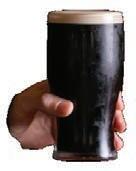

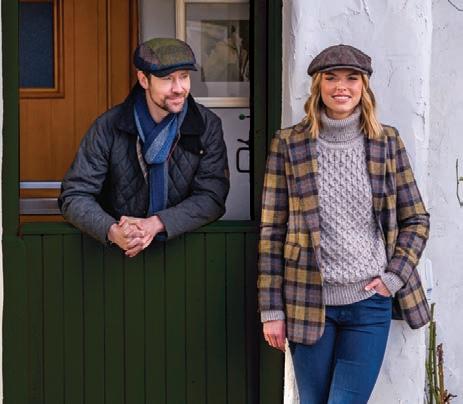

For many travelers, the Wild Atlantic Way is Ireland at its most unforgettable: vast skies, rugged mountains, and a coastline that changes with the light. Amid this natural drama lies a cultural gem: Connemara Handcrafted Glass (CHG).
Founded by husband-and-wife team Joseph and Dorothy Forsuh, CHG is regarded as the most prolific handcrafted glass center of its kind in the Republic of Ireland and is home to what is likely the largest collection of modern glass art in the country. For American visitors eager to blend scenery with artistry, CHG is a mustsee destination.
The Forsuhs’ journey is one of passion, persistence, and place. Joseph Tanue Forsuh, originally from Cameroon, trained in wood technology at GMIT Letterfrack but was drawn to the expressive possibilities of glass. After studying with the Design and Crafts Council of Ireland and in Bristol, he began experimenting with kiln-formed glass.
Together with Dorothy, an Irish artist with a background in advertising, fine art, and photography, Joseph co-founded CHG in 2016. Their marriage in 2006 had already cemented a creative partnership, and together they built a studio and gallery

that brought contemporary flair to the west of Ireland. In 2023, Joseph’s large-scale installations were featured in the World Art Guide, placing him among international leaders in glass art.
Ireland’s Largest Modern Glass Collection CHG is not a crystal house but a kilnformed glass center, where imagination and innovation shape every piece. Using Bullseye glass from Portland, Oregon, Joseph and Dorothy create works ranging from abstract and geometric panels to landscape-inspired scenes and playful depictions of Irish life. No two kiln firings are alike, ensuring that every piece is unique.


The gallery and adjoining shop are designed to welcome a wide spectrum of visitors. Collectors and architects will find large installations and statement wall art, while travelers can explore ornaments, jewelry, bowls, and framed miniatures at accessible price points. This balance makes CHG as appealing to seasoned art buyers as it is to tourists seeking a meaningful keepsake.
Joseph’s abstract and architectural works often echo Art Deco vibrancy or the tropical energy of his Cameroonian roots, while Dorothy’s pieces reflect her love of Ireland’s landscapes and wildlife. Together they curate a gallery that feels both professional and personal, greeting visitors with what the Irish call céad míle fáilte - a hundred thousand welcomes.
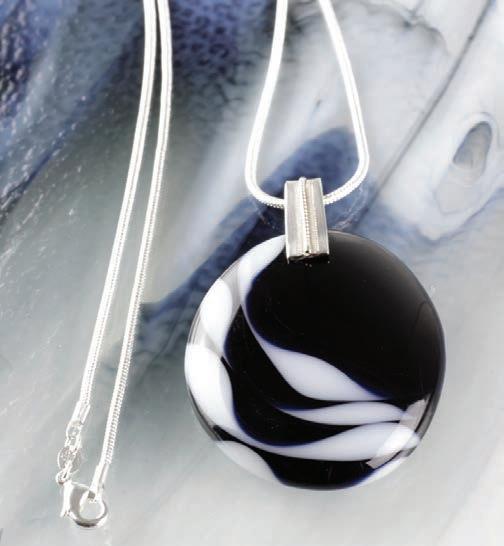
The couple’s story is also one of growth. What began with a small retail space in Balla in 2017 has developed into a sophisticated enterprise with international clients. Today, CHG is sought after not only by private collectors but also by architects, interior designers, and cultural institutions.
For American travelers, Connemara Handcrafted Glass offers both art and experience. Located in south-central County Mayo, CHG is easily reached along the N60 between Castlebar and Claremorris. It is just half an hour from Westport, about 30 minutes from Knock Airport, and close to Cong and the renowned Ashford Castle, the gateway to Connemara.
The gallery showcases major works and installations, while the shop features smaller pieces ideal for gifts. Demonstrations by appointment provide a fascinating glimpse into the process of fusing and shaping glass. Above all, the atmosphere is warm, personal, and rooted in heritage, with a chance to meet the makers and see how place inspires their craft.
Connemara Handcrafted Glass is more than a gallery; it is a reflection of Ireland itself: vibrant, layered, and alive with imagination. Each piece is designed and made on site, shaped by the light and landscapes of the west.
For American visitors, a stop at CHG offers more than beautiful art. It is an invitation to connect with the spirit of Ireland, where Atlantic light becomes color, glass becomes memory, and every visitor is welcomed into its living legacy.

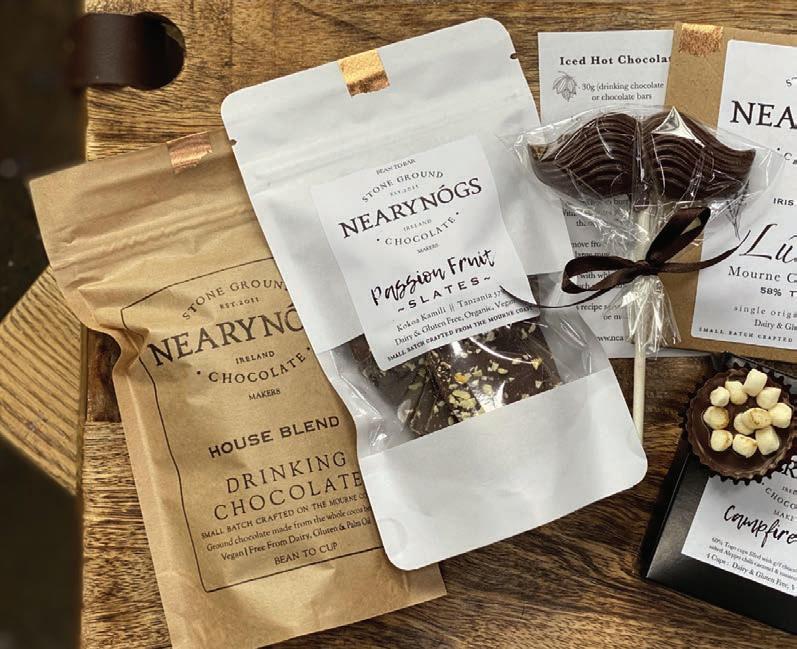
WHILE EXPLORING IRELAND’S TOWNS AND VILLAGES, YOU CAN DO MORE THAN JUST ENJOY THE TASTE OF IRELAND - YOU CAN SEND IT HOME. ACROSS THE COUNTRY, ARTISAN PRODUCERS MAKE IT EASY TO SHARE A LITTLE BIT OF IRELAND WITH FRIENDS AND FAMILY ABROAD
From award-winning salmon and handmade chocolates to traditional teas and farmhouse cheeses, Irish flavors are finding their way to tables and hearts around the world.
If you can’t visit in person, or if you simply want to send a unique gift to someone special, what better way to celebrate than by surprising them with a taste of Ireland delivered right to their door? Imagine
the look on a loved one’s face when an unexpected package arrives, carrying nostalgia in every bite.
If there’s one flavor that captures the Irish coast, it’s the smooth, rich taste of smoked salmon. Burren Smokehouse in County Clare has been perfecting its craft since 1989, using sustainably sourced Irish salmon and traditional oak-smoking methods. From classic oak-smoked to
whiskey-cured and seaweed-infused varieties, each fillet reflects the pure local ingredients that make the Burren region special.
County Kerry has its own piece of deliciousness. Forget Charlie and the Chocolate Factory; Skelligs Chocolate in the kingdom of Kerry is the real-life version you’ll actually want to visit. Perched on the edge of the Wild Atlantic Way,
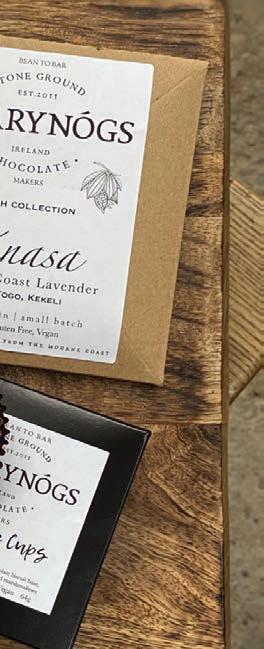


it’s Ireland’s only open-plan chocolate factory, where visitors can watch expert chocolatiers at work while sampling their latest creations. Family-owned and full of creativity, Skelligs crafts everything from silky truffles to sea-salted caramels and chocolate bars inspired by the local landscape. Each piece is handmade in small, blending rich flavor with a touch of coastal charm. And the best part? You don’t have to travel to Kerry to enjoy it.
Or, for a touch of Dublin indulgence, Butlers Chocolates delivers its famous Irish confections straight to the U.S. Known as “the purveyors of happiness through chocolate,” Butlers has been handcrafting luxurious truffles, pralines, and bars since 1932. Whether it’s a gift box or a personal treat, their worldwide shipping makes enjoying authentic Irish chocolate delightfully easy.
Another great Irish brand shipping to the U.S. is NearyNógs from County Down. As Northern Ireland’s first bean-
to-bar chocolate maker, they handcraft bars, truffles, and gift sets from ethically sourced cacao and pure Irish ingredients. Each bar is made by hand on the Mourne coast, blending Irish creativity with worldclass flavor. With U.S. shipping available, their chocolate brings the taste of Ireland’s craft scene straight to your doorstep.
For something a little more playful and the option to mix and match, The Paddy Box lets you ship all sorts of Irish goodies stateside. Each box can be customized with beloved classics so you can send the comfort of a proper Irish cuppa and a slice of homemade bread to the mammies and grannies who will treasure every last morsel.
All of these heartfelt treats are perfect for any occasions. Whether you’re sending warm wishes for St. Patrick’s Day, giving thanks on Thanksgiving, or a birthday celebration, these sweet surprises turn simple treats into moments of pure Irish joy.










GRÁ MEANS ‘LOVE’ IN IRISH – AND IT’S AT THE HEART OF EVERYTHING THE PADDY BOX DOES.
Let’s face it – Ireland is sprinkled with magic. The stories passed down through generations over a pint of the black stuff, the rolling, lush green, the unmistakeable crunch of a Tayto crisp and that Irish ‘craic’ that you just can’t replicate anywhere else.
But if you’re Irish and living abroad or just feel an affinity to Ireland and feel you have an ‘Irish heart’, that magic can feel very far away. And that’s why The Paddy Box exists – to deliver a little piece of Ireland to anyone, wherever they are in the world.
The Paddy box began as a spark in the imagination of Dublin born Mark Loftus in 2017, when long years of recession saw many Irish people emigrate to distant lands in search of new opportunities. For Irish families, lovingly putting together care packages full of treats, comforts and
reminders of home became something of a ritual to enable their far-flung loved ones to feel the connection to home.
This loving ritual provided Mark with his lightbulb moment. He knew that the expense and logistics of hunting out, putting together, packaging and sending a care package were considerable. So why not make it easy to send Ireland in a box? After countless cups of tea and biscuits, and lots of brainstorming with family, friends and curious listeners-in at the pub, The Paddy Box was born.
Each Paddy Box is carefully filled with nostalgic products seen in any Irish household, including favorites like Barry’s Tea, Tayto crisps, Lily O’Briens chocolate and Bisto gravy granules. Whether you choose from one of their hand-picked curated collections or choose to build your own custom box, The Paddy Box is
guaranteed to spark a smile and stir up memories of Ireland.
It doesn’t stop at food either. Seasonal gifts such as Christmas tree decorations shaped like vintage green Irish post boxes and passports are poised to add a whimsical touch of Ireland to the festive period. The Paddy Box also offers corporate gifting solutions, allowing businesses to spread Irish charm on a scale from a single box, up to thousands. The Paddy Box is more than a care package – it's an enveloping hug from across the ocean. It’s that warm reminder that someone is thinking of you – it's a connection to a place that always lives in your heart.
Send a box of Ireland to someone special today at www.thepaddybox.com - and deliver a little grá worldwide.

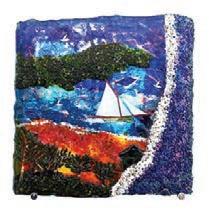
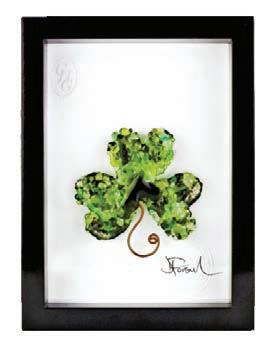

IRISH STORES ALL OVER THE USA AND CANADA OPEN THEIR DOORS AND THEIR HEARTS TO CUSTOMERS EVERY DAY. HERE ARE SOME OF THEIR STORIES.
The Irish Design Center has been a cornerstone of the Irish/Celtic community in Pittsburgh and its vicinity since 1978. Maura Krushinski and Tom Petrone assumed ownership of this iconic shop in March 2018. A vital resource for the Pittsburgh community, the shop is known for its high-quality merchandise at affordable prices.
In addition to providing authentic Irish/ Celtic merchandise and food, the Irish Design Center also offers education, outreach programs, Ireland tours, travel advice, and cultural events to the greater Pittsburgh area and beyond.
Maura and Tom are deeply committed to helping non-profit organizations that support public awareness of Irish/Celtic culture. They are loyal donors to a variety of local charities, educational institutions, senior centers plus local and regional Irish events, including the Pittsburgh Irish Festival, now in its 33rd year.
Pittsburgh, Pennsylvania www.irishdesigncenter.com


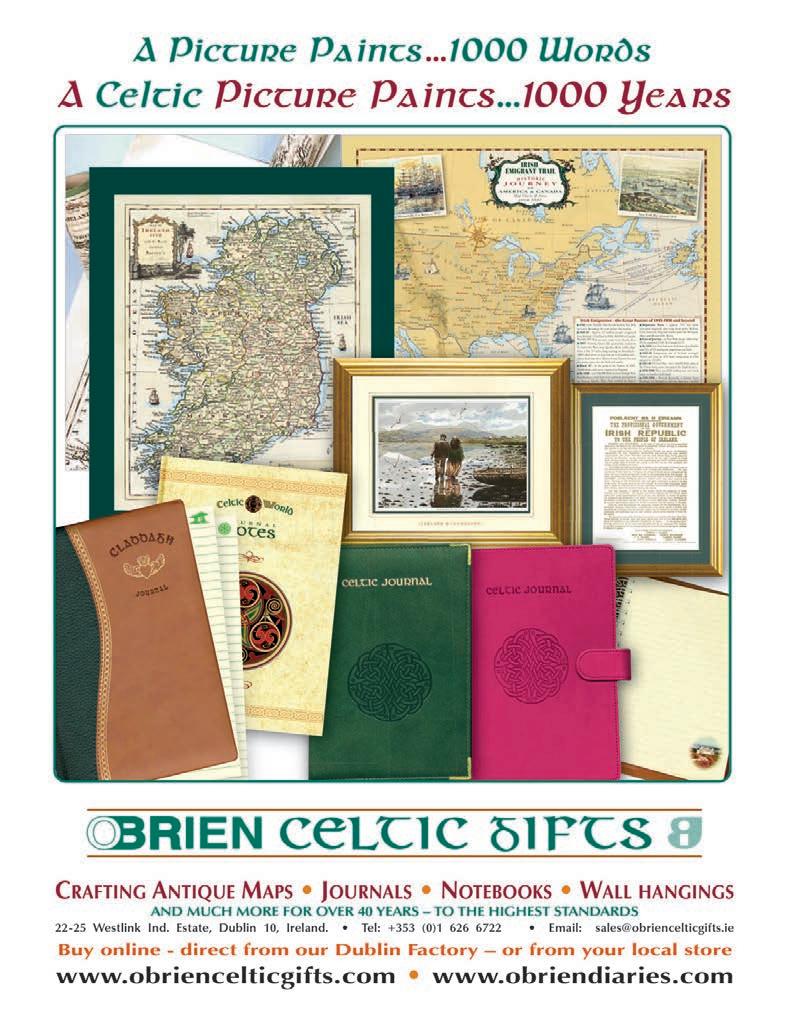
Tucked away in the quaint and quiet downtown of historic Weston, Missouri, lies The Celtic Ranch, a humble clothing and gift shop with an unexpected twist - an impressive collection of whiskeys waiting in the back at The Whiskey Snug.
Inspired by the rich beauty of Celtic and Irish heritage with a rustic touch of smalltown country charm, The Celtic Ranch offers an exceptional range of beloved Irish brands and giftware. Visitors can browse an extensive selection of men’s and women’s traditional hats, scarves, and outerwear by Mucros Weavers, or pick up one of the unique Hanna patch caps, each handmade the old-fashioned way. The shop also features fine jewelry from designers such as Keith Jack, Shanore, and ANU Celtic.
The colorful Harris Tweed handbags and accessories from Islander and Glen Appin add another layer of charm, while the exclusive Celtic Ranchwear line, including the popular Grandfather shirts and vests for men, celebrates timeless Irish style. In the Galway Room, guests can uncover treasures and gifts for all occasions, from distinctive keepsakes to irresistible pantry snacks.
Beyond the retail space, The Whiskey Snug awaits. First opened in early 2018 with a modest collection of Irish whiskeys, the Snug quickly expanded. By that fall, the “Upper Snug” was added to accommodate its growing selection. Today, the snug houses more than 1,100 whiskeys, available by the bottle or by the pour, representing both domestic and international distilleries. Whiskey enthusiasts can explore an extraordinary lineup that includes Irish, Scotch, bourbon, and rye varieties, from popular labels to rare finds. Guests can enjoy a pour or a flight from the premium collection, sip classic whiskey cocktails, or savor a perfectly poured Guinness. The Whiskey Snug isn’t just a lounge; it’s a spirited experience.
Whether visitors come to shop for the Celtic gentleman or lady in their life,
treat themselves to a cozy wool sweater, or share a dram with friends in the back, The Celtic Ranch and The Whiskey Snug offer a warm and welcoming home away from home. Weston, Missouri www.celticranch.com www.whiskeysnug.com

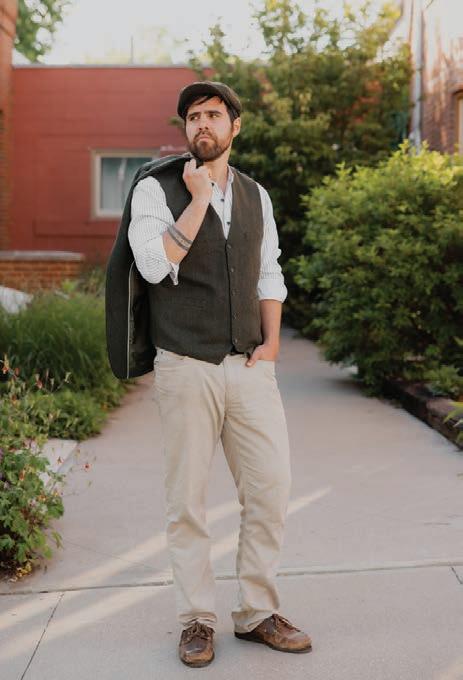
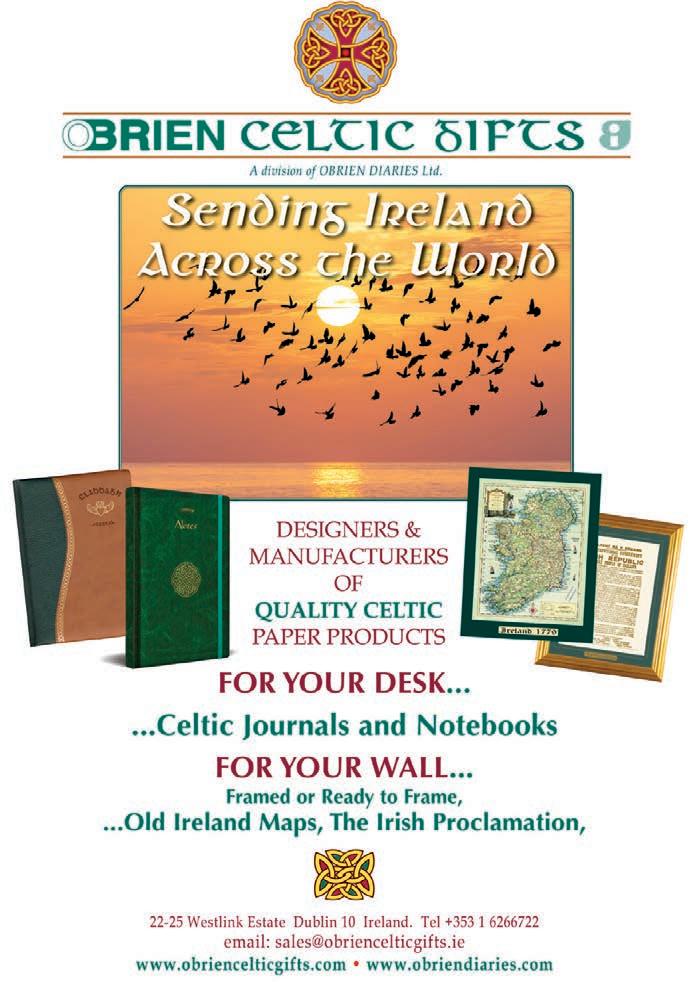
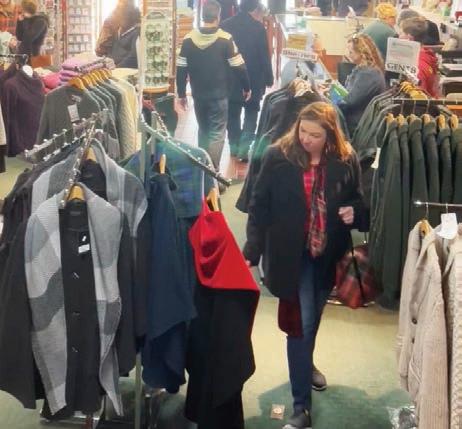
A Legacy of Excellence in Irish Craft Winner of the 2025 Excellence in Retail Award from the International Trade Association, Tipperary Stores has once again been recognized for its commitment to quality and craftsmanship. At a recent ceremony held by the North American Celtic Trace Association (NACTA) at the Royal Dublin Society, Tipperary Stores was honored for its contributions to promoting Irish craft in the United States - and this isn’t the first time the store has received this prestigious award!
The story of Tipperary Stores began in the 1970s with Tom and Nancy McGrath, who had a vision to support traditional Irish artisans during a particularly challenging time in Ireland's history. Recognizing that over 40% of the population in New York's Capital Region had Irish heritage, they believed that bringing authentic Irish-made products to the Albany and Brunswick areas could help sustain jobs for artisans back in Ireland. Starting with Claddagh jewelry, the store soon expanded to include Belleek, Irish Dresden, Irish crystal, sweaters, and other well-known Irish brands. At a time when global connections were not as easily made, importing these goods was a labor
of love. Their efforts not only sustained jobs for Irish artisans but also promoted Irish craft in the United States, a legacy that continues to this day.
Today, nearly 50 years later, the original Tipperary Store in Brunswick, NY, remains a popular destination for shoppers from New York's Capital Region, Western Massachusetts, and Southern Vermont. The McGrath family's dedication to the business is a testament to their commitment to preserving Irish craft. With generations of the family involved in the store's operations, from Tom and Nancy's parents to their children and even grandchildren, the family continues to be the heart of the business. Now, with the great-grandchildren keeping a close eye on the candy displays, the family's commitment to the store's legacy is stronger than ever. Over the years, an incredible team of long-term employees— some with tenures of 5, 10, and even 20 years—has been integral to the store's growth and success.
Now in his 40th year with the company, Tom McGrath has expanded the business into America's largest brick-and-mortar Irish and Celtic retailer, serving New York, New England, and the Mid-Atlantic regions.
Tipperary’s Basic Irish Luxury store in downtown Newport, Rhode Island, caters to the year-round tourism of this "City by the Sea" while also providing easy access for locals from Greater Boston, Providence, and New England’s South Shore. Additionally, Irish Traditions, located in downtown Annapolis, Maryland, has been a landmark store for over 30 years. As the largest retailer on Annapolis’s Main Street, it conveniently serves Baltimore and Washington, D.C., while drawing customers from the entire Mid-Atlantic region.
All Tipperary Stores provide a modern shopping experience focused on cuttingedge Irish and Celtic design, craft, and fashion. By building lasting relationships with Ireland's top jewelry makers, weavers, designers, glassmakers, and artisans, Tipperary has continually supported and championed traditional Irish craft. As Christina Doyle explains, “Tipperary has often been the first, and sometimes the only, U.S. outlet for many up-andcoming Irish creators. Whether looking for a famous Irish brand or discovering the next big Celtic designer, you'll find it at a Tipperary Store near you or online!”
Brunswick, New York Newport, Rhode Island Annapolis Maryland www.ShopTipperary.com
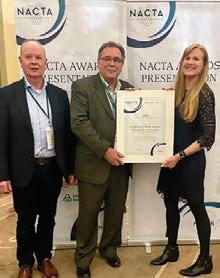

Ciara’s Irish Shop
334 Second Street
Eureka, CA 95501
Tel: 707-443-0102
Website: www.ciarasirishshop.com
Contact: CC O’Brien-Cree
Irish Eyes
8A Olde Mistick Village 27 Coogan Boulevard Mystic, CT 06355
Tel: 860-536-9960
Email: irisheyesmystic@aol.com
Contact: Donna Gorman
Peggy’s Cottage
1773 Post Road E Westport, CT 06880
Tel: 203-292-3487
Email: marah.peggyscottage@gmail.com
Contact: Marah Melillo
Fenwick Float’ors
35034 Buoy Boulevard West Fenwick Island, DE 19975
Tel: 302-436-5953
Website: www.fenwickfloators.com
Contact: Tina McBride
Irish Rose
42 North Walnut Street
Milford, DE 19963
Tel: 302-491-4125
Website: www.irishrosegiftshop.com
Contact: Eugenia Sparks
(The) Celtic Gift Store
212 W Cocoa Beach
Causeway
Cocoa Beach, FL 32931
Tel: 321-505-1966
Website: www.thecelticgiftstore.com
Contact: Yvonne Walsh
Celtic Shop of Dunedin
354 Main Street
Dunedin, FL 34698
Tel: 727-733-2200
Website: www.celticshopdunedin.com
Contact: Lynn Thorn
(The) Irish Gift Shop
26 Cuna Street
St. Augustine, FL 32084
Tel: 904-824-5040
Website: www.theirishgiftshop.com
Contact: Michelle & Shane Pierce
(The) Celtic Geek
228 W Broughton Street
Savannah, GA 31401
Tel: 912-777-5911
Website: www.got-kilt.com
Contact: Dirk Carswell
Enchanted Shire
6905 Virlyn B Smith Road
Fairburn, GA 30213
Tel: 585-329-5653
Website: www.enchantedshire.com
Contact: Arlene Dougherty
IDAHO
All Things Irish
315 E Sherman Avenue
Coeur d’Alene, ID 83814
Tel: 208-667-0131
Website: www.all-thingsirish.com
Contact: Craig & Ilene Moss
A Touch of Ireland
6761 W 95th Street
Oak Lawn, IL 60453
Tel: 708-237-3473
Website: www.atouchofireland.com
Contact: Katie & Annie Cremins
Chocolat229
229 South Main Street
Galena, IL 61036
Tel: 815-776-7777
Email: ravnamylynn@outlook.com
Contact: Amy Virtue
Irish American Heritage Center Gift Shop
4626 N Knox Avenue
Chicago IL 60630
Tel: 773-282-7035 x 14
Website: www.irish-american.org
Contact: Irene Higgins-Hruby
Paddy’s on The Square
228 Robert Parker Coffin Road
Long Grove, IL 60047
Tel: 847-634-0339
Website: www.irishboutique.com
Contact: John Barry
Shamrock Imports
391 Bluff Street
Dubuque, IA 52001
Tel: 563-583-5000
Website: www.shamrockjeweler.com
Contact: Michael Siegert
Failte Irish Import Shop
113 South Upper Street
Lexington, KY 40507
Tel: 859-381-1498
Website: www.lexirish.com
Contact: Liza Hendley Betz
A Lit'le Irish, Too
29 E Patrick Street
Frederick, MD 21710
Tel: 301-378-2340
Website: www.alittleirishtoo.com
Contact: Tory Warren
Irish Traditions
141-143 Main Street
Annapolis, MD 21401
Tel: 410-990-4747
Website: www.IrishTraditionsOnline.com
Email: shop@TipperaryStores.com
Bridget’s - An Irish Tradition
88 West Main Street
Norton, MA 02766
Tel: 508-285-9700
Website: www.bridgetsirish.com
Contact: Bridget Daly & Lorraine Ryan
Erin Gift Store
56 Knapp Avenue
Worcester, MA 01605
Tel: 508-735-9540
Email: erinbusiness56@gmail.com
Contact: Jennifer Courville
Got Kilt
568 Main Street
Frankenmuth, MI 48734
Tel: 989-262-8065
Website: www.got-kilt.com
Contact: Dirk Carswell
(The) Twisted Shamrock
3074 12 Mile Road
Berkley, MI 48072
Tel: 248-544-4170
Website: www.thetwistedshamrock.com
Contact: Jim Monahan
Got Kilt
Mall of America - Store Number W385
60 E Broadway Bloomington, MN 55425
Tel: 952-303-4477
Website: www.got-kilt.com
Contact: Dirk Carswell
Browne's Irish Market
3300 Pennsylvania Avenue Kansas City, MO 64111
Tel: 816-561-0030
Website: www.BrownesIrishMarket.com
Contact: Kerry Browne
(The) Celtic Ranch
404 Main Street
Weston, MO 64098
Tel: 816-640-2881
Website: www.celticranch.com
Contact: Renz Pros & Cara Welliver
(The) Kerry Cottage
113 N. Kirkwood Road
Kirkwood, MO 63122
Tel: 314-394-0331
Website: www.thekerrycottage.square.site
Contact: Karin Jorgenson
Celtic Crossing
112 Congress Street Portsmouth, NH 03801
Tel: 603-436-0200
Website: www.celticcrossing.com
Contact: Karin Scott
Bridget’s Irish Cottage
15 E Broad Street
Westfield, NJ 07090
Tel: 908-789-0909
Website: www.bridgets.com
Contact: Bridget Lawn
(The) Cross & Shamrock
1669 Route 33
Hamilton Square, NJ 08690
Tel: 609-586-9696
Website: www.crossandshamrock.com
Contact: Ann & Tim Bauersachs
Emerald Gifts
137 Parsippany Road
Parsippany, NJ 07054
Tel: 973-884-3241
Email: edhansberry69@gmail.com
Contact: Edward Hansberry
Faith & Begorra
40 Broadway
Denville, NJ 07834
Tel: 973-625-0070
Website: www.faithandbegorra.com
Contact: Susan Banks
Kelly’s A Touch of Ireland
21 South Broadway
Pitman, NJ 08071
Tel: 856-589-4988
Website: www.kellystouchofireland.com
Contact: Judy Miller
O’Ireland
130 North Broadway
South Amboy, NJ 08879
Tel: 732-525-0515
Website: www.oireland.com
Contact: Rosanne Savoi
O’Ireland
30 Monmouth Street
Red Bank, NJ 07701
Tel: 732-747-4433
Website: www.oireland.com
Contact: Paul Savoi
NEW YORK
Cashel House
224 Tompkins Street
Syracuse, NY 13204
Tel: 315-472-4438
Email: cashelhouse@gmail.com
Contact: Peter Heverin
Celtic Aer Gift Shop
1137 E Main Street, Suite B
Shrub Oak, NY 10588
Tel: 914-526-3361
Website: www.celticaer.com
Contact: Ashley Rooney
Celtic Treasures
456 Broadway
Saratoga Springs, NY 12866
Tel: 518-583-9452
Website: www.celtictreasures.com
Contact: Paul O’Donnell
From the Hart
108 N Main Street
Wellsville, NY 14895
Tel: 585-593-2017
Website: www.fromthehartstore.com
Contact: Nancy Hart
Irish Crossroads
58 Main Street
Sayville, NY 11782
Tel: 631-569-5464
Website: www.irishcrossroadsonline.com
Contact: Kathleen Quinn
Irish Treasures
2567 Main Street
Lake Placid, NY 12946
Tel: 518-637-7694
Website: www.irishtreasureslp.com
Contact: Tiffani Healey
Lennon’s Irish Shop
164 Jay Street
Schenectady, NY 12305
Tel: 518-377-0064
Website: www.lennonsirishshop.com
Contact: Dale & Mary Ann May
Tara Gift Shoppe
250 Abbott Road
Buffalo, NY 14220
Tel: 716-825-6700
Website: www.taragiftshoppe.com
Contact: Thomas Heneghan
Tipperary Irish Importer |
Celtic Jeweler
3956 State Highway 2
Brunswick, NY 12180
Tel: 518-279-8272
Website: www.ShopTipperary.com
Email: shop@TipperaryStores.com
Enchanted Shire
16445 Poplar Tent Road
Huntersville, NC 28078
Tel: 585-329-5653
Website: www.enchantedshire.com
Contact: Arleen Dougherty
Ladies View
208 1st Street West
Jamestown, ND 58401
Tel: 701-320-9534
Email: ladiesview@outlook.com
Contact: Cheryl Lynn Fowler
Casey’s Irish Imports
19626 Center Ridge Road
Rocky River, OH 44116
Tel: 440-333-8383
Website: www.caseysirishimports.com
Contact: Kathleen Casey Proctor & Maureen Casey
Eire on Erie
3512 Erie Avenue Cincinnati, OH 45208
Tel: 513-321-3287
Email: hapsirishpub@aol.com
Contact: Danny & Amy Thomas
Irish Crossroads & Gift Shop
38015 Euclid Avenue
Willoughby, OH 44094
Tel: 440-954-9032
Website: www.irishcrossroadsohio.com
Contact: Michelle Morgan
Bridie's Irish Faire
715 NW 3rd Street (Nye Beach) Newport, OR 97365
Tel: 541-574-9366
Website: www.bridiesirishfaire.com
Contact: Susan Spencer
A Lit’le Irish, Too
30 York Street
Gettysburg, PA 17325
Tel: 717-334-6609
Website: www.alittleirishtoo.com
Contact: Tory Warren

Celtic Culture
137 East Main Street
Ligonier, PA 15658
Tel: 724-238-2420
Website: www.celticcultureonline.com
Contact: Andrew Carr
Donegal Square
534 Main Street
Bethlehem, PA 18018
Tel: 610-866-3244
Website: www.donegalsquare.com
Contact: Neville Gardner
Irish Design Center
303 South Craig Street
Pittsburgh, PA 15213
Tel: 412-682-6125
Website: www.irishdesigncenter.com
Contact: Maura Krushinski
Oxford Hall Celtic Shoppe & Tea Café
233 Bridge Street
New Cumberland, PA 17070
Tel: 717-774-8789
Website: www.oxfordhall.com
Contact: Cindy Washburn
The Village Irish Shop
4019 Skippack Pike
Skippack, PA 19474
Tel: 610-584-0980
E: thevillageirishshopskippack@gmail.com
Contact: Marytheresa Vogler
Trip to the Cottage
9 Chambersburg Street Gettysburg, PA 17325
Email: triptothecottage.llc@gmail.com
Contact: Emily Warren
USA Kilts
3389 Schuylkill Road (Rt. 724) Spring City, PA 19475
Tel: 610-948-4110
Website: www.usakilts.com
Contact: Rocky Roeger
Basic Irish Luxury
127 Swinburne Row, Thames Street, Newport, RI 02840
Tel: 800-255-8272
Website: www.BasicIrishLuxury.com
Email: shop@TipperaryStores.com

(The) Celtic Cup
106 North Anderson Street
Tullahoma, TN 37388
Tel: 931-563-7733
Website: www.thecelticcup.com
Contact: Denise & Chris Smith
Irish Eyes of Virginia
725 Caroline Street
Fredericksburg, VA 22401
Tel: 540-373-0703
Website: www.irisheyesofva.com
Contact: Mike & Bernadette Esler
Maggie Casey’s Celtic Treasure
124 Main Street
Smithfield, VA 23430
Tel: 757-371-6100
Email: mcceltictreasure@gmail.com
Contact: Kristin Wilda
Piper Dan’s Keltic Shoppe
32 E Piccadilly Street
Winchester, VA 22601
Tel: 540-7510777
Email: piperdanskeltic@aol.com
Contact: Mary Brady Shea Knight
Scotland House Ltd
430 Duke of Gloucester Street
Williamsburg, VA 23185
Tel: 757-229-7800
Website: www.scotlandhouseltd.com
Contact: Sam & Michelle Wallace
Celtic Crossroads NW
380 Winslow Way East, Suite 100, Bainbridge Island, WA 98110
Tel: 360-344-2123
Website: www.celticcrossroadsnw.com
Contact: Debbie Sonandre
Celtic Crossroads PT
2205 E Sims Way
Port Townsend, WA 98368
Tel: 360-344-2138
Email: joe@celticcrrossroadspt.com
Contact: Joe & Tracy Gallegos
Galway Bay Trading Co
880 Point Brown Avenue NE
Ocean Shores, WA 98569
Tel: 360-289-2300
Website: www.galwaybayirishpub.com
Contact: William Gibbons
O’Meara’s Irish House
3970 State Highway 42 Fish Creek, WI 54212
Tel: 920-868-3528
Website: www.omearasirish.com
Contact: Megan O’Meara
(The) Celtic Geek
West Edmonton Mall - Store
Number 2540, 8882 170th Street, Edmonton, AB T5T 4M2
Tel: 780-444-6238
Website: www.got-kilt.com
Contact: Dirk Carswell
Irish Design
75 Queen Street, Niagara on the Lake, Ontario L0S 1J0
Tel: 905-468-7233
Website: www.irishdesign.com
Contact: Paul, Maureen & Shauna Dickson
(The) Plaid Place
1903 Barrington Street
Halifax, Nova Scotia B3J 3L7
Tel: 902-429-6872
Website: www.plaidplace.com
Contact: Lisa Risley
Red Label Kilts
90 Esplanade
Joan Harris Cruise Pavilion
Sydney, Nova Scotia
Tel: 902-561-6339
Website: www.redlabelkilts.ca
Contact: Deana Lloy
(The) Scottish Company
1991 Leslie Street
Toronto, Ontario M3B 2M3
Tel: 416-223-1314
Website: www.scottishcompany.com
Contact: Mark Coffey
(The) Scottish & Irish Store
22A-1051 Baxter Road
Ottawa, Ontario, K2C 3P2
Tel: 343-588-8811
Website: www.scottishandirishstore.com
Contact: Michael Cox

